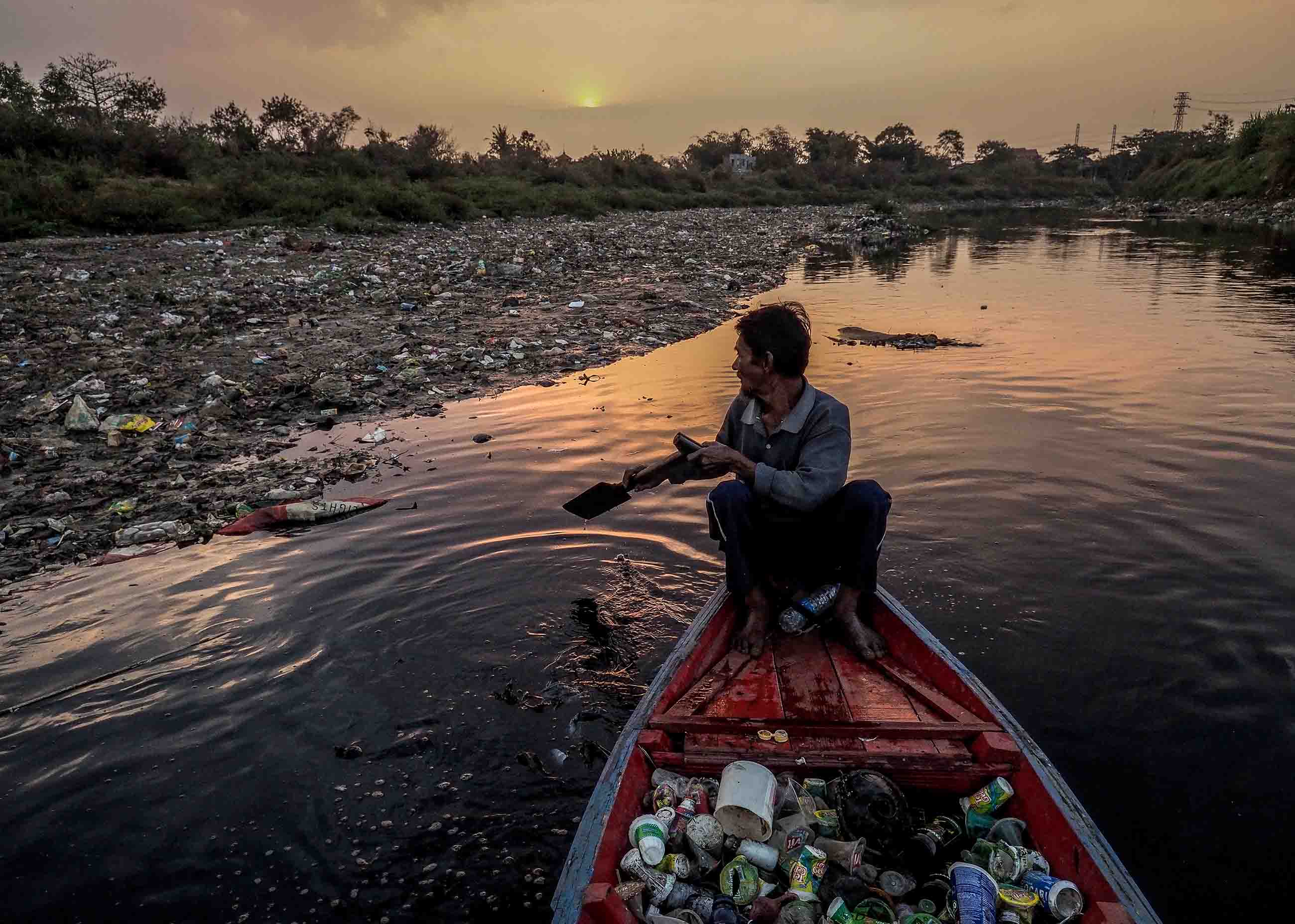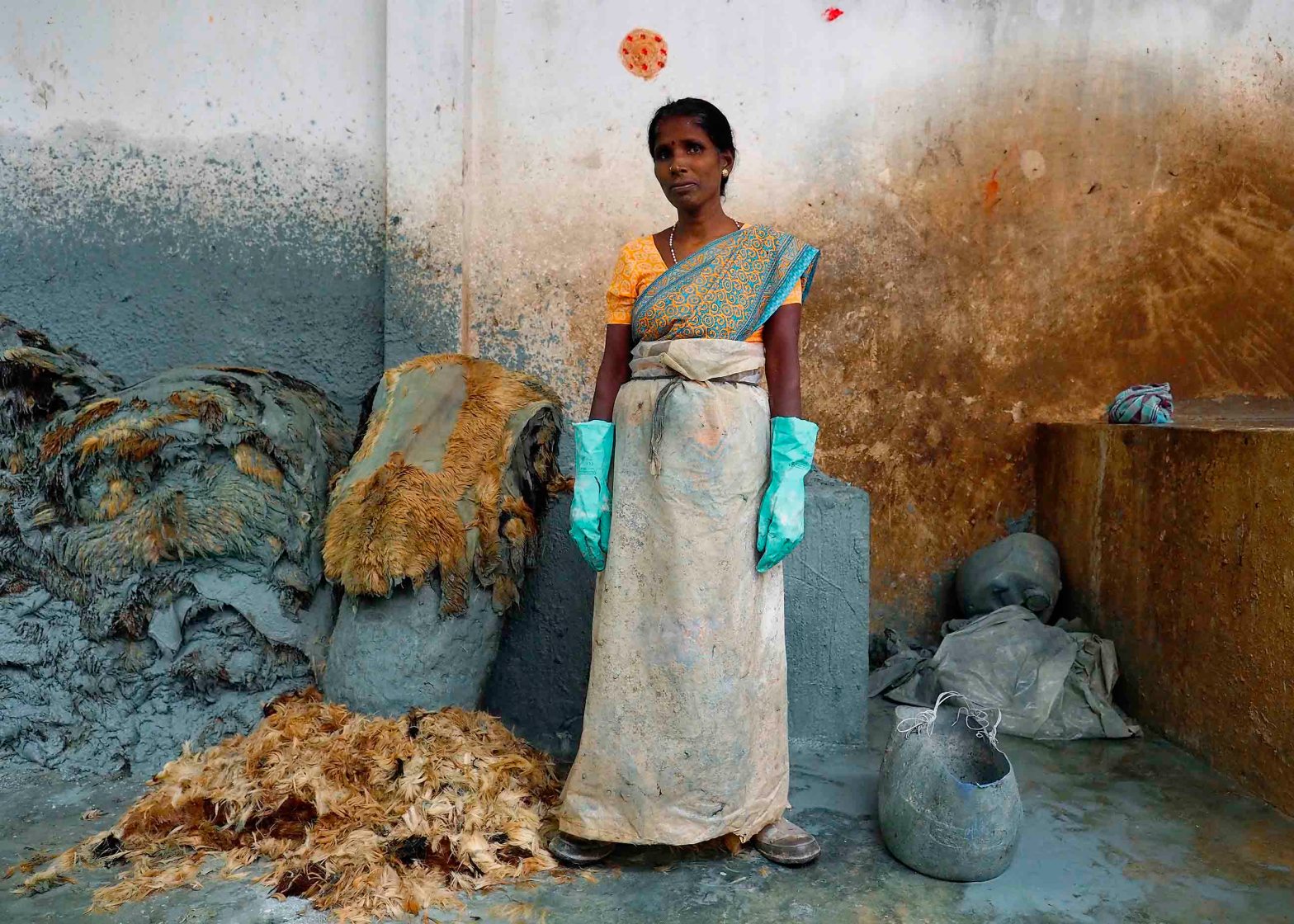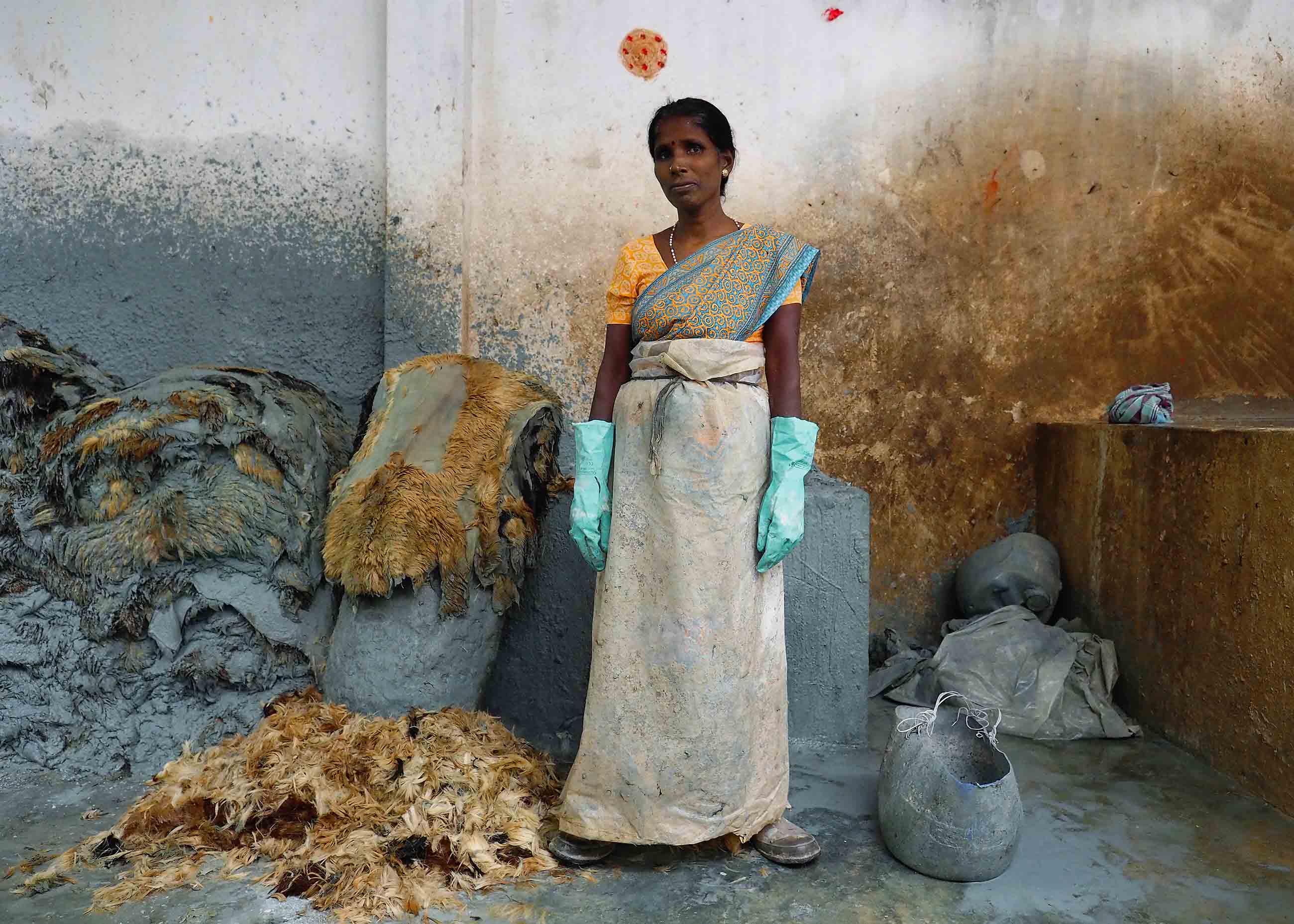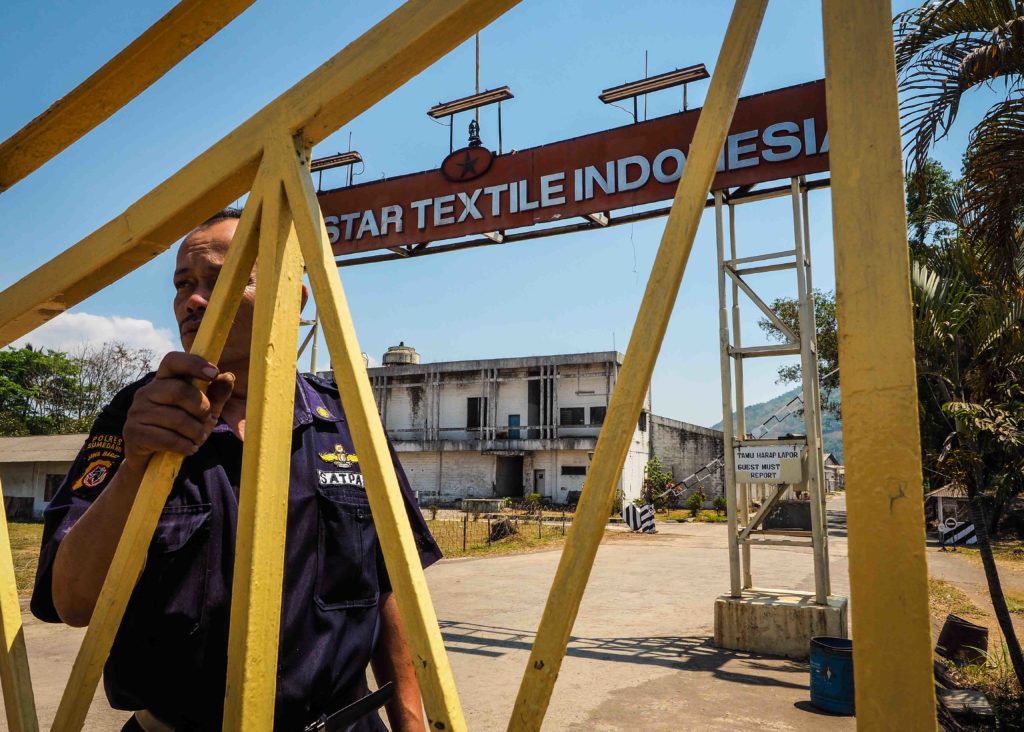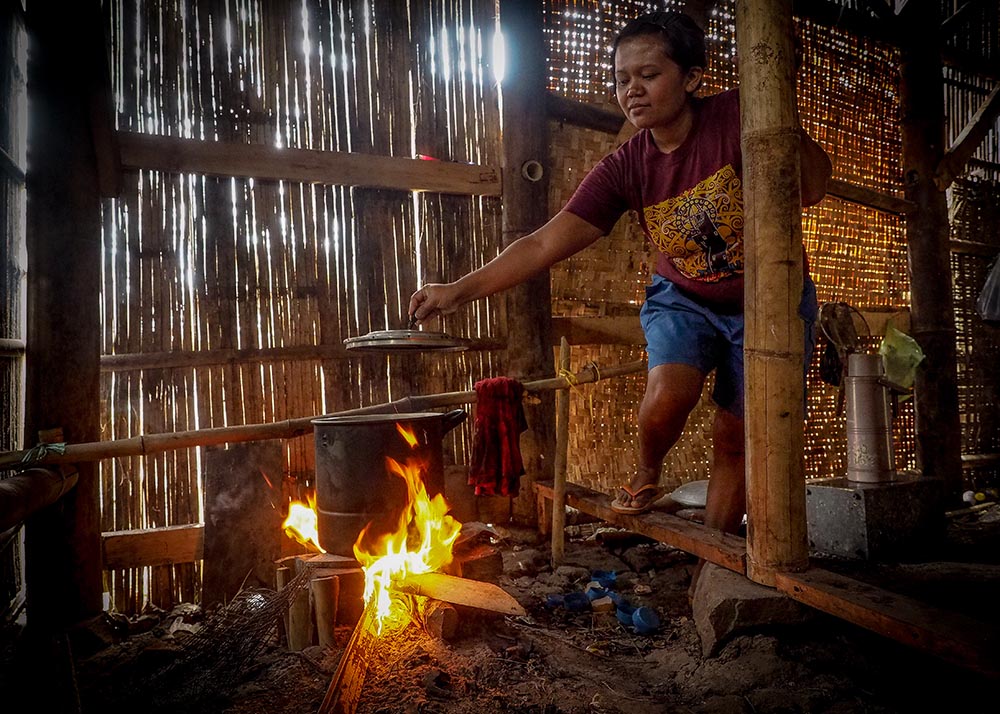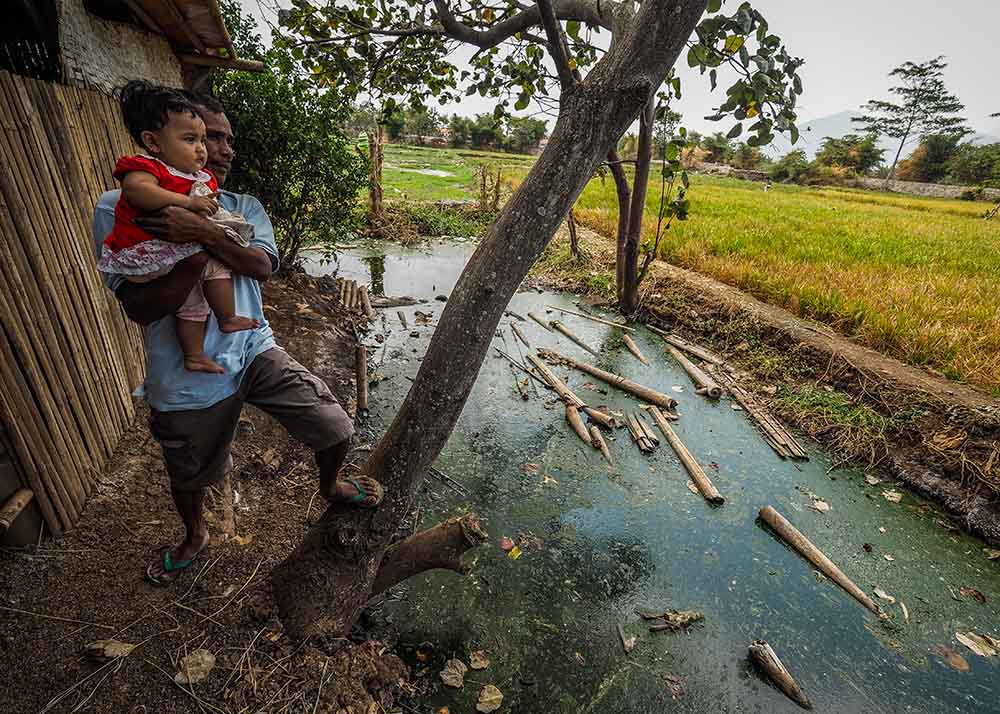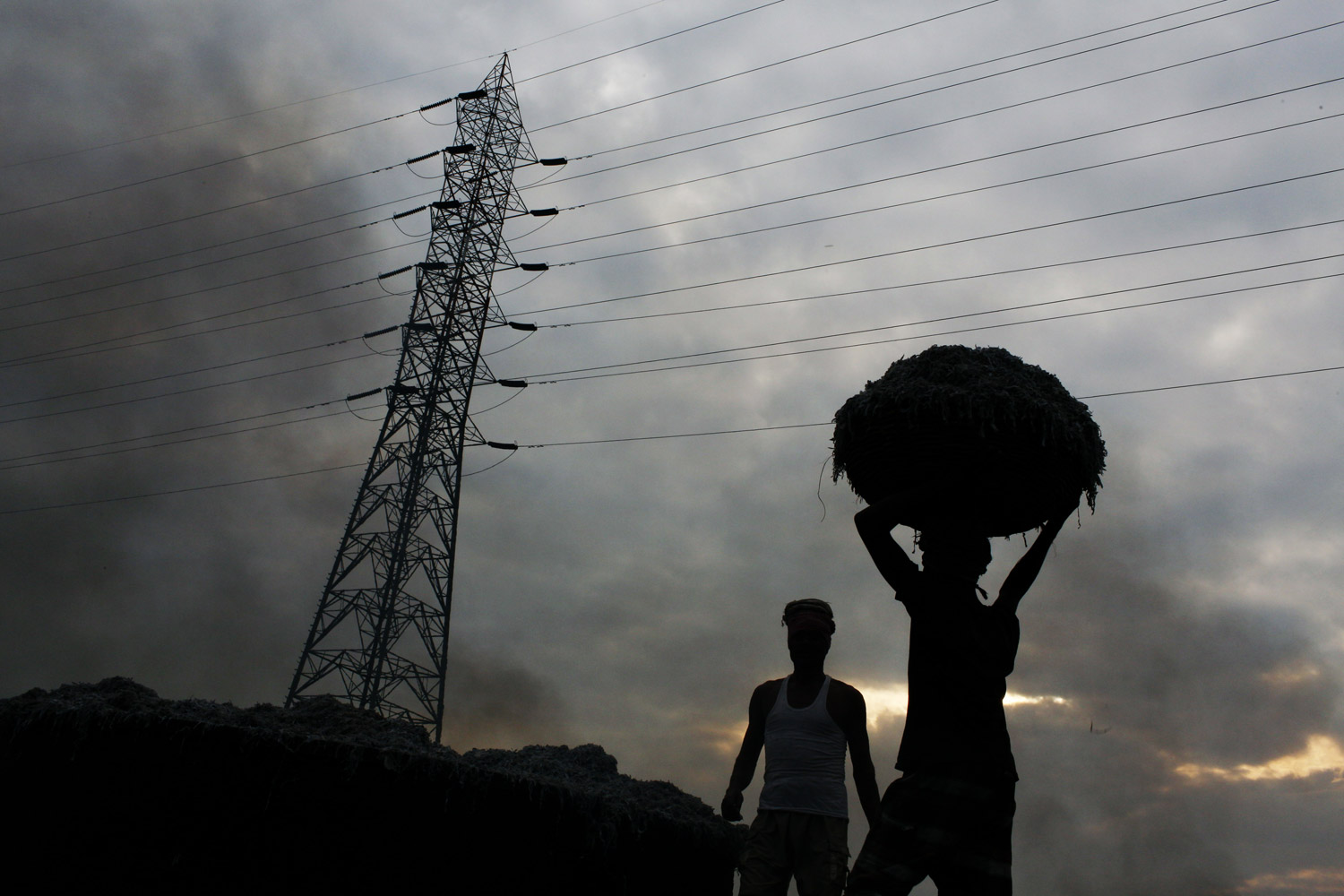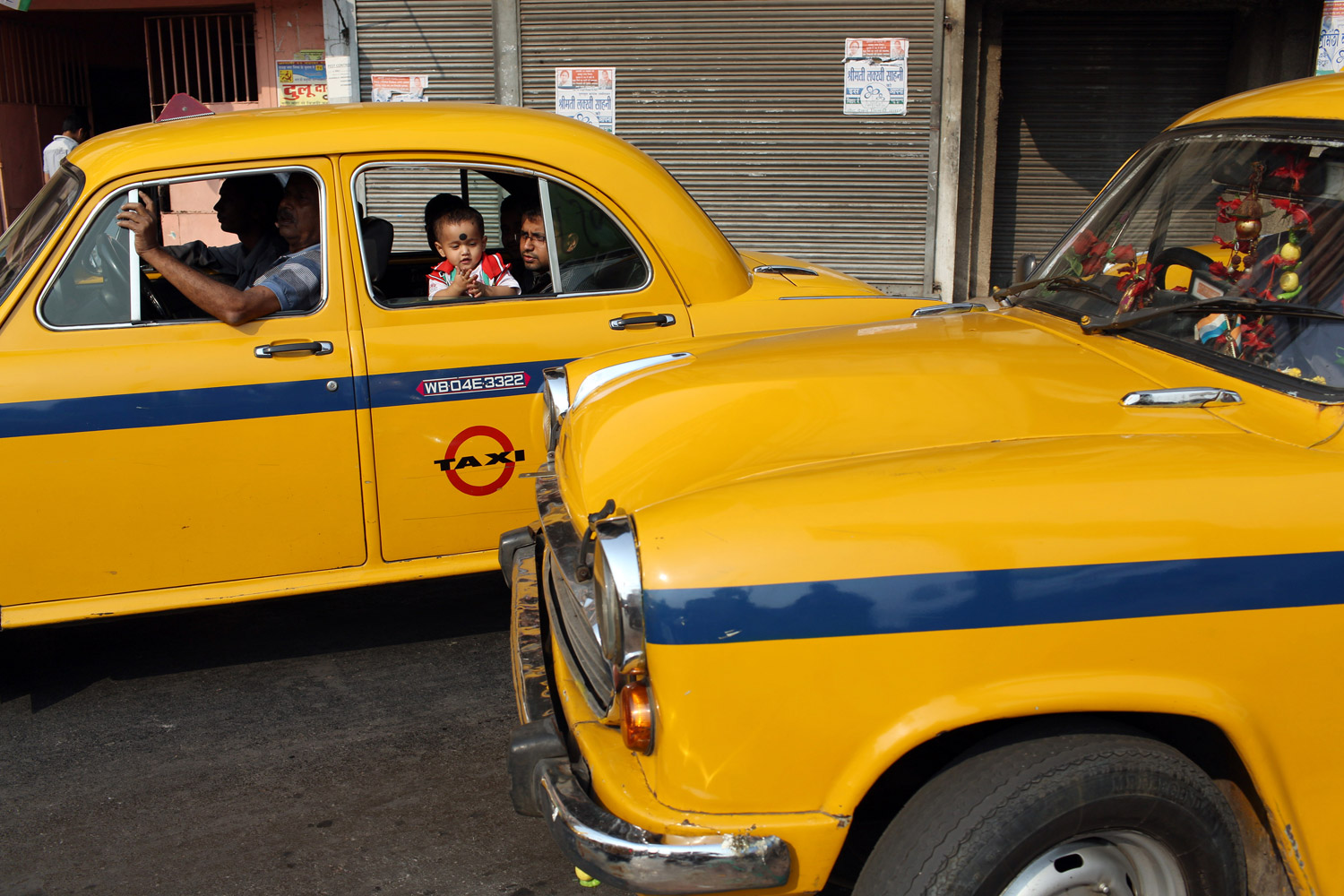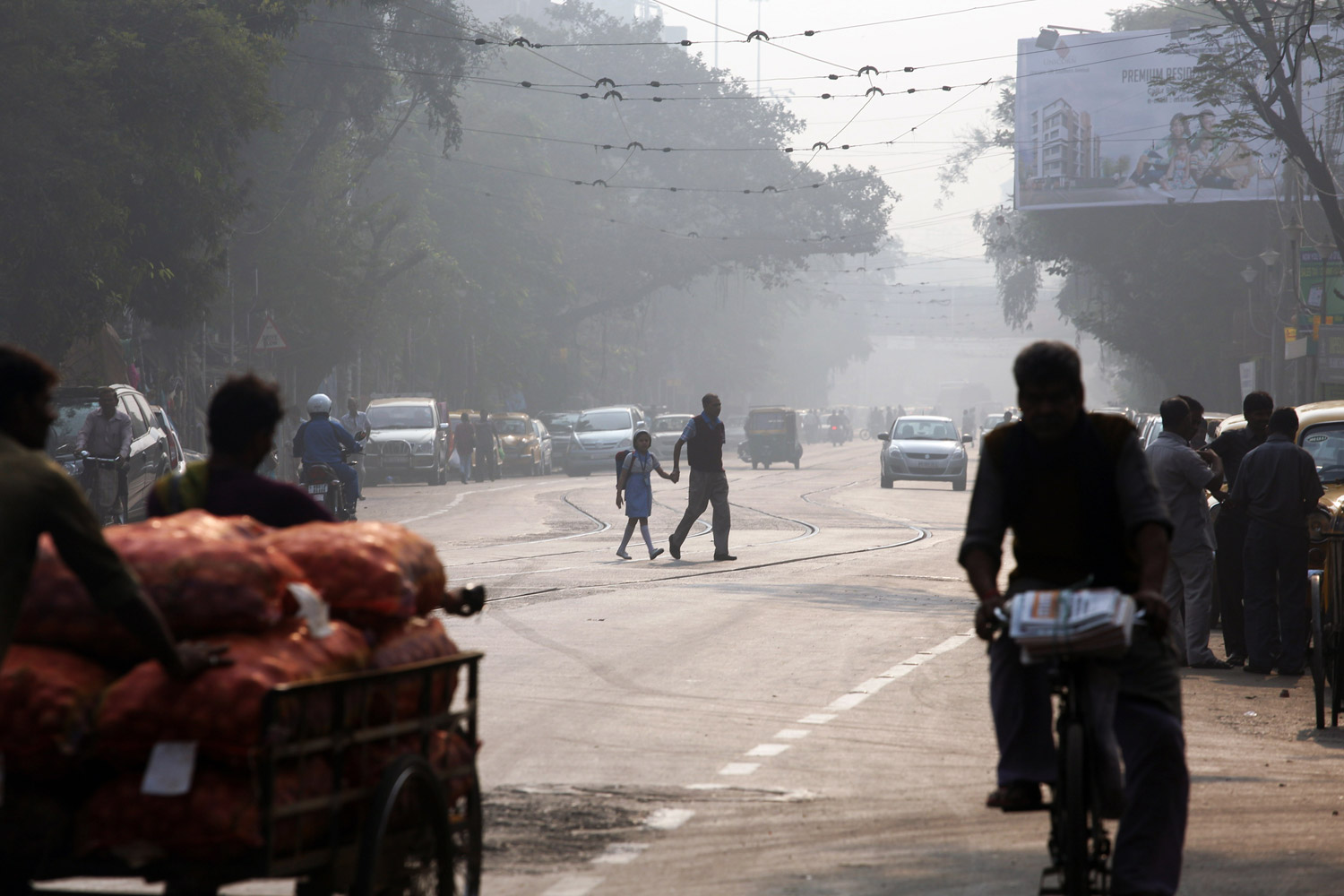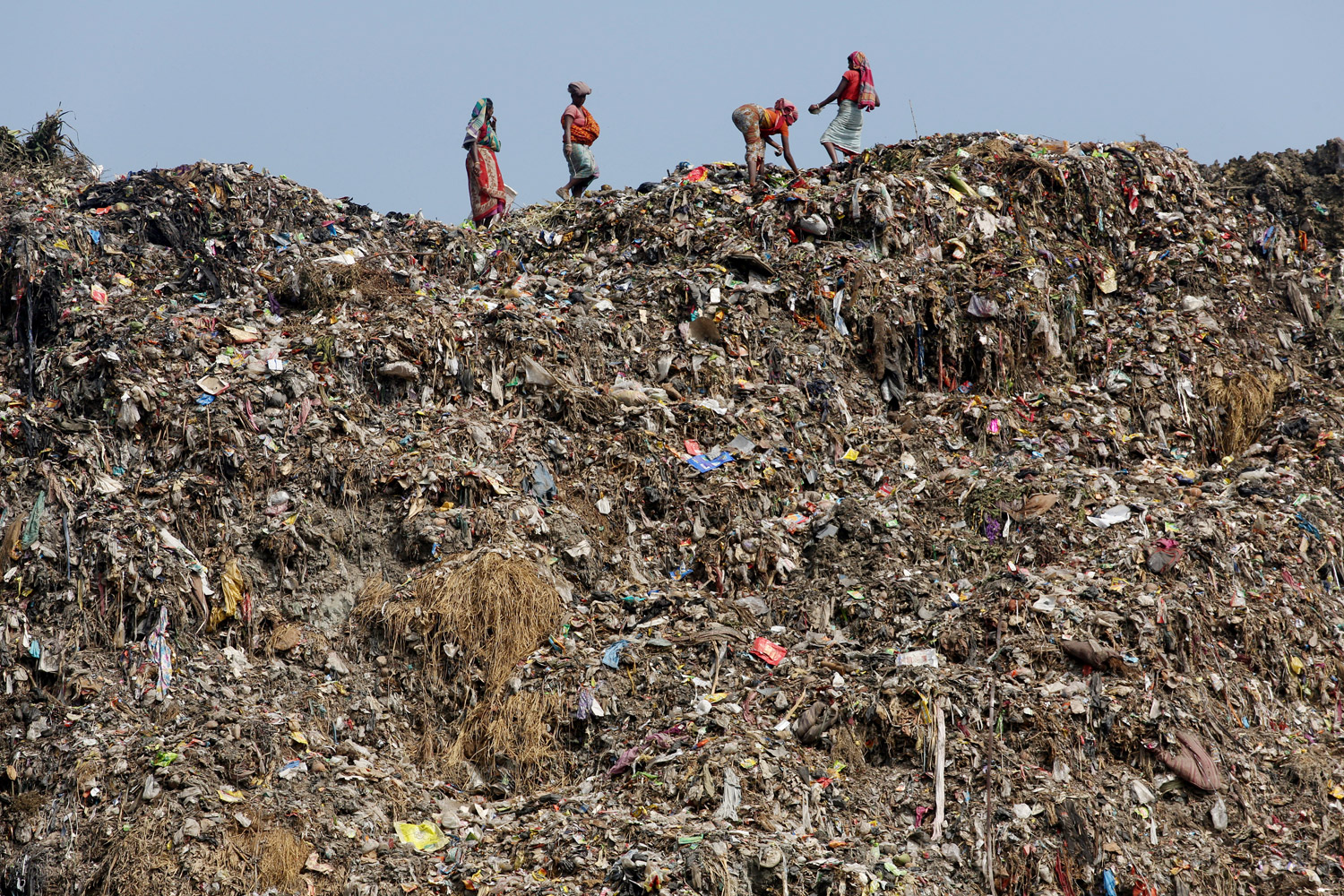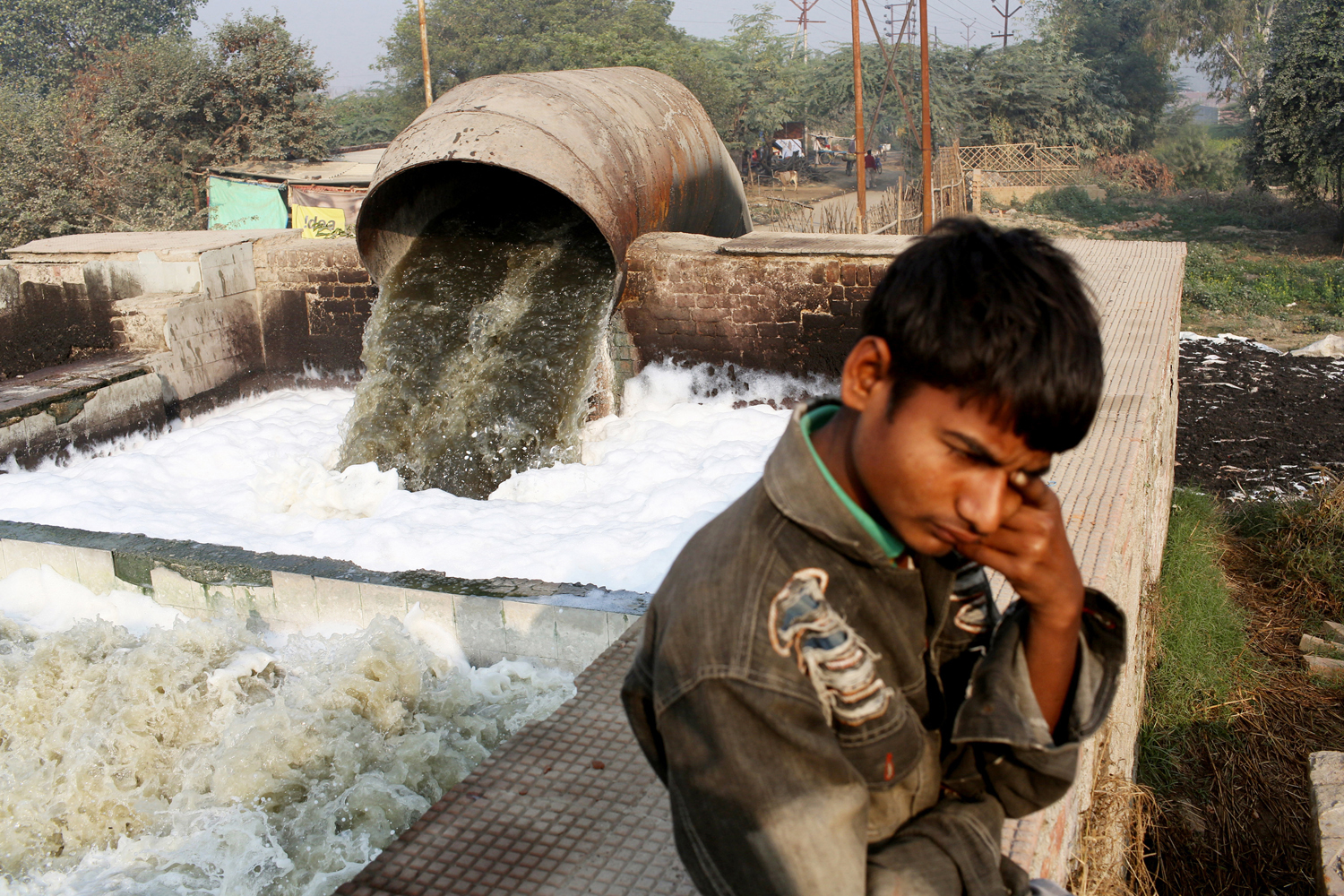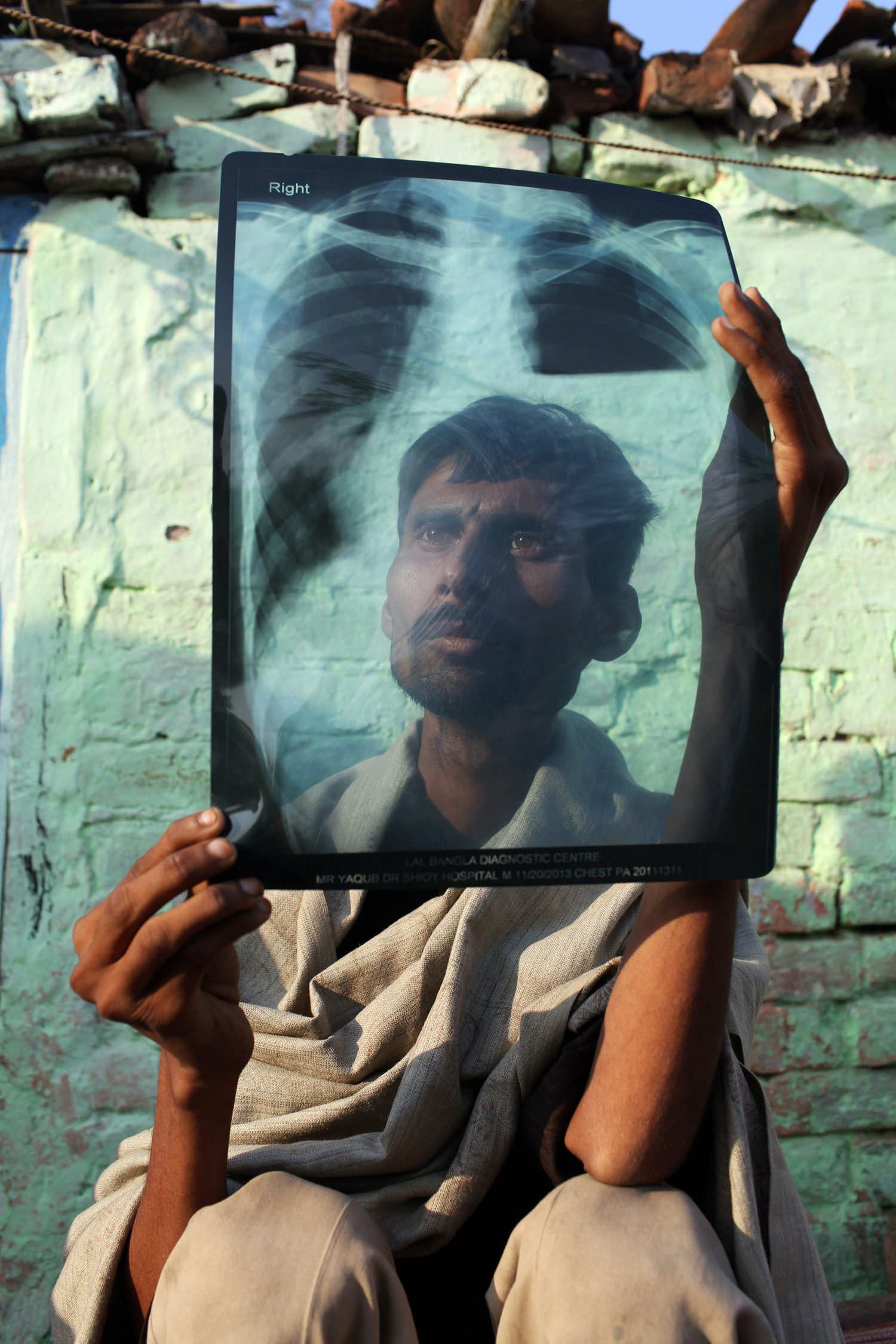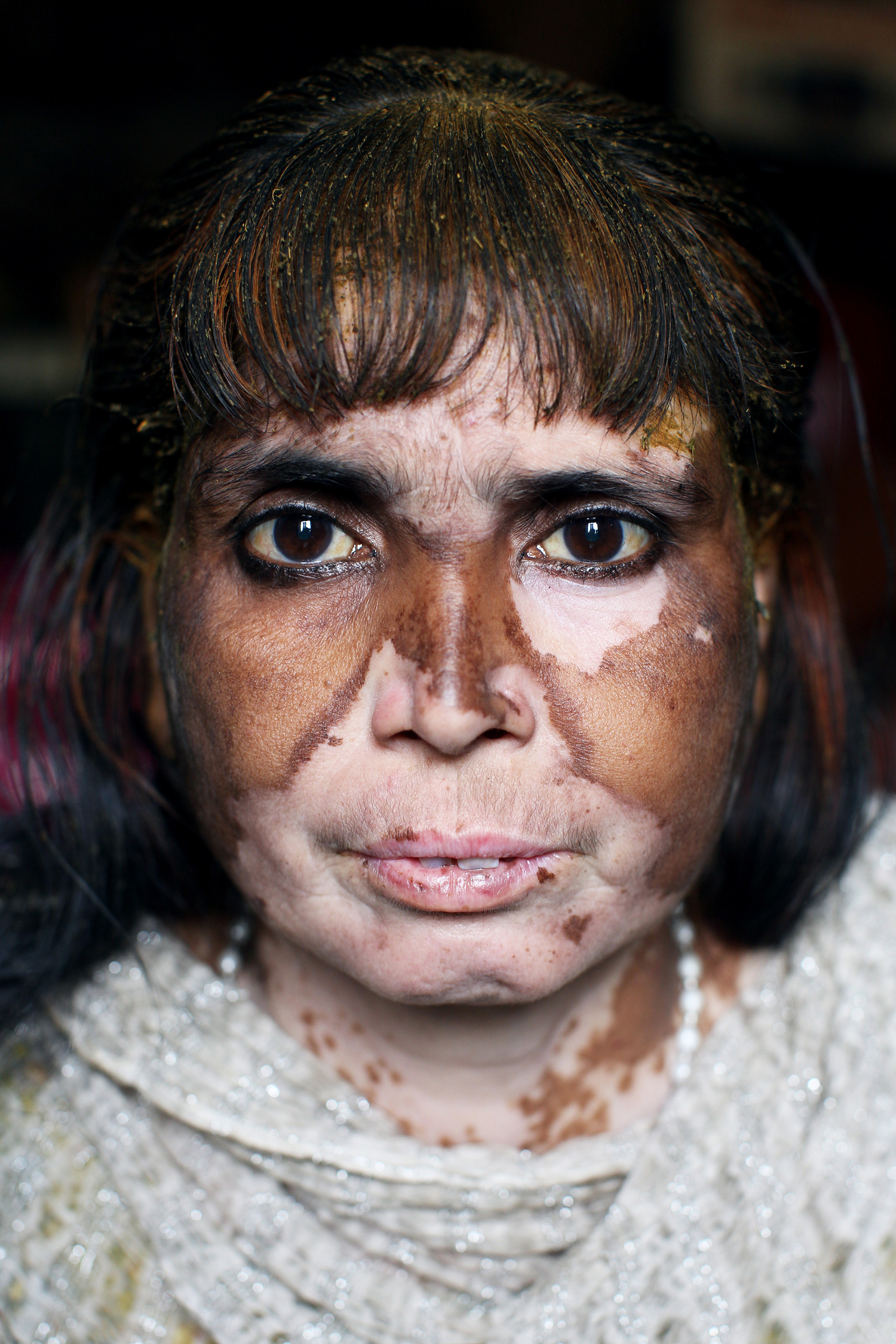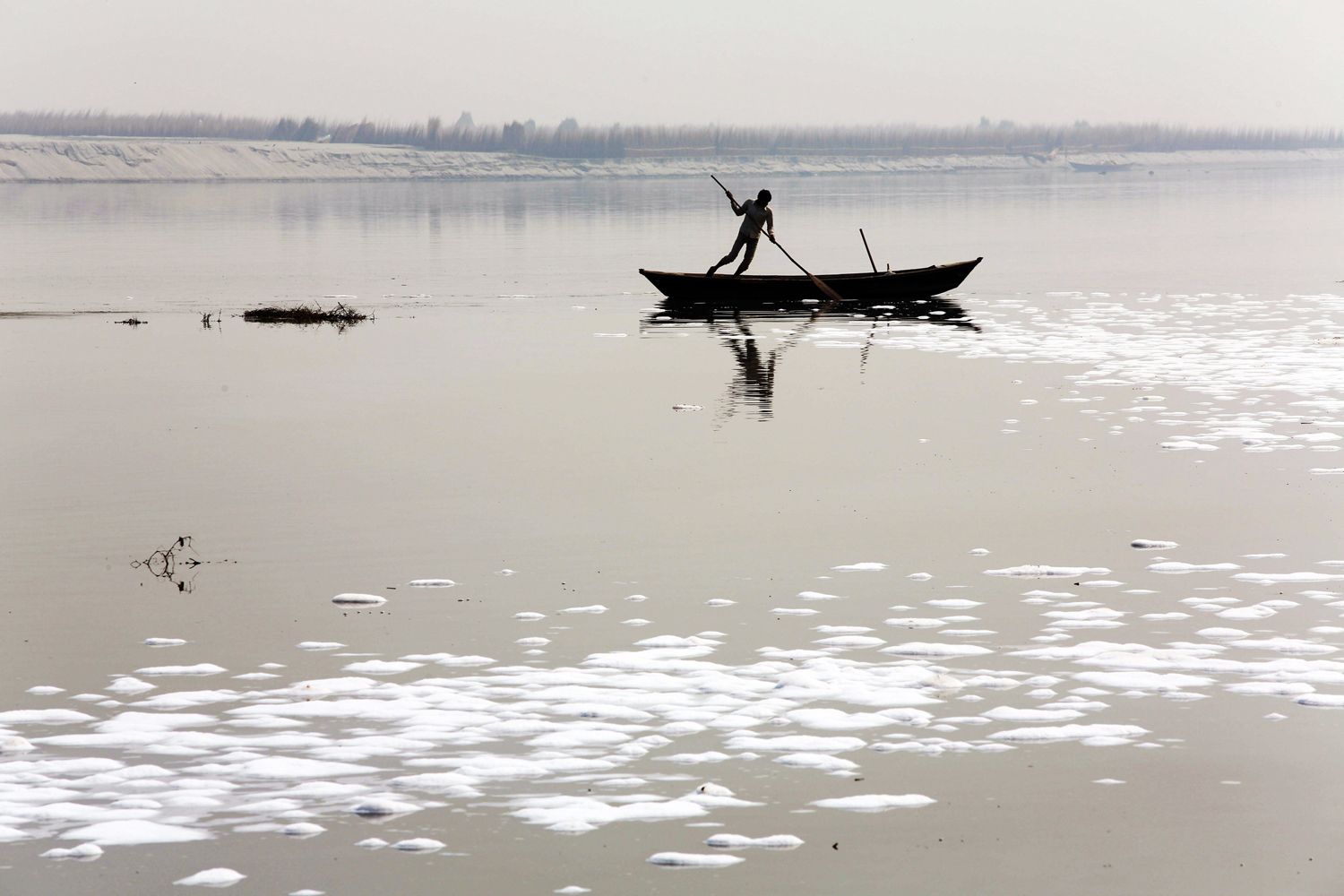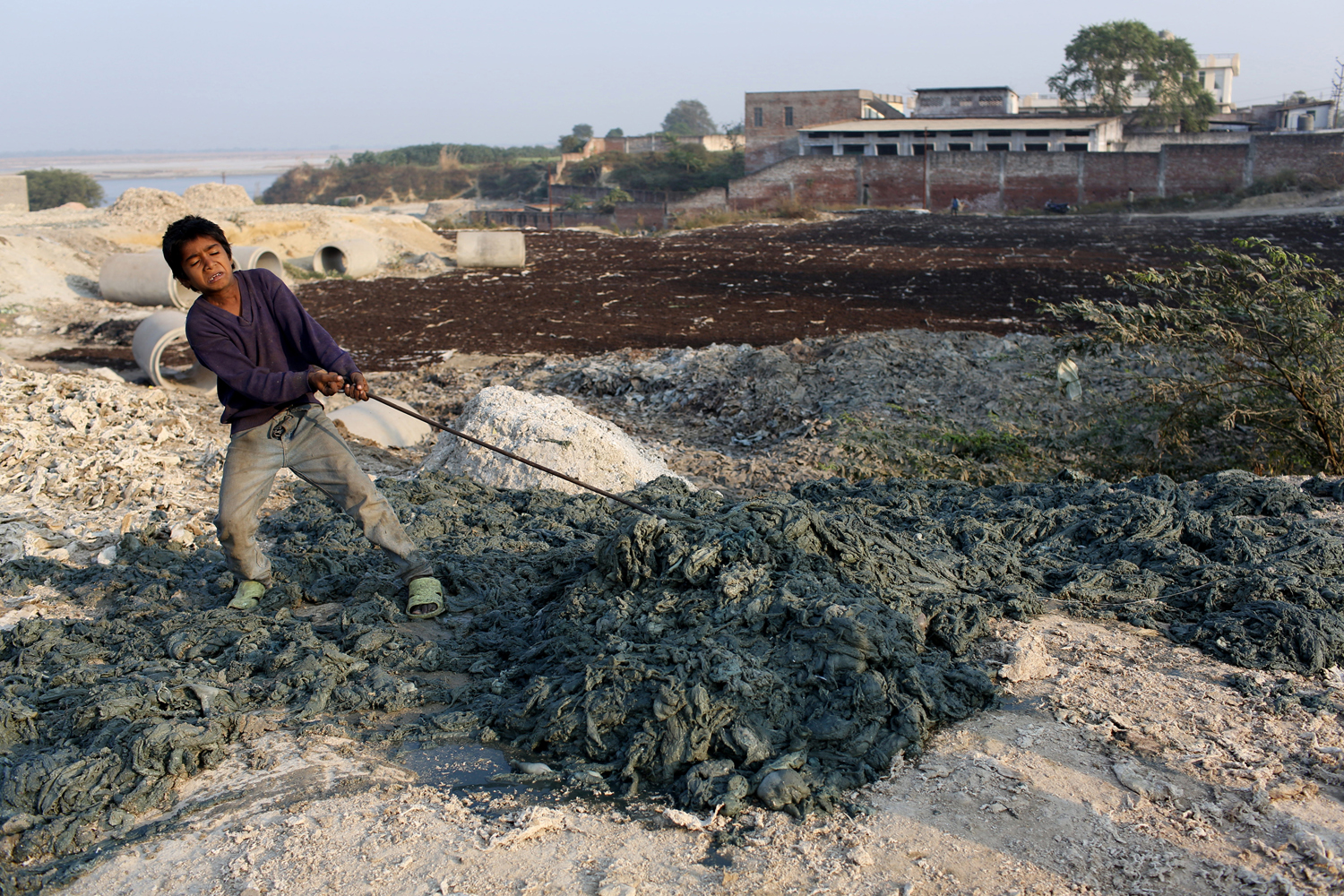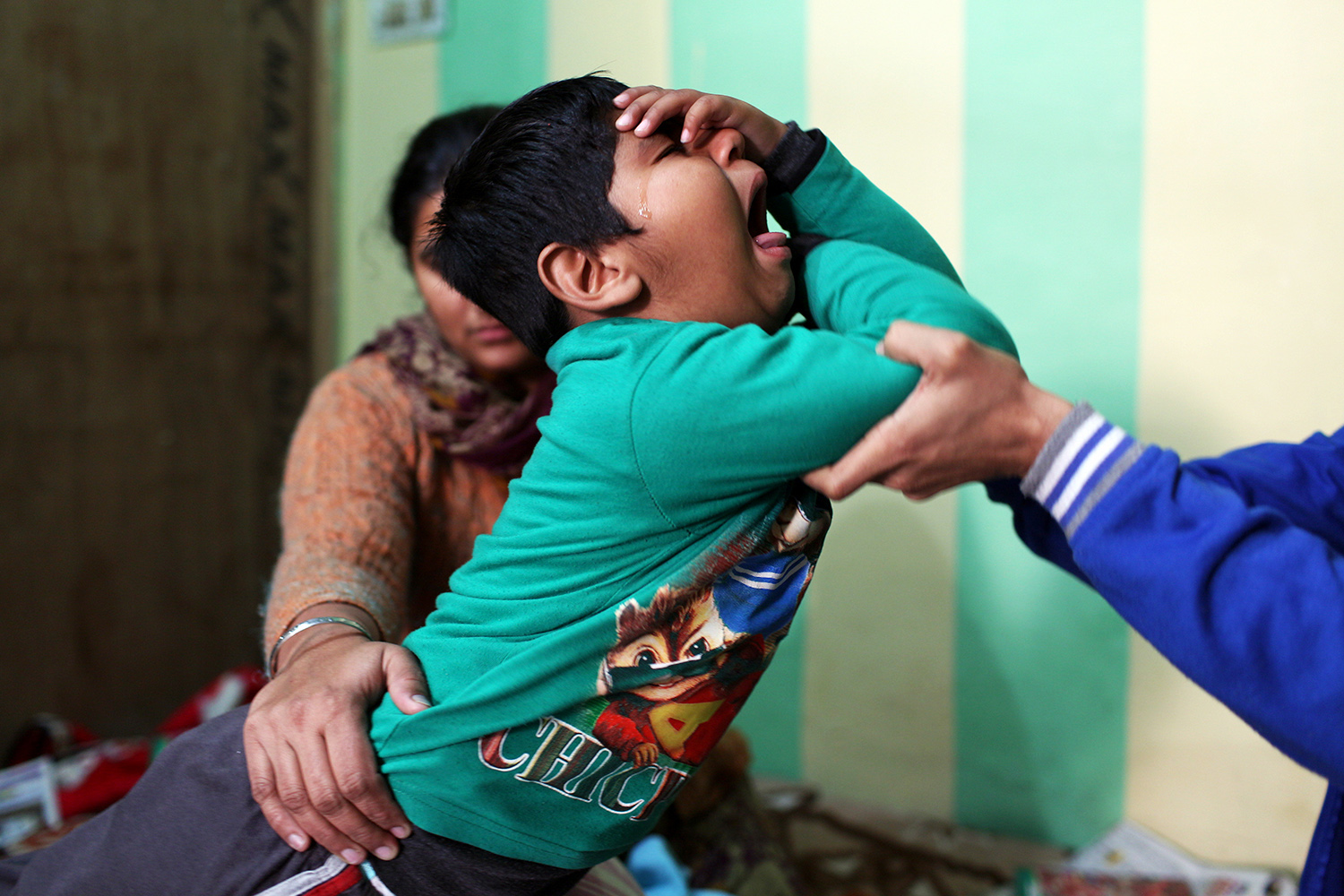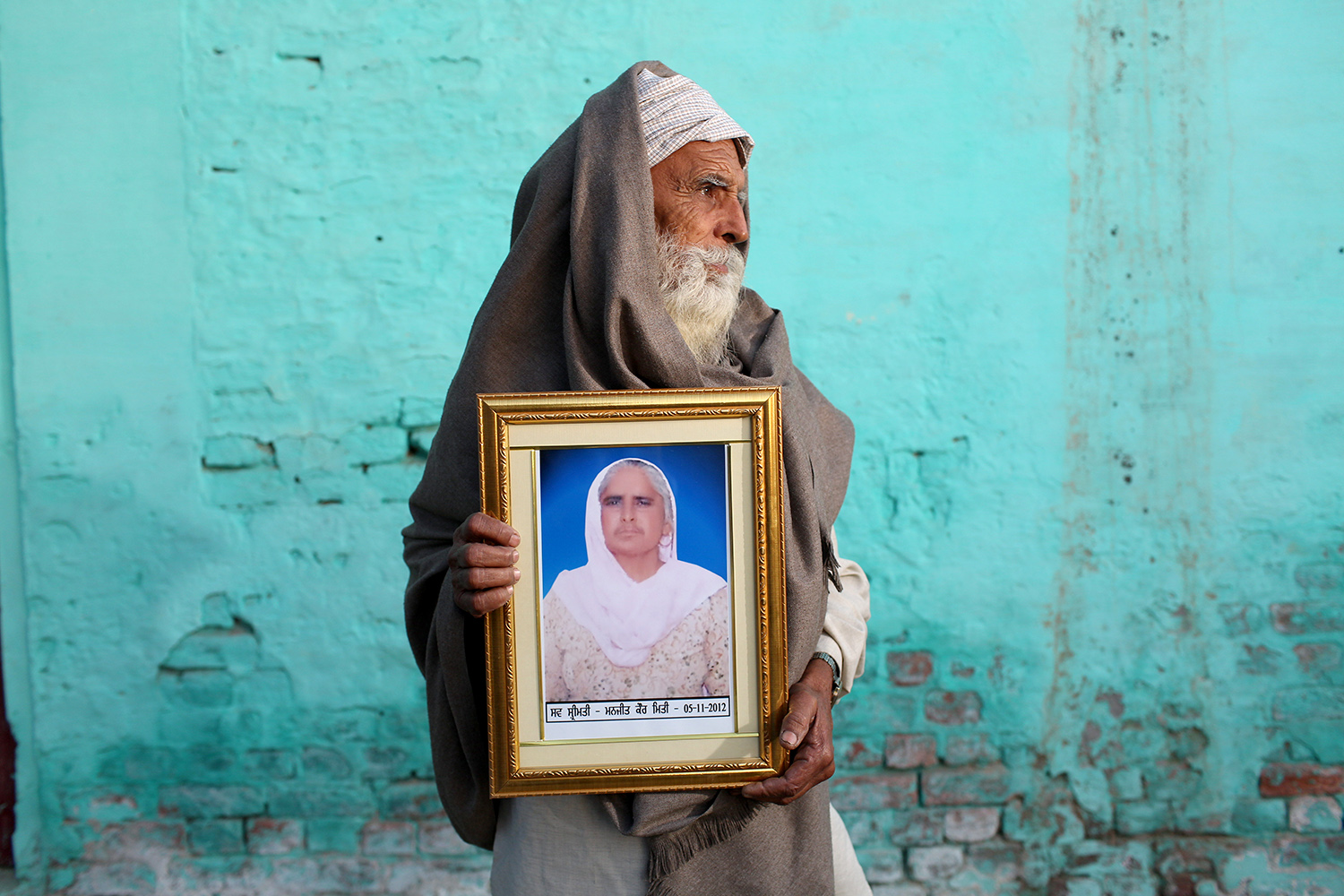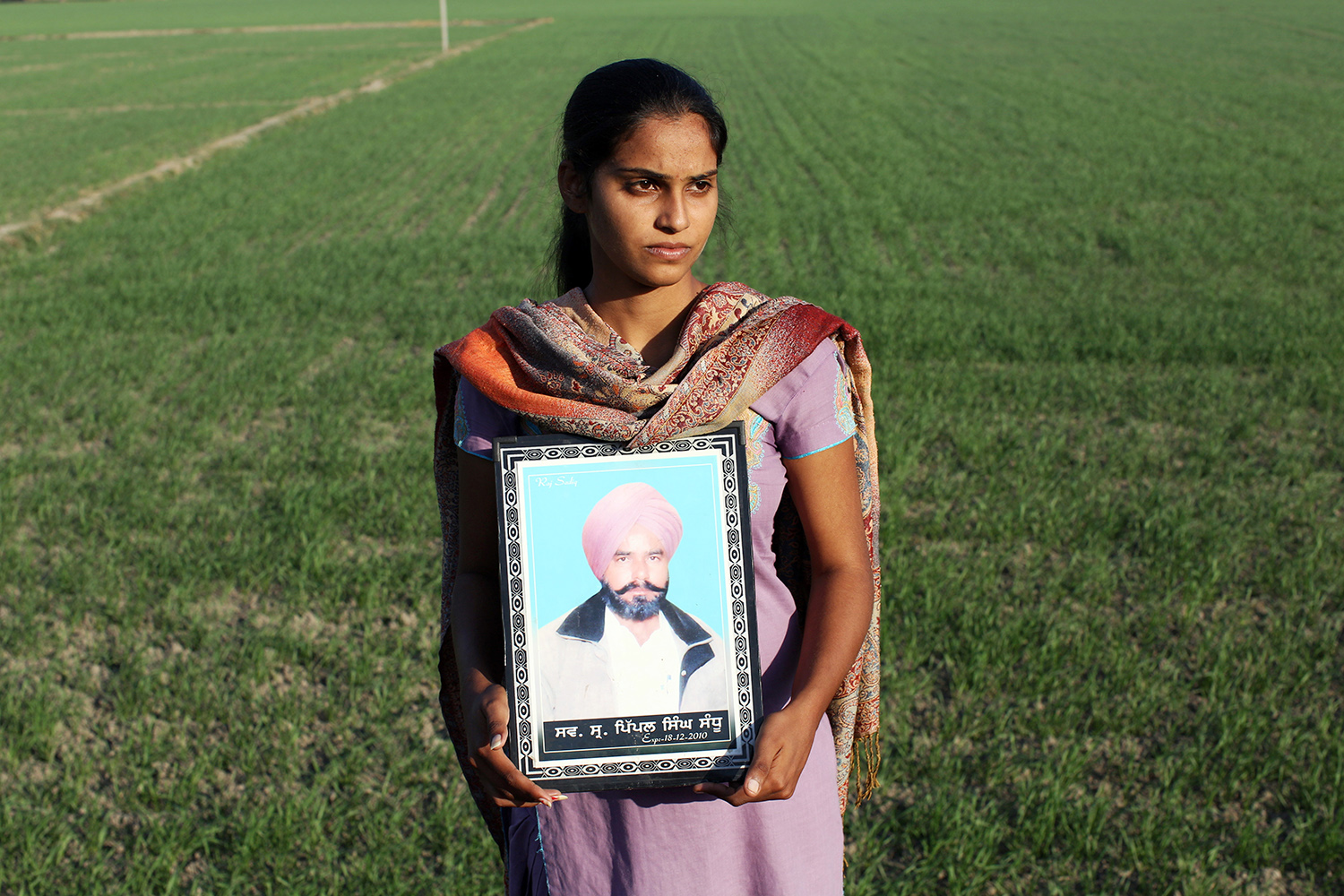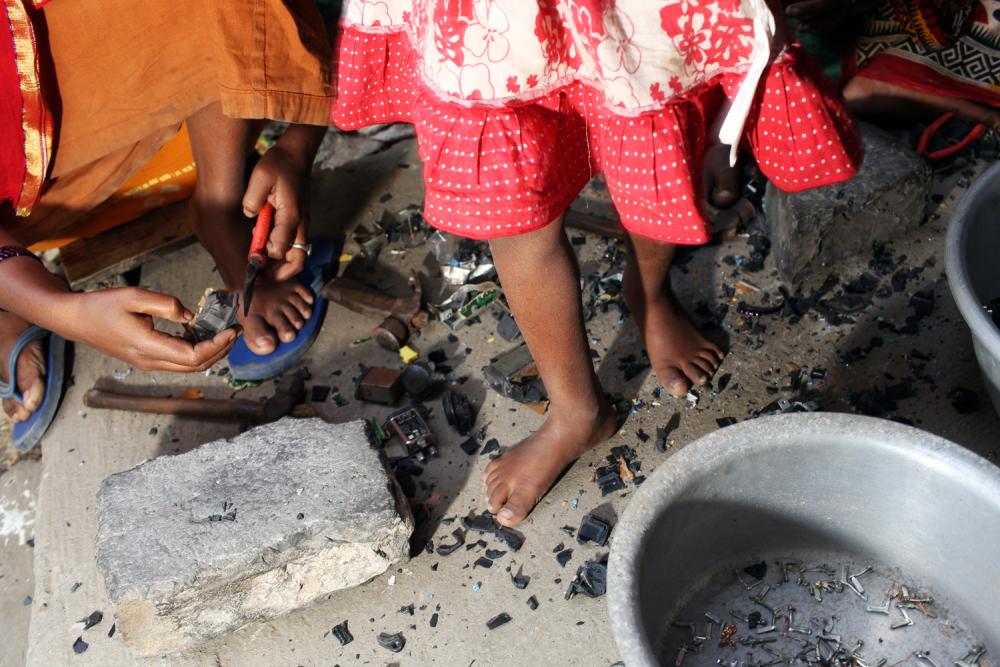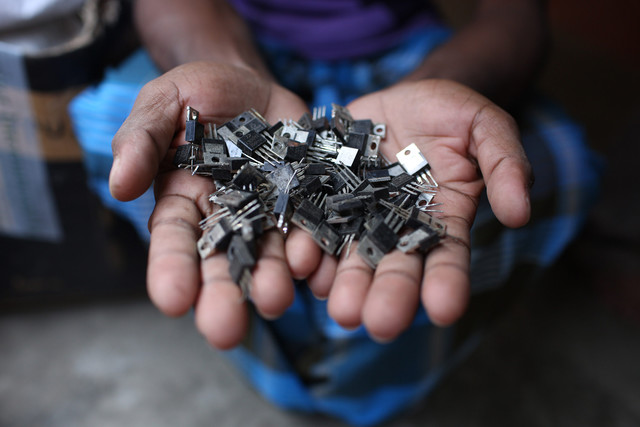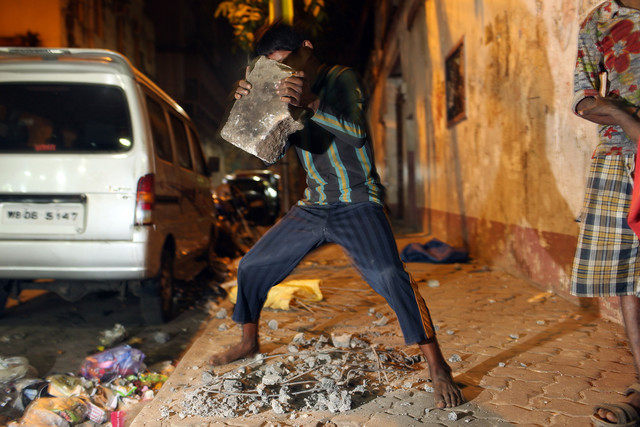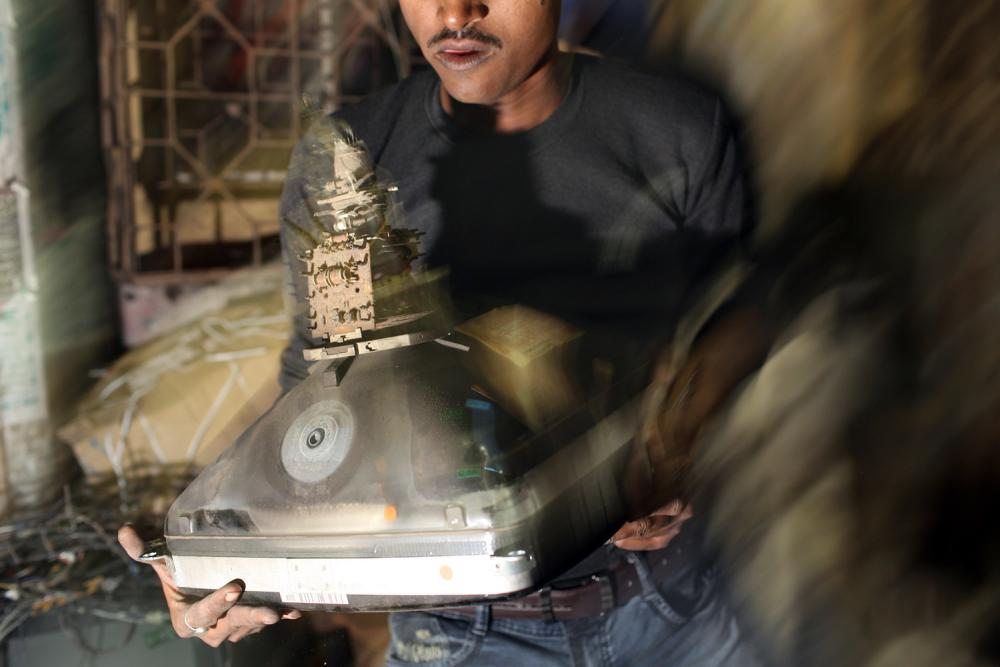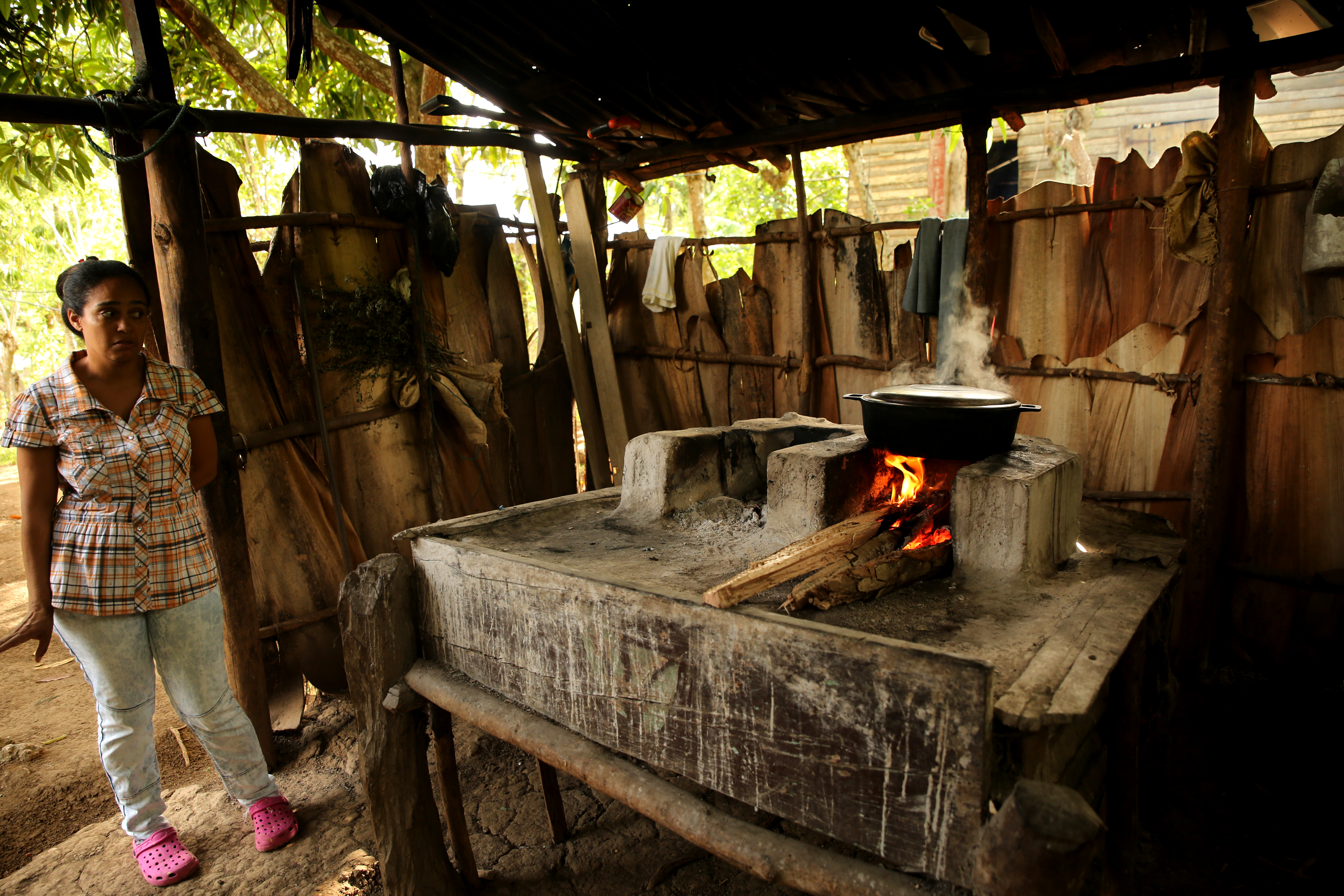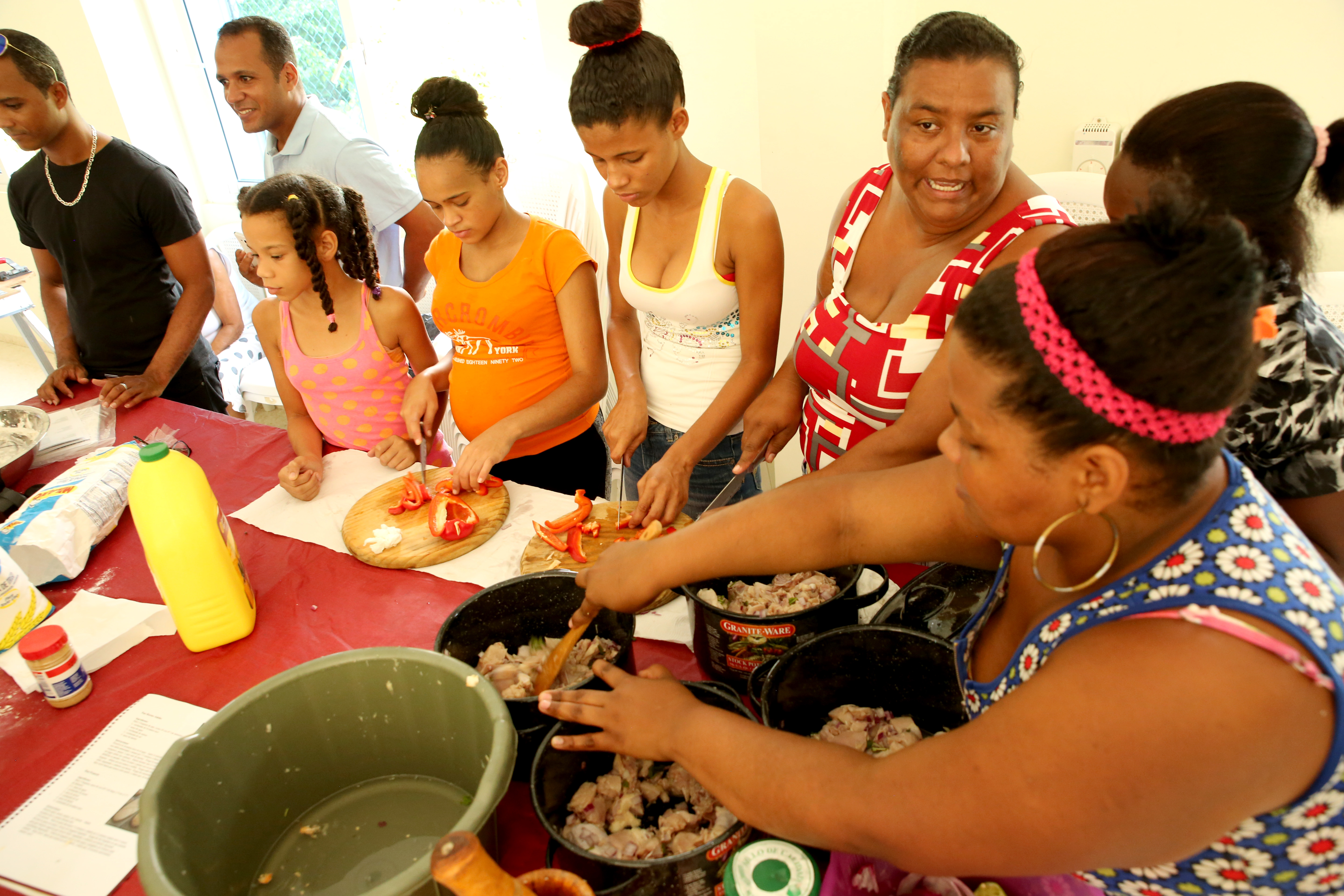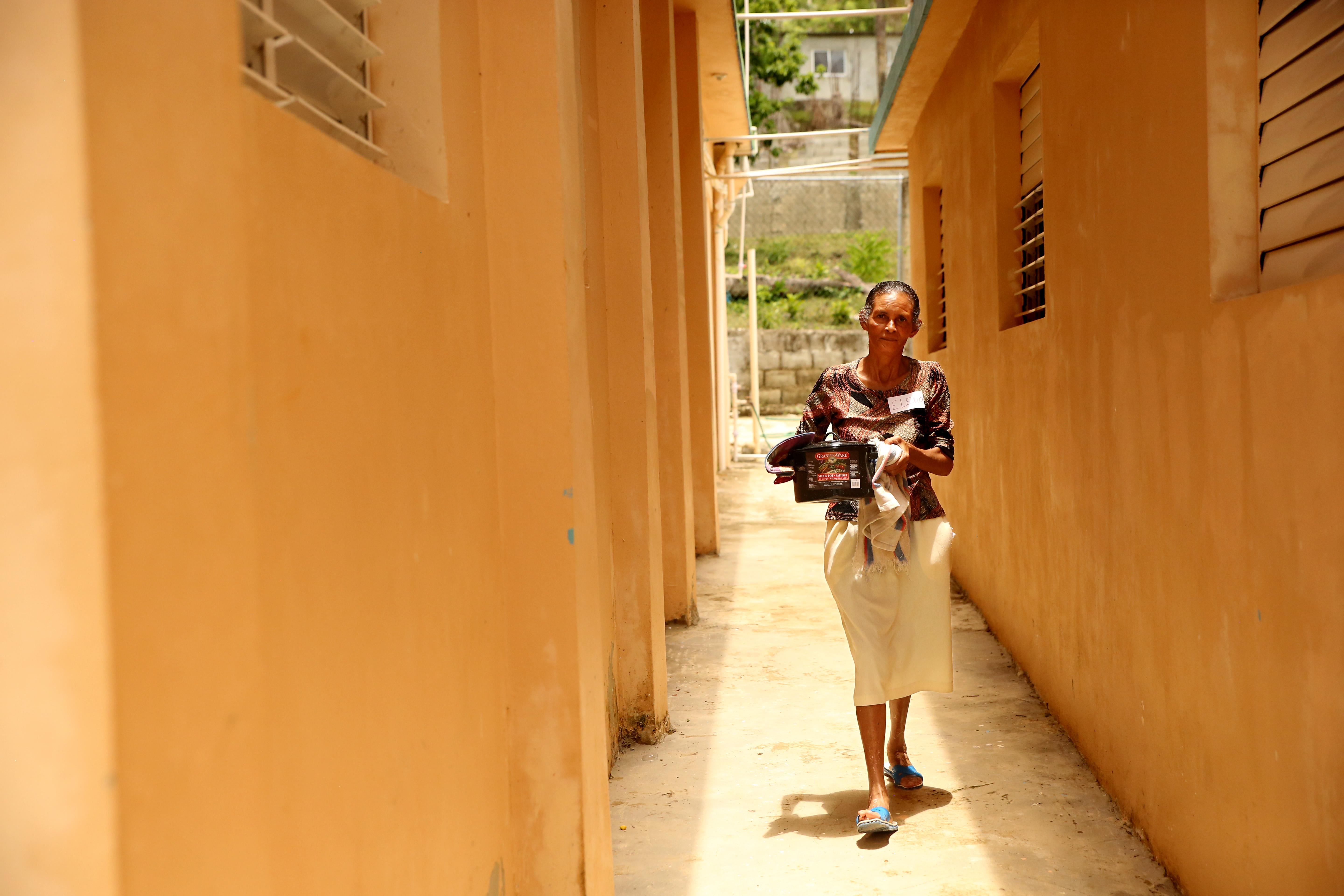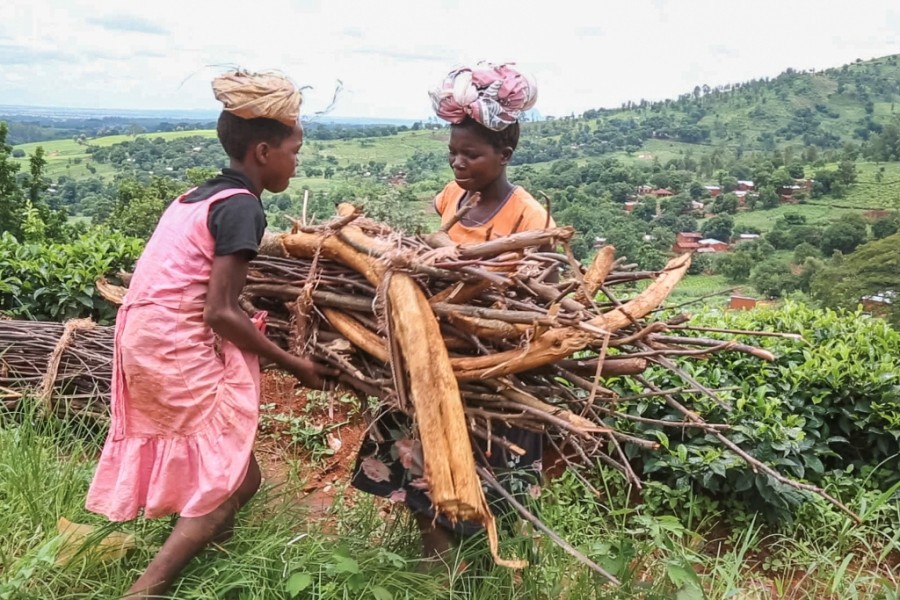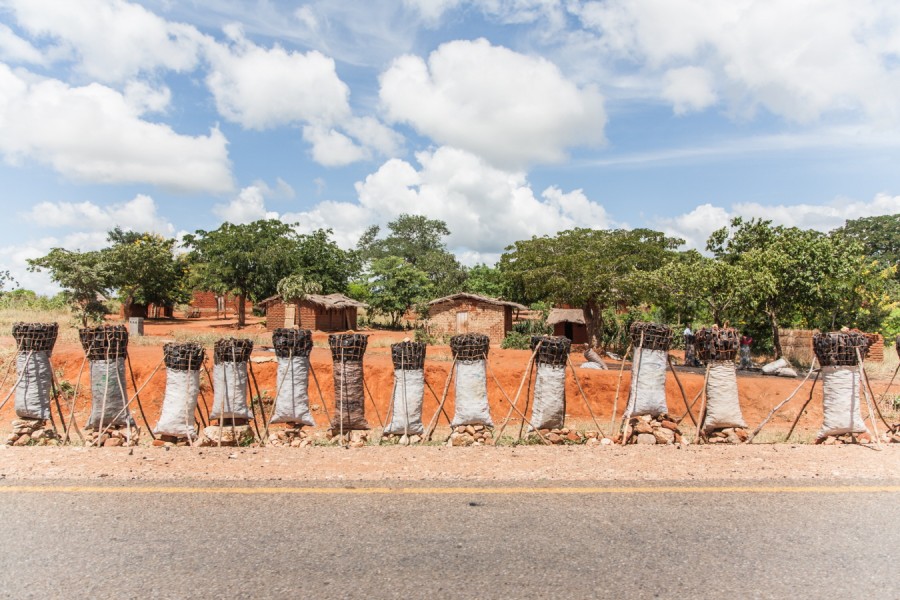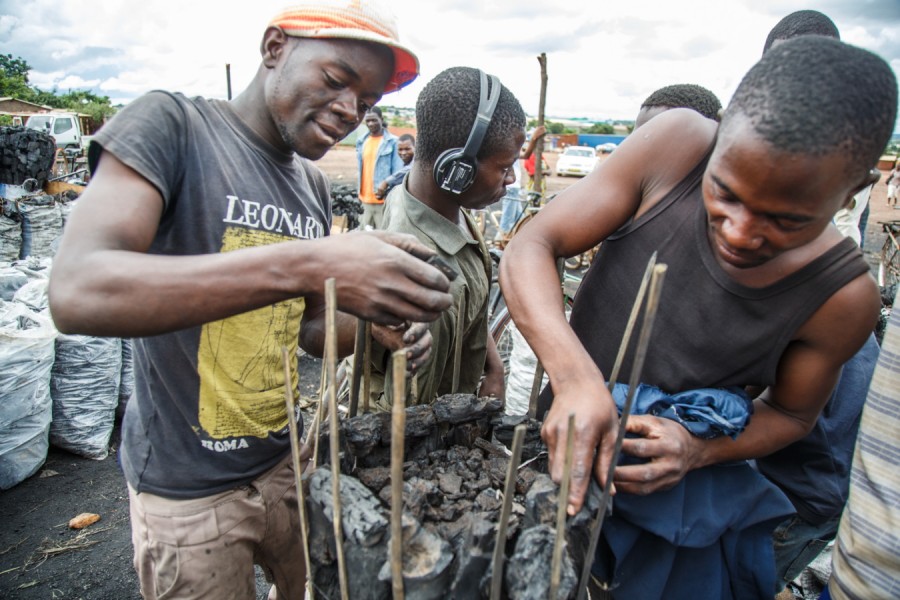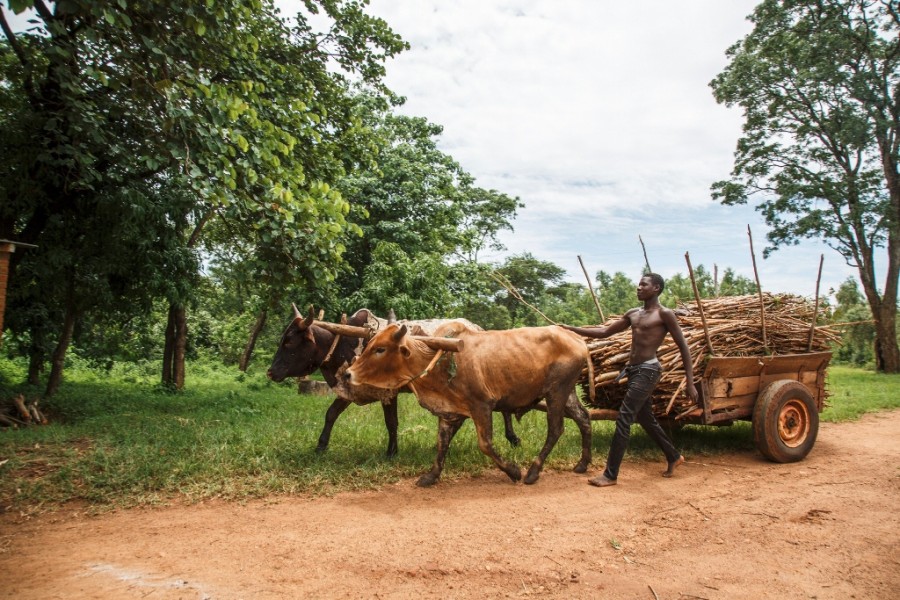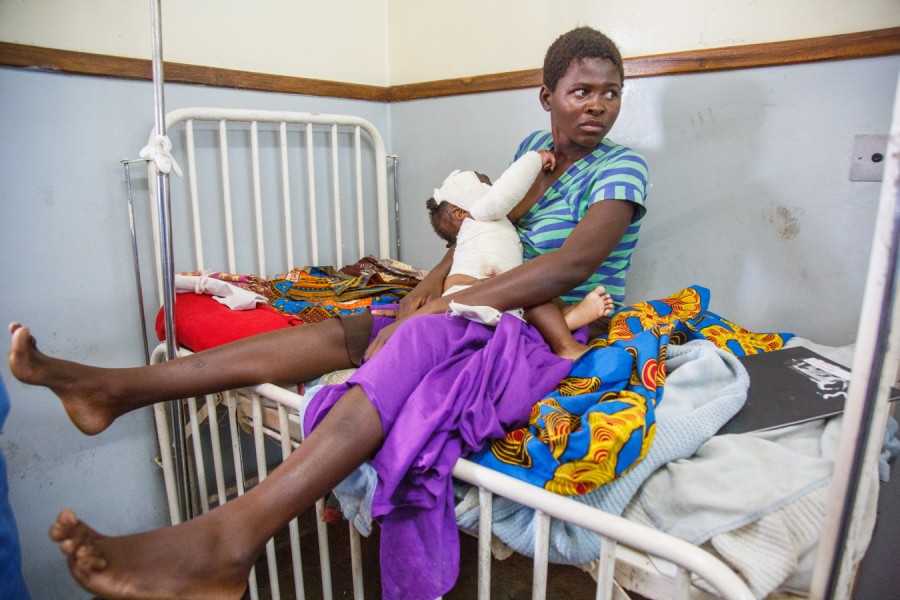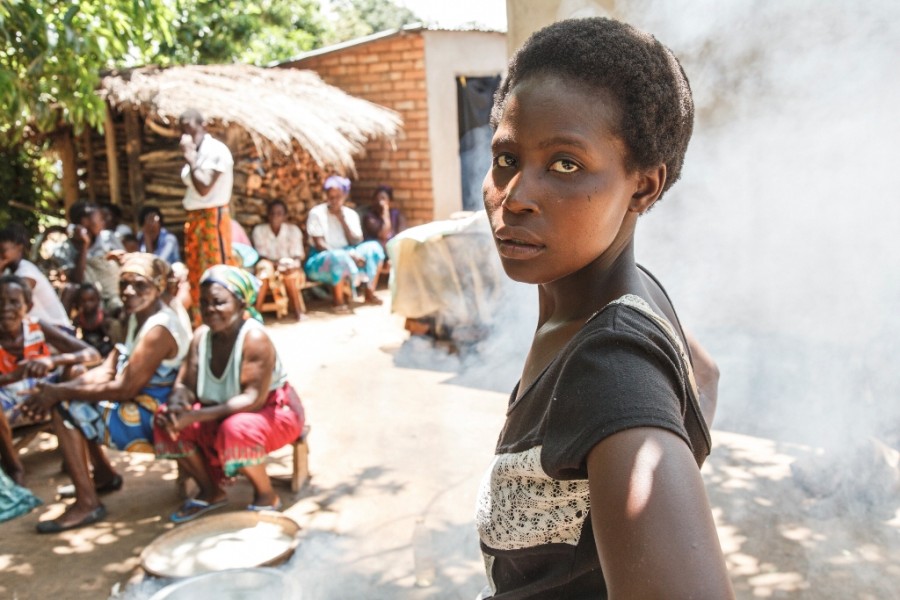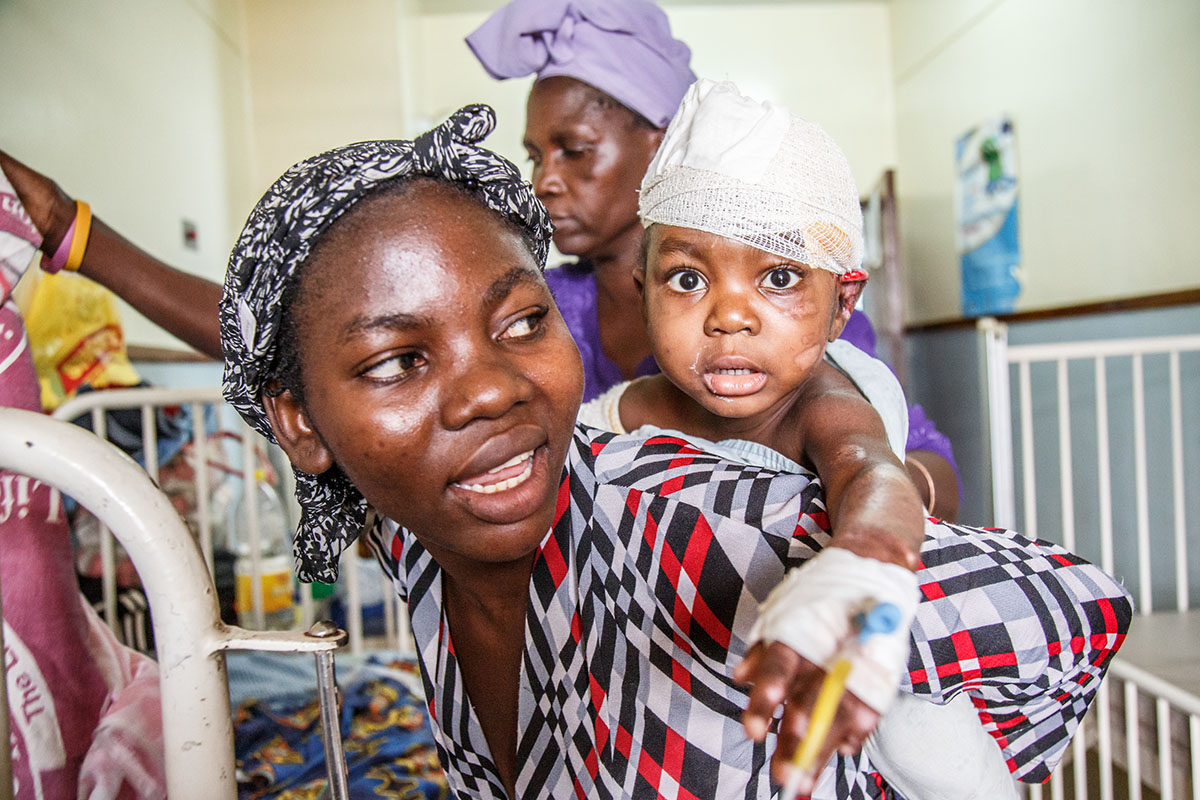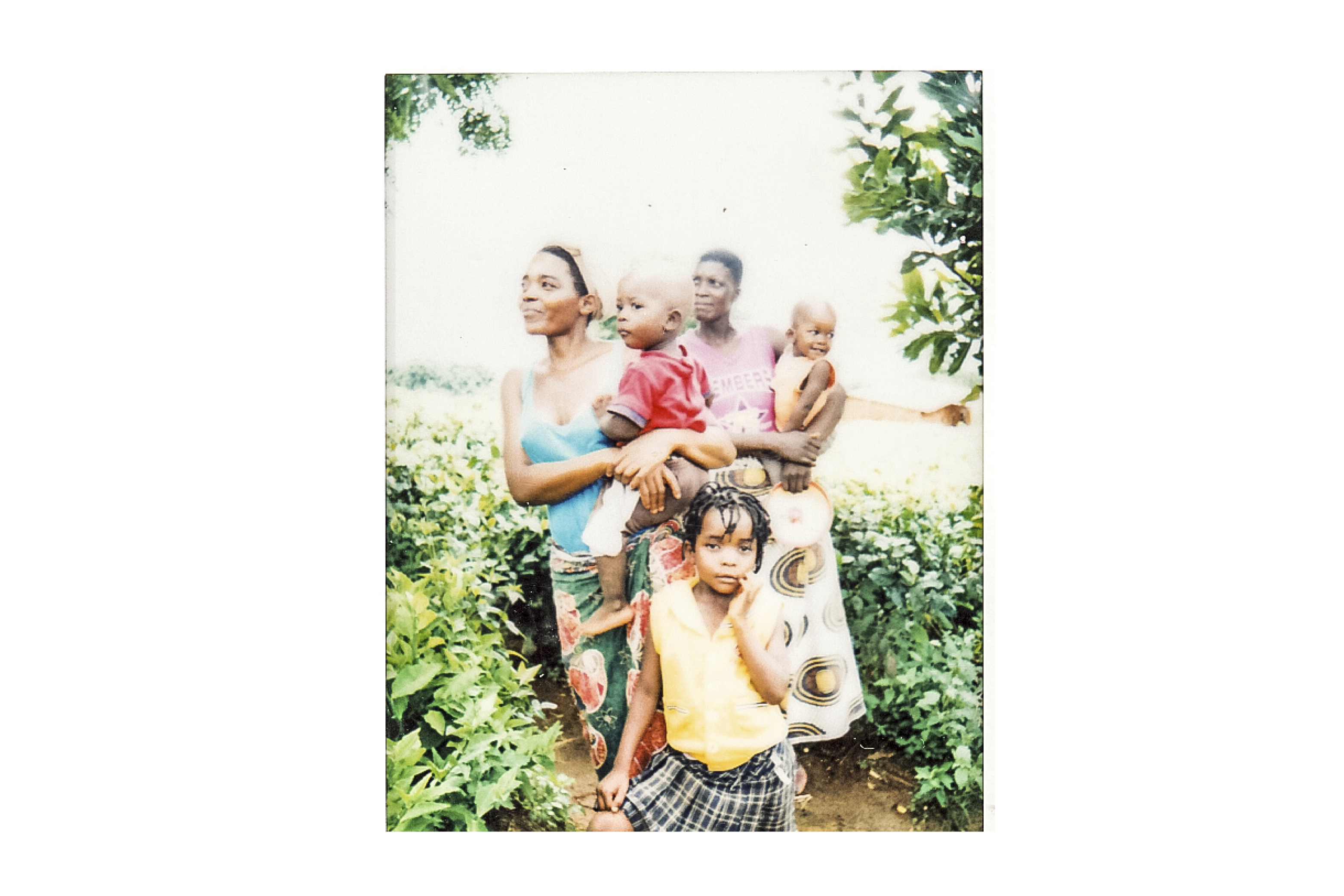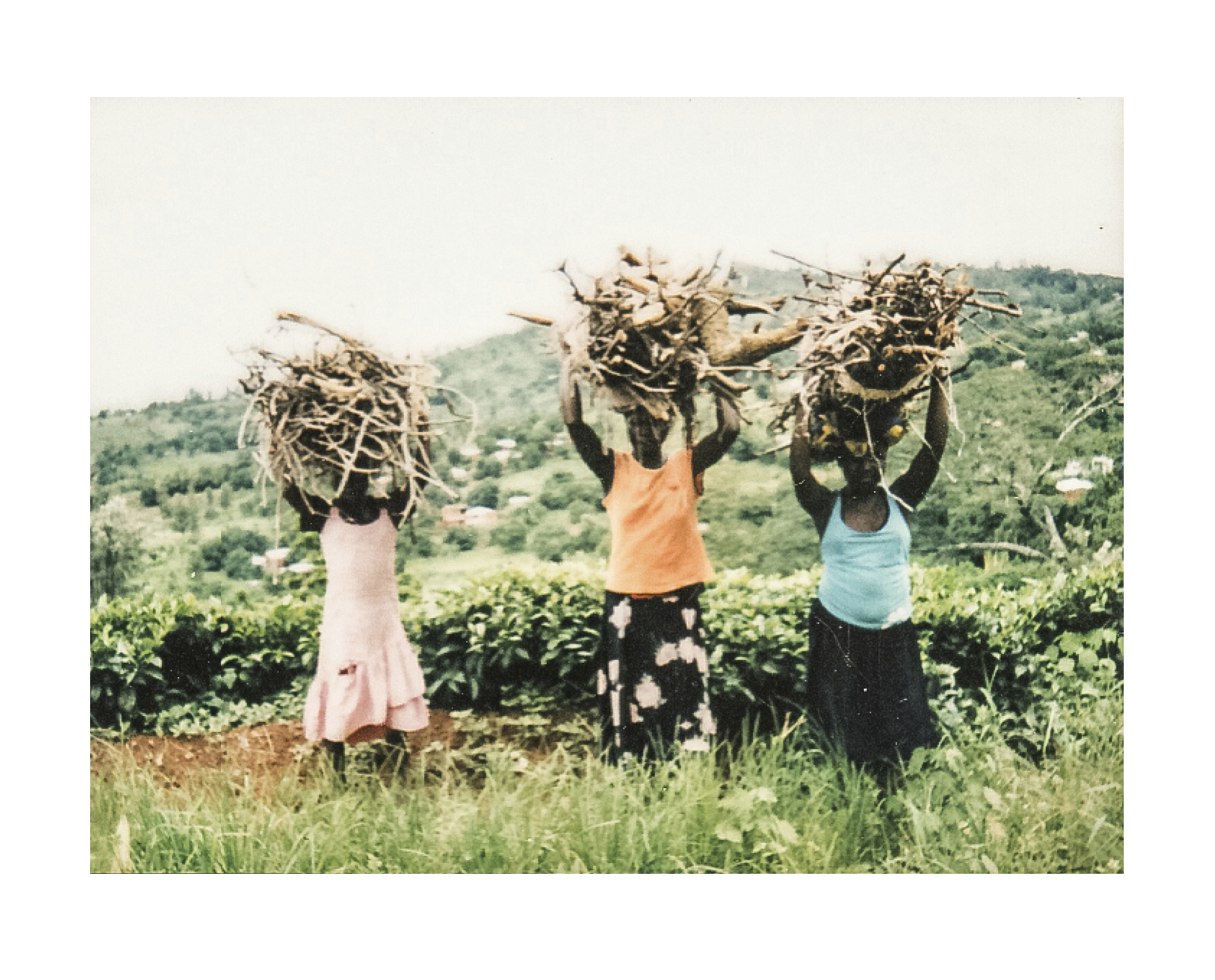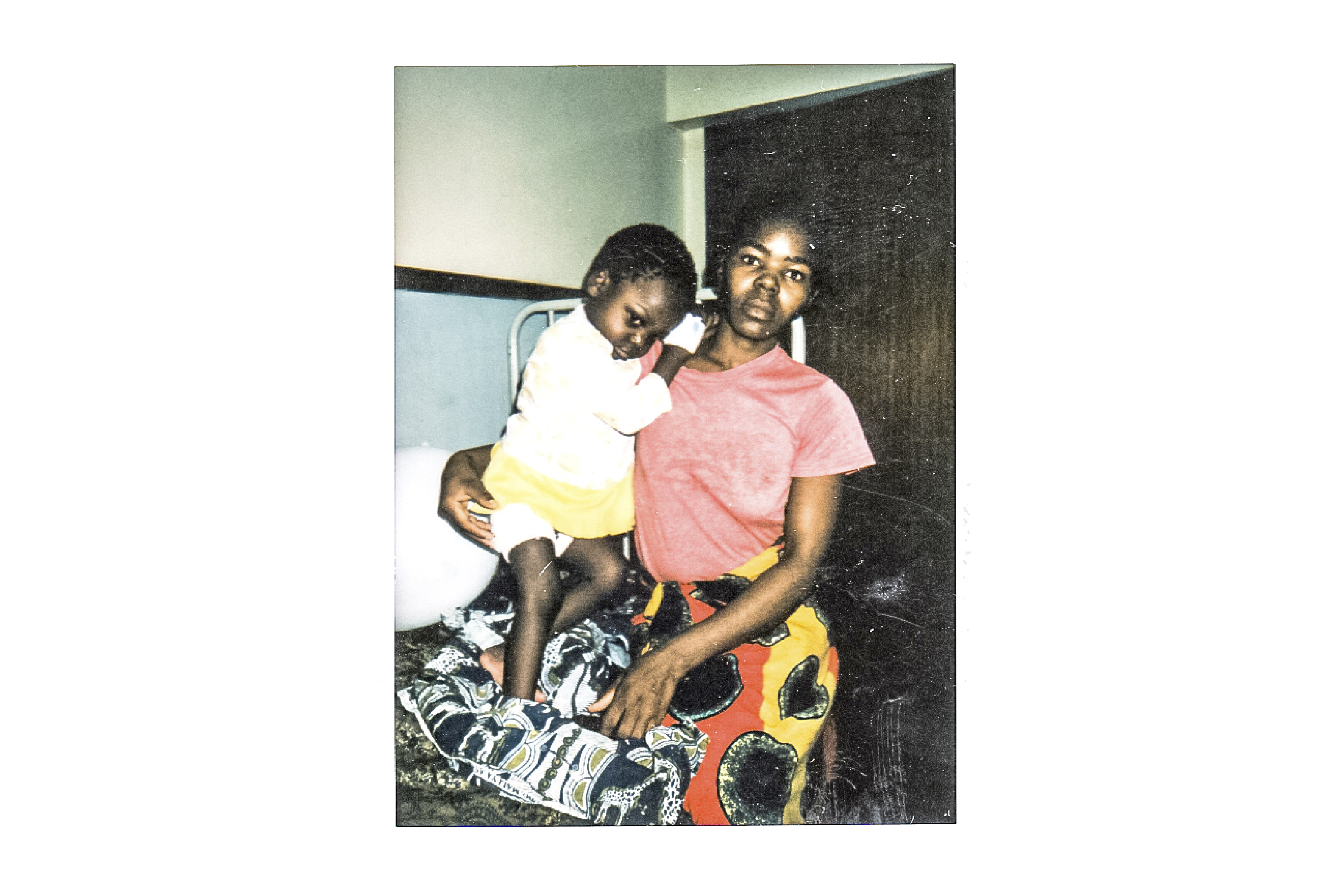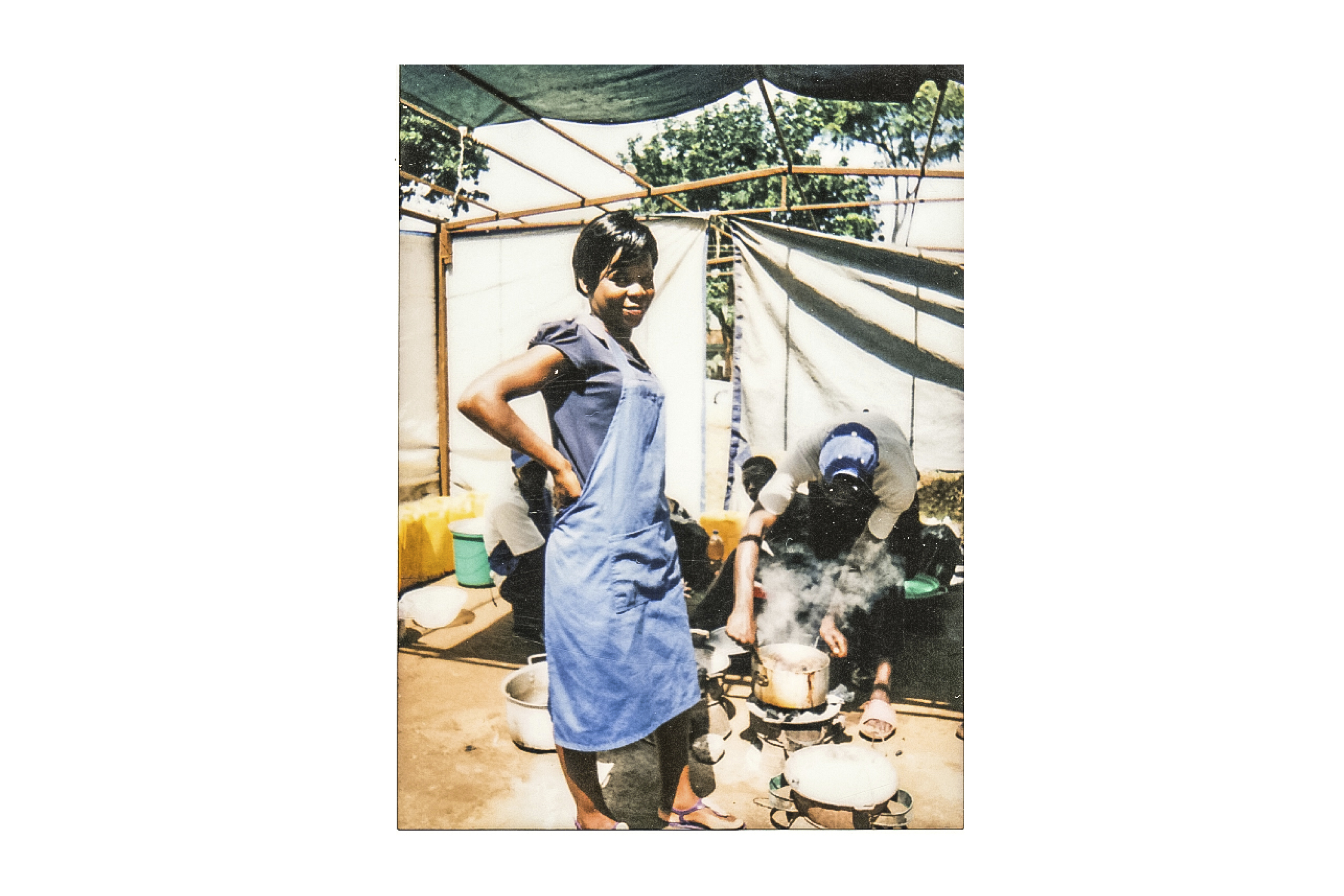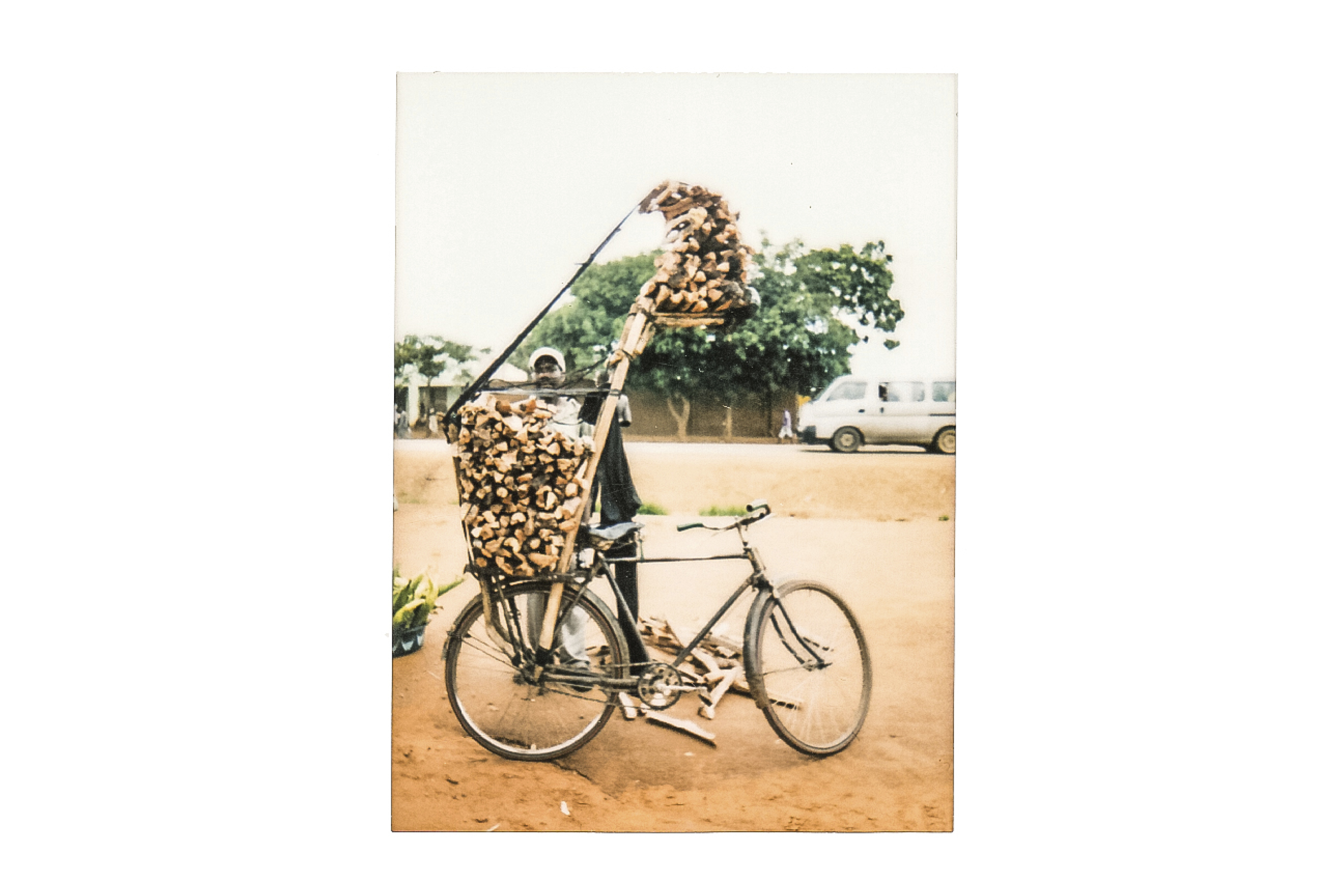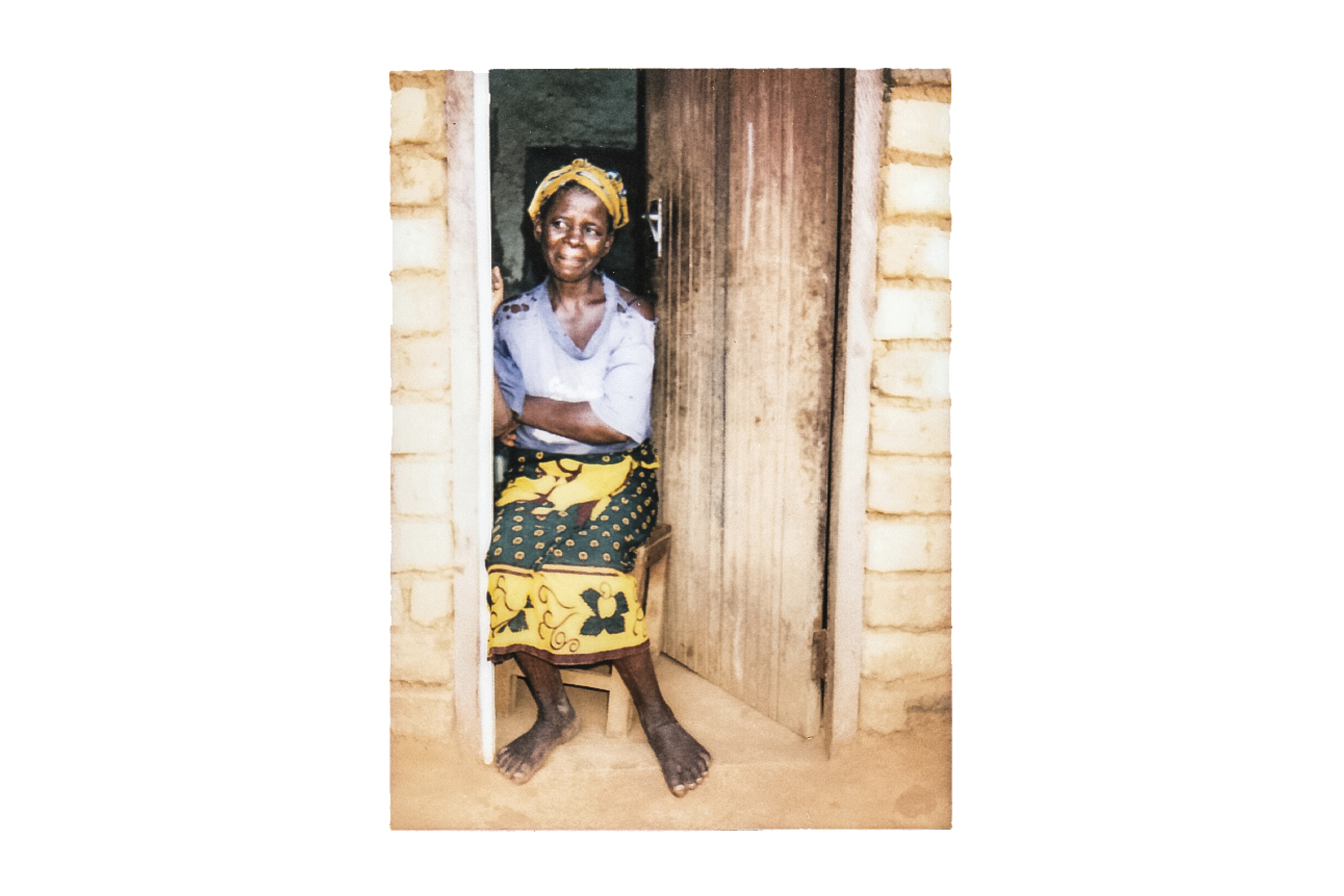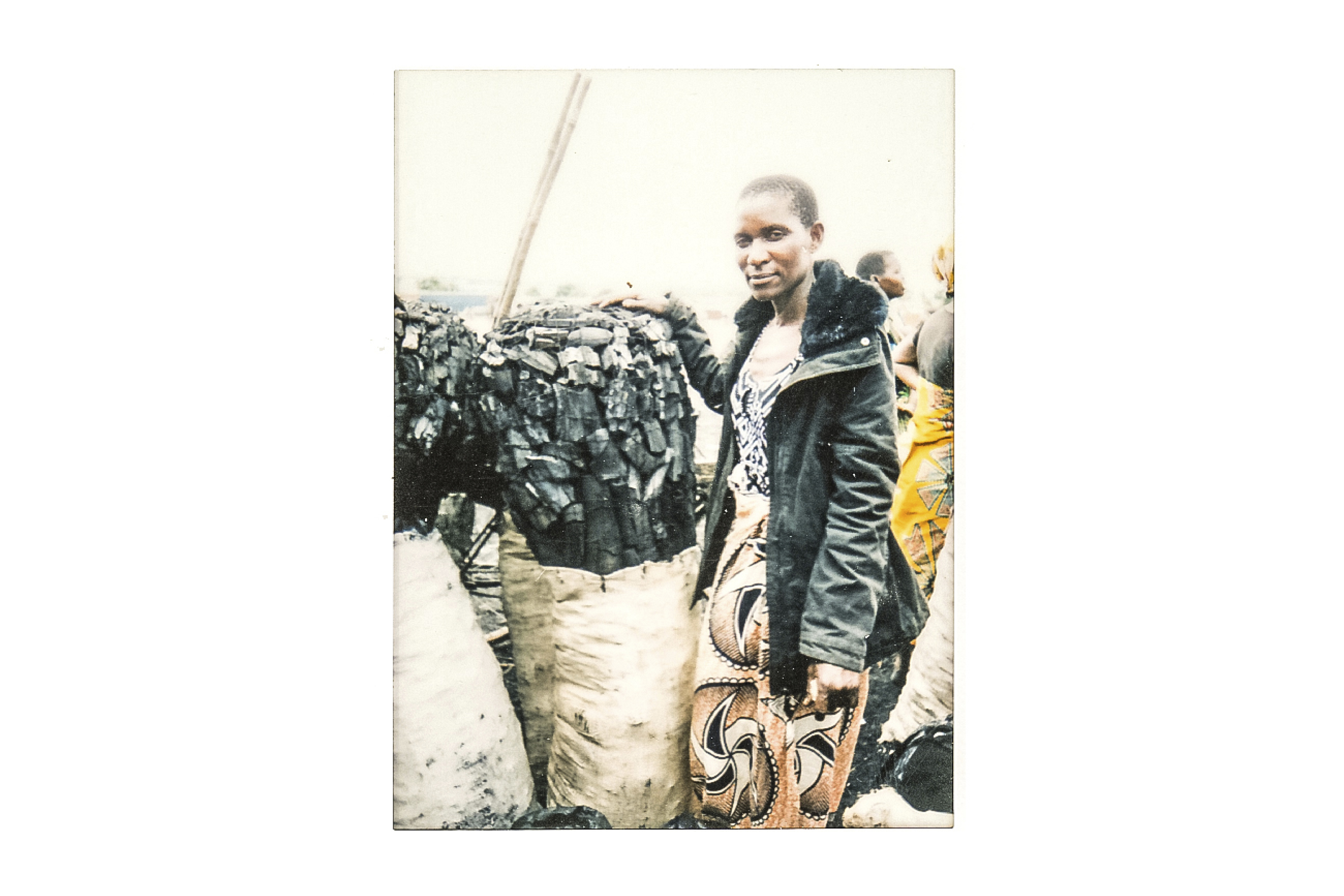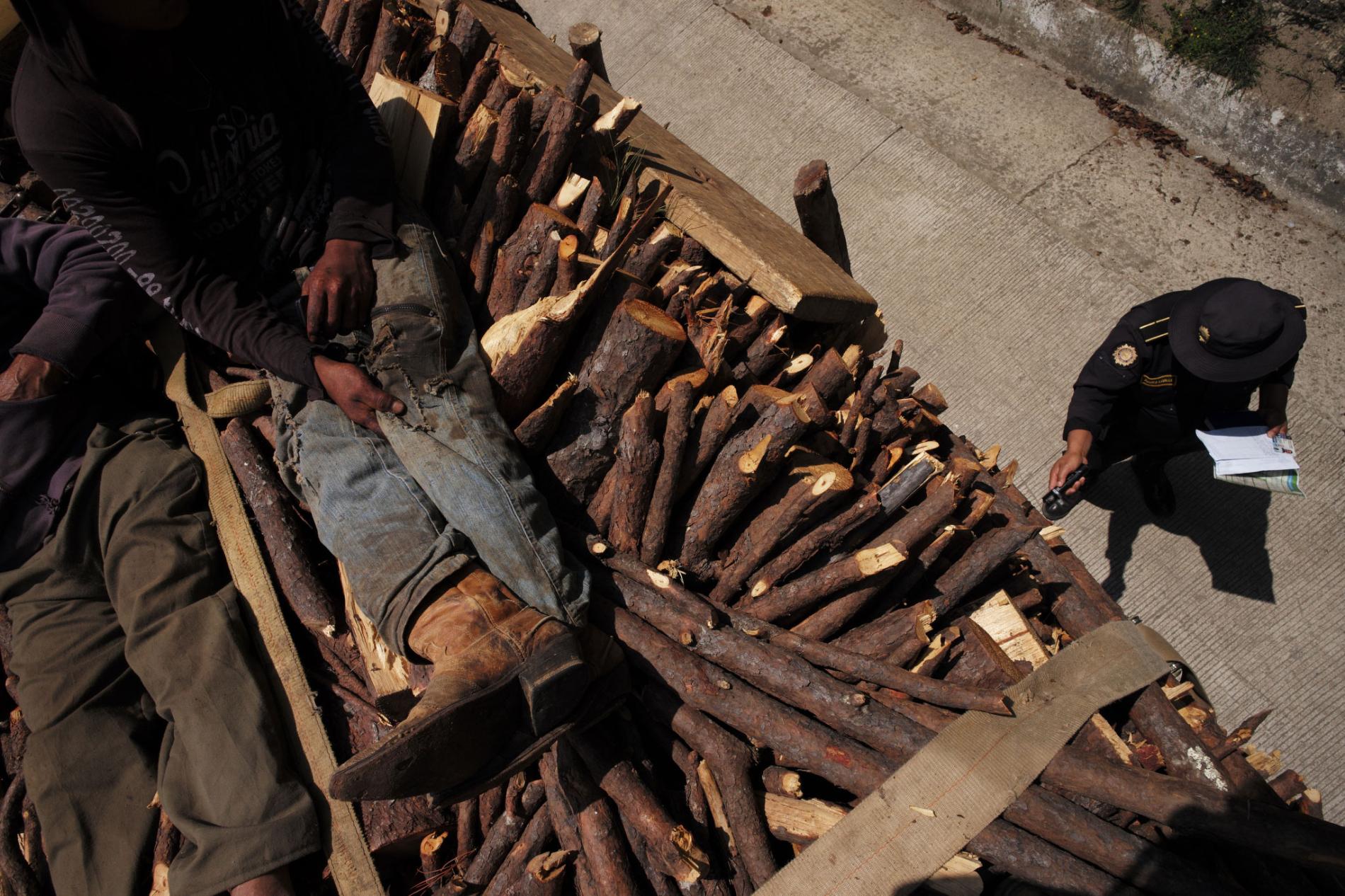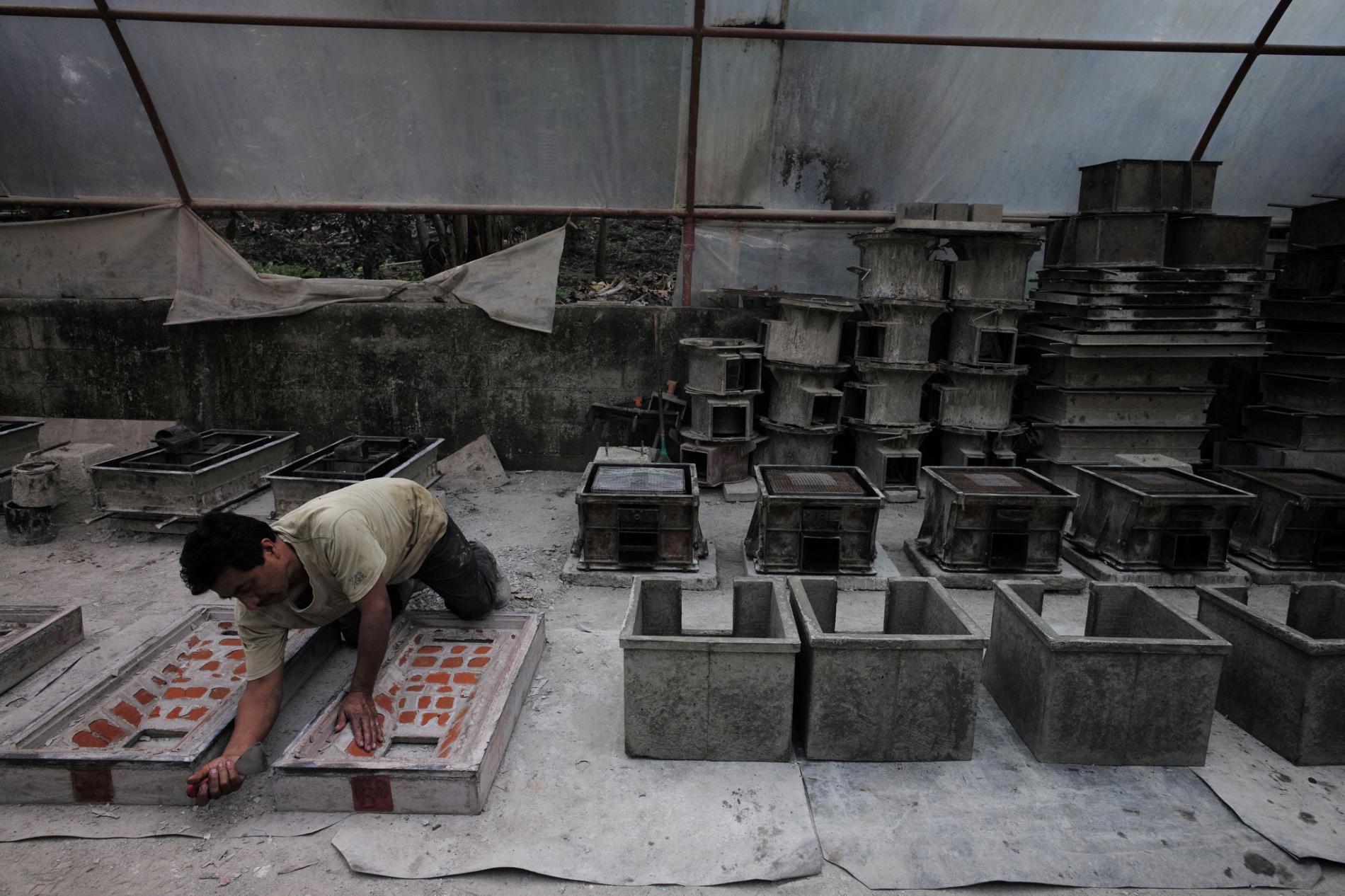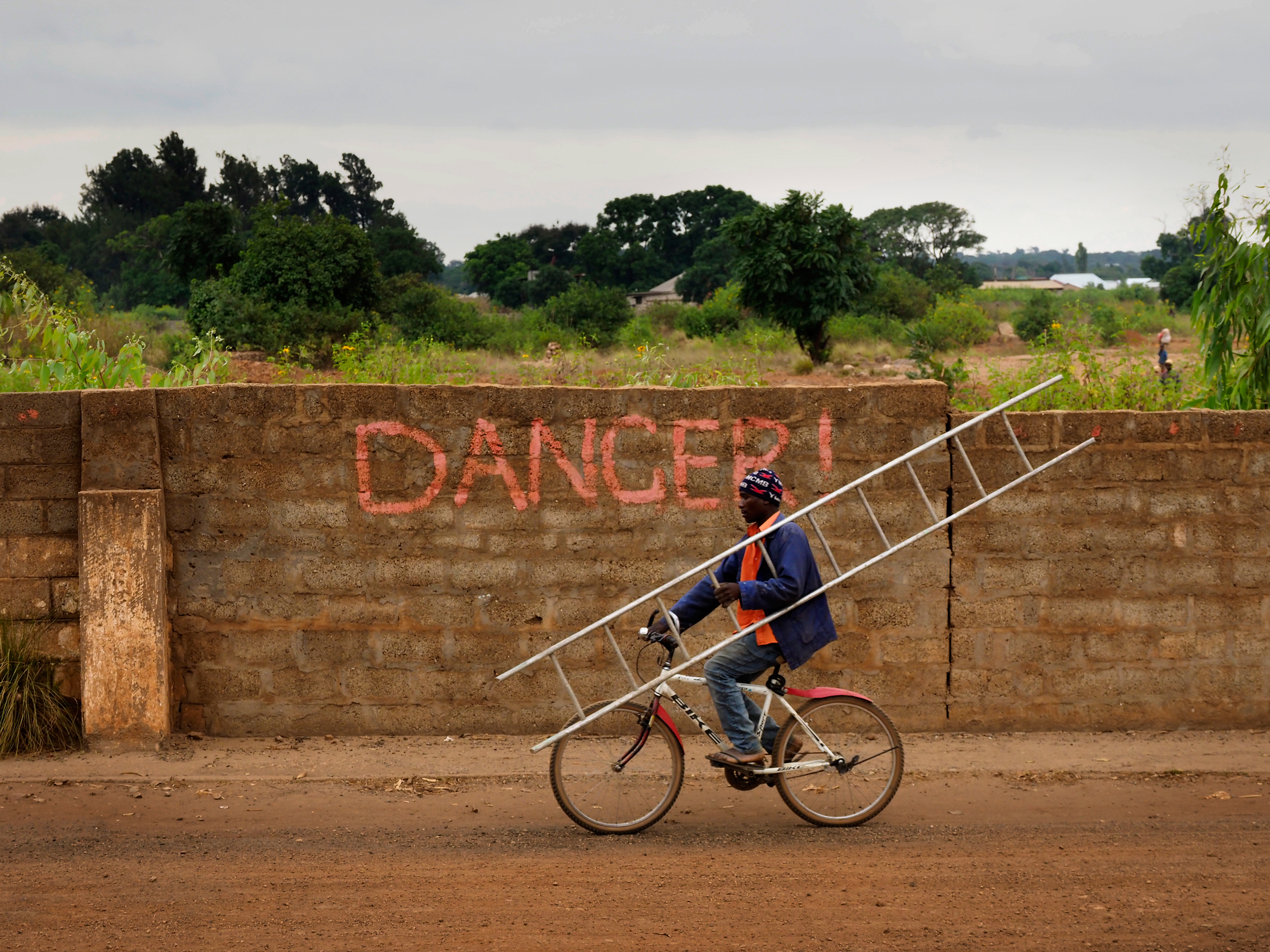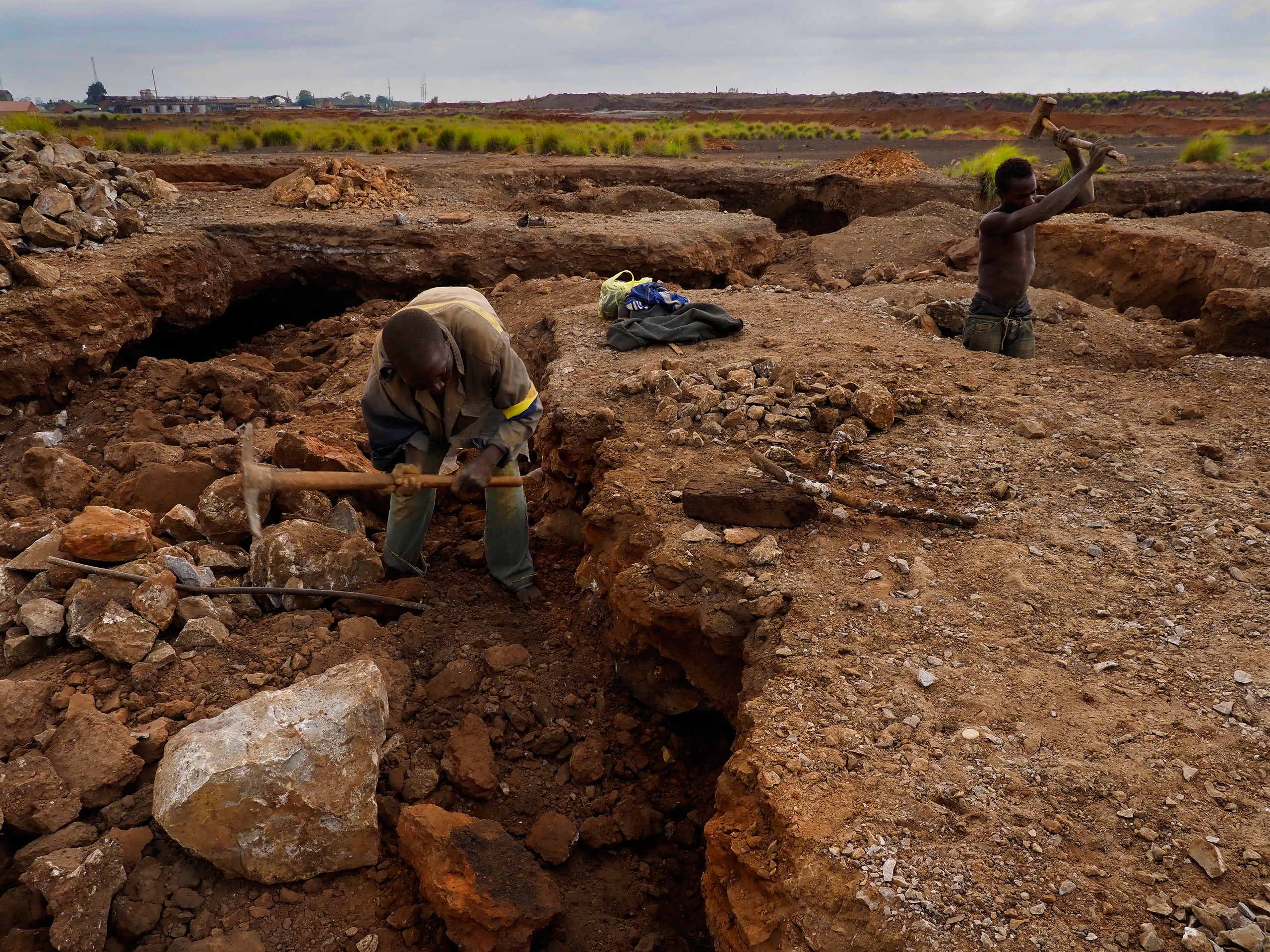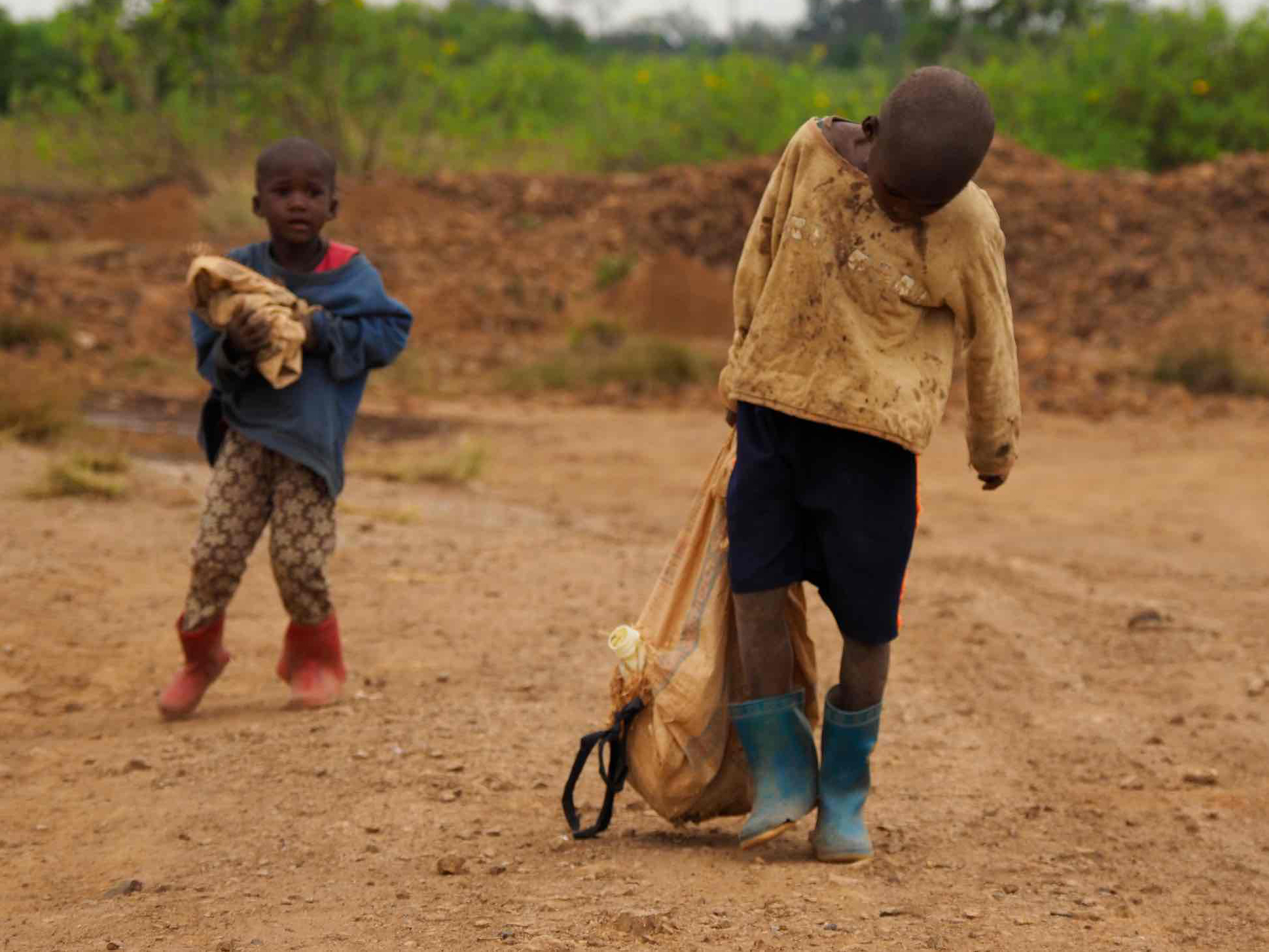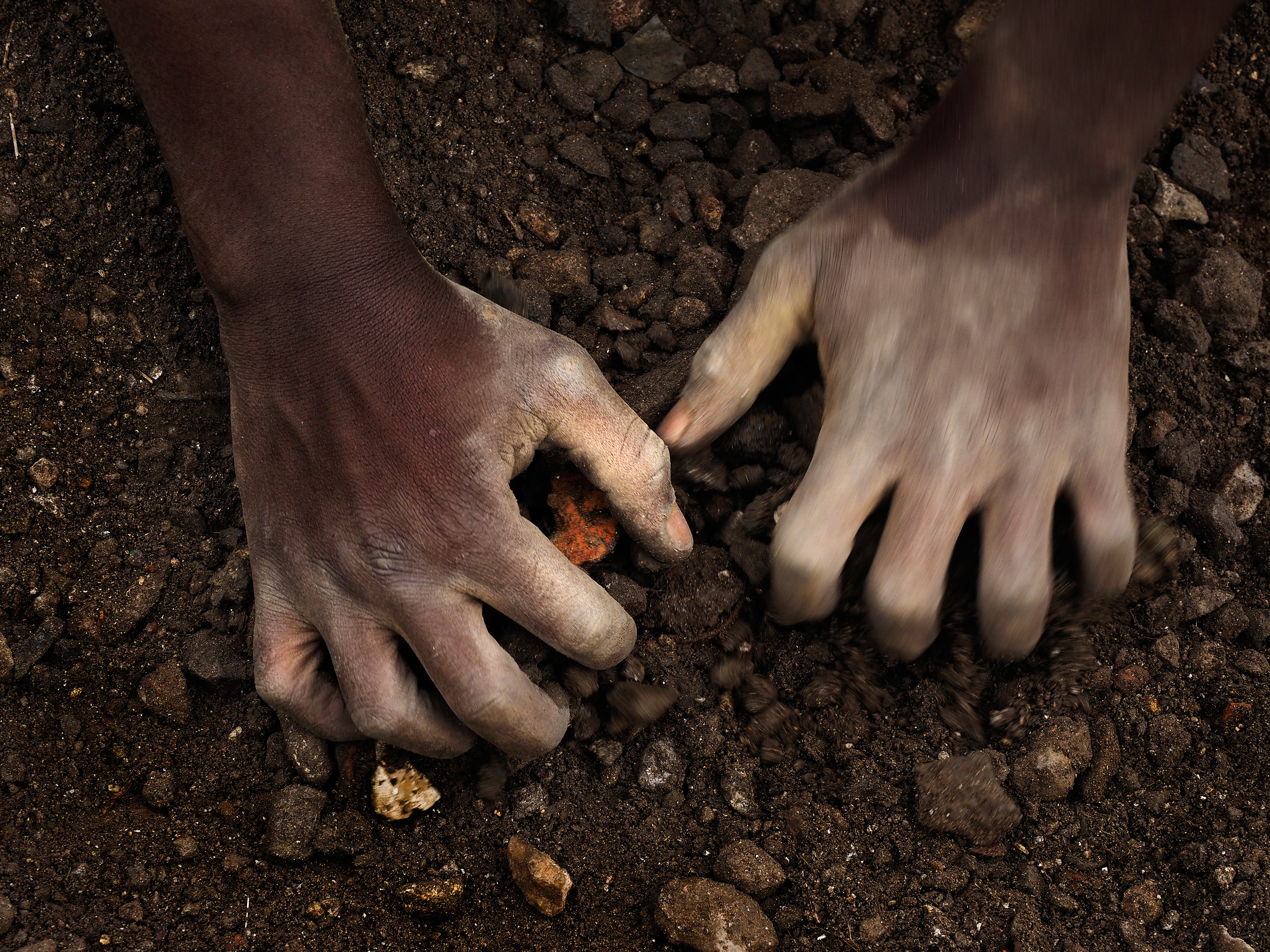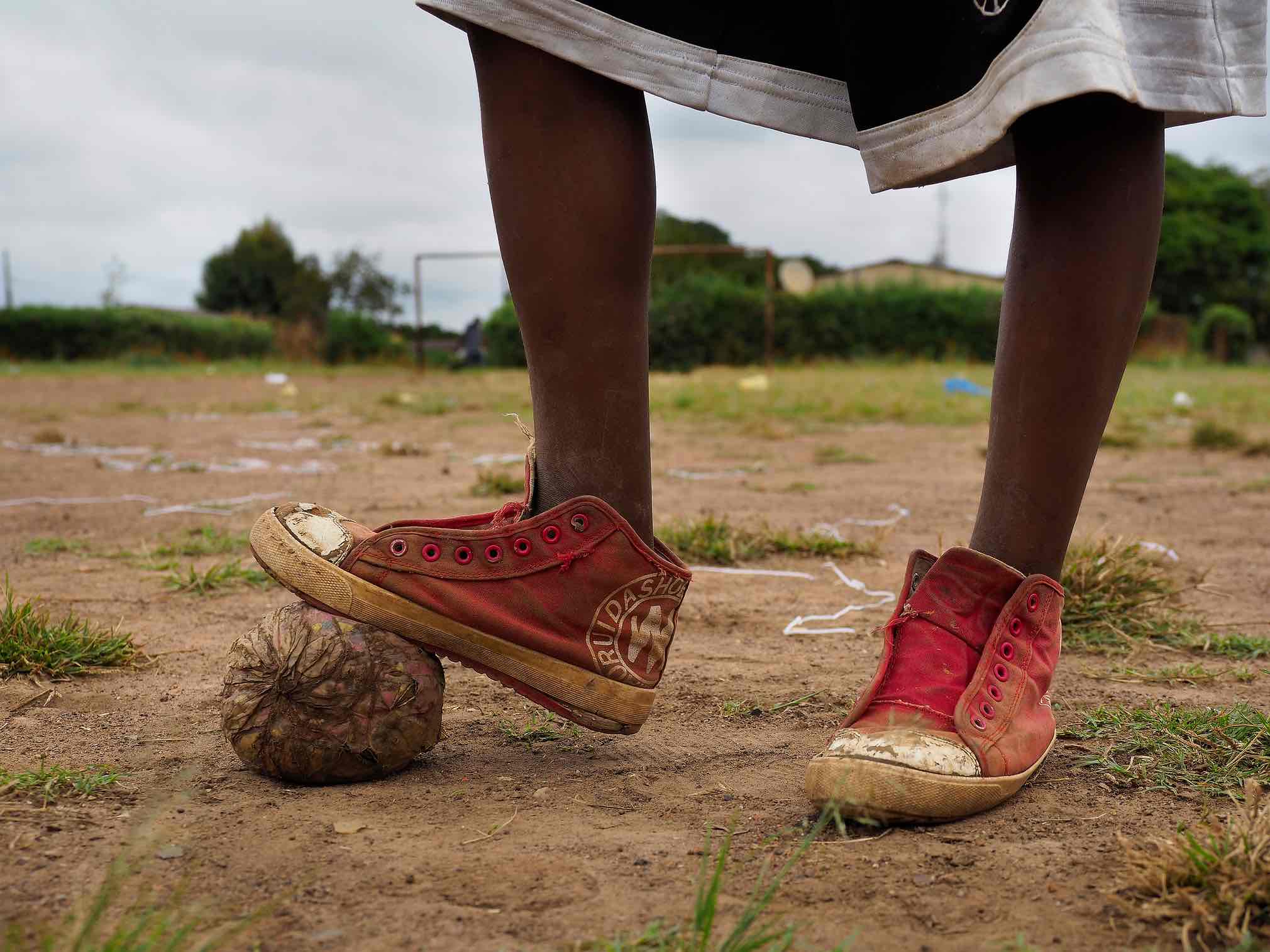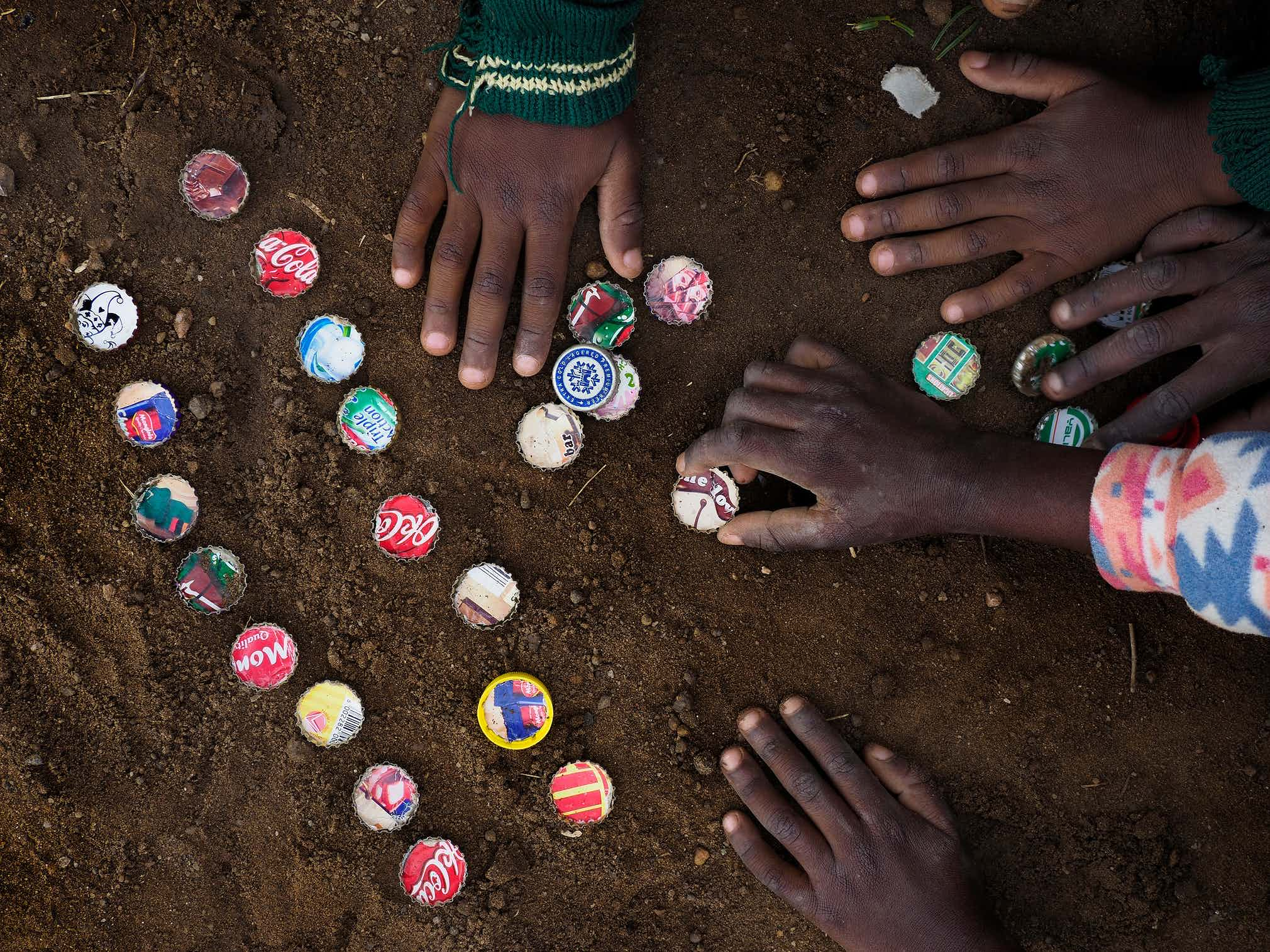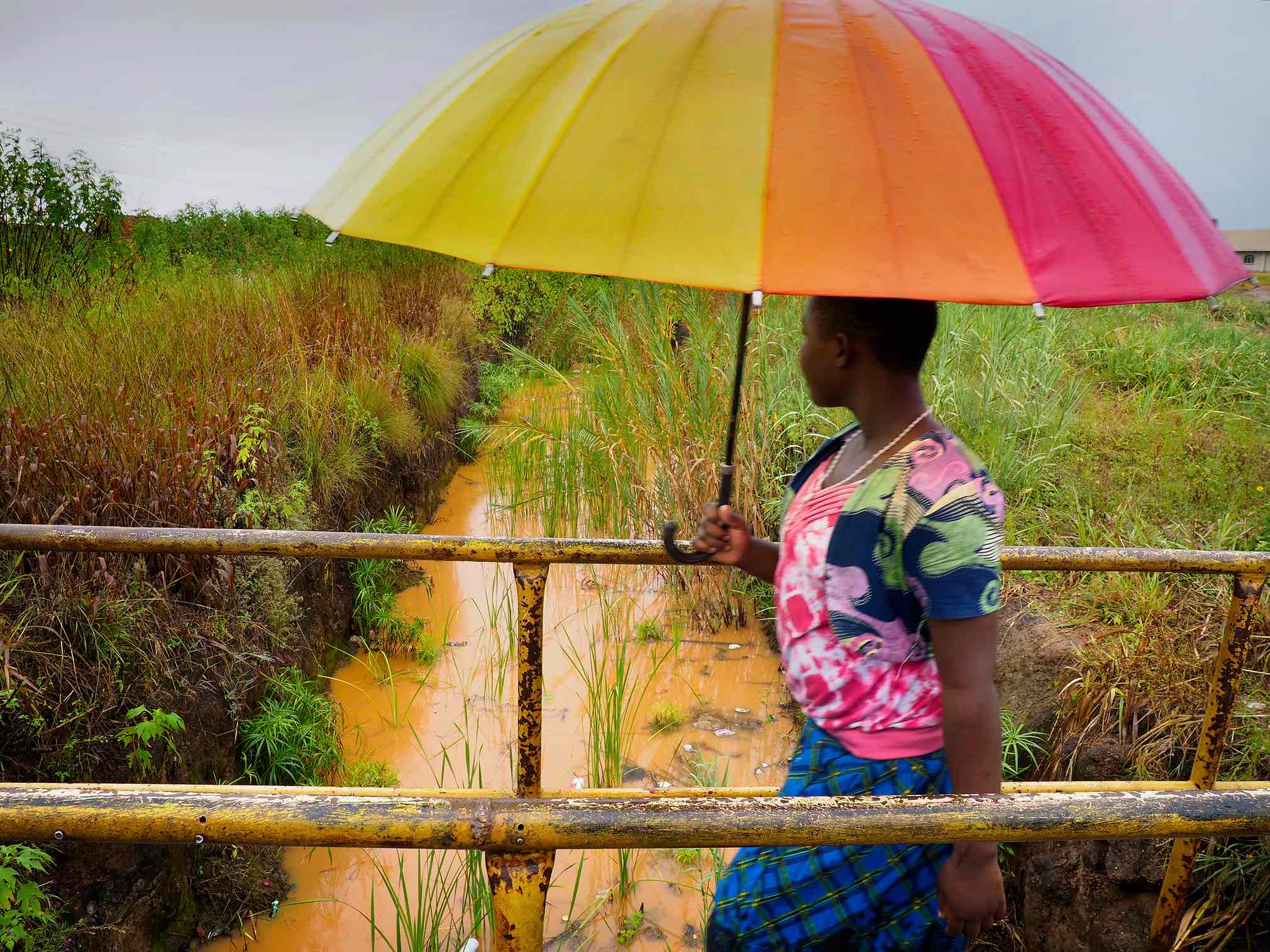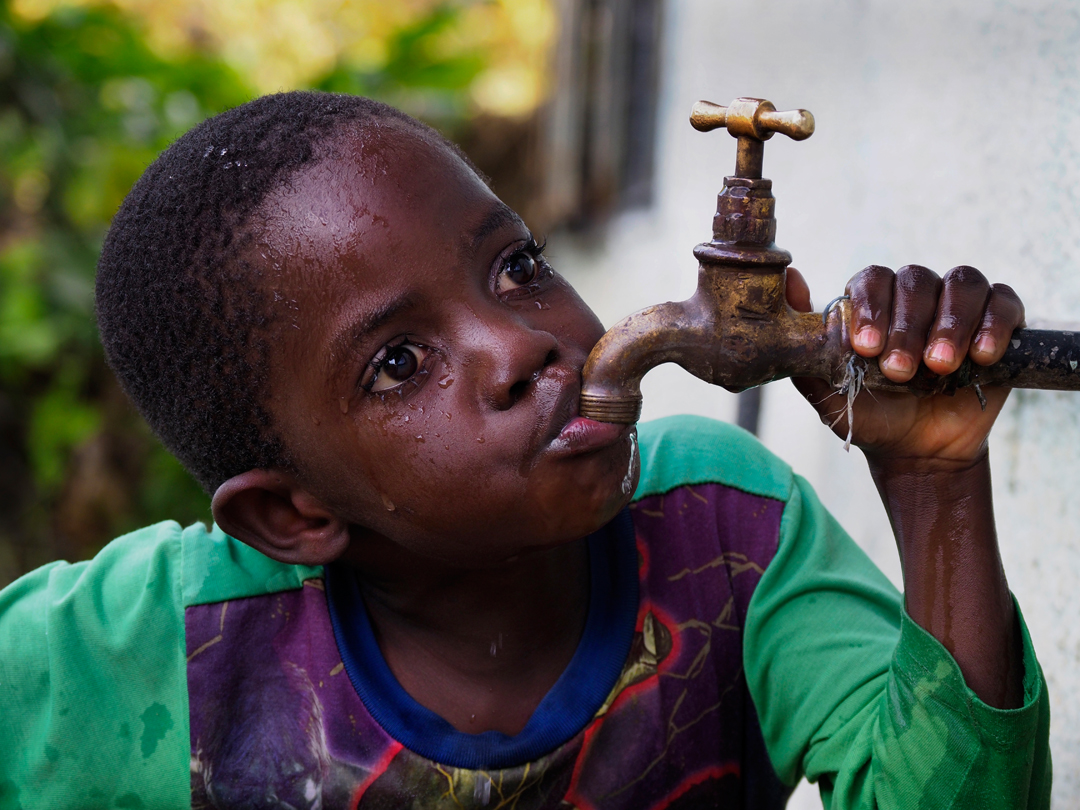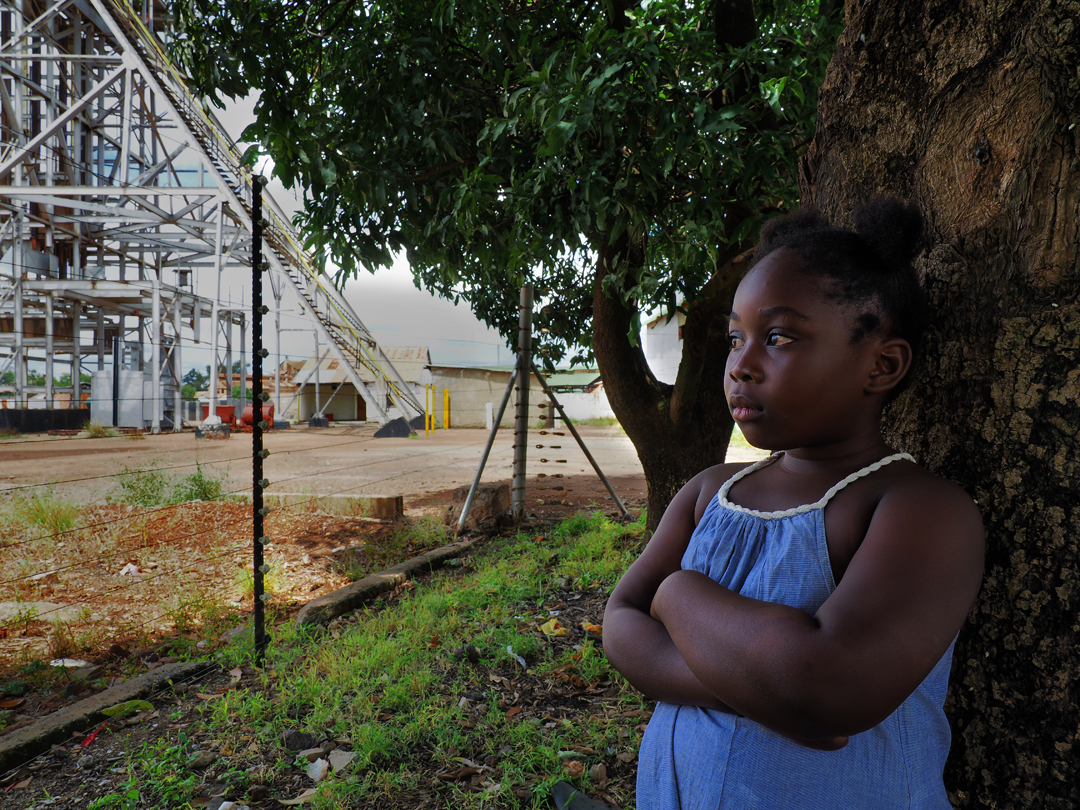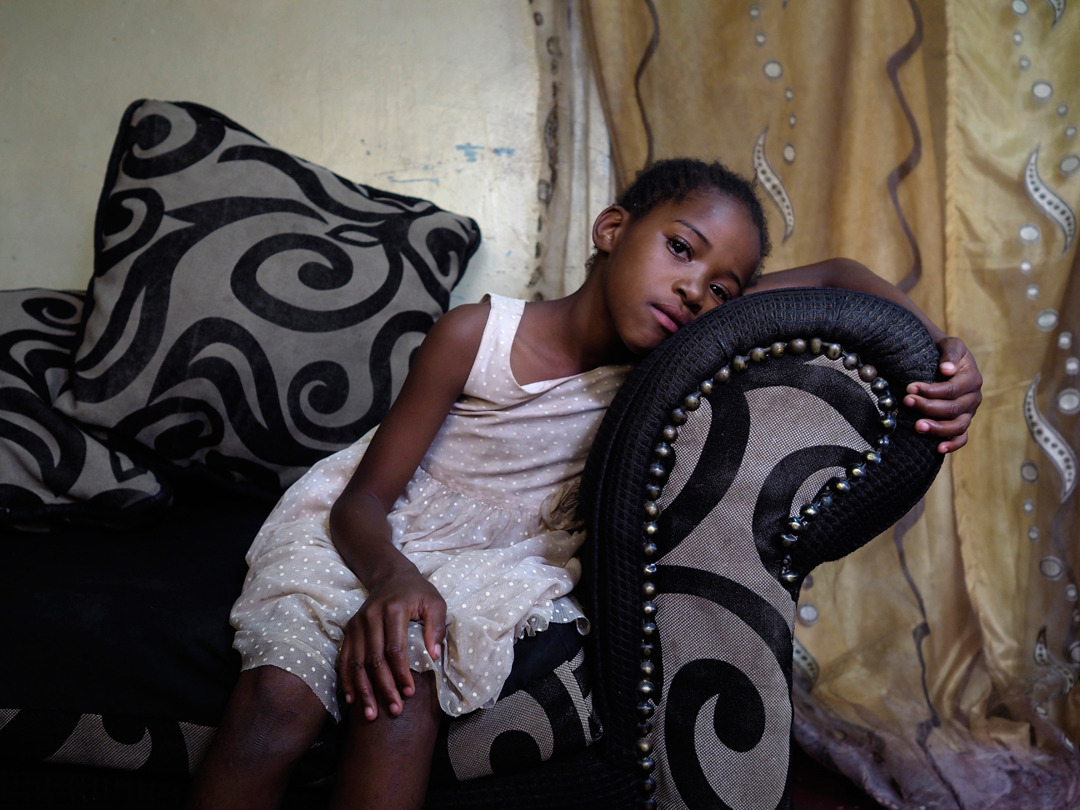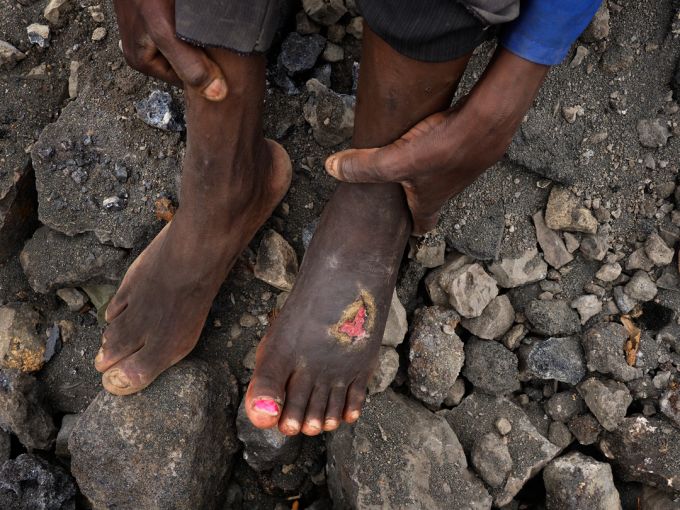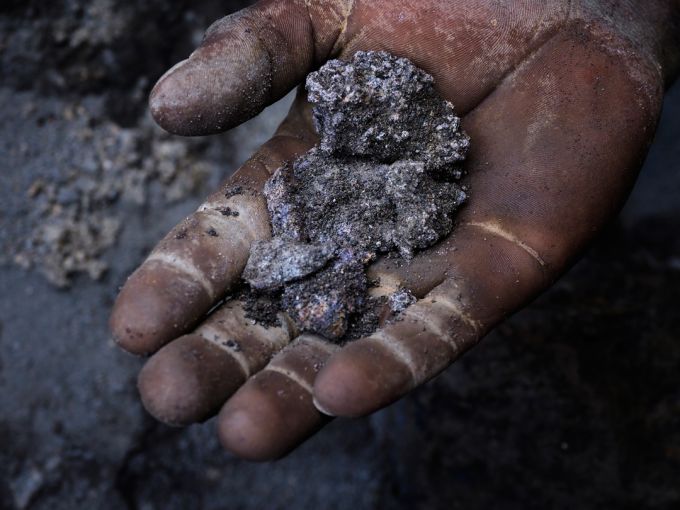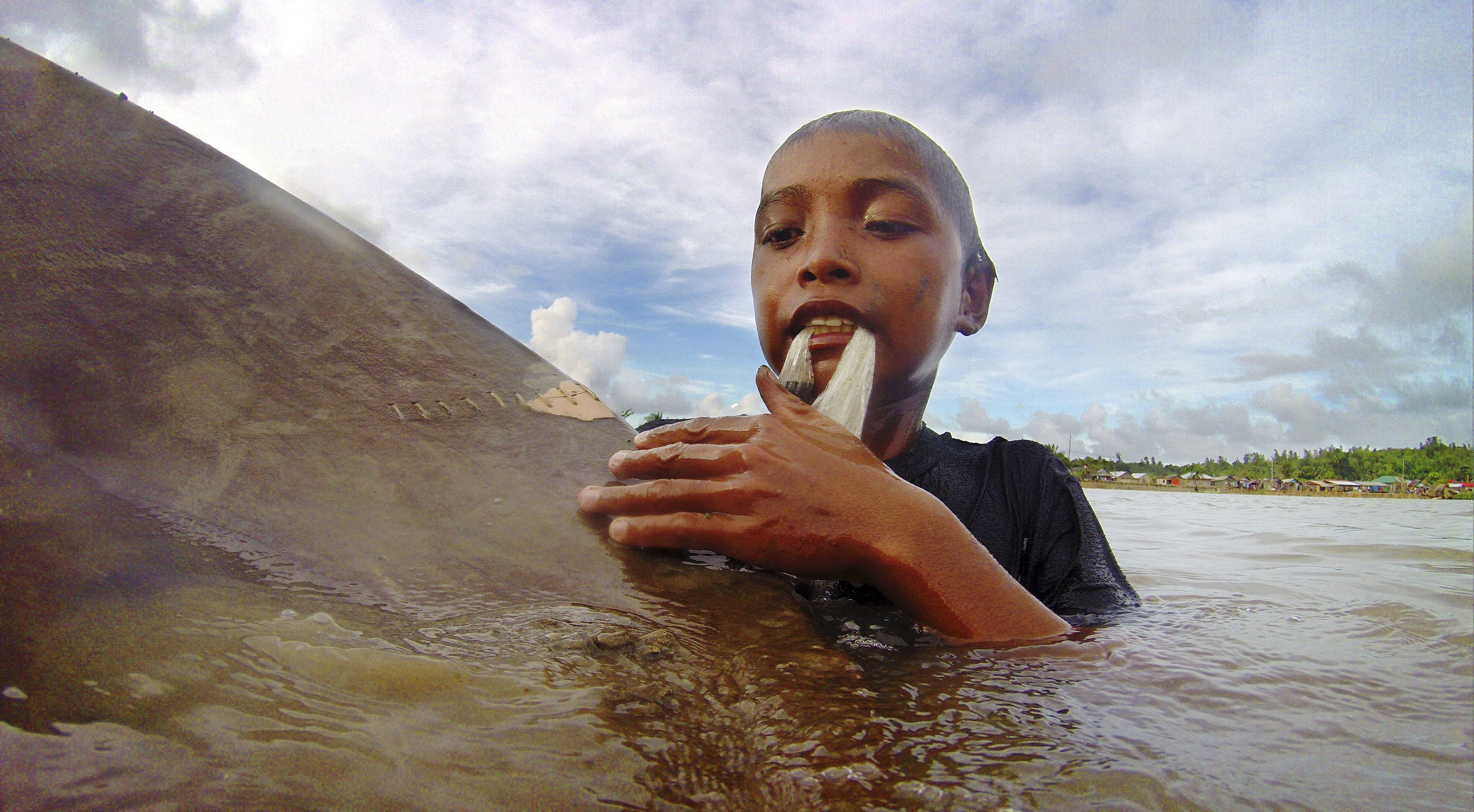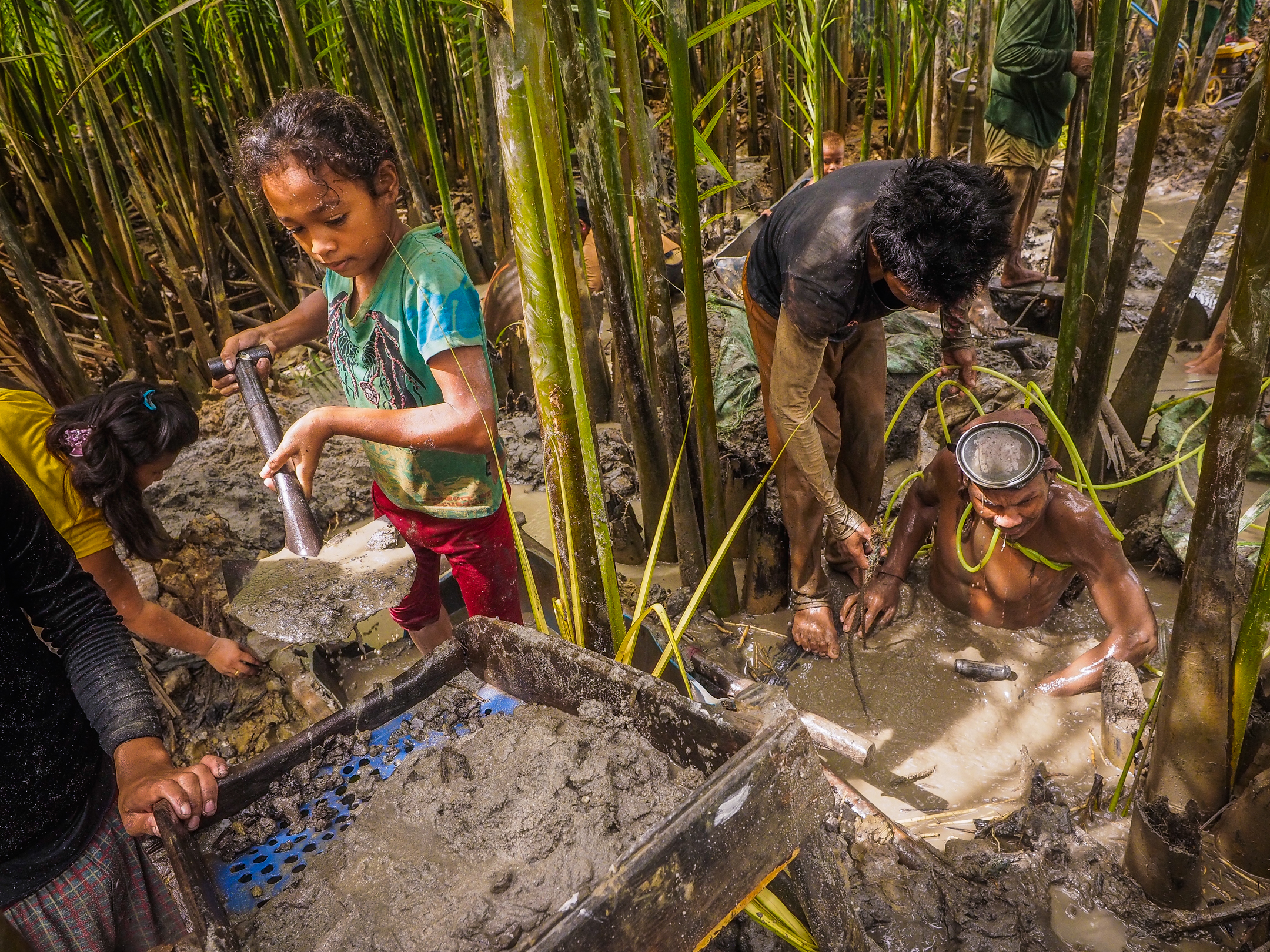Table of Contents
Introduction
Chapter 1 Flowing Toxins in Bangladesh and Indonesia Richard C. Paddock, Debbie M. Price, Larry C. Price
Chapter 2China’s Dirty Pollution SecretHe GuangweiFred de Sam LazaroChapter 3India’s Contaminated Water and Poisoned LandscapeSean GallagherChapter 4Fire and SmokeMakenzie Huber, Nathalie Bertrams, Ingrid Gercama, Michelle Nijhuis, Lynn Johnson
Chapter 5Polish Gold: Coal’s Deadly TollBeth Gardiner
Chapter 6Legacy of LeadCaitlin Cotter, Yolanda Escobar, Richard C. Paddock, Larry C. Price
Chapter 7Pollution in the U.S.Debbie M. Price, Larry C. PriceResourcesContributorsCredits

Introduction
It affects the air we breathe, the water we drink, the soil that helps produce the food we eat. Pollution is everywhere.
Pulitzer Center grantees circumnavigated the globe to study pollution—its risks, the health implications, potential remedies, and means of prevention. Their work has been published in a wide range of outlets: Undark, National Geographic, Yale Environment 360, China Dialogue, PBS NewsHour, Bloomberg Businessweek, TakePart, The Guardian, VersPers, The New York Times, and Hopkins Bloomberg Public Health Magazine.
Toxic Planet brings together their stories, brilliant and heart-wrenching photography, and video to form a more complete picture of the challenges the world faces and of the profound impact of toxic chemicals on all humans, most noticeably on babies and children. Many of the portraits of families are intimate and deeply troubling.
Documentary photographer Larry C. Price, journalist Debbie M. Price, and foreign correspondent Richard C. Paddock report from Southeast Asia on the effects of pollution from tanneries, the textile industry, and small-scale gold mining. Men, women, and children are exposed to the chemicals in untreated sewage and solid waste from factories and to the mercury vapors released in artisanal mines. They suffer the health consequences, and many die young.
In China, He Guangwei, investigative reporter for the Chinese newspaper The Times Weekly, exposes the threat of soil pollution to health, a subject often overlooked by the media. In some industrial areas the soil has become so contaminated that local farmers will not eat the crops they grow. Regional cancer epidemics have occurred giving rise to “cancer villages”—as many as 450 across China, civil society experts say. In a PBS NewsHour video, Fred de Sam Lazaro, director of the Under-Told Stories Project, focuses on air pollution in China—and how an environmental group is working to hold companies accountable for sustainable manufacturing and sourcing.
Photojournalist Sean Gallagher travels to India to create visual stories of the damage caused by pesticides, chemicals used in the textile and leather industries, and the recycling of electronic waste. Here too “cancer villages” are a common phenomenon where toxic chemicals are most prevalent.
Reporting from the Dominican Republic, Malawi, and Guatemala, Makenzie Huber, Nathalie Bertrams, Ingrid Gercama, Michelle Nijhuis, and Lynn Johnson look at cookstoves and show how wood, coal, charcoal, and dung cause severe health effects. An open fire puts children at risk of burns—and every year cooking smoke results in the death of 4.3 million people a year. That’s more than HIV/AIDS, TB, and malaria combined‚ and yet the risk receives far less attention from the public health community.
Environmental journalist Beth Gardiner discusses coal’s “deadly toll” in Poland, a country dependent on coal for 90 percent of its electricity. Its use produces air pollution, soot particles, and carcinogens that force the elderly and children to stay indoors.
Ceramic tile makers in Ecuador, rock crushers in Zambia, and battery recyclers in Indonesia pay a heavy price. As Caitlin Cotter, Yolanda Escobar, Larry C. Price, and Richard C. Paddock report, their work puts them and their families at risk, exposing them to lead that can have a devastating effect on the body, including the nervous system and brain development.
Debbie M. Price and Larry C. Price take us to the United States as they examine the resurgence of Gloversville, New York, the former leather capital of the world. New forms of processing are in place resulting in far less toxicity. The same is true for the textile industry in North Carolina. A greater demand for “Made in America,” rising wages in China, and higher shipping charges have led to an increase in textile production at home—with the added dividend of an industry that is today more environmentally and socially conscious.
Toxic Planet highlights the health risks and challenges we face as well as possible solutions—providing hope for change in government policies, better working conditions, waste treatment programs, and river clean-up projects. Innovations that are making a difference include solar ovens, improved cookstoves that are more efficient and also less toxic, the development of genetically modified crops that produce chemicals to kill pests, and more effective effluent treatment plants. New environmental awareness campaigns may well lead to behavior change.
The Pulitzer Center grantees, whose work is featured here, give voice to scientists, engineers, economists, politicians, factory workers, miners, and activists. They ask what role can we, as consumers, play. What is the footprint we leave behind? How do we clean up the damage we’ve caused?
Toxic Planet is a call to action—and a reminder that if we are to act it must be now.
Kem Knapp Sawyer

Map of the World
Countries highlighted in this map are included in the e-book.


Chapter 1: Flowing Toxins in Southeast Asia
Photographer and two-time Pulitzer Prize winner Larry C. Price and journalist Debbie M. Price introduce us to Hazaribagh, home to Bangladesh’s tannery industry: “The stench of the place smacked us in the face: rotting animal flesh, garbage, raw sewage, auto exhaust and acrid chemicals mingled together in a nauseating stew.” The city’s tanneries pump almost 5.8 million gallons of untreated effluent a day into open canals and generate more than 100 tons of solid waste in the form of raw hide scraps, flesh, and fat.
This chapter examines the pollution produced by tanneries in both Bangladesh and India and by the textile industry in Indonesia. Clothing factories in West Java have helped make the Citarum, which provides drinking water for more than 25 million people, one of the world’s most contaminated rivers. Some parts of the river are now “thick and dark as motor oil.” Also in Indonesia, foreign correspondent Richard C. Paddock and Larry C. Price document small-scale gold mining—an industry that produces $5 billion in gold a year, while releasing hundreds of tons of mercury into the water, soil, and air. Mercury poisoning, although difficult to diagnose, can cause severe birth defects and developmental delays in children.
Their reporting illuminates the complex problem of reforming these industries and restoring waterways that have been polluted for decades. Is change imminent?
Recent court decisions in Bangladesh, India, and Indonesia—together with pressure from American and European companies—have given activists hope for better working conditions, waste treatment programs, and river cleanup projects.
-R.K

Skin Deep: Feeding the Global Lust for Leather in Bangladesh
Debbie M. Price. Images by Larry C. Price.February 2017
As 2016 marched to a close, rumors and panic raced through the leather tanneries in the Hazaribagh neighborhood of Dhaka. After years of extensions and delays, the government would finally require the remaining 150 or so tanneries in this historically unregulated and polluted corner of Bangladesh’s capital city to shutter. Any tanners who wanted to remain in business would have to relocate to a planned industrial park in Savar, a community roughly 14 miles away.Authorities vowed to cut off utilities, blockade roads to prevent shipments of raw hides from entering Hazaribagh, go door-to-door to roust disobedient tanners, and revoke the licenses of all who defied their orders.
Days before the deadline, Mohammad Shohorab Hossain Jhony, a director of FFM Leather Complex, scrolled through his smartphone to show a friend photographs of his new facility under construction at the Tannery Estate Dhaka at Savar—a concrete slab, two walls, no roof, just 40 percent completed. Weighing the loss of his license against six months of lost production while the Savar building was finished, Jhony said he would be forced to close, at least temporarily, putting 70 to 100 men out of work. If they chose not to follow him to the industrial park, a six-hour round-trip commute in bumper-to-bumper Dhaka traffic, some might never return to FFM.
On December 30, 2016, the blockades went up, and then on January 1 the government stood down, extending the deadline again by telling the tanners they would have to stop processing wet animal hides on January 31, without exception. They would have until March 31 to move their entire operations. “This is the final decision,” Mosharraf Hossain Bhuiyan, the Bangladesh industries secretary, told the local press.
So it has gone for years, as the Bangladesh government attempts, in fits and starts, to make good on promises to clean up its leather processing industry and propel what is, in effect, a 19th-century operation into the 21st century.
About 90 percent of Bangladesh’s leather is tanned in Hazaribagh. And the country’s economy depends heavily upon leather and the manufacture of leather goods—which explains in no small measure the government’s reluctance to crack down on polluters. In 2015 and 2016, Bangladesh produced about $1.5 billion in leather and leather goods, most of it exported, according to the Bangladesh Board of Investment.
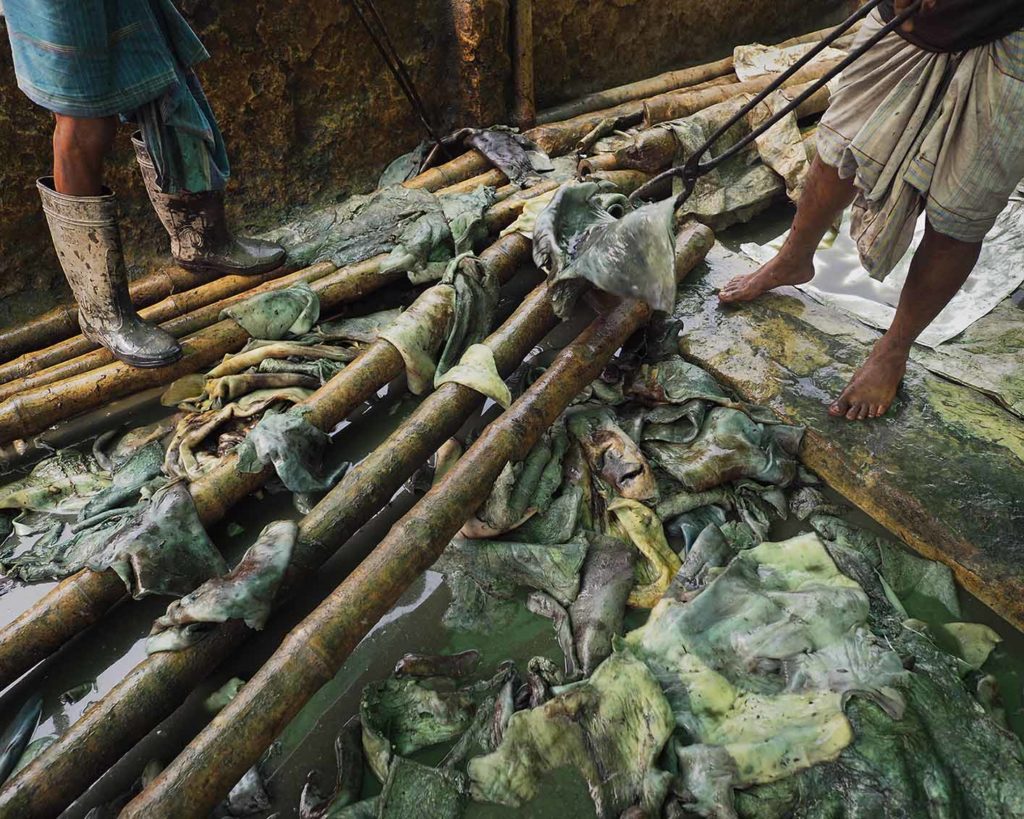
Leather and leather goods represent the country’s second largest export, after garments. Turmoil in Hazaribagh threatens to upend the country’s efforts to increase its tiny share of the more than $200 billion global leather market.
Should that come to pass, it would be just one more step in a long journey for the tanning industry, which has spent decades hopscotching across the globe, assiduously fleeing regulation and rising labor costs and leaving long-lasting toxic footprints at each stop.
So far, fewer than 40 of Hazaribagh’s tanneries have moved to Savar, and an abrupt shutdown of the remaining tanneries could put thousands of people instantly out of work. That would almost certainly provoke civil unrest and deal a major blow to the country’s leather industry—just when the government is trying to grow exports and fend off competition from China and Vietnam. On the flip side, as The Dhaka Tribune reported in September 2016 negative publicity about conditions in Hazaribagh is scaring away international buyers and driving down finished leather exports, which fell by 30 percent last year, according to government figures.
In fact, the international shaming of Bangladesh’s leather industry could succeed where government decrees have failed. It has been seven years since the Bangladesh High Court ordered the government to move or close Hazaribagh’s tanneries. Almost 14 years have passed since the Bangladeshi government announced plans to develop an industrial park with a shared effluent treatment plant for tanneries. Yet
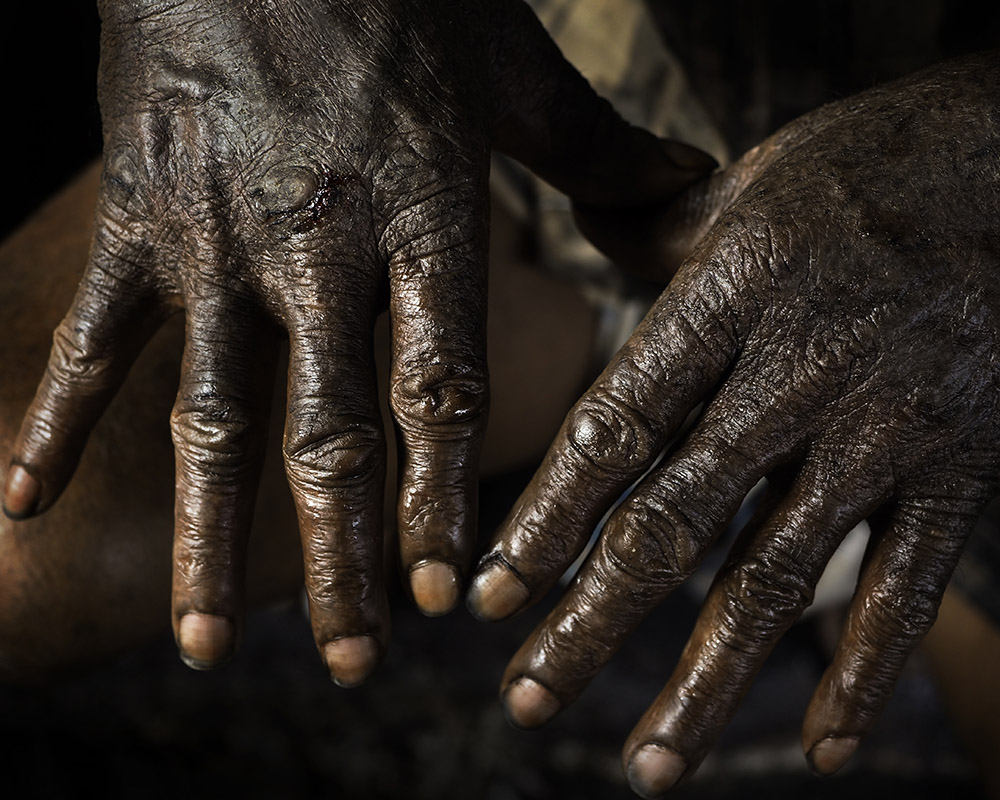
Hazaribagh remains arguably one of the most intensely polluted places on the planet.
By official estimates, the tanneries of Hazaribagh pump almost 5.8 million gallons of untreated effluent a day into open canals that pour into the Buriganga River and generate more than 100 tons of solid waste in the form of raw hide scraps, flesh, and fat. The tannery effluent, laced with chromium (III) sulfate, sulfuric acid, salts, lime, surfactants, degreasers, ammonium sulfate, and many other chemicals, contaminates the water and river bed and kills aquatic life. Numerous studies have found highly elevated levels of chromium and other chemicals in the soil and water of Hazaribagh. For years, government officials, citing the planned move to Savar, have openly admitted that they do not enforce environmental regulations in the district.
The Buriganga itself, once the main source of drinking water for Dhaka, has become so polluted by tannery and other industrial and human wastes that it is widely regarded as unsafe for human use—even as the greater metropolitan area of more than 17 million people struggles with episodic droughts and depleted groundwater supplies. Leather scraps accumulate in rotting heaps six feet high along the canals.
Chickens—a staple of the Bangladeshi diet—are often fed tannery scraps, and Dhaka University chemistry professor Mohammad Abul Hossain, Ph.D., and his colleagues have found high levels of chromium in the bones, brain, and muscle of the birds. Residents who ate 250 grams of chicken a day, about a quarter of a bird, would consume up to four times the recommended amount of dietary chromium, according to Hossain’s research. Chicken-feed producers officially ceased using tannery scraps after his report came out, but unregistered factories abound and locals still boil the waste and feed it to their household poultry, he says.
While chromium (III), also known as trivalent chromium, is far less dangerous than the carcinogenic compound chromium (VI), or hexavalent chromium, long-term and direct exposure to chromium (III) is known to cause serious skin and respiratory irritation. Hossain and others have also found that when leather scraps are exposed to high heat under certain conditions, some of the trivalent chromium converts to hexavalent chromium, posing more serious risks.
Chrome tanning is the leading method used worldwide, and most argue that chromium (III) sulfate can be used safely as long as workers are properly protected and the factory effluent is captured and treated. But many of the more than 30 chemicals used in tanning animal hides also have their own dangers. Some of the workers photographed had blackened and peeling skin on their hands and feet from long exposure to tanning chemicals. Others coughed almost constantly.
In Hazaribagh, worker protections are scarce and child labor is common, as the nonprofit group Human Rights Watch documented in an extensive 2012 report.
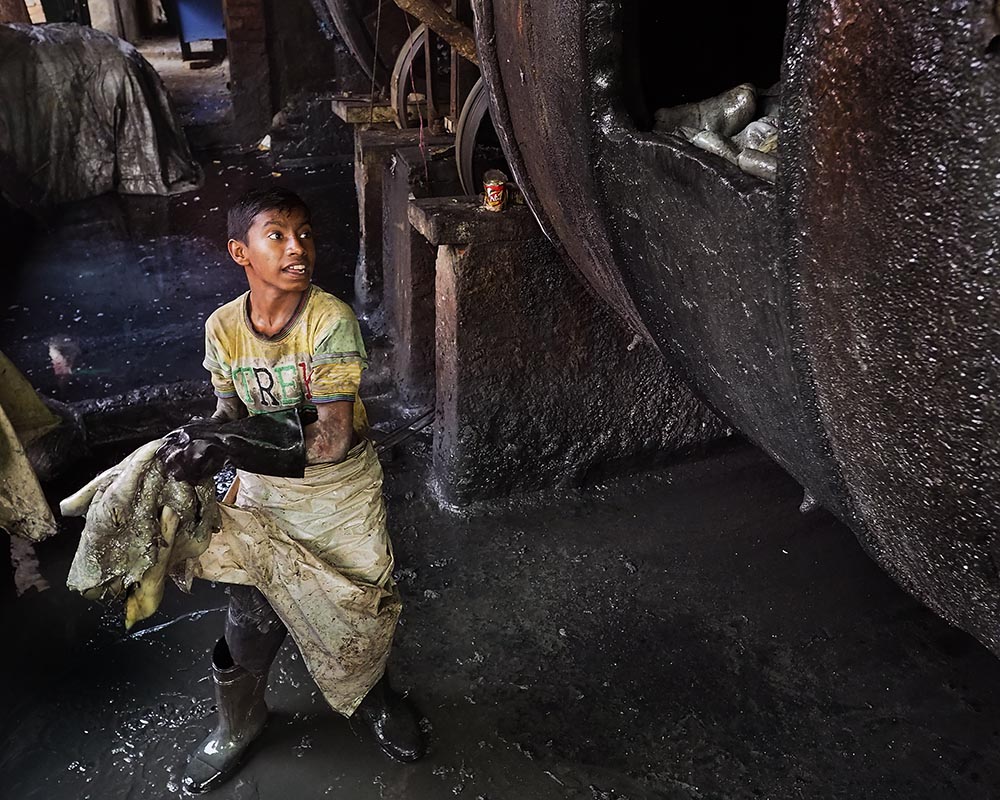
“Tanning is an industry that is extremely hazardous, which means two broad things in terms of labor,” says Richard Pearshouse, the author of the Human Rights Watch report and a frequent visitor to Hazaribagh. “You need to take reasonable steps to protect your workers—protective equipment, masks, gloves, aprons, to protect against chemical burns—and you do not employ children.”
A few of the workers photographed for this essay did wear boots and gloves. Most, though, worked with their bare hands, stood barefoot in chemicals on the tannery floor, waded into tanks filled with tanning solutions, and climbed into drums to retrieve the wet blue leather, literally bathing themselves in a soup of caustic and potentially toxic chemicals. Young boys carried water and hides and operated stretching machines, while smaller children tended pieces of leather soaking in open vats.
“If they don’t address the problems of worker safety and working conditions and child labor, they are just moving the problem from Hazaribagh to Savar,” says Pearshouse.The turmoil today in Hazaribagh is reminiscent of the situation in Kolkata, India, in the 1990s and of the collapse of the century-old tannery industry in Gloversville, New York, in the 1980s. In Gloversville, competition from cheaper labor coupled with tougher local and federal environmental laws forced one tannery after another out of business. The town and surrounding county have spent the decades since rebuilding the economy and cleaning up pollution the factories left behind.
In Kolkata, the Supreme Court of India ordered all tanners out of the city almost two decades ago. In response, the government built the Kolkata Leather Complex with a common effluent treatment plant. About 300 tanneries located in the complex today produce about 25 percent of India’s leather. Environmental controls are better at the industrial park than at the old Kolkata tanneries. Labor oversight, authorities say, also has improved, although horrific accidents still happen. In December 2015, three workers died from inhaling toxic fumes while cleaning out a holding tank without protective gear.
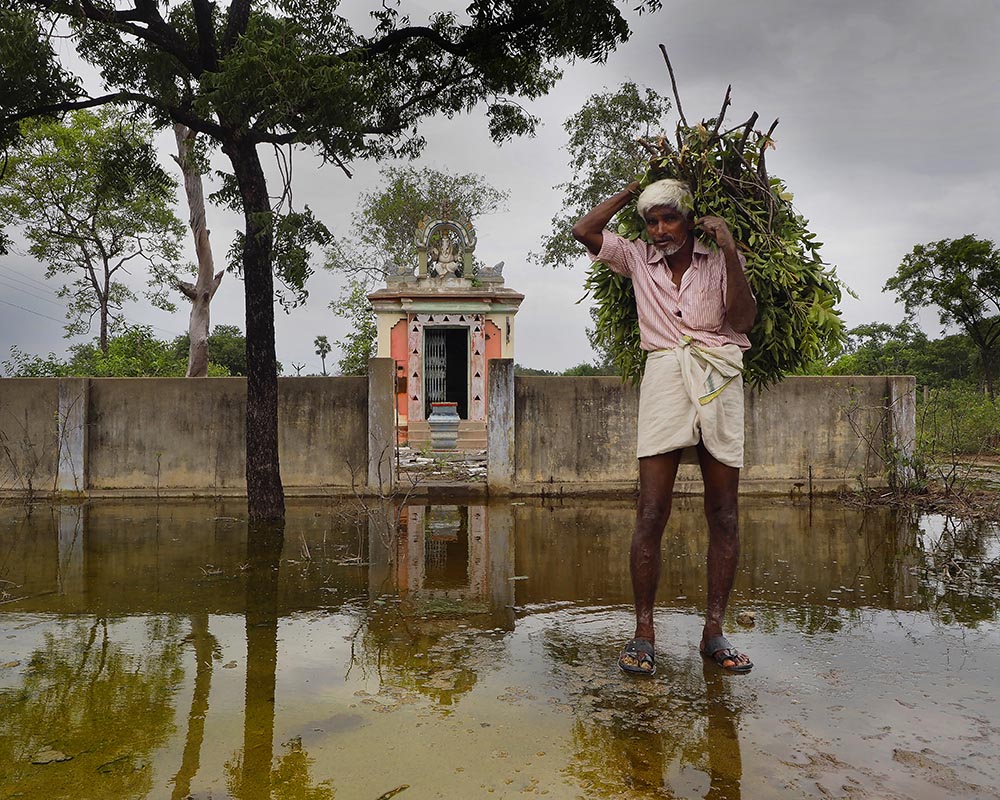
India, one of the world’s leather giants, exported $5.92 billion in leather and leather goods between 2015 and 2016, with about 14 percent of that going to the United States, according to the India Brand Equity Foundation. Roughly 60 to 70 percent of the country’s leather and leather goods is produced in the southern Indian state of Tamil Nadu, where tanneries still look a lot like those in Hazaribagh.
Here women—wrapped in plastic to protect their brightly colored saris—sit or stand for hours plucking hair from softened goat skins stretched over frames, while the men tend the drums filled with hides and chemicals.
Despite efforts at reform, human rights groups continue to find widespread pollution and horrendous working conditions in the tanneries of Tamil Nadu. A joint study in 2015 by Norwegian and Indian organizations found workers, particularly migrants, unprotected and unaware of the hazards. In January 2015, 10 migrant workers were killed where they slept when a wall of a Ranipet tannery collapsed and released a torrent of slurry upon them. It was one of India’s most horrific tannery accidents.
Tamil Nadu also is beset with serious environmental contamination caused in part by abandoned tanneries and factories that made chemicals for the leather-processing industry. More than 20 years after the Tamil Nadu Chromates & Chemicals Ltd. factory closed, the grounds of the abandoned factory on the SIPCOT Industrial Complex outside Ranipet remain covered in 165,000 tons of chromium-bearing waste. Government agencies and international environmental groups have been studying the site and developing remediation plans since the late 1990s. Meanwhile, the bright-yellow runoff has contaminated land 1.5 miles south of the plant with hexavalent chromium, a 2010 study shows.
Bangladesh authorities, too, will face a monumental environmental cleanup when the tanners finally leave Hazaribagh. Mizanur Rahman, treasurer of the Bangladesh Tanners Association and executive director of Samota Leather Complex, said the association and tanners will contribute to the efforts to restore Hazaribagh out of “social responsibility.”
So far, though, the government has yet to announce official plans to address lingering pollution. Pearshouse says that when he asked a government official last year about remediation plans, the official told him a cleanup would not be necessary because “all the pollution would be washed away.”
“They have no idea who would actually fund [a cleanup],” Pearshouse adds.
Shipping records compiled by Datamyne, a provider of international trade data, provide a snapshot of Bangladesh exports to the United States. From January through the end of October 2016, Datamyne reported $52.24 million worth of individual shipments of leather and leather goods to companies in the United States. Very little of that was processed leather shipped directly from Hazaribagh tanneries. Most of the shipments contained finished leather goods bound for major U.S. and European fashion retailers. There is virtually no way for consumers to know where the leather in those shoes, purses, or belts came from unless the companies themselves reveal their supply chains.
According to the Datamyne records, more than a dozen fashion and shoe companies imported products made in Bangladesh through November 2016. The largest of these include Michael Kors, Timberland, Hugo Boss, C & J Clark America, Puma, and the Gap Inc. brand Banana Republic.

Timberland, Hugo Boss, Puma, Clarks, and Gap each told Undark that their companies do not use leather from Hazaribagh in their products manufactured in Bangladesh. Timberland provided the most explicit information, including photographs of shipping cartons and invoices, to verify that the leather used in its products made in Bangladesh came from a Vietnamese tannery rated “gold” by the Leather Working Group, an international association that audits tanneries and promotes best practices for the industry. A company spokeswoman said that Timberland employs numerous checks and balances to ensure the integrity of its supply chain and audits its manufacturing partners and suppliers at least annually to ensure that the companies treat their workers fairly and meet the company’s standards for environmental quality.
“To ensure the integrity of our products and brand, we have to be vigilant about our leather supply chain. Not to mention, of course, it’s the right thing to do,” said Colleen Vien, the company’s sustainability director. “One way we ensure that we are sourcing the best leathers, in terms of quality as well as sound manufacturing practices, is only using tanneries that are rated gold or silver by the Leather Working Group. No tanneries in Bangladesh today meet our stringent standards.”
Puma said that 90 percent of its leather comes from tanneries rated by the Leather Working Group. The Bangladesh factory that makes shoes for Puma was last audited in November 2016, the company said. “We are aware of the challenges related to leather production in Bangladesh,” they said. “Therefore Puma does not source any leather from Bangladesh and as far as we are aware, our suppliers are also not sourcing any leather from Bangladesh.”
Clarks, a founding member of the Leather Working Group, said the company conducts “social audits” at tanneries supplying 80 percent of the leather for its products, and that it sources more than 75 percent of its leather from LWG-rated tanneries. About 20 percent of the leather comes from tanneries in regions considered at low risk for social abuses, the company said, and tanneries that have not achieved LWG medal-rated status are closely monitored to ensure that they are making progress toward meeting the higher standards.“Clarks has never specified leather from tanneries in Hazaribagh,” wrote Anthea Carter, the company’s global head of corporate responsibility, in an email. “Prior to 2013 the Clarks business sourced a small proportion of footwear from Bangladesh through agents. Due to the commercial arrangements with those agents Clarks did not specify or have visibility of the sources of the leather used in that production. From the information available, we have not found any links to sourcing from Hazaribagh tanneries prior to 2013.”Michael Kors, which, according to Datamyne, received more than 200 shipments from Bangladesh factories in 2016, did not respond to repeated telephone and emailed requests to discuss its leather supply chain.

Dozens of companies now have statements on their websites espousing support for ethical sourcing, human rights, and sustainable manufacturing processes. But few disclose detailed information about their suppliers. As conditions in Hazaribagh and other tanning centers of the world become more well known, consumers are asking whether the leather in their boots or bags was produced by tanneries that pollute and expose workers to hazardous conditions. Pearshouse maintains that companies have an obligation to answer those questions.
“If there are large companies that are importing from Bangladesh, the question of ‘where did your leather come from’ must be known,” says Pearshouse. “It’s no longer adequate for a company to say ‘We don’t know,’ or ‘We don’t say.’”
“Leather companies should be on notice,” he adds, “that if they’re importing from Bangladesh, this is the most notorious tanning area in the world.”
[This story was published in Undark on February 21, 2017. Reprinted with permission.]

Worse for Wear: Indonesia’s Textile Boom
Debbie M. Price. Images by Larry C. Price.February 2017
With the first light, men in long boats are on the Upper Citarum River, filling their hulls with bottles, cans, and bits of broken plastic—anything that can be recycled for a few rupiahs. Everything anyone might throw away is here.Smashed styrofoam coolers, broken toys, clothes, food containers, a deflated soccer ball, even car batteries and metal tools, buoyed by the bits of plastic below, float along on the current. At bends in the river, the detritus coalesces into mats of trash, tight and strong enough for a man to walk across. The water itself is as thick and dark as motor oil, coursing with sewage, agricultural runoff, and chemicals flushed into the river by the factories that line its banks.
It was not always this way on the Citarum—routinely named one of the world’s most polluted waterways. Old-timers tell of a healthy river full of fish until the late 1970s when Indonesia’s manufacturing sector—animated in large part by textile producers and other companies fleeing rising labor costs and environmental regulations in West—began to grow and dump their effluent into the water. With the boom came a deluge of factory workers, which quickly overwhelmed municipal waste disposal systems, further stressing the river.
Today, Indonesia ranks among the top 10 textile and apparel producing countries in the world, with more than $12.7 billion in exports, including $3.96 billion to the United States in 2014, according to World Integrated Trade Solution, a trade database of the World Bank. Three million people work in the garment and textile industries, according to Indonesia Investments, an investors’ news service that covers the country’s economy.
For residents of the West Java province near Bandung, this economic growth has come at a steep price with the ruin of the Upper Citarum River and the destruction of rice fields contaminated with heavy metals in industrial effluent. Now, a recent Indonesian court ruling, if upheld, could give environmentalists a small victory in the fight to clean up the Citarum River—and at the same time, possibly imperil thousands of jobs. It is a story that has played out time and again around the world, from the Hazaribagh neighborhood of Dhaka, Bangladesh, to Gloversville, New York, as environmental regulations catch up with polluting industries.

In December 2015, two local community organizations, Pawapeling and WALHI (Indonesian Forum for the Environment), with the support of Greenpeace Southeast Asia Indonesia, sued the Sumedang Regency government and three factories permitted to dump into the Cikijing River, a tributary of the Citarum. The named plaintiffs alleged that the government had not monitored the factories’ discharge and had failed to conduct environmental impact studies before issuing the wastewater permits. Greenpeace and Padjadjaran University’s Institute of Ecology also released a report in April 2016, one month before the court ruling, in which they alleged that industrial wastewater used for irrigation had contaminated 2,300 acres of rice fields with heavy metals, and caused economic losses of about $866 million over two decades.
The Bandung court concurred with the plaintiffs’ arguments and ordered the Sumedang district government to “suspend, revoke, and cancel” wastewater discharge permits for PT Kahatex, PT Five Star Textile, and PT Insansandang Internusa, the three named textile factories. “It is clear that they violated the principles of good governance by granting those companies wastewater permits,” the plaintiffs’ attorney Agus Rasyid said of the Sumedang Regency’s failure to monitor wastewater permits.
In October 2016, the Jakarta High Court upheld the lower court ruling. The defendants appealed that decision to the Indonesian Supreme Court in December. “This indicates that there are judges who still have a conscience,” said Anang Sudarna of the West Java Environmental Agency. “We all know that if they had to comply with standards of waste treatment,” he added, “we wouldn’t see today’s destruction to the rivers and fields.”
Dwi Widi Nugroho, the lead lawyer for Kahatex, said that his client, which manufactures polyester fibers, yarn, fabrics, and garments, spends $451,000 a month to successfully remove chemicals from its wastewater. The three companies, Nugroho said, feel that they have been unfairly singled out and penalized for the actions of dozens of other upstream factories, which pump untreated effluent into the river. Both lower courts rejected these arguments, Nugroho said.
Losing the wastewater permit, he said, would be a death sentence for Kahatex, which by his estimate employs 90,000 people and sources 60 to 70 percent of its raw materials from smaller factories in West Java. “If we lose, of course we will comply with the court decision and close down,” he said. “Then the government must think about this and take care of these tens of thousands of workers.”
Environmentalists dismiss talk of closure and mass firings as scare tactics. Ahmad Ashov Birry, a toxic campaigner with Greenpeace, said that their hope is that the court ruling, if upheld, will establish a precedent. “We could ask for the government to repeal all discharge permits,” Birry said. “That’s the idea actually. We start small.”
It’s true that the Indonesian court ruling could give environmentalists the ammunition they need to force government and industry to develop and enforce effective wastewater treatment standards for the textile and apparel industry throughout Indonesia. And this, in turn, could threaten the livelihoods of thousands of people who live along its banks—even as the Indonesian textile industry is facing increased competition from China and other emerging markets in Southeast Asia.
By some estimates, there are about 2,000 industrial and manufacturing facilities in the Citarum River basin, including at least 200 textile and apparel factories near Bandung. For decades, the government has permitted factories to flush wastewater into the river, provided the effluent does not contain any of about four dozen banned industrial chemicals. Stricter wastewater discharge standards and enforcement likely would force smaller companies to close.
Factory effluent is not the only contaminant pouring into the Citarum, which irrigates crops and provides drinking water for more than 25 million people, including residents of the greater Jakarta region. A 2013 Asian Development Bank report found that most of the Upper Citarum River’s water quality parameters were far outside allowable limits. Fecal coliform bacteria—likely from manure fertilizer and sewage—was 5,000 times the mandatory limit in some locations. Municipal sewage systems and solid waste disposal in communities along the Citarum are woefully inadequate and funds to modernize are scarce.
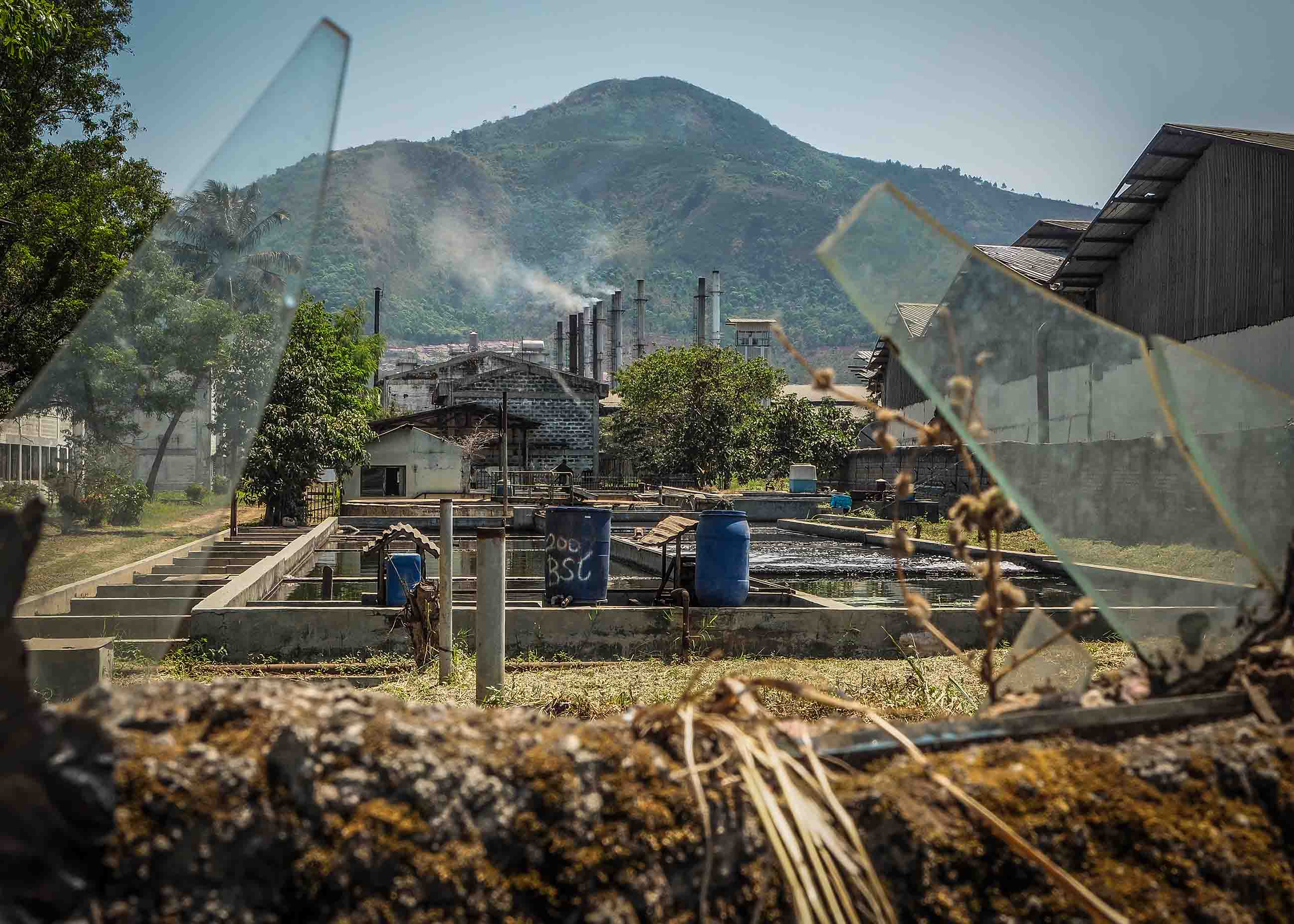
The Asian Development Bank approved a $500 million, multi-year loan in 2008 as part of a long-term effort to restore the river. ADB funds have supported several river improvement projects, including a re-engineered canal in Bekasi to improve water quality for the greater Jakarta area. But in West Java, efforts to address the massive pollution have been sporadic at best. The Indonesian government has proposed filing civil suits against polluters, admitting that criminal prosecutions have been ineffective. Local officials have taken baby steps to curb trash.
Bandung Mayor Ridwan Kamil has imposed a ban on styrofoam packaging for all food sold in the city. Berita, the official website of the West Java Province, announced in October that the government would form a task force to work with more than 300 known polluters in Bandung to help them remediate waste and implement water treatment facilities. At a 2015 festival highlighting a four-year cleanup of the Citarum, West Java Vice Gov. Deddy Mizwar admonished the crowd, “Perhaps we no longer need the Citarum, so we make it as a waste bin and toilet stool.”
Greenpeace, for its part, is keeping up its Detox campaign to pressure the fashion industry to stop using hazardous chemicals and sourcing from polluting factories. The group’s 2013 “Toxic Threads” report blasted some of fashion’s biggest names for buying clothing from a company that owns a factory it accused of pumping untreated effluent into the Citarum. The environmental group said that it found nonylphenol (NP), nonylphenol ethoxylates (NPEs), which are used as detergents and surfactants, tributyl phosphate (TBP), antimony, which is a metalloid used in polyester manufacture, and wastewater with a pH of 14—high enough to burn the skin—from the outflow spouts at the PT Gistex Textile Division factory on the Citarum near Bandung.The report, which publicly detailed the textile chemicals in Citarum River factory effluent propelled Greenpeace to the forefront of the fight to clean up the river.
Several of the companies named in the organization’s report are members of Zero Discharge of Hazardous Chemicals, an international group of clothing and footwear brands that have pledged to eliminate hazardous chemicals from their products by 2020. And most have sustainability statements on their websites. A few of the companies named in the Greenpeace report also still source clothing from one of the Gistex Group’s Indonesian factories, according to Datamyne, a Miami-based firm that collects global trade data for market research records.
Gap Inc. and its brands, Old Navy and Banana Republic, received well over 100 shipments in 2016 at locations throughout the U.S. from a Gistex-owned facility, according to records compiled by Datamyne. In response to questions from Undark, a Gap spokeswoman provided a version of a statement that the company has issued on occasion since Greenpeace’s original 2013 report. The statement acknowledged that the company sources from PT Gistex Garmen, which is owned by the PT Gistex Group, but asserted that the company “does not source” from the Gistex facility near Bandung that was singled out by Greenpeace. Gap has also “reiterated to the Gistex Group the importance of adherence to our Code of Vendor Conduct, including provisions regarding environmental health and safety and chemical restrictions,” the statement said. The company did not respond to specific questions about how it ensures that its suppliers are adhering to its conduct codes.
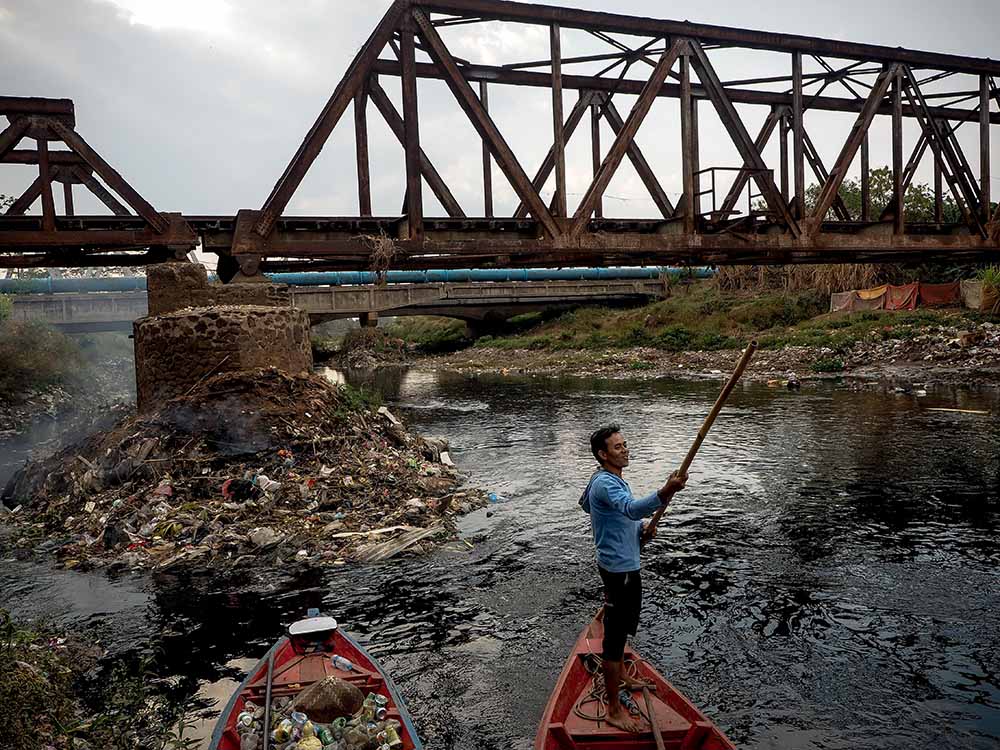
Puma, another company named in the 2013 Greenpeace report, also confirmed that PT Gistex Garmen is an active supplier. Puma said its most recent audit of Gistex was in April 2016.
“All direct Puma suppliers are regularly audited for social and basic environmental compliance through the Puma Sustainability department. These audits contain checks on the relevant environmental permissions as well as proper treatment of wastewater and waste,” the company said. Puma also said that it regularly asks all its suppliers with wet processing facilities to perform wastewater tests and publish the results through the Institute of Public and Environmental Affairs, a Chinese non-governmental organization.
“We have just started expanding our audits into the core material and component suppliers as we recognize that improvements are necessary,” Puma said. “This expansion into the lower tiers of the supply chain is a long-term effort.”
On its website, Gistex promotes its “Go Green” program and says that the company built a water recycling program in 2012 and in 2015 received certifications and met standards established by the International Organization for Standardization for quality and environmental management. With the certifications as a foundation, PT Gistex said it hopes “to continue with improvements in all areas,” according to a statement on the company’s website.
Several American and European companies also source from PT Kahatex, according to Datamyne. None of those companies contacted by Undark responded to interview requests.
People’s health and lives depend on companies fulfilling their commitments and cleaning up their supply chains, Birry wrote in a blog post hailing the court ruling against the factories.
“Millions depend on the health of Indonesia’s rivers, water, and land,” he added. “We won’t stop fighting.”
[This story was published in Undark on February 23, 2017. Reprinted with permission.]

The Toxic Toll of Indonesia’s Gold
By Richard C. Paddock. Images by Larry C. Price.May 2016
JERENGJENG, Indonesia—Ipan is 16 months old and suffering his third seizure of the morning. His head is too large for his body and his legs are as thin as sticks. He arches his back, and his limbs stiffen. He cries out in pain.
His mother, Fatimah, tries to comfort Ipan but there’s not much she can do. A dukun, or shaman, says his soul was invaded by the spirit of the monkey, bat, and octopus. On his advice, Fatimah and her husband Nursah changed the boy’s name from Iqbal to Ipan and fed him tiny rice balls mixed with octopus.
“The dukun says this is why Ipan’s legs look like a monkey’s legs,” Nursah says. “Actually, I don’t believe that, but I will try anything.”Doctors say the real culprit is more down to earth: mercury poisoning. His parents are gold miners who used the heavy metal to process gold for years before Ipan was born, including while Fatimah was pregnant.Millions of people in 70 countries across Asia, Africa, and South America have been exposed to high levels of mercury as small-scale mining has proliferated over the past decade. The United Nations Environment Programme estimates that at least 10 million miners, including at least 4 million women and children, are working in small-scale or “artisanal” gold mines, which produce as much as 15 percent of the world’s gold. In Indonesia, more than 1 million small-scale miners scratch out an illegal living digging for gold in at least 850 hotspots, says Yuyun Ismawati, a 2009 winner of the Goldman Environmental Prize who has conducted extensive research on illegal mining. Ipan is one of at least 46 suspected victims of mercury poisoning in impoverished southwestern Lombok, a tourist island next to Bali. Doctors have found another 131 suspected victims in three other mining districts.Some miners heat mercury in their kitchens, where the vapors can reach concentrations that are quadruple the amounts considered safe under World Health Organization standards.

High doses of mercury, which is a neurological poison, are a well-documented cause of birth defects, including crippling deformities and nervous system disorders. The most notorious episode of mercury poisoning occurred in Japan in the 1950s when a factory dumped the heavy metal into Minamata Bay. More than 2,000 people were poisoned by the bay’s seafood, leading to deaths as well as a generation of children suffering severe birth defects.Mercury poisoning is “a serious health problem” in Indonesia, says Stephan Bose-O’Reilly, a pediatrician and environmental health expert at the University of Munich. “Prenatally, methyl mercury can harm the fetus, resulting in Minamata disease with severe birth defects and developmental delays,” he says.
Mining With Mercury
Small-scale gold mining began to take hold in Indonesia after the 1998 fall of Suharto, its longtime military ruler, and has flourished in an ensuing era of lax governance. Nearly all artisanal miners use mercury to extract gold even though the practice is banned by the government.Indonesia, with the world’s fourth largest population spread across a vast archipelago of 17,500 islands, has among the highest incidence of illegal mercury use, says Bose-O’Reilly during a recent trip to Indonesia to examine mercury victims in the gold fields.“Indonesia is a real global hotspot,” he says. “I haven’t seen anything worse than here.”Indonesia’s small-scale miners produce $5 billion in gold a year, according to Atmadji Sumarkidjo, a special assistant to Coordinating Security Minister Luhut Pandjaitan. That is about 7 percent of the country’s total gold production. By contrast, Indonesia’s gross domestic product was about $888 billion in 2014.Miners have released hundreds of tons of mercury into the water, soil, and air, often in poor, remote areas, contaminating food and wildlife.In the Central Java city of Wonogiri, where illegal gold miners have operated for more than 15 years, residents were alarmed two years ago when the local environmental agency tested guava, cassava, papaya, and banana grown in the area and found them to be highly contaminated with mercury. Doctors working with the environmental group BaliFokus Foundation, including Bose-O’Reilly, identified the 177 cases of suspected mercury poisoning on the islands of Java, Lombok, and Sulawesi, says Ismawati, a co-founder of the group. The figure includes 57 children and 59 victims who have died since they were examined.Ismawati calls it “a public health emergency.”“Children in the mining areas have been exposed to mercury since they were in the womb and some are born with deformities,” she says. “When they grow up, they inhale contaminated air, drink contaminated water, and eat contaminated rice.”

Indonesia’s Gold Rush
In Indonesia, miners flock to newly discovered gold fields, often in national parks or on other public land, where they operate without legally required permits. They dig deep mine shafts, tear apart mountains, dredge rivers, destroy forests, and poison the environment.
Noisy tumblers known as ball mills operate almost continually in mining communities, often next to homes, grinding the ore along with mercury and water to extract the gold. As the tumblers rattle and spin, the rock breaks down and flecks of gold bind to the mercury. Afterwards, the miners drain off the liquid and recover some excess mercury, but much of it becomes vapor and pollutes the air or flows onto the ground and into waterways.In some villages, families use mercury-laced mine waste as the foundation for their homes or to surface their yards and walkways.In the final stage of extracting the gold, the miners typically heat their mercury and gold with a blowtorch, sending poisonous mercury vapors into the air.
Child labor is common in the gold fields, with boys as young as 8 digging the ore and as young as 12 burning the mercury-gold amalgam. Mujiburrahman, 14, who lives in the West Lombok village of Luang Baluk, says he began torching mercury two years ago. “I burn the amalgam two or three times a week,” he says. “I never wear protective clothing.”The smoke, he says, simply “disappears.”Doctors have identified 24 children in mining villages in the Sekotong district in southwestern West Lombok with birth defects or ailments caused by mercury.
Among them is Lailatul Azwa, who was born in September without a left hand. Like Ipan, she suffers frequent seizures.
Six-year-old Aida was born with deformed fingers on both hands. Nyimas, who suffered from an enlarged skull and other serious deformities, died earlier this year at the age of 8. She was in a near-vegetative state all her life. Gold miners use mercury in its elemental form, which is liquid at room temperature. Inhaling the vapors produced by burning the amalgam is the most dangerous exposure, doctors say.
“Mercury vapor is very toxic to the brain, especially during development, and exposures may therefore be detrimental to pregnant women and small children,” says Harvard environmental health professor Philippe Grandjean, a leading expert in the effects of mercury exposure.
Cooking Mercury
Karto Paimin, 67, lives with his family in the placid hills above Wonogiri in a wooden, Javanese-style house with a high peaked roof and a large living area. The family has tunneled about 50 feet into the hillside below the house to find ore, which they process with mercury in their ball mill in the garden.
After many hours of labor, Paimin has produced a small lump of mercury and gold, which he takes to the kitchen at the far end of the house. The room has a dirt floor, woven bamboo walls, and a rudimentary wood stove with no chimney. Two large pots of soup simmer on the fire at mid-afternoon.
Paimin brings out a piece of pipe, which is about 18 inches long and closed at one end. He slips the mercury-gold amalgam into the sealed end of the pipe and places it in the fire. He rests the other end of the pipe in a small dish of water on the floor. His daughter, Yuni, 33, and grandson, Galang, 9, squat nearby to watch.
As the pipe heats up, the mercury melts and most of it flows into the dish. But some evaporates and the fumes escape into the room. Krishna Zaki of the group BaliFokus has lugged a portable vapor analyzer into the kitchen and tests the air. He detects about 4,000 nanograms of mercury per cubic meter, four times the World Health Organization’s safety threshold of 1,000.
When the process is complete, Paimin retrieves a hot two-gram pellet of gold, which he can sell for the equivalent of about $75.
Outside, Paimin’s wife, Dinah, 55, has been complaining of headaches and difficulty breathing. Ismawati gives her simple coordination tests, including touching her nose with her finger and moving her wrists simultaneously. She does poorly and Ismawati recommends she get tested for mercury exposure. Dinah is shocked. She and her husband had no idea mercury was harmful.
“Now I know,” Paimin laments. “But before today I didn’t know and I cooked the mercury in the kitchen.”
“Like an Iceberg”
Since Roman times, when slaves worked the cinnabar mines, mercury has been known to cause a wide range of symptoms, including headaches, tremors, drooling, difficulty walking, and eventually death. But mercury poisoning can be difficult to diagnose because it has many symptoms in common with other ailments.
The extent of mercury-related health problems in Indonesia is only now emerging as BaliFokus, volunteer doctors, and a few government officials search out victims and test for mercury in the air, food, homes, and water.
Ismawati, who is spearheading the effort, says the discovery of more than 140 mercury victims is a sign that Indonesia faces one of the world’s worst mercury disasters.
She believes that many victims have died without ever being diagnosed and that many more suffer unnoticed in remote mining communities. The cases identified so far only scratch the surface, she says. Grandjean agrees: “I’m sure that the number of poisonings is underestimated,” he says.
Erick Gunawan, a public health service doctor in Sekotong, has held two screenings in mining communities with BaliFokus’s help and found dozens of potential mercury victims. He believes there are many more who have been poisoned and hopes to hold more screenings.
“It’s like an iceberg,” he says. “You only see what’s on top but you can’t see what’s below.”
Claims of Extortion
The slow-growing environmental disaster has begun to attract attention from top officials in the administration of President Joko Widodo.
Pandjaitan, the coordinating security minister, recently cited illegal mining as one of the security challenges facing the country. Sumarkidjo, his aide, says the minister was referring in part to the illegal miners who destroy the environment and spread mercury in their communities.
He says the minister was particularly concerned by the rapid destruction and widespread use of mercury by miners on remote Buru Island, the site of a former prison in the Maluku Islands where a gold rush has drawn many thousands of miners since 2012.
“It’s not small-scale when you look at Buru Island,” he says. “It will take years to clean up the mercury.”
Gatot Sugiharto, founder of the Indonesian People’s Mining Association, says miners are forced to give as much as half their earnings to corrupt police and soldiers who control access to mining areas and demand payment. He alleges that billions of dollars go into the pockets of officials who should be enforcing the law against using mercury.
“The miners lose about 50 percent of their product to pay the extortion,” he says. “Sometimes police take it all.”
Sumarkidjo agrees that the miners’ illegal status makes them vulnerable to extortion and acknowledged that the police and military take a significant share.
“Our office does not have proof of how much they take,” the minister’s aide says. “But you can’t do these illegal things without the understanding of the authorities—the police and the local military. Everyone takes the opportunity to take something.”
Sugiharto, a former miner, advocates legalizing the small-scale miners and argues it is the only way to end mercury use.
Operating outside the law means the miners pay no taxes, depriving the government of much-needed revenue. If they were legal, he says, the government could teach them to use non-mercury methods, regulate their activities, and collect taxes to pay for health care, mercury cleanup, and land rehabilitation.
“Being illegal, all activity is uncontrolled,” he says. “They use mercury inside their houses, hiding from the public or from the officers. It’s very, very dangerous because sometimes they burn the mercury in the kitchen or in their rooms.”
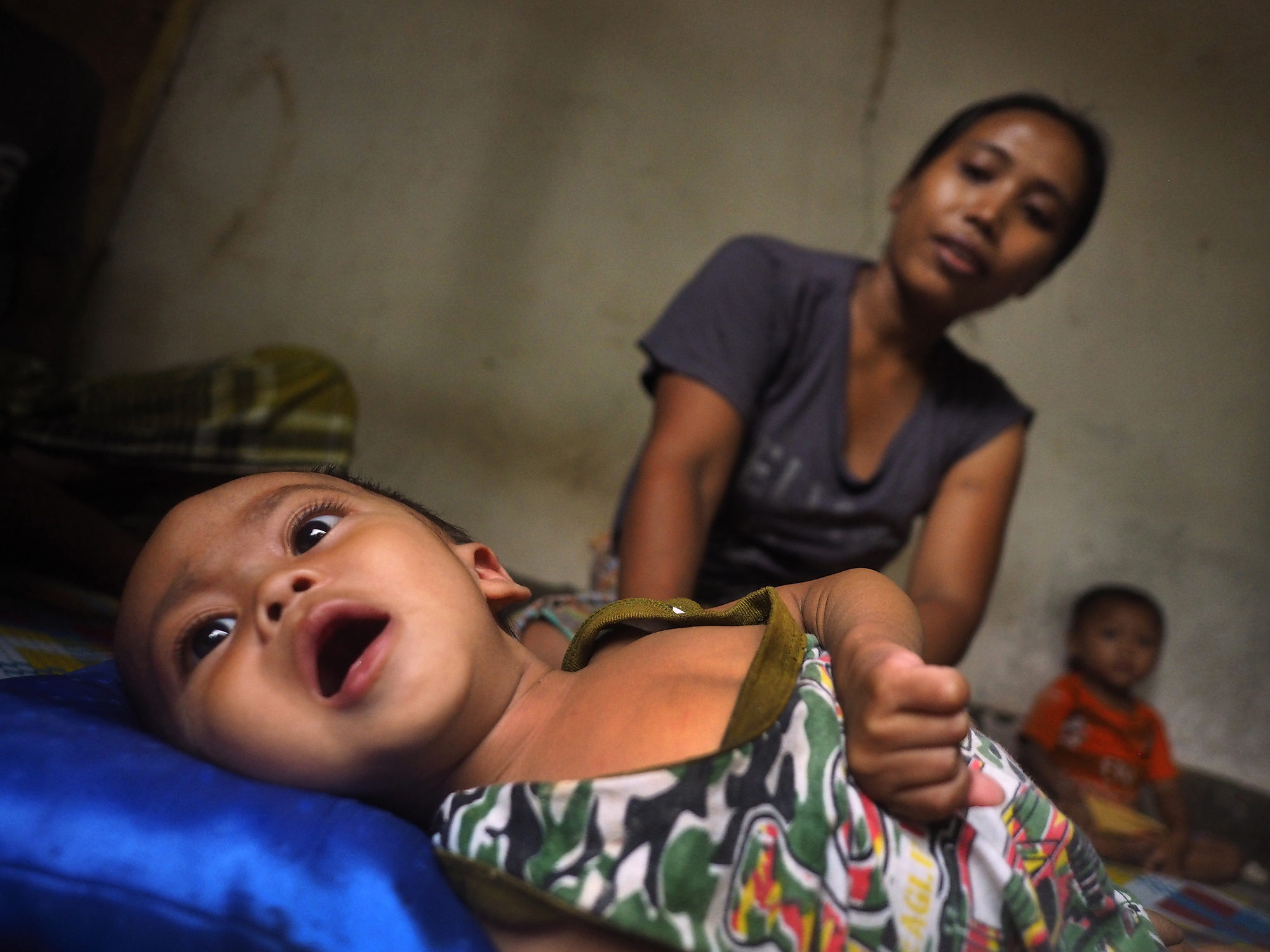
Global Action
The extent of mercury contamination around the globe has prompted international action.
In 2013, 128 nations signed the Minamata Convention, named after the Japanese disaster, which aims to limit the trade and use of mercury worldwide.
The UN convention doesn’t ban mercury in small-scale gold mining but requires the signatories to “take steps” to reduce its use and eliminate it “where feasible.” Countries are required to draft detailed action plans for eliminating amalgam burning and educating the public on mercury’s dangers, among other steps.
Indonesia signed the pact but is not among the 25 countries, including the United States, that have ratified it so far. It will take effect once 50 nations ratify it.
Tuti Hendrawati Mintarsih, director general of hazardous waste in Indonesia’s Ministry of Environment and Forestry, says her agency is developing the country’s action plan. But in tackling the mercury problem, she says the government is hampered by overlapping jurisdictions and a lack of funds to locate victims, provide care, and clean up contamination.
In the meantime, mining continues uninterrupted.
Resti Fauzia, 2, has never spoken a word. She stopped walking at 18 months, says her mother, Ocih. She can’t grasp objects or stand without help. When she sleeps, she has seizures.
Her family lives in the village of Pangkal Jaya near Pongkor Mountain, about 60 miles southwest of Jakarta. Illegal miners have been digging for gold there since at least 2000. More than 10,000 miners work there today.
For 15 years, Resti’s family has operated a ball mill just outside the kitchen door. Volunteer doctors working with BaliFokus examined the girl and concluded she was suffering from mercury poisoning.
On the day the medical team examined her, mercury levels outside the kitchen measured 20 times higher than the WHO safety threshold.“No one ever told us that mercury is dangerous,” Ocih says.
[This story was published in National Geographic on May 24, 2016. Reprinted with permission. Copyright © 2016 National Geographic Partners, LLC.]

Chapter 2: China’s Dirty Pollution Secret
He Guangwei is an award-winning journalist who has worked for numerous publications, including Time Weekly, New Weekly, Ta Kung Pao, and Jingzhou Daily. In China, He Guangwei has been covering the soil pollution crisis in Jiangsu and Hunan provinces and its implications for the country’s different local communities.
In both Jiangsu and Hunan, factories are causing unsafe, even deadly, levels of pollution to China’s soil, food and crops. Factory laborers in Jiangsu are dying from cancer at an alarming rate. The pollution has even seeped into the water—local officials say it looks like “soy sauce.”
Shuangqiao in Hunan Province is known as “Cadmium Village” for its factories’ emission of the toxic chemical. The municipal government closed a factory and arranged for health checks of the villagers—four died during the investigation in 2009. The people of Jiangsu and Hunan, recognizing the dire need to stop pollution, have begun to fight back. In Jiangsu, the China Council for International Cooperation on Environment and Development is attempting to help lower the rates of environmental pollution by putting pressure on the local government. Social unrest in Hunan has led citizens petition to their government.
He Guangwei provides an account of China’s pollution crisis and its efforts to control it. But, unfortunately, the problem in China might take years, even decades, to fix.
Also in this chapter, you will find a PBS NewsHour video showing how an environmental group is trying to clean up China’s pollution. It is produced by journalist Fred de Sam Lazaro who reported on air and water pollution in Beijing.
-A.J.

China’s Boom Poisoned Soil and Crops
By He Guangwei for Yale Environment 360June 2014
When Zhang Junwei’s uncle died in February 2012, he was only fifty. In the three years that he had endured the cancer that would kill him, surgeons had removed both his rectum and his bladder. “Perhaps he was better off dead,” said Zhang, reflecting on his uncle’s ordeal. “It was a release.” Two years after his uncle’s death, Zhang still refuses to name him, afraid that even now, talking about how his uncle lived—and died—could bring trouble down on the family.
Zhang’s uncle lived in Fenshui, in Central China’s Jiangsu Province, a village of some 7,000 people that straddles a network of waterways on the western shore of Lake Tai, China’s third largest freshwater lake. Lake Tai boasts 800 square miles of fresh water, shared between Jiangsu and Zhejiang provinces, and has been celebrated throughout Chinese history for its abundant fish and beautiful limestone landscape.
But as China’s industrial boom gathered speed through the 1990s and the early years of the 21st century, a new, metalled road connected the once sleepy village of Fenshui to the major highway networks being built across China. Factories began to cluster along the lakeshore and the village’s traditional single-story whitewashed houses, with their signature black-tiled roofs, were steadily replaced with two and even three-story houses, as factory wages brought a surge of prosperity to Fenshui. Zhang’s uncle, like many of his neighbors, had found work in one of those factories.
His illness hit the small family hard. His only son was serving in the army when his father fell ill, and the soldier’s wage was too small to cover the medical bills. Zhang’s aunt took a factory job herself to support her sick husband, making the difficult choice to leave him unattended during her working day. The cancer was to consume the family’s savings entirely, all spent in a fruitless effort to save his life. The patient struggled through his final days at home, getting up to see to his own needs until the day he finally collapsed while fetching a drink of water. He died later that day.
Zhang Junwei (whose name has been changed to protect his identity), believes that the cancer that ended his uncle’s life was caused by soil pollution, a subject so sensitive in China that Zhang himself is still afraid to discuss it openly. Zhang has just turned 40 and, like his uncle, has lived all his life in Jiangsu, near the lake. His village of Zhoutie is just five miles from Fenshui and less than 40 miles from the county town of Yixing, in the heart of the Yangtze Delta, today China’s biggest regional economy. For more than 1,000 years, Yixing and its surrounding countryside was an important source of grain for China, celebrated in poetry as far back as 960 A.D. for its benign climate and fertile soil, and famous for the manufacture of a dense, brown pottery that is still highly prized in China as the ideal material for teapots.
But today Yixing and the land around it sit in China’s new industrial landscape. Since the 1990s, nearly 3,000 factories have been built on the once-beautiful shores of the lake. The chemical boom made Yixing one of China’s richest county-level towns, with a GDP that reached $17.06 billion in 2012.
It is also still an agricultural area: the road from Fenshui to Zhoutie runs between flat, regular fields of vegetables, these days more profitable crops than grain for farmers who live close to urban markets. But many local farmers have given up eating the crops they grow. They know that their vegetables are planted in soil polluted with cadmium, lead, and mercury, heavy metals that are dangerous to human health. Zhang confessed that he rarely eats local produce either. “There’s too much soil pollution,” he said.
Soil pollution has received relatively little public attention in China. Despite the fact that it poses as big a threat to health as the more widely covered air and water pollution, data on soil pollution has been so closely guarded that it has been officially categorized as a “state secret.”
Until recently, the Chinese government also resisted media efforts to draw attention to local epidemics of cancer in China’s newly industrial areas. It was not until February 2013 that the Ministry of Environmental Protection (MEP) finally admitted that “cancer villages” existed in China, and released a list that included the area around Lake Tai and the villages of Fenshui and Zhoutie. Some civil society experts have estimated that there are 450 cancer villages in China, and they believe the phenomenon is spreading.

The story of the cancer hotspot of Yixing is characteristic: In the rush to develop that engulfed China from the 1990s, local officials were eager to invite factories and chemical plants into the area, and their already weak environmental controls were often disregarded entirely. “Government officials just care about GDP,” Zhang complained. “They were happy to welcome any polluting firm.” So, for a time, were the villagers who found jobs in the new factories.
The first real signs of the troubles to come were in Lake Tai itself, and were the subject of a long campaign by another resident of Yixing township, the fisherman turned environmentalist, Wu Lihong. In the early 1990s, Wu grew worried about the deterioration of Lake Tai’s once famously pure waters. He organized a local environmental monitoring group that he called Defenders of Tai Lake, to collect water samples from the lake and its feeder rivers.
For 16 years, Wu campaigned to draw attention to the lake’s declining health, despite harassment from local officials and police, and by appealing to senior government officials, he succeeded in forcing more than 200 factories to close. But his campaign abruptly ended on April 13, 2007, when he was arrested and then sentenced to a four-year prison term on charges of extortion and blackmail. The following month, the Ministry of Environmental Protection named Yixing a “National Model City for Environmental Protection.” Five days later, a toxic algae bloom turned the waters of Lake Tai into foul-smelling green sludge.
That episode, in the high summer of 2007, attracted international attention and was a major embarrassment for the national as well as the provincial government. According to the Lake Tai Basin Authority, more than 30 million people draw their drinking water from the basin’s 53 water sources. A Zhoutie local official admitted to the government newspaper People’s Daily that the algae bloom had caused a “water supply crisis,” and said the lake’s water “looked like soy sauce.” The authorities finally acted.
At the end of 2006, Yixing had been home to 1,188 firms producing chemicals. By October 2013, after six years of “rectification,” 583 had been closed down, merged or reopened as other types of businesses, as were 104 chemical plants in Zhoutie and 57 in neighboring Taihua township. In late 2013, Yixing started a new round of chemical industry cleanup, with plans to deal with an additional 52 chemical firms over the next two years.
It all came too late for the campaigner Wu Lihong. He has now completed his prison term and his wife and daughter have moved overseas, but Wu himself remains subject to restrictions, including a ban on talking to the media. His harsh treatment is a reminder to other villagers that environmental activism carries a high cost.
Pollution remains a highly sensitive subject in the district. Most interviewees were too frightened to give their names, worried about how local officials might react. Others complained that official secrecy about pollution meant that they could not discover what dangers Zhoutie’s toxic legacy might pose to their own health and that of their families. Zhang Junwei recalled that, when the pollution was at its worst, even people’s sweat was discolored. “Several of my relatives died from cancer very young,” he said.
Although the local government has now closed the worst of the factories, the pollutants those factories had released in their wastewater or sludge ended up in the soil, and the toxic waste from those polluting years continues to threaten the health of the people of the area and beyond.
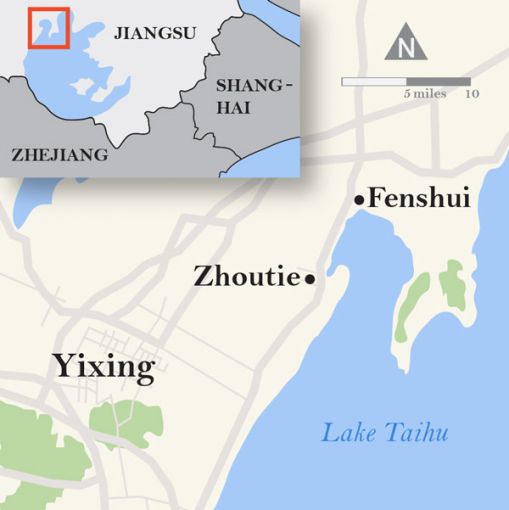
Zhang Junwei and villagers like him are well aware that cancer rates in their district have risen, and they suspect that pollution was the cause. They say the number of cancer victims started to increase 10 years ago, when local farmers began to fall ill and die. Their suspicions were well founded: When crops are grown in soil contaminated with cadmium or other heavy metals, the grain absorbs the toxins. But even today, despite this awareness of what pollution can do, local farmers have little choice but to continue to plant. These are families that reaped no direct benefit from industrialization and still have few alternative sources of income. The poorest still eat locally produced food, knowing it is contaminated.
Establishing a clear connection, however, between pollution and cancer is scientifically challenging. At Hohai University, in Jiangsu Province, Chen Ajiang, a sociologist who heads the university’s Institute of the Environment and Sociology, admitted that the link between pollution and cancer is extremely complex, and it is difficult to pin down cause and effect.
In 2007, Professor Chen won a government grant to study the interaction of human and water environments in the basins of Lake Tai and the Huai River. For five years, he and his four researchers carried out field studies in the provinces of Henan, Jiangsu, Zhejiang, Jiangxi and Guangdong, looking for evidence of the health impacts of water pollution. Professor Chen believed that pollution-related illness was damaging economic development, keeping villagers in poverty, or driving them away from their native villages altogether. Although he admits that the medical world has not yet identified an undisputed link between pollution and cancer in the villages he studied, his team established beyond doubt that cancer villages exist and that the lives of those who live in them are severely impacted.
The pollution that chemical factories released in gas and sludge, and in the wastewater they discharged into Lake Tai and other local waterways, has now accumulated in the surrounding soil, but the government has been reluctant to acknowledge the scale of the problem. In April 2013, the Ministry of Housing and Urban-Rural Development awarded Zhoutie a “Habitat Environment Prize,” an award, like the accolade given to Xining, that seems out of tune with the real state of Zhoutie’s environment.
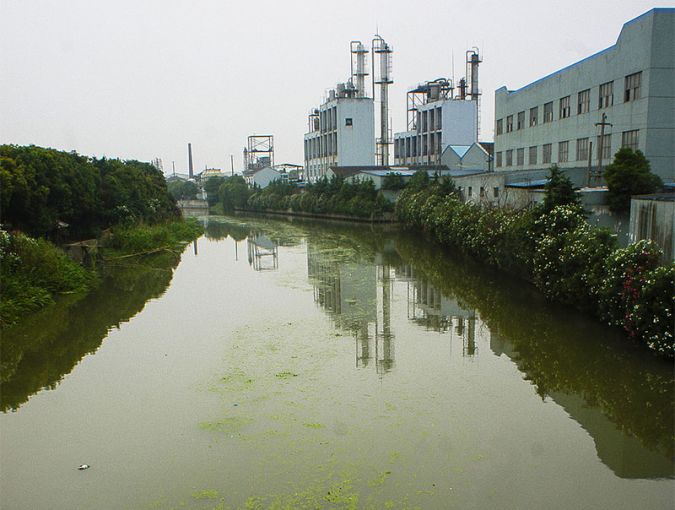
In the same month, the Jiangsu Geological Survey published part of a report that showed that heavy metal pollution in the Wuxi, Suzhou, and Changzhou areas has increased continuously since 2004, with once-isolated spots of pollution from cadmium and mercury now expanding and merging to form larger, continuous areas. The report revealed that between 2005 and 2011 increasing levels of cadmium were found at 37.5 percent of the sites sampled, with average increases of 0.03 milligrams (mg) of cadmium per kilogram (kg) of soil. At its highest, the annual average increase was 0.2 mg.
Continuous monitoring revealed an escalating pattern of pollution. In one unspecified area, researchers reported, cadmium levels higher than 0.4 mg per kilogram of soil were found only in relatively isolated patches in the land surrounding industrial development. But by 2012, large stretches of nearby farmland were polluted to the same levels, and rice and wheat produced in the area were contaminated.
It also described one case—later identified as the township of Dingshu, 18 miles to the southwest of Zhoutie—where, due to a cluster of township enterprises that were dumping their waste, cadmium levels in the river silt had reached 1500 mg per kg, and that rice produced on nearby land was contaminated with cadmium to levels of more than 0.5 mg per kg. China’s food safety standards rule that rice can contain no more than 0.2 mg/kg of cadmium, and the international limit is 0.4 mg/kg. Rice from Dingshu has long been in breach of those limits.
Dingshu is the center of Yixing’s ceramics industry, home to many glazed tile factories, teapot factories, and clay workshops. Yixing’s stoneware is an important source of revenue, but the factories have also badly damaged the local environment and contribute to the area’s soil pollution. Yixing launched a crackdown on ceramic factories in early 2011, but by June 2013 only 300 had been fully shut down.
The area’s problems illustrate the high price China is paying for 30 years of rapid economic development and the risks China’s increasingly serious soil pollution poses to its food. Official estimates say that China produces 12 million tons of heavy-metal-contaminated grain a year, with an economic cost of more than $3.2 billion.
China’s official approach to soil pollution has been characterized by secrecy and obfuscation. Even now, a picture of the scale and severity of the problem must be pieced together from disparate reports.
In 2010, for instance, a report on soil protection policy from the international expert body, the China Council for International Cooperation on Environment and Development (CCICED), warned that overall trends in China’s soil pollution gave no cause for optimism. Quoting China’s official 1997 Report on the State of the Environment in China, it characterized the pollution of China’s arable land as “rather severe,” with pollution affecting an estimated 10 million hectares of land. By the year 2000, according to that year’s report on the state of the environment, 36,000 of the 300,000 hectares of basic farmland monitored for harmful heavy metals were found to be more than 12 percent above the standard.
CCICED’s researchers were no more optimistic about China’s system of supervision and management of soil, finding that investment in soil pollution prevention and control was too low. They stressed that soil pollution reduces the quality of crops and recommended legislation to protect the soil and to control pollution, as well as improvement in China’s environmental soil standards.
There are now signs that gravity of the soil pollution problem is belatedly forcing the Chinese government to begin to deal with a problem that has accumulated over many decades, and to reconsider its policy of pursuing economic growth at the expense of the environment. In July 2007, the Ministry of Land and the National Bureau of Statistics launched a nationwide soil survey. It was completed in 2009, but partial results were not published until December 2013. In April 2014, the government released partial results of a second soil pollution survey, conducted from April 2005 to December 2013, and covering 243 square miles of farmland. The survey reported that about 16.1 percent of China’s soil and about 19.4 percent of farmland were contaminated.
China has 135 million hectares (334 million acres) of arable land in total, but the amount of available high quality arable land has been dropping due to advancing urbanization and pollution. According to the recently released data, the government classifies more than 3 million hectares of arable land as moderately polluted. How much of that is contaminated with heavy metals is still not clear, though in 2011, Wang Bentai, then chief engineer of the State Environmental Protection Agency (now the Ministry of Environmental Protection) put lead, zinc and other heavy metal pollution at 10 percent of China’s arable land.
By official estimates, pollution cuts China’s harvests by 10 billion kg every year. In addition, official estimates say China produces 12 million tons of heavy-metal-contaminated grain a year, resulting in annual direct economic losses of over $3.2 billion.
Rising public concern about the impacts of pollution have begun to force a change in government attitudes, but changes at the top can take some time to percolate down to lower levels of government. In November 2013, delegates to the Third Plenary Session of the 18th Chinese Communist Party Central Committee—an important party meeting—adopted a key strategy document that set out the government’s priorities for the immediate future.
The document, prosaically entitled “Decision on Major Issues Concerning Comprehensively Deepening Reforms,” promised that environmental protection would be given more importance in the performance evaluation of local and national officials, and that local officials would be considered directly responsible for pollution. Economic growth would no longer guarantee promotion for local officials. The government also promises to put in place the legislation and powers to allow polluters to be heavily punished, a promise that began to take shape in the new environmental protection law, approved in April 2014, which removed the caps that had kept fines for polluters low.
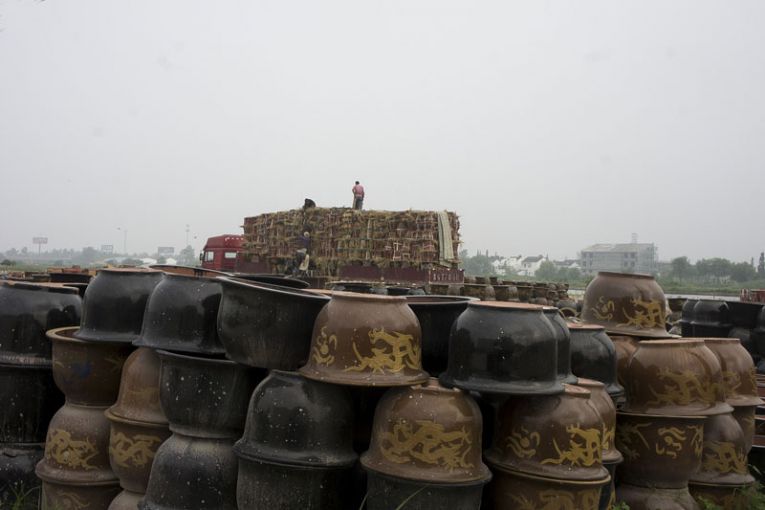
However, Zhuang Guotai, the head of the MEP’s Department of Nature and Ecology Conservation, has said that cleaning up soil pollution is a difficult and lengthy process that will require huge investment. In some cases, he explained, the pollution the ministry had identified in soil samples could be traced back decades: pollution from the pesticide benzene hexachloride, for instance, a substance banned in the 1980s, was still in evidence.
Mr. Zhuang promised that an action plan to deal with soil pollution will pull together both central and local government and businesses, using market mechanisms to promote soil restoration, with rewards systems in place to encourage public participation. A new law on soil pollution is also promised. But soil remediation is expensive and complex, and there are no easy answers to a pollution nightmare that has brought early death to the afflicted villages, reduced harvests, and rendered much of China’s homegrown food toxic.
[This article was published on Yale Environment 360 and also published on China Dialogue on June 30, 2014. A Chinese translation is available on the China Dialogue website.]

Soil Pollution Cleanup: A Daunting Challenge
By He Guangwei for Yale Environment 360July 2014
Luo Jinzhi is 52 and lives in the village of Shuangqiao, in China’s Hunan Province. For the last several years, Luo has been a petitioner, one of millions of Chinese people who find themselves appealing directly to higher authorities in the hope of resolving a problem. Some petition to rectify a legal injustice or to expose local corruption. Luo is petitioning on behalf of her fellow villagers for a remedy for the catastrophic pollution that has afflicted her home village.
Petitioning is a demanding and difficult process in which success is not guaranteed: It involves a long and expensive journey to the nation’s capital, where petitioners are frequently sent on fruitless journeys from one unresponsive official to another. Luo Jinzhi made the thousand-mile journey, most recently this April, to plead for action with the Bureau for Letters and Calls, the first stop for petitioners in the capital, and the Ministry for Environmental Protection, only to be told to go home and wait for the local government to take care of her complaints. She has yet to hear from any of them.
For Luo and her neighbors, the first sign of a serious problem in Shuangqiao was on June 28, 2009, when Luo Bolin, a worker at the Xianghe Chemical Factory, died of cadmium poisoning. When he died, his left leg was marked by large purple contusions; he was only 44. The list of cadmium-related deaths in Shuangqiao has since grown longer, and evidence is mounting of a national pollution crisis that has contaminated China’s soil and food crops and threatens to overwhelm efforts to put it right.
The Xianghe Chemical Factory, where Luo had worked, opened in 2004, on a site just 50 meters from the Liuyang River. The Liuyang flows directly into the Xiang River and is celebrated in Chinese Communist mythology as the symbol of an historic milestone in the party’s long struggle for power. It was here, in September 1927, that Mao Zedong led the first armed Communist revolt, the brief Autumn Harvest Uprising, and set up the short-lived Hunan Soviet, an episode still commemorated in songs in praise of the river.
The factory employed 50 Shuangqiao villagers and produced an annual total of 3,000 tons of powdered and pellet zinc sulphate, an animal fodder additive. In 2006, apparently without government approval, it began to produce indium, a rare metal more valuable than gold, but the processing of which produces cadmium as a by-product. Starting in April 2008, the villagers of Shuangqiao began to notice small, but troubling changes: The local well water began to taste oddly of rust, Luo recalls, and saucepans used to boil water changed color.
On June 27, 2009, the day before Luo Bolin’s death, the government of Liuyang municipality suddenly closed the factory and arranged health checks for more than 3,000 villagers who lived within 1.2 kilometers of the plant. Five hundred were found to have high levels of cadmium in their bodies, and another four were to die during the government investigation. Shuangqiao became known nationwide as a “cadmium village.”
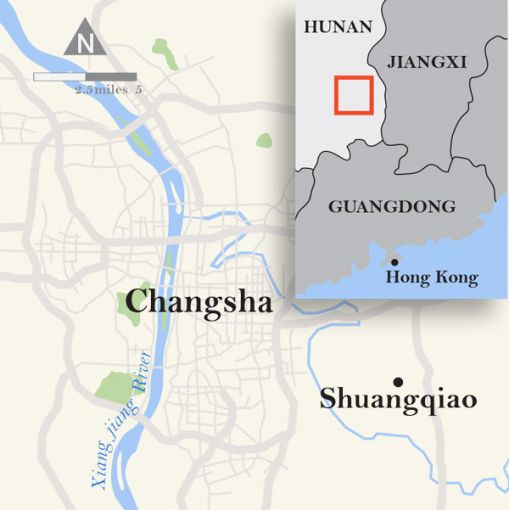
Luo Jinzhi has collected what she believes to be a still incomplete list of the names of the dead in Shuangqiao and the neighboring villages of Dongkou and Puhua, starting with Luo Bolin. In all, she says, she has identified 26 deaths from cadmium-related illnesses between 2009 and 2013.
Although the government paid compensation of between $1,600 and $9,000 to the victims’ families, it has never admitted a link with cadmium or other metals that have affected the villagers. In December 2008, for example, Luo Jinzhi’s five-year-old nephew began to have breathing difficulties and became listless. He was found to be suffering from lead poisoning, and 14 more cases in children had been identified by March 2009.
When the deaths began, the villagers started to protest. On July 29, 2009, hundreds of them went to the township government to complain that the factory’s cadmium pollution still threatened their lives. The next day, thousands surrounded the government building, and Chen Run’er, the party secretary from the provincial capital, Changsha, had to be called in to address them. He promised the villagers that their complaints would be investigated, but on August 5, the Liuyang authorities ordered in hundreds of police with dogs. The confrontation finally ended when the head of the plant, Luo Xiangping, was arrested, the factory was permanently shut down, and the director and a deputy director of the Liuyang Environmental Protection Bureau were fired.
Although the factory has now been shut for good, the pollution is still affecting the village. The nearly 10-acre site that the shuttered business occupied is surrounded by a six-foot wall. Behind it lies a large pile of toxic sludge. When it rains, contaminated water seeps from the sludge into the Liuyang River, just 50 meters away. Around the plant, 659 acres of land have been polluted with cadmium, and any crops grown there are contaminated. The villagers believe that moving elsewhere offers their only guarantee of safety, and they have asked Luo Jinzhi to negotiate their relocation with the township government.
Liu Bo—who is coordinator of the liaison office of the European Union-Asia Environmental Support Chengde Project, a EU-funded group focusing on urban river pollution—investigated the factory site in January 2014. He, too, concluded that “the pollution is continuing to do harm,” damaging the local land and soil and threatening the Liuyang River basin. The basin includes Changsha, as well as the Xiang River, the source of drinking water for some 20 million people.
Hunan Province is an important center for heavy metal production. In 2011, the province’s 1,003 non-ferrous metal companies produced 2.66 million tons of ten different metals—the third highest production in China and worth $60 billion. Several years ago, the government said it hoped to turn Hunan’s Xiang River into the “Rhine of the East”: beautiful, clean, and prosperous.
But in a report to an NGO conference in January 2014, Chen Chao, an official with the Hunan Non-Ferrous Metals Management Bureau, admitted that the Xiang basin also had nearly 1,000 sludge sites or tailings stores, which contained 440 million tons of solid waste that is contaminated with lead, mercury, and cadmium. Chen Chao’s report revealed that Hunan accounts for 32.1 percent of China’s emissions of cadmium, 20.6 percent of arsenic emissions, 58.7 percent of mercury emissions, and 24.6 percent of the lead, in its wastewater, tailings, and waste gases.
The scale of this ecological disaster is daunting, and the potential scale and cost of any remediation or cleanup effort is mind-boggling. According to a geochemical survey conducted by the Ministry of Land and Resources between 2002 and 2008, 794 square miles in the area is polluted by heavy metals, an area that stretches from Zhuzhou, on the Xiang River, to Chengjingji. The survey report revealed that the area’s rice and vegetables—as well as reeds and mussels in its waterways—all contained elevated levels, mostly of cadmium.
Liu Shu—who is chair of the Shuguang Environmental Protection Organization, an NGO founded in 2013 in Changsha that works on soil pollution—has investigated soil pollution in Zhuzhou, Changsha, and Xiangtan. Her group found cadmium levels 49.5 times the limit in soil samples taken from the vicinity of a smelting plant in the municipality of Changning. At another site, an industrial park by the Xiang River in Henghan County, they found levels 331 times the limit.Liu is concerned, too, about the deep-rooted social conflict between local people and government that soil pollution has caused—conflict that she predicts will worsen if not resolved. In the case of the Xianghe factory, Liu and her team noted, the villagers continue to hold out for compensation and relocation.
The township government has offered the Xianghe victims a share of the $1.37 million that they raised in an auction of the chemical company’s assets, but only on condition that the villagers seek no further compensation from the company or the government. With 659 acres of village land no longer fit to grow food, the villagers are struggling to make a living. When the government offered to pay them the market price for the rice that could have been grown on their land, some accepted the offer.
For Luo Jinzhi and many other villagers, however, this is not a long-term solution. The share of the compensation for villagers who live close to the factory is only $600, and it is $250 for those living further away. It is not enough to finance a new life, and the villagers remain determined that the government should also relocate them.
The government, meanwhile, has put its faith in soil remediation. Yonkers Environmental Protection is one of China’s few listed soil remediation companies that is approved by the Ministry of Environmental Protection for remediation work. The company won the contract to clean up the Xianghe Chemical Factory site and, as early as August 2012, it announced that the site had been cleaned to standard.
The villagers are skeptical, however. In September 2012, they sent a soil sample to Nanjing University’s Centre of Modern Analysis. Concentrations of 6.89 milligrams (mg) of cadmium per kilogram (kg) were found in a sample taken from the sludge pile, and 93.8 mg/kg in a sample taken from a nearby field. According to China’s Soil Environment Quality Standards, cadmium levels in Liuyang should be no higher than 0.3 mg per kg. One sample was found to breach that by a factor of 300.

Although the government has not officially recognized these results, villagers question the effectiveness of the remediation. The 300-fold difference between the two samples, they say, is because Yonkers treated the land within the factory site, but not the surrounding land, where their polluted rice fields lie. Relations between the villagers, the government, and the company are now so strained that remediation work has stalled.
In January 2014, Liu Bo, the coordinator of the EU project, wrote to Xu Shousheng, the provincial party secretary, supporting the villagers’ complaints that “pollution has not been effectively controlled.” Liu found the limited range of techniques that Yonkers had applied had failed to address the range of pollutants—including cadmium, zinc and arsenic—on the site. He also recommended that remediation should include the surrounding fields and the entire river basin.
Hunan is only one of many provinces in China that have suffered heavy metal pollution. Incomplete figures from the Ministry of Environmental Protection (MEP) revealed that that in 2006, 24.7 million acres of arable land was polluted, 8.3 percent of China’s total. But the government has been slow to understand the seriousness of the problem. It was not until February 2014 that the Ministry of Agriculture ordered a series of remediation trials that aim to give priority to safe management of farmland and to experiment with crop adjustment, as well as possible compensation mechanisms in cases where land or produce have been badly contaminated.
Many officials admit, however, that China’s heavy metal soil contamination is an enormous challenge. In 2013, Zhuang Guotai, the head of the MEP’s Department of Nature and Ecology Conservation, told a conference of market-listed environmental protection companies, “In comparison with efforts to clean up air and water pollution, we’ve hardly got started with soil. But once the market is opened up, soil remediation will be on a far bigger scale than either air or water cleanup.”
If the scale of China’s soil pollution is unprecedented, remediation, too, must be large-scale. Zhuang admitted however, that, as well as legislative and technological difficulties, funding for soil remediation was the biggest challenge, as total cleanup costs could eventually reach $1.6 trillion. A private industry body, the Jiangsu Institute of the Environmental Industry, has predicted that between 2014 and 2020 China’s soil remediation market could be worth nearly $110 billion.
For now, however, financing for these projects is tight. In 2013, the Chinese government launched 42 soil remediation trials, but only two involved funding of more than $16 million. Funding for the 16 projects unveiled so far totals about $96 million, almost entirely from government subsidies.
Chen Nengchang, a soil remediation expert with the Guangdong Institute of Eco-Environment and Soil Sciences, does not believe these numbers mean much, beyond the fact that money is being spent. China’s soil problem, he said, is not only one of pollution but also soil quality and erosion, and improving soil quality with increased organic matter and better pH levels is particularly urgent. On moderately polluted land, he argues, planting non-food crops would eventually clean the soil.
Other experts, however, continue to grapple with the combination of the scale and severity of soil pollution. Liu Yangsheng, the secretary of the China Association of the Environmental Protection Industry’s Heavy Metals and Environmental Remediation Committee, has said that immature technology, lack of funding, and unclear evaluation standards mean that restoration of heavy-metal polluted soil will be an ongoing struggle. Because of the severity and extent of heavy metal pollution in China, he said, expensive techniques are unlikely to be widely applied, while techniques from overseas that may be effective for small plots of land are of limited use in China.
Recent research findings have brought some rays of hope to China’s beleaguered soil. The Foshan Jinkuizi Plant Nutrition Company claims to have developed a soil remediation technology specifically designed for China’s heavy-metal polluted soil: a microorganism that can change the ionic state of heavy metals in the soil, deactivating the pollutants so they do not harm crops. The company claims that the method is cheap, convenient, easy to use, does not produce any secondary pollution, and is already in commercial production and use.
In another possible breakthrough, in April 2014, the Guangdong Geoanalysis Research Center announced a new product, Mont-SH6, which it says is a powerful absorber of toxic heavy metals such as cadmium, lead, mercury, copper, and zinc. Liu Wenhua, chief engineer at the center, claims that the product can reduce soil cadmium levels by over 90 percent, and that materials and manufacturing costs are low: Remediation of 1.48 acres of cadmium-contaminated rice fields with this technique costs about $4,800. Mass production, according to Liu Wenhua, could bring this down to between $320 and $480.
These claims remain to be tested. For now, the government faces more immediate decisions. Many property developers are hoping that polluted land will be reclassified as non-agricultural, so it can be earmarked for development. And, according to Vice Minister for Agriculture Niu Dun, business interests are pushing the government to classify even more land as polluted by heavy metals so that they can build on it.
This is a clear battle of interests, says Niu, and the choice will be hard. Turning polluted farmland into commercial or residential land is a policy that carries its own risks. When houses are built on contaminated land, construction workers and residents can be exposed to health risks.
In one notorious case from 2007 in Wuhan, the capital of Hebei Province, a construction site that had previously been occupied by the pesticide factory was reclassified for residential development. The project was halted when a construction worker was hospitalized with chemical poisoning and the government was obliged to return the purchase price of the land, pay $19 million in compensation to the developer, and spend an additional $44 million to clean up the site. How many other residential districts in China have been built on contaminated land, nobody knows.
[This article was published in Yale Environment 360 and also by China Dialogue on July 17, 2014. A Chinese translation is available on the China Dialogue website.]

Map of China
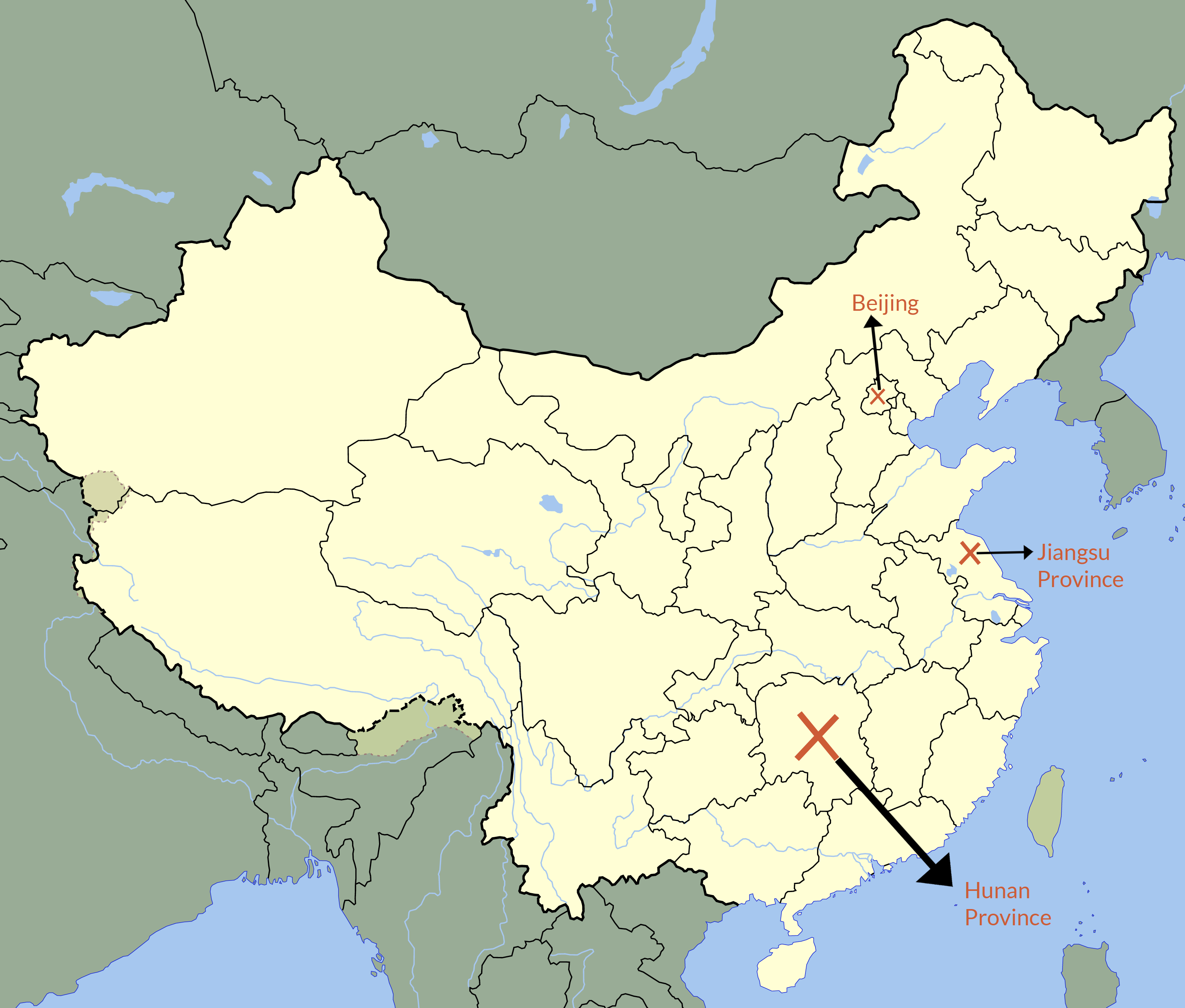

How an Environmental Group Is Trying to Clean Up China’s Pollution Problem
By Fred de Sam LazaroDecember 2015
Zou Yi, a resident of Beijing, has taken more than 1,000 images of the city’s sky since 2013.
Zou Yi takes two photos of the sky each day, posting them to Weibo (Chinese social media similar to Twitter) with information on air quality from China’s Institute of Public and Environmental Affairs (IPE), an organization founded by Chinese environmental activist Ma Jun. IPE uses open data to engage public and private partners in the fighting against factory pollution.
In this PBS NewsHour video, journalist Fred de Sam Lazaro speaks with Zou Yi, whose work has inspired other residents of China to document the country’s air quality.
[Video courtesy of PBS NewsHour. Broadcast on December 08, 2015. Copyright of NewsHour Productions LLC.]

China’s environmental crisis extends beyond the quality of soil and water.
This map, produced by the Beijing-based Institute of Public and Environmental Affairs, aggregates thousands of data points to produce a comprehensive look into the multitude of challenges the country faces today.
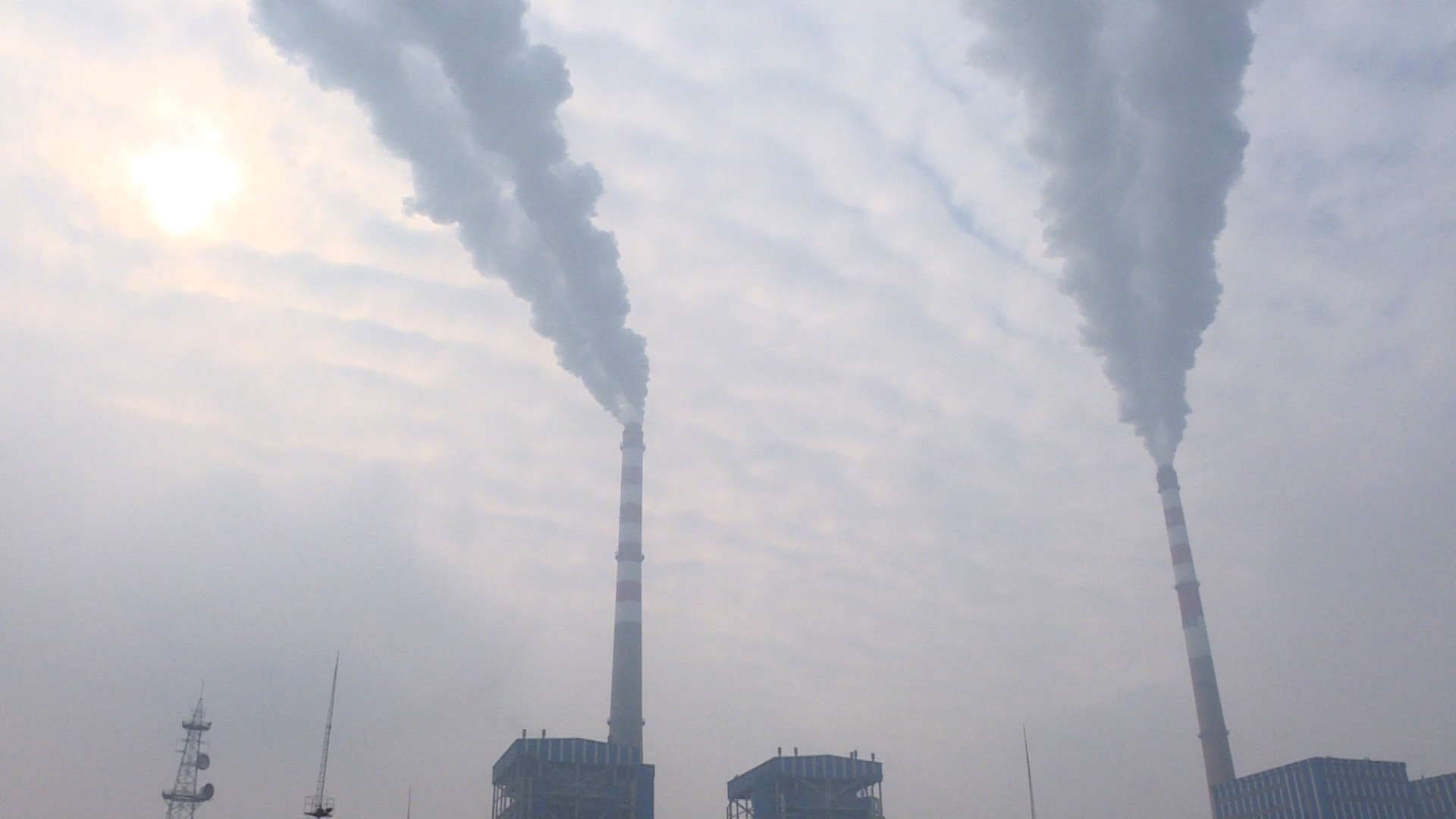

Chapter 3: India’s Contaminated Water and Poisoned Landscape
With the Green Revolution of the 1960s, new technology has made it possible for India to dramatically increase its agricultural productivity of rice, wheat, and other grains. Yet, as the stories in this chapter will show, the use of pesticides during the Green Revolution has proved detrimental to the health of farmers and workers, their families, and especially children.
Tanneries and textile factories release chemicals into water destroying the ecology of rivers and lakes, including the Ganges. Developed countries also transport their e-waste to India. As a result, children and adults now carry so many poisonous chemicals in their bodies that the villages where they live have become known as “cancer villages.”
Sean Gallagher, a British photographer and filmmaker, has been based in Asia for more than a decade. In this hard-hitting investigation, he explores the prevalence of pollutants in the state of Punjab and the cities of Kanpur and Kolkata, while revealing the personal stories of those who suffer the consequences.
-I.S.

Choke Point in Kolkata
By Sean GallagherDecember 2013
“I am concerned about pollution. Lots of people are getting cancer and diseases,” says Dulal Chandigiri, as he scrubs a bicycle tire outside his small workshop in the Tiljala area of central Kolkata.
He is squatting down next to the small lake which sits just a meter or two from the front door of a small shack made of corrugated iron that has been his home for the past 42 years.
“When I came here it was all paddy fields. It was 90 percent village and 10 percent city then. The population is increasing. The main problem is that lots of trees are being cut down and houses are being built up.”
Kolkata is home to Dulal and some 14 million other people who reside in a sprawling metropolitan zone which spreads out from the banks of the Hooghly River, the last arm of the Ganges.
One of India’s major urban hubs, the city sits on the edge of the Bay of Bengal and has attracted millions of migrants since India gained independence from Great Britain in 1947.
Today, the city appears to be at bursting point. At every crossing, traffic chokes the streets. People battle for space on the busy sidewalks and barges criss-cross the Ganges, packed with workers commuting across the great waterway.
Among the bustle however, environmental threats linger silently in the air, water and soil.
“Air quality. That is a problem for us. The suspended particulate matter in particular. So much particulates and dust particles,” says Professor Binay K. Dutta, chairman of the West Bengal Pollution Control Board, as he sits in his cool air-conditioned office in the center of the city.
“During the winter months, sometimes it goes above the permissible limits. So that is a problem and much of it comes from motorcycle exhaust. Seventy to 80 percent of particulates come from automobile exhausts,” he explains.
Walking the streets of Kolkata on an early morning in late November, the golden sunrise struggles to burn through the layer of smog that sits on top of the city. Cars, motorbikes and tuk-tuks cram the streets. As the city’s rush hour comes into full force, every inch of road is fought over.
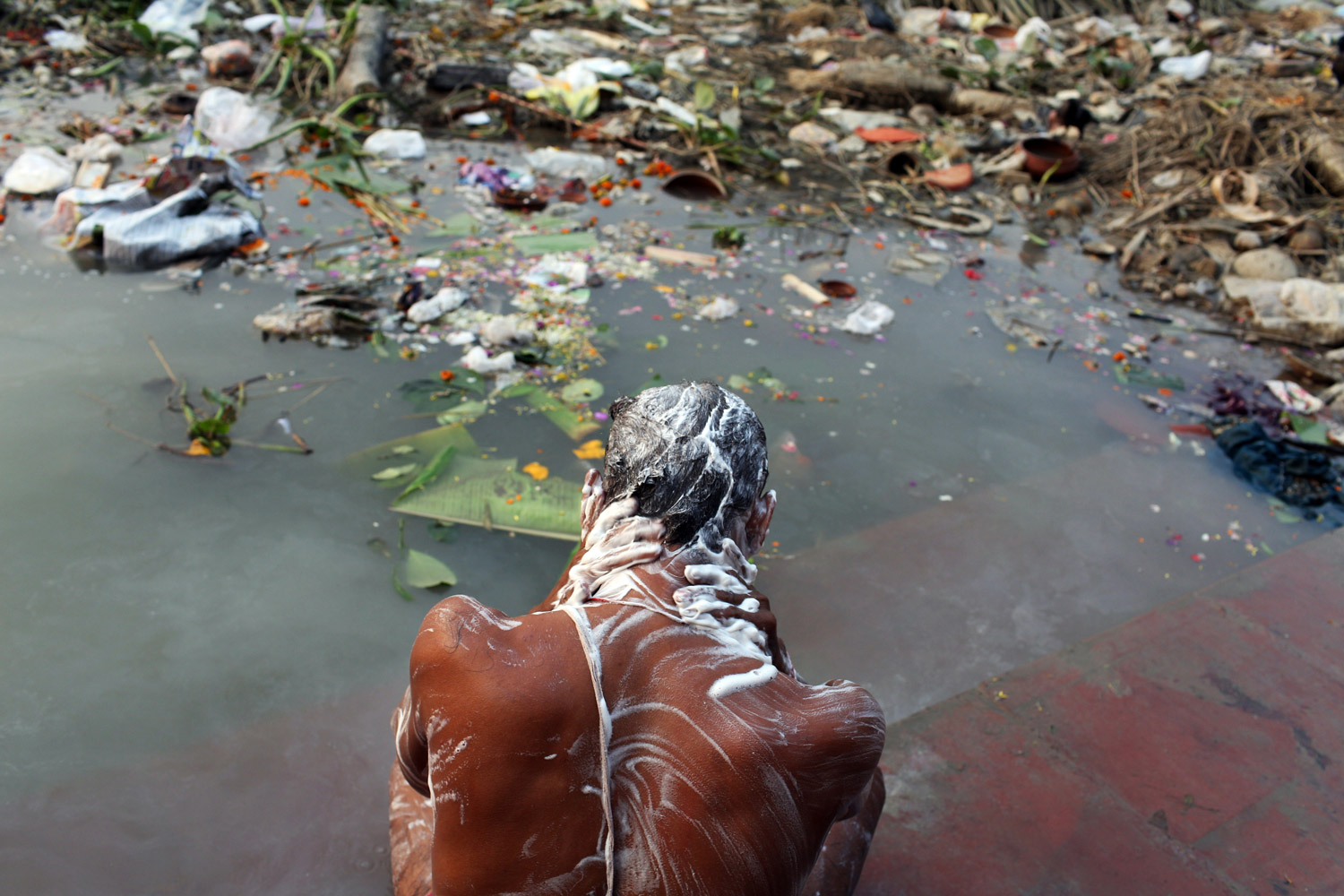
The scourge of air pollution is a problem facing many developing nations in Asia, especially those seeing a dramatic rise in the use of vehicles on the streets.
The Delhi-based Center for Science and Environment states in their 2012 report Air Quality and Mobility in Kolkata that “18 out of every 100,000 persons in Kolkata fall victim to lung cancer annually. Seven out of 10 people in Kolkata are afflicted with some form of respiratory ailment. Also the percentage of children suffering from upper respiratory infections, cough, wheezing and eye irritation is increasing in direct proportion to the increasing concentration of PM10 [particle pollution].”
It’s not just the air which threatens the people of Kolkata. The water supply is also coming under increasing pressure as the city struggles to cope with severe pollution that originates both within the city and outside of the state.“We have some problems with river water quality because the huge river Ganga, which flows through the heart of the city, receives a lot of contaminants from upstream,” explains Dutta. “It passes through quite a few other states. There are some points where the wastewater is discharged into the river and not always the wastewater is up to the mark.”For many Kolkatans, the problem of water pollution is all too real, particularly so to the east, where the city’s many waterways flow.“In daily life, we don’t use water from the canal,” says Shaiful, a 25-year old fishery owner. He’s standing near a sluice gate on the Bhangar Canal on the eastern outskirts of Kolkata. Flowing off of the nearby Vidyadhari River, the canal receives water mostly from nearby tanneries which process leather. At various points along the canal, toxic wastewater from the tanneries is released into the nearby waterway. At the sluice gate by which Shaiful is standing, the chemical-laced water is churned up and turns to foam. “We don’t use it because it’s black in color and smells. My fishery is on the other side of the Vidyadhari and I use the water from the river. The canal water finds its way and seeps in though.”
Close by, in the rural district of Dhapa on the edge of the city, lies a small hill. At least at first glance, it appears to be a hill. As one approaches, flocks of crows can be seen circling and thick dense smoke rises from fires dotted across its summit. Small figures can also be seen, scurrying across a haphazard surface.
This is the Dhapa landfill, the destination for much of the city’s solid waste over the past 30 years. It now stands at around 10 stories in height and covers and area of approximately 10 hectares.
Like many cities across India, a growing population is bringing with it a growing problem of domestic waste.
“The disposal site has served the City of Kolkata as an uncontrolled dumping ground since 1981,” states SCS Engineers, specialists in environmental engineering contracts and consulting, in their report for the Kolkata Municipal Corporation.
“Based on site volume and waste density estimates, the site is estimated to have received approximately 7 million metric tonnes (Mg) of municipal solid waste [as of 2009]. Based on 2009 disposal rates (3,500 Mg per day) and an assumed growth rate of two percent, the site will be full by late 2012.”
In November 2013, the site is still clearly in use. Trucks stream through the entrance gate, piled high with domestic waste from around the city. Workers stand on the precipitous edge of the mountain of garbage, throwing various items off to their fellow workers below who sift through and segregate various items that can be recycled and sold.
It is estimated that only 10 percent of Kolkata’s waste is recycled, contributing to the growing problem of the municipality’s waste disposal, just a few miles from the city’s downtown area.
Greater still are the implications for the Kolkata wetlands, a site meters away identified by the Ramsar Convention on Wetlands for its importance and significance.
According to the Times of India, “Since there is no practice of waste segregation at source, toxic metals like zinc, nickel, lead and arsenic get dumped in Dhapa and leach into the soil. Waste water in the canal around Dhapa shows that concentrations of total dissolved solids, biological oxygen demand and concentrations of zinc and carbon are high.”
Walking along the edges of Kolkata’s garbage mountain gives the impression of a city slowly being choked.
Air, water and soil come under fire of Kolkata’s rapid growth.
[This story was published by the Pulitzer Center on December 14, 2013.]

The Price of Leather
By Sean Gallagher.February 2014
“The bubbles which you see are contaminated with chromium, and it is very poisonous.”
Standing next to a field of wilted crops near his small village of Payundee, Sonalal Yadav carefully hops over a drainage canal, which is overflowing with white foam.
An acrid stench fills the air as the water below is churned up and funneled through the small channels onto nearby farmland. On its way, vegetation that hangs in the water is beginning to turn a dark brown color, and some plants are completely black.
“This water that you see comes from the tanneries. It goes to the treatment plant and then from the canal, it comes to the fields,” explained Yadev, president of the area’s local farmers community. “We were called the ‘Kings of Roses.’ Now, they have totally vanished. Here vegetables have also gone very bad. The vegetables have all become poisonous.”
These tainted fields lie on the outskirts of Kanpur, a small city of some 2.5 million inhabitants, residing on the banks of India’s holiest river, the Ganges. Along these banks, an ecological and health crisis has slowly developed, now engulfing a city that has gained notoriety in recent decades for the rise of its most successful export: leather.
Kanpur is home to more than 300 tanneries, which treat various animal hides and skins, manufacturing them into a wide array of leather products including shoes, clothes, belts and bags.
The city’s industry is so successful that it has recently become the country’s leading leather exporter, with more than 90 percent of its products destined for markets in Europe and the United States.Many of the city’s tanneries, small, medium and large-scale, are located in the area of Jajmau, a predominantly Muslim area just a few kilometers east of the city center. The neighborhood teems with life, and tannery workers and residents mingle in the streets. Just before sunset seems to be the busiest time, with residents crossing the narrow dusty streets, dodging trucks filled with hides and leather products.
Saida, one of the tannery workers, lives on the edge of Jajmau, near the Ganges River, which runs just meters away from her door. From her small, one-room home, she peeks out from behind a colorful curtain at her door, temporarily revealing a glimpse of her face, a dappled mix of brown and white skin.
“Most of the tannery water is dumped, and it has very strong chemicals,” Saida explained. “That is the water that we drink. Because it is such a bad environment, this is why all the diseases are here.”
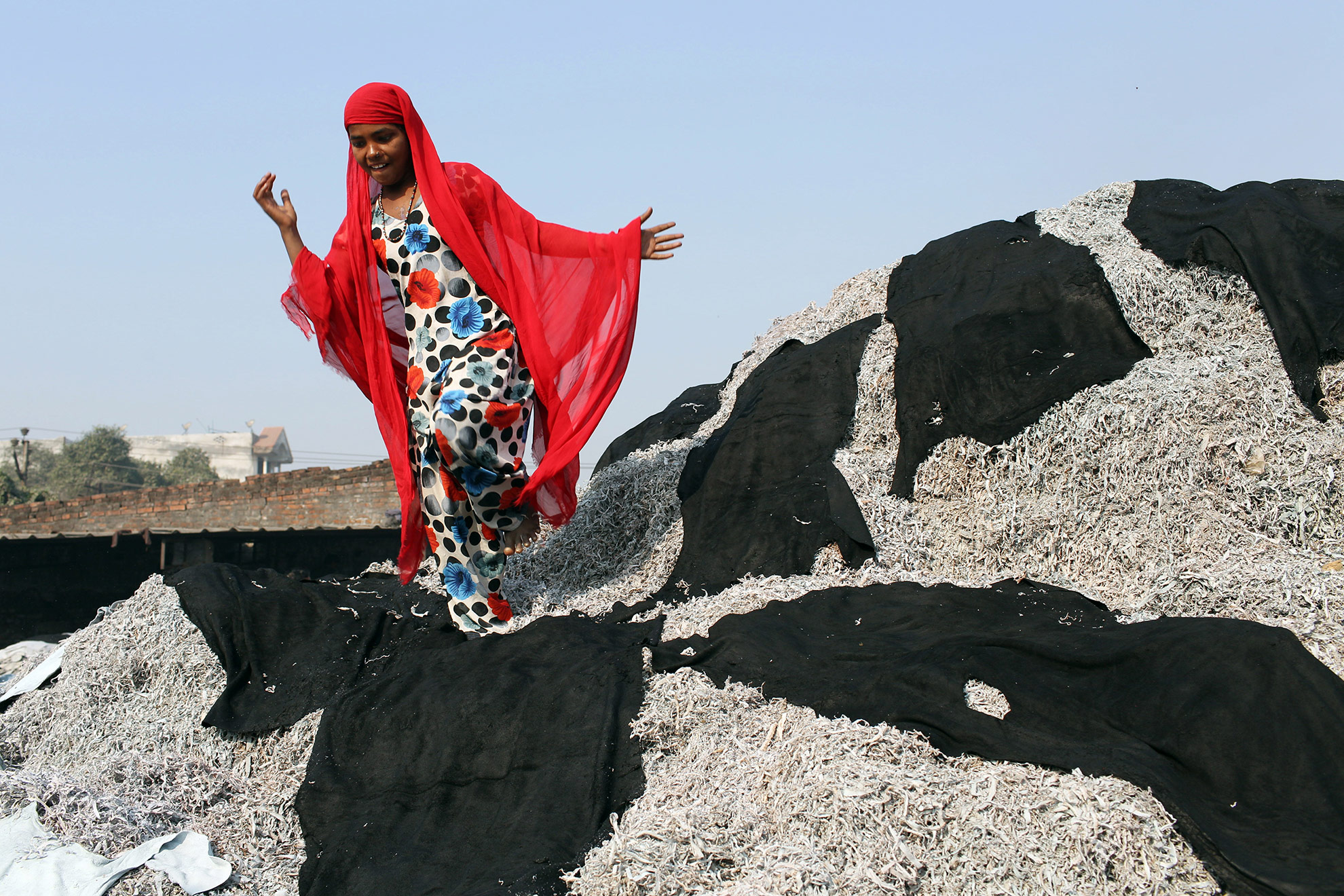
She is one of many workers and locals who suffer from a serious skin condition that has turned her brown skin white. It’s a condition that is believed to have been brought about by having contact with the toxic waste water from local tanneries. She is not alone in her affliction. In her small community, there are people with similar skin conditions, former workers suffering from tuberculosis, residents suffering from blindness, gastrointestinal issues and children born with severe mental and physical disabilities.
In 2008, a study by scientists at the Indian Institute of Toxicology Research found that tannery workers had double the risk of morbidity when compared to control groups. The main findings suggested that increased exposure to leather dust, which contains high levels of chromium, was responsible for the significantly higher rates of morbidity. Carcinogenic compounds and a variety of highly toxic chemicals were found in the tanning process.
Separate studies have also revealed high levels of chromium in local soil and water, which is evidence that this dangerous chemical—in its industrial form—enters and accumulates in the food chain.
“We did a study with the Blacksmith Institute, in collaboration with the central pollution control board. We found that the groundwater was very severely contaminated from Chromium (VI),” said Satish Sinha, associate director at the Delhi-based NGO, Toxics Link.
“It is a sign that tells us that the groundwater contamination is there because of the Chromium (VI), and people are drinking that water, which is very, very serious,” Sinha explained. “Chromium can be highly toxic to humans.”
As the tanneries’ chimneys belch out dark smoke into the air above Jajmau, small drainage channels line the streets, carrying liquids of myriad colors, from light blue to jet black, untreated effluent which has escaped from the tanneries. Laced with highly toxic chemicals, it passes through many communities on its way to the Ganges River just a little further downstream.
Following the official waste water channels out of town and away from the tanneries, it makes its way to a common effluent treatment plant on the outskirts of the city. Designed to process the highly toxic water, it receives upwards of 40 million liters per day. Its failings have been a source of despair for locals, and it’s estimated that only 20 percent of the water received from tanneries is properly treated.
“The common effluent treatment plant doesn’t work and doesn’t function for various reasons,” said Toxics Link’s Sinha. “Either the plant is down or [there’s] a sudden malfunction. There is no electricity, or it is running below capacity. So there are multiple reasons why a plant doesn’t work perfectly, and so all the water is being discharged into the agricultural land, and all the farmers are using this for agricultural purposes.”
Back in the fields, Yadav was exasperated. “They said that this water would be treated in such a way that you would find big fish surviving in it,” he said. “But now you can see the bubbles in this water. Even the grass vanishes!”
For many of Yadav’s fellow villagers, they have no choice but to use the water and allow it to enter their fields. The environmental and health effects have been nothing short of catastrophic for these helpless villagers, who have to wade through the water to irrigate their fields and watch helplessly as the toxins accumulate in their fields, soil and ultimately their bodies.
“What can I say about the health effects? We are getting ill. Sometimes we have bad legs and skin rashes. That is a problem with the water. Always feeling ill. There are also many diseases,” explained Shivlal Nishad, a fellow farmer who stares out across his field which is being irrigated with foam-laced water. “What should I say about the crops? You see the small plants. If the water is full, the small plants don’t survive. They don’t get bigger. Day by day, they vanish.”
Just a few hundred meters away from Nishad’s field, black smoke emerges above the tree-line. It emanates from the nearby chromium waste fields, which process much of the tannery waste. Burning discarded leather trimmings produces highly poisonous smoke that filters through the air, wafting towards his village. The trimmings, once dried, are ultimately used for fertilizer and even chicken feed. Still laced with chromium and other chemicals from the tanning process, this smoke acts as another vector by which toxins are entering the food chain.
“What to say? Why they are not helping? Nobody is helping us. Not the government, not even the politicians. So many politicians, but nobody is listening,” laments Nishad, as he wades deeper into the water which has now engulfed his field.
Excess water that escapes the fields runs downhill and eventually finds its way into the most important waterway that connects both the urban and rural communities, the Ganges. Even India’s holiest river is not immune to the severe levels of pollution in the city.
“We are making the Ganges water black,” said Arun Puree Chaitnya, or Baba Gee, as he is known to his devout followers at his ashram on the banks of the Ganges River. “In Jajmau, Kanpur, due to the leather industry, the Ganga is mostly polluted. From the Himalayas to the Bay of Bengal, the most damaged part of the Ganges water is in Kanpur. My heart cries when I see the pollution, but the problem is that the government sitting in power doesn’t want to do anything.”
Baba Gee, a Hindu holy man, has been involved in environmental awareness campaigns since his teenage years, encouraging local people to come together to protect the country’s most important waterway. It’s a message that is proving difficult to get through to those in higher levels, however. Baba Gee explains:
“We have said to the government, ‘Please seriously work for the benefit of the Ganges.’ The government has many schemes, but on the ground level, it is fruitless.”
In Delhi, Chandra Bhushan, deputy director general of the Center for Science and Environment, believes one of the main problems lies with the government’s tradeoff between employment and the environment. “The Indian government and the supreme court of India have also looked at the issue of Kanpur tanneries,” he said. “Have they improved in Kanpur? A little bit, in 20 years. Now you have a few big companies that are doing better than they were doing before, but the major problem of tannery pollution comes from small and medium-scale industries.”
The jobs provided by these businesses make it difficult to regulate them, Bhushan said. “These are small to medium-scale companies generating a lot of employment, [with] a lot of political support for them, and it has been difficult to close down these industries,” he explained. “Some of them even operate illegally in those areas. So it has been a difficult issue for India. Nevertheless, I think it’s high time: We will now have to take concrete actions—either we need to upgrade those industries now, put in money from the central purse and upgrade those industries, or ask them to shut down.”
With increasing demand from the West and rising affluence in the East, the leather industry shows little sign of slowing down. The future of Kanpur’s most vulnerable residents and the state of the local Ganges ecology seems perilous.
What will happen if nothing changes in Kanpur? “I think it will be asking for disaster. The time bomb is ticking,” Sinha said. “The moment we get a sense of the data, then we will realize it is too late. The cost of it is going to be very, very expensive. It’s going to be very costly for the state and for the health concerns that people have. It is going to be phenomenal. And I don’t think you can put the clock back after that.”
[This story was published by the Pulitzer Center on February 4, 2014.]

The Poisoning of Punjab
By Sean GallagherSeptember 2014
A young child doing stretching exercises as part of therapeutic treatment at the Baba Farid Center for Special Children in Faridkot, Punjab. Many children are now born with physical and mental disabilities. Image by Sean Gallagher. India, 2013.
“We can say that Punjab is dying now. There is no doubt. Punjab is the food basket [of India]. Now we can say it is the disease basket.”
Dr. Pritpal Singh sits in his simple office in the Baba Farid Center for Special Children, located in the small town of Faridkot, in India’s Punjab region.
Since 2003, Dr. Singh has been here, working with fellow health professionals at the center, offering therapeutic treatment to a growing number of young children from local areas born with health and mental disabilities.
“We are providing occupational therapy, speech therapy, yoga, and naturopathy. Every type of therapy. We are also visiting villages, checking them free of cost, and training the parents how to deal with these kids,” continues Dr. Singh, who set up the center in response to growing concerns about the severity of illnesses that he was witnessing in his community, especially those affecting children.
A surge in the number of children brought to the center hints at an alarming trend.
Bordering Pakistan in the far northwest of India, Punjab has become the country’s most important agricultural region. The Green Revolution of the 1960s saw great technological advancements and modern farming practices expand, allowing Punjab to become the nation’s leader in production of commodities like rice, wheat, and varied general produce.
Booming production saw India rise to become the world’s second largest producer and exporter of cotton, two thirds of which is grown in the Punjab region.
These 50 years of increased productivity, however, are thought to have been fueled by the excessive use of fertilizers, pesticides, and insecticides. The presumed result is of a slow accumulation of toxins within the water, soil, food—and ultimately, people—of the region.
The children are dying
“They are 4 1/2 years old. When they were born they were fine. After two days they fell sick. They used to get regular fits and their bodies changed to a blue color,” says Rajbir Singh, as he struggles to control the child wriggling in his arms. “Of course, for this we had lots of problems and worries. Two children and both of them are sick.”
Sitting in a courtyard at the Baba Farid Center, he and his wife have brought their two sons—twins—who each suffer a number of both health and mental problems. Each day they travel from their nearby village for treatment at the center.
“I worry a lot about this son,” Mantrit Kaur says as she wipes away a steady stream of tears from her face, thinking about the future of her two boys. With one appearing to be responding to treatment better than the other, worries continue for the one who isn’t responding as well.
“Since coming here I can see that it’s not just my son, there are many sons,” she continues. “He will be okay here. He is 4 1/2 years old. He doesn’t understand anything. He cannot listen to commands. As long as I am here there is no problem, but if I’m not here, who will take care of him?”
In 2009, a Greenpeace report carried out by scientists from the University of Exeter in the UK found that water from local wells in Faridkot carried dangerously high levels of nitrates, a by-product of synthetic nitrate fertilizers present in the surrounding agricultural land.
According to the report, “20 percent of all sampled wells have nitrate levels above the safety limit of 50 mg of nitrate per liter for drinking water, established by the World Health Organization (WHO).” It further noted that “nitrate pollution in drinking water can have serious health impact on humans, especially for babies and children. The most significant potential health effects of drinking water contaminated with nitrate are the blue-baby syndrome (methemoglobinemia) and cancer.”
In a 2010 study entitled “Metal exposure in the physically and mentally challenged children of Punjab, India,” scientists from the Micro Trace Minerals Laboratory in Germany found elevated levels of heavy metals in local children.
Collecting 149 hair samples from children at the Baba Farid Center, they examined toxic metal concentrations and found that the hair of the children contained dangerously high amounts of barium, cadmium, manganese, lead, and uranium—signifying long-term exposure.
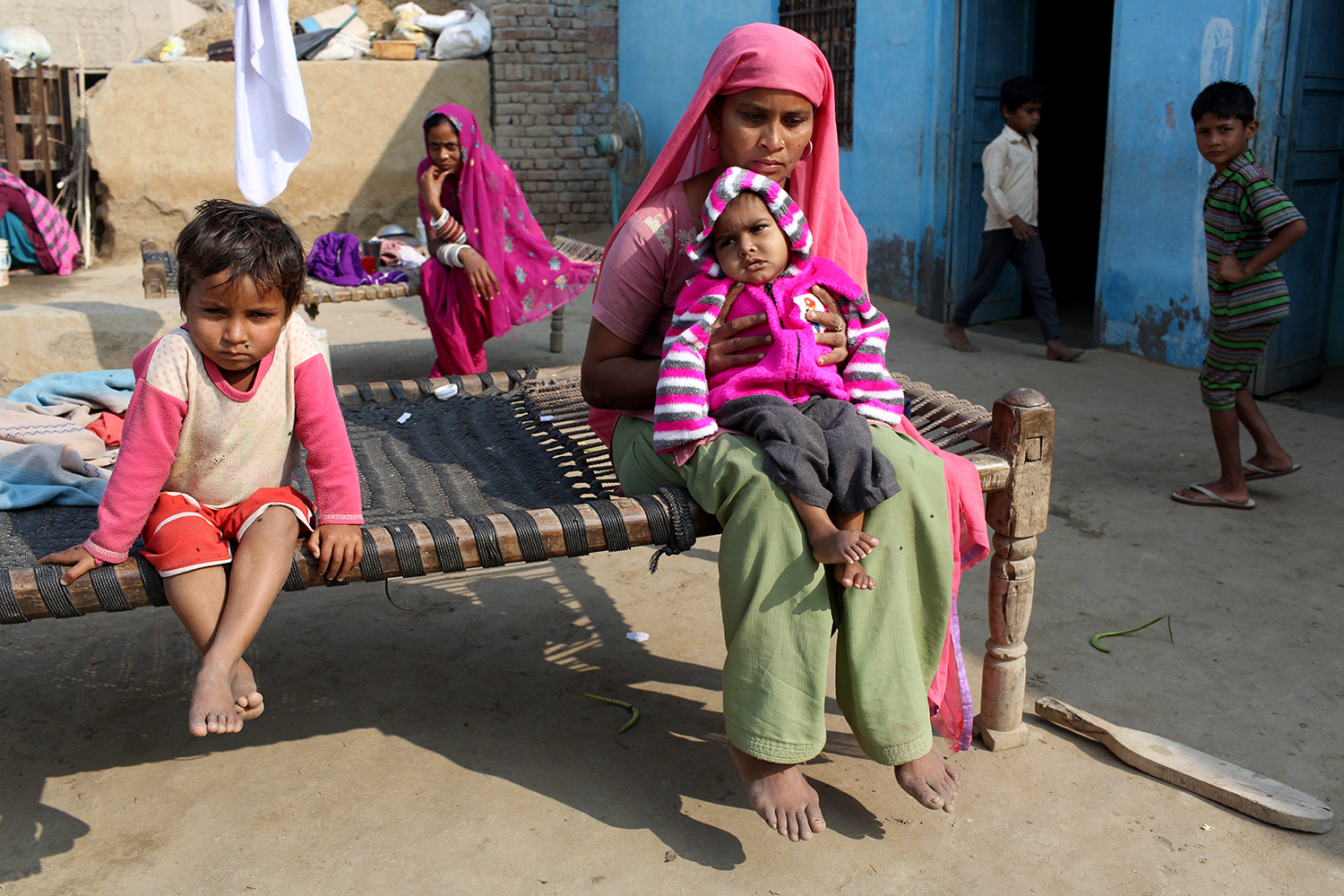
Cancer villages
“They are drinking very polluted water. We can say it is a toxic cocktail in our food chain,” explains Dr. Singh as he cradles yet another child at his center.
“We have polluted the environment. Since the Green Revolution we have used lots of fertilizers, pesticides, and insecticides and that’s why our soil, water, and air has been totally polluted,” he says.
Outside of Faridkot, it does not take long to reach the nearby countryside. Surrounding the collected villages is the heart of the country’s bread basket, an endless expanse of fields broken only by the odd dirt track, or small road, upon which tractors chug or bicycles meander.
“Many of the villages have cancer patients but nobody talks about it,” he says.
Jarnil Singh sits in a small courtyard at the center of his home in the small village of Jajal, a small community of some 3,000 people near Faridkot.
It’s a typical village in the region: single-story homes connected by dusty tracks that lead only to other villages. Everywhere you look are the ubiquitous green fields.
A retired school teacher, he has watched for decades as illness, notably cancer, has spread through his community, taking the lives of local farmers and slowly tearing families apart.
“Fifty-five people have died of cancer in the past 11 years. Many children have been born disabled and died.”
“It started from 1995, due to the cotton belt. The American boll worm was the problem. In three months they were spraying every three days. The recommended amount is three to four times in three months. The pesticide companies recommended we use more. We were using these without hand gloves or masks. Health problems started from 1997-98. People started to get many types of cancer.”
This excessive pesticide use continued in the community until 2004 when a new type of cotton, “Bt Cotton,” was introduced. A genetically modified strain, it naturally produces chemicals which harm and kill attacking pests.
“After 2004, we got Bt cotton which was better. On this crop there was no worm,” continues Mr. Singh. “Bt Cotton was good but the fertility of the land was gone. From 2004-2007, we used less [pesticides] but the productivity went down so use went up again to seven to eight times per three months. That’s been the same ever since.”
The sustained overuse of pesticides, insecticides, and fertilizers in this one village is not an isolated practice —it’s visible across the region. Economic reality has dictated the behavior of residents for decades now. Productivity before health. With little to no advice from local government about safe usage practices, overuse is rampant and potential health implications ignored.
Official statistics on the rates of cancers in the region are almost impossible to come by, but the local population note an increased frequency of cancer diagnosis and a proliferation of “cancer villages,” frightening people within the region.
“Punjab is now becoming a hotspot of cancer cases in India,” says Chandra Bhushan, deputy director general of the Center for Science and Environment in Delhi. “There are a lot of studies which now link cancer in Punjab to the use of pesticides. Punjab is one of the largest users of pesticides in India. In fact, on a per acre basis it is the largest user of pesticides.”
“In 2005, we did a study. We checked the blood samples of the people of Punjab and we found multiple pesticides in their blood,” explains Bhushan. “Now, after these tests we couldn’t say that these pesticides were causing cancer [but] what we essentially said was that we are finding large amounts of these chemicals in the bodies of people. It cannot be allowed. We cannot allow chemicals to trespass our body. Therefore, India needs a chemical trespass law—a law that says we are not going to allow chemicals into our body and accumulate [where] they might cause numerous diseases in the future.”
A poisoned landscape
About 75 km southwest from the town of Faridkot lies the India-Pakistan border.
From the village of Teejaruhela, residents gaze through a wire fence separating the two nations.
“Today we are here because for the past four years we have surveyed this village. We took some samples and detected that heavy metal poisoning is too much [here],” explains Dr. Pritpal Singh during a routine health check of the local residents.
“Every house has a child with problems,” he explains. “In this village there are only 2,200 people. We surveyed 150 houses and there are 62 kids with mental disabilities and cerebral palsy.”
Disabled children reside in nearly every home. They lie on basic wooden beds, smiling and squirming as dictated by their illness.
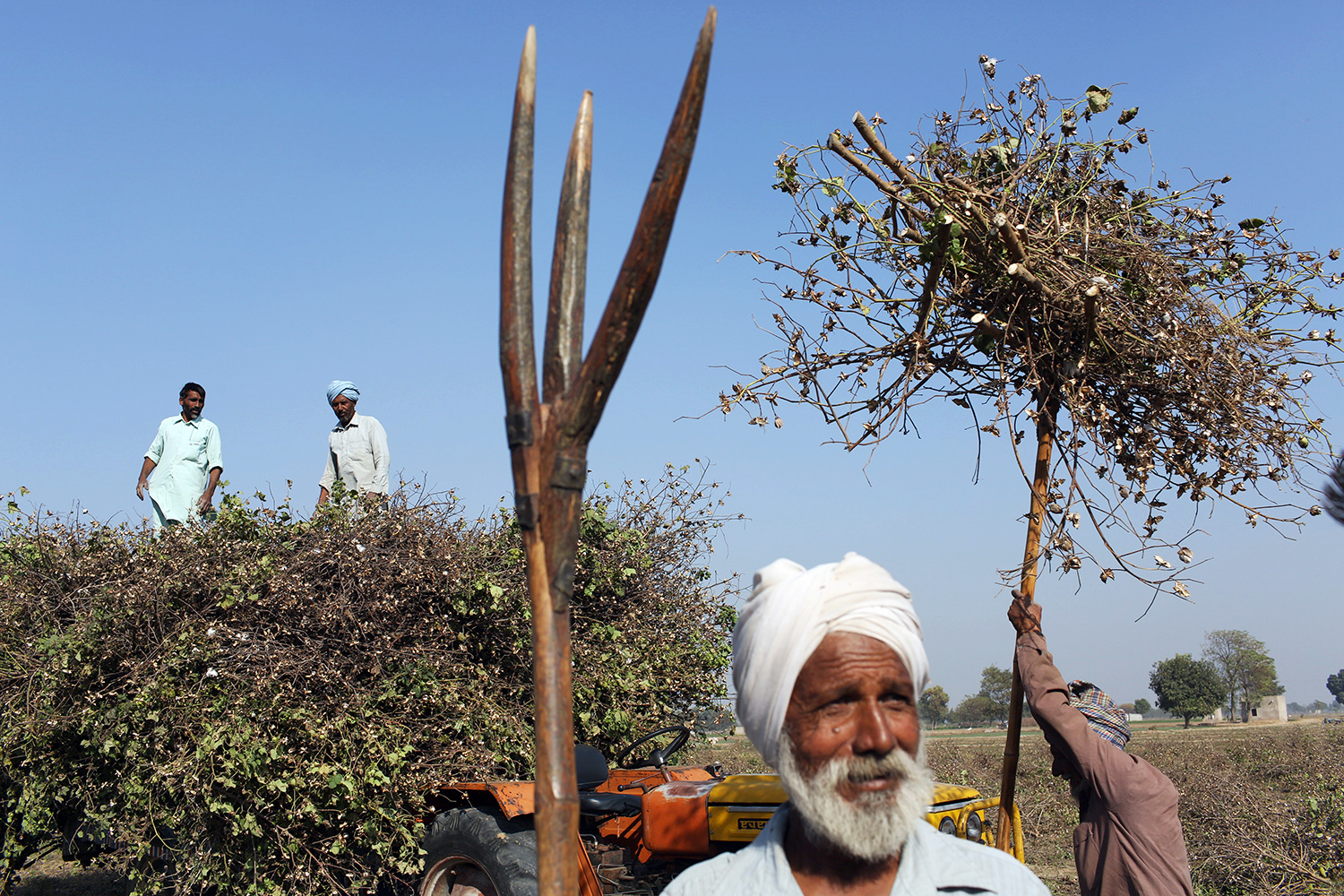
The doctor approaches Gurucharan Singh, a boy who spends his days curled upon a simple wooden bed that rests outside his parent’s home, in the sun.
“He is suffering from cerebral palsy,” explains Dr. Singh. “He is 15 years old and he cannot speak. This is not only in this house. In every house we have kids like this.”
In the green fields that surround the villages, only the rustle of the grass is heard as wind blows through the countryside. Sparrows, owls, and even eagles have long since vanished. A polluted ecosystem has left the village silent, this mirrored by the people of Punjab who themselves are seldom heard.
“The government has cut us off. We are getting no help,” says one as the villagers gather around Dr. Singh, who now prepares to leave the village.
“We don’t need the government!” cries another. “We just don’t want the polluted water. Our land is poisoned.”
[This article was published by the Pulitzer Center on September 2, 2014.]



India’s Informal E-Waste Recyclers at Risk
By Sean GallagherApril 2014
In the Indian village of Sangrampur, located 30 miles south of Kolkata, the sound of frogs croaking in a nearby pond clash with the noises of hammering and plastics cracking.
As developed countries dump their e-waste in India, an informal industry of recyclers has emerged. In places such as Sangrampur, it’s common to find women, young men, and children picking away at piles of electronics, breaking them down into increasingly smaller pieces that are then separated and collected.
But as the villagers spend their days dismantling by hand devices that contain toxic materials, there’s a growing concern about the long-term health effects on the workers.
“I think in another 10 years we will see the health problems actually coming to the front,” said Priti Mahesh, a senior program coordinator for Toxics Link, an organization that focuses on toxic waste issues in India. She said the amount of waste is only going to increase, and that now “is the right time to put a stop to it.”
[This photo gallery originally appeared on Bloomberg Businessweek on April 18, 2014.]

Old computers, defunct kitchen appliances, and obsolete gadgets all contribute to the rapid accumulation of e-waste across the globe.
The StEP Initiative, an organization aptly named for its mission of “solving the e-waste problem,” has produced a map that tracks detailed e-waste data, country by country.
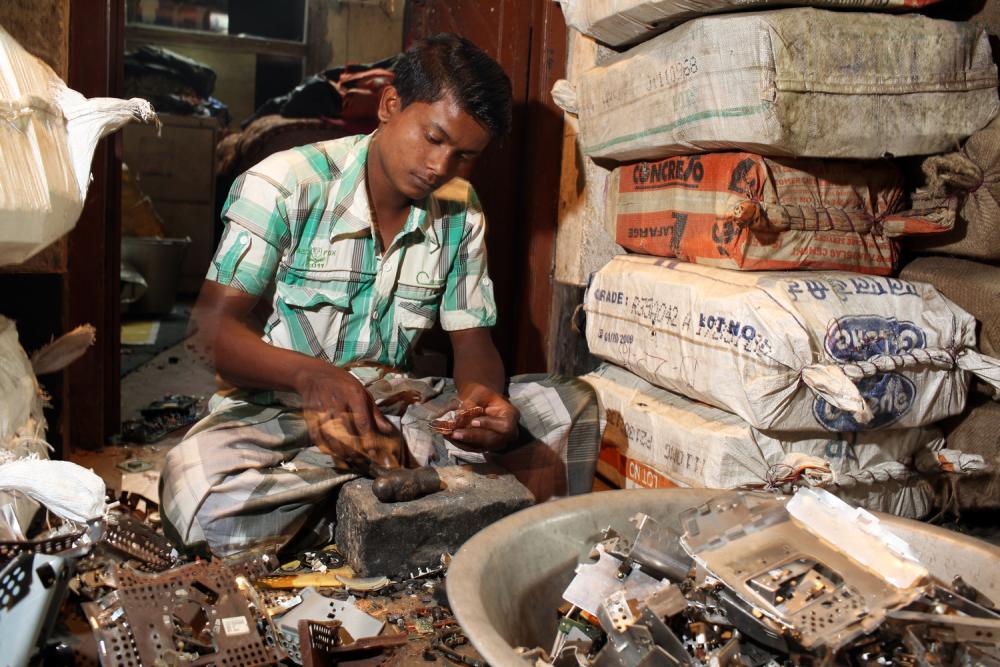

Chapter 4: Fire and Smoke
Across the world, 2.5 billion people rely on fire to cook their meals everyday. For a country like the Dominican Republic—where in 2015, more than 32 percent of the population were living under the nation’s poverty line and rolling black-outs continued to be a near-daily occurrence—the cost of gas and wood for those fires presents a financial burden for many families.
The use of solid fuels like wood, coal, charcoal, and dung also present health complications. They are “silent killers” that put mostly women and children at risk, according to the Global Alliance for Clean Cookstoves. The World Health Organization reports that this type of pollution is the fourth biggest health risk in developing countries—after heart disease, stroke, and chronic obstructive pulmonary disease.
Two stories by Makenzie Huber explore the growing trend of using solar ovens in the Dominican Republic. Her reporting details the efforts of Solar Oven Partners, a U.S.-based non-profit, and the positive impact this healthier, more cost-effective cooking method is having on the Caribbean country.
Using solar ovens allows families to spend less on propane gas and more on healthier food and education.
Can improved cookstoves save lives? Photojournalist Nathalie Bertrams and Ingrid Gercama, a journalist and anthropologist, take us to Malawi where they report on the “deadly smoke, soot, and flames” that result from the use of cookstoves. They focus on the development of stoves that claim to be both environment-friendly and more efficient.
Michelle Nijhuis and Lynn Johnson report on the development of safer cookstoves in Guatemala for National Geographic. Although newer woodburning stoves have been shown to improve household air quality and reduce frequency of childhood illnesses, the air quality is still far from optimal. Some health care workers are now promoting three-burner gas stoves—the challenge is to make this alternative appealing.
-L.A.

How Solar Ovens Are Changing Lives in the Dominican Republic
By Makenzie HuberAugust 2016
VILLA LIBERACIÓN, Dominican Republic—“The rice is done!” someone proclaimed from the chapel courtyard.
A second later, another person yelled the same phrase in Spanish.
That’s when everyone came running.
Women jumped out of their plastic chairs in the shade. Children sprinted from across the courtyard to be the first to see the pot of rice taken out of a solar oven.
They crowded around the oven where the rice had cooked while sitting in the sun for a few hours. The demonstration was part of a solar oven workshop at the Iglesia Evangelica Dominicana (IED) chapel here.
Reyna Esthel was one of the women vying to taste the rice. She attended the workshop after she heard that using a solar oven could help save her money.
“Because of the expenses of gas, it’s cheaper to use the solar ovens—using natural energy from the sun,” Esthel said in Spanish through a translator.
A small number of communities in the Dominican Republic are buying solar ovens to cook their meals, avoiding cooking with gas stoves or wood that present both financial and health problems.
More than 32 percent of people in the Dominican Republic were living under the national poverty line, according to a 2015 national labor force survey. Petroleum and products made from it, such as propane, are a top import to the island nation, and propane accounted for about $3.72 million in imports in 2014, the United Nations reports. Purchasing gas for cooking takes a toll on most families in the country because of their limited incomes. Families who are even further into poverty use wood as a cheaper cooking material. Inhaling the smoke or standing over the fire can damage the lungs.
The solar movement was initiated by a U.S.-based nonprofit, Solar Oven Partners, which presented workshops on how to use the ovens like the one in Villa Liberación. Rick Jost, the organization’s director, hopes solar oven use will allow people in the Dominican Republic to save money to better their quality of life and reduce the risks of cooking with wood.

Families who use solar ovens increasingly save money by depending less on gas stoves.
The organization reported 200 to 250 solar ovens were sold in the Dominican Republic between August 2015 and July 2016. Each oven costs 1,000 pesos, or about $22. Although funding to build and transport the ovens comes entirely from donations in the United States, the purchase price goes toward running the workshops throughout the country.
After the workshop, Esthel bought one of those solar ovens. With the money she hopes to save, she wants to buy better-quality food for her family. But she does have a few concerns—such as working around cloudy or rainy weather and having to adjust her daily life to cooking with the new oven.
“We will have to wake up earlier,” she said. It takes two or three hours to bake a meal in a solar oven instead of about an hour on a gas stove.
Idalia Batista bought her solar oven about six months ago and starts preparing lunch by 8 a.m. She’s adjusted her schedule to cook for her family of eight, preparing rice, beans, corn, and occasionally meat in the oven.
While the food cooks, she does other chores around the house. She said she’s used the solar oven almost every day since she bought it.
“There never was a day when it was too cloudy,” she said in Spanish through a translator.

She’s already seen a difference in her budget. Before she bought the solar oven, she said, she would buy a 15-gallon tank of gas, costing her up to 1,600 pesos, or about $35, each month.
Now that she uses a solar oven, she only buys a nine-gallon tank of gas to prepare other food on her gas stove, saving up to 380 pesos, or about $8, each month. (Because she cooks for eight, her solar oven can only prepare a fraction of the food. She still uses her gas stove to prepare portions of each meal.) The change is significant, she said, and she spends the extra money on more food to feed her family.
Batista sees solar ovens as an opportunity for her community.
“Everybody loves the oven because…the sun is something they always have, and it’s there for them,” she said. There are about 35 solar ovens in her community of Jaquiemeyes.
Solar Oven Partners worked in Haiti for 14 years before starting in the Dominican Republic in 2015. The organization sold and distributed almost 10,000 ovens there.
“We don’t have any illusions of saving the world or even a society or country, but our philosophy is that if you help one family improve their situation by cooking, then you’ve done something important,” Jost said.

He wants to empower people to change their lives in small ways, affecting their societies in turn, by using solar ovens. The organization works through the IED church system to reach places in the Dominican Republic where the ovens are needed most.
The church gives the organization guidance and has the “ultimate control” over which communities get ovens, Jost said.
“As so often happens, even with international outreach programs, if you just go in and start doing for people what you think they need without any consideration of their culture, you’re not doing them any favors—you’re actually harming the situation,” Jost said.
Other organizations have been bringing solar ovens to Central America, other parts of the Caribbean, and Africa.
A team led by Molly Enz, a professor at South Dakota State University, conducted a three-year survey response to solar ovens in Haiti completed in 2014.
The survey of 900 people found that women are using their solar ovens half of the time when they prepare meals for their families. The money saved from purchasing other cooking materials goes toward more nutritious meals, medical care, and sending children to school.
Jost estimates the life of an oven is at least seven years based on the plastic materials used to make it. Replacement materials and repairs are available from the IED church headquarters in Santo Domingo when an oven is damaged.
Enrique Antonio Solel, a member of the church in Sabaneta de Yásica, compared the use of solar ovens in the Dominican Republic to men walking on the moon.
“The organization is introducing a new technology to the Dominican Republic that will create a new era,” Solel said in Spanish through a translator.
[Prices reflect 2016 exchange rates.]
[Courtesy of TakePart, LLC (c) 2016 TakePart, LLC. All rights reserved. Originally published on http://www.takepart.com/feature/2016/08/31/solar-ovens<http://www.takepart.com/feature/2016/08/31/solar-ovens]

Faith, Hope, and Solar Ovens Give Way to a New Future
By Makenzie HuberAugust 2016
Magaly Lantigua unlocked a door to the library inside her church.
A fan rotated on the ceiling of the room, providing a welcome relief from the hot Dominican sun. Earlier Lantigua had joked that she didn’t want to cook under the sun with a solar oven.
Lantigua is responsible for the Iglesia Evangelica Dominicana capilla in Villa Magante. She had been a leader in putting together the library, now filled with books for children in the community to learn how to read.
The mother of four takes pride in her church role, having recently graduated from high school herself. She uses her days off from work to study so she can attend a university in a neighboring community.
“For me it’s very important to pursue advanced studies and after I get a good job I can help other people in the community and my family,” Lantigua said in Spanish through a translator.
She hopes to become a nurse and maybe even a doctor. She’s been practicing basic skills in her community, but knows she’d serve a greater need with a degree.
Now Lantigua thinks a solar oven will help her get there. Solar ovens capture energy—or heat—from the sun and use it to cook food.
She said using a solar oven would save her 1,000 pesos ($22) a month. Right now she’s spending 10,000 pesos ($220) on food alone each month to feed her family.
The money she would save using a solar oven would go toward transportation to the university.
Working at the capilla separates Lantigua from the rest of her community already—she has a job. But like many of the women in Villa Magante, Lantigua loves to cook for her family.
She remembers starting to cook when she was 8 years old. Her mother taught her how to prepare the staples of a Dominican Republic diet—rice, beans and meat. The knowledge her mother passed on to her still serves her well as Lantigua prepares rice, beans and meat for family every day.
Like many other people in her community, she uses a gas stove to cook. She fills up her tank of gas multiple times a month, costing her about 1,000 pesos for a tank of gas. The price of gas fluctuates making it hard to measure how much the commodity will take out of her family’s monthly income. Most of the time, the price of gas goes up.
“We live by faith,” Lantigua said about preparing for inflated prices. Electric stoves are an option, if people can afford it.

Lantigua can’t, but said electricity in her community usually isn’t on anyway. Rolling black-outs across the country prevent the alternative cooking method.
Looking up at the fan in the room, I see that it has stopped. The rest of the fans in the capilla have stopped working as well. Lantigua didn’t know when they would come on again.
Lantigua spent the rest of the day building ovens and preparing food for a solar oven workshop at her capilla. She stayed until the end, helping people load the ovens they bought onto a bus.
Lantigua couldn’t afford a solar oven. It costs 1,000 pesos and she has to worry about caring for her family with the money she has now. She says she hopes to get one the next time a workshop comes to her church.
[This story was published by the Pulitzer Center on August 30, 2016.]

Illegal Logging in Malawi: Can Clean Cooking Stoves Save Its Forests?
By Nathalie Bertrams and Ingrid GercamaFebruary 2017
“This time, we have to be strong, or else we will lose the battle,” says Teresa Mvula, Lilongwe district forestry officer, discussing the latest deployment of the Malawi defense force into the region’s fragile forests.
For the past year, Malawi’s department of forestry has been cooperating with the army in a desperate bid to stem the illegal logging that is depleting the country’s forests at a rate of 2.8 percent per year.
Surging demand for charcoal in Malawi’s cities is the prime driver of deforestation here: around 54 percent of urban women now use this “black gold” for cooking, according to the government.
Only one in 10 Malawians are connected to the (unreliable) grid, while liquefied petroleum gas is out of reach even for many members of the emerging middle class. Charcoal, which burns more cleanly and quickly than firewood, is considered a sign of status.
Malawi has banned the production, transport, and sale of charcoal unless it is sustainably sourced. But the illegal trade is booming, serviced by rural residents who scrape a living turning timber into charcoal in a highly inefficient process which wastes enormous amounts of wood.
Estimated to be worth £45 million [approx. US$57.97 million] per year and to employ around 100,000 people, this shadow sector is Malawi’s third largest industry after tobacco and tea.
“We are destroying nature,” says Steven Kakhuni, chair of Mgona community charcoal market in Lilongwe, “but poverty is forcing us to continue.”
Under Malawi’s National Forestry Act, businesses are permitted to harvest trees if they then plant indigenous species to offset the loss. But in the 20 years since the law was passed, only one commercial license for sustainable charcoal production has been issued.
Kawandama Hills Plantations produces small amounts of charcoal as a byproduct of their essential oil business. But sales are low: It is hard to be successful when illegal competitors source raw materials for free.
A different business line may now offer a glimmer of hope for Malawi’s forests, however. So-called “improved cook stoves,” which burn charcoal or wood more efficiently than traditional cooking fires, are gaining popularity.
According to the National Cook Stove Steering Committee—a coordinating body for officials, NGOs, and other groups working on clean cook stoves in Malawi—500,000 “clean and efficient” cookstoves are now in use. It hopes 2 million Malawian homes, around 65 percent of all households, will adopt the device by 2020.
In villages across the country, women are being trained by NGOs like the UK’s United Purpose to make different types of energy efficient clay stoves, which they sell locally.
One beneficiary of such a project is Astina Nikina, a mother of six from Nessa village in Mulanje district, who recently bought an Aleva wood stove—a model made from clay bricks held together by an iron band—to replace her traditional three-stone fire. “A bundle of 40kg [of] firewood used to last only three days; now the same size bundle lasts two weeks,” she says.
New stoves for the city
In Lilongwe, Blantyre and other cities, a different gadget is getting people excited: a metal charcoal stove designed by U.S. social enterprise Envirofit. The organization says the model consumes up to 57 percent less fuel than a traditional charcoal stove, cooks food in half the time, and produces up to 70 percent fewer toxic emissions.
More importantly, it says the stove is more aspirational than traditional cooking equipment and better geared to consumer needs. One local retailer who has imported more than 4,000 of them confirms his stock is selling well.
Mass distribution of efficient stoves in Malawi’s cities could ultimately prove more potent than military force as a strategy for protecting its forests, says Stella Gama, assistant director at the forestry department.
But success for these second-generation modern stoves will depend on persuading urban consumers they are worth the investment. Without subsidies, the stoves cost around £30 [approx. US$39]—a lot even for middle class Malawians.
To win a larger customer base, United Purpose is considering producing thermoelectric stoves that can charge mobile phones while cooking food. The stoves will cost £15-25 [approx. US$19-32], says its energy program manager, Lloyd Archer, and trials suggest “even rural people who are not wealthy are willing to pay for them.”
That could be a crucial, as rural aspirations grow too. If Charity Gogoda, a 21-year-old from a village near Mount Mulanje, is any yardstick, demand for charcoal is only set to increase. Her greatest wish, she says, is “that my little daughter will be able to cook on charcoal when she grows up”.
[This article first appeared in The Guardian on February 23, 2017. See https://www.theguardian.com/sustainable-business/2017/feb/23/illegal-logging-in-malawi-can-clean-cooking-stoves-save-its-forests]

Malawi: Deadly Smoke, Soot, and Flames
By Nathalie Bertrams and Ingrid GercamaApril 2017
Two young nurses chat softly as they fold wound gauze into individual wraps, ready for their next patient in the burn unit. “We consume so much of these here,” explains one of the nurses. “Every day we have to change them and apply new gauze on the wound. And then they cry. It hurts a lot because the skin sticks to the material.”
Kamuzu Central Hospital in Lilongwe in Malawi has the largest burn unit in the country. Patients from all over Malawi are referred to the hospital, and doctors at the department treat about 2,000 patients a year.
Fire and pain
In one of the rooms in the burn unit is Loveness, a 2-year-old girl, and her mother Unes. Eighty percent of Loveness’s body was burned. A pot of boiling water fell on her when she was playing in the kitchen. Unes is only 18 years old herself and flinches when Loveness cries. The child’s wounds hurt and she sleeps badly. Sister Nyrenda, the head of the burn unit at Kamuzu, says Loveness is slowly getting better and will learn to live with her scars.
Three-quarters of all burn patients hospitalized are children under 5 years old. Infants running around open “three-stone-fires”—a set of three bricks, between which firewood is placed—often fall victim to the flames.
Doctor Wezzie Mumba, from Bwaila maternity hospital in Lilongwe, explains why the adult patients at the burns ward are mostly female: women traditionally prepare the daily meals. Even she, a doctor with a university degree and a steady job at a large medical hospital, must put hot food on the table after her shift.
In Malawi, only 10 percent of the population has access to a (very unreliable) electricity network and gas is still unaffordable. It’s therefore not surprising that 98 percent of women in Malawi cook on charcoal burners or open fires.
Deadly smoke
Open fires do not only cause burns. Toxic cooking smoke kills 4.3 million people each year worldwide. That’s more people than AIDS, tuberculosis, and malaria combined. The smoke penetrates deep into the lungs and causes permanent damage. An hour in cooking smoke is estimated to be equivalent to smoking 400 cigarettes.
And the children, on the backs of their mothers or close to her in the kitchen, inevitably breathe in the smoke too. In Africa, according to the WHO, 16 percent of all children die prematurely from pneumonia, one of the most common diseases to be linked to cooking smoke. In Malawi, pneumonia is the number one cause of death for children under 5.
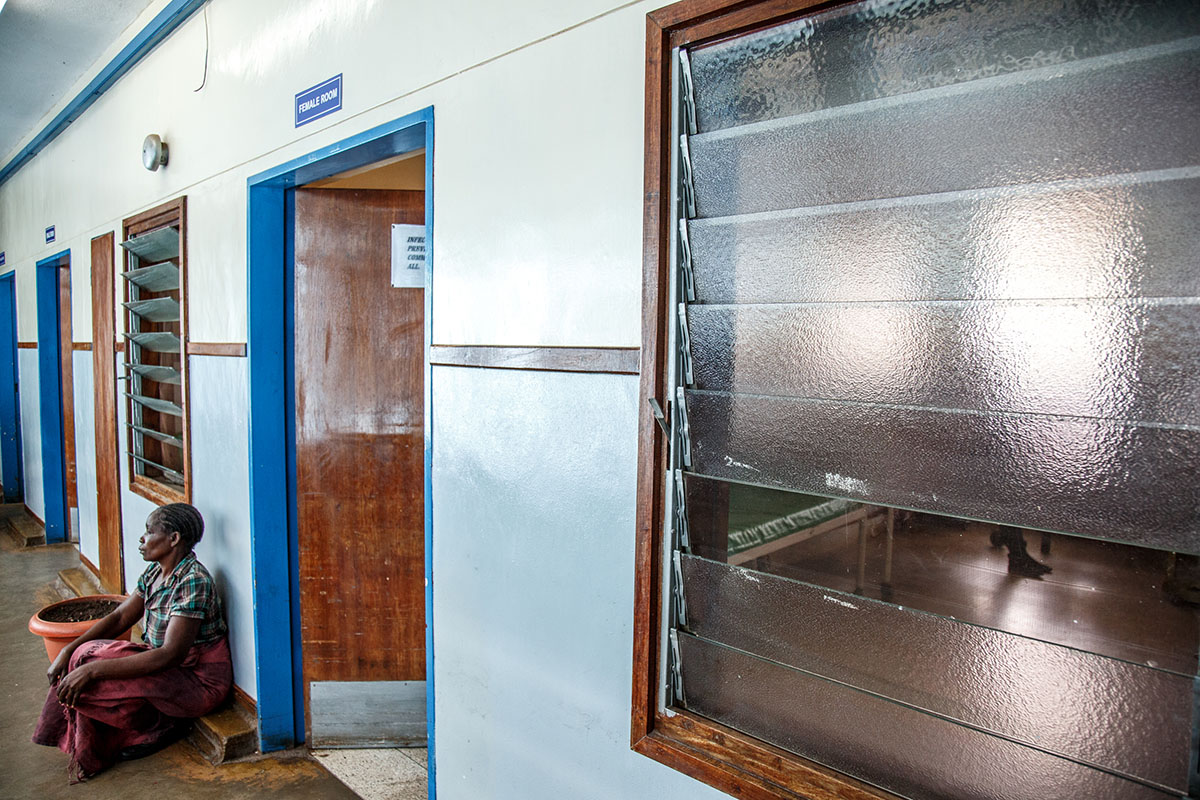
Malawi’s health crisis
Despite this, according to Judith Phirie, head nurse in Chintheche Rural Hospital, international NGOs and the government of Malawi focus on “HIV/AIDS, tuberculosis, and malaria, rather than cooking smoke, because that is where the donors give money.”
Doctor Mumba and sister Nyrenda at Kamuzu Central Hospital echo Phirie’s thoughts: The problem is widespread and the donor focus on just these diseases is challenging. With chronic health worker shortages and inadequate drug supplies, prioritizing becomes critical.
[This article first appeared on VersPers on April 11, 2017. See http://www.verspers.nl/artikel/verspers/12742/dodelijke-rook-roet-en-vlammen/#.WV-sHcaZOhd]

A Cooking Crisis: Polaroid Series
Images by Nathalie Bertrams

Three Billion People Cook Over Open Fires—With Deadly Consequences
By Michelle Nijhuis. Images by Lynn Johnson.August 2017
On Easter Sunday morning, in the small town of San Antonio Aguas Calientes in central Guatemala, Elbia Pérez and her sister, daughters, and 18-month-old grandson are crowded around their kitchen table. On the table, a large pot of tamales, handfuls of spicy meat and corn dough wrapped in plantain leaves, stands waiting to be steamed. The room is filled with talk, laughter, and smoke—gritty, eye-watering smoke that sticks in the throat and provokes deep, scratchy coughs.
The problem isn’t that the family lacks a functioning stove. In fact, the aluminum-sided kitchen—part of a compound that shelters 45 extended-family members—contains three. But the two-burner gas stove is out of fuel, and the Pérez family can’t afford to fill it. Their efficient woodstove, a knee-high concrete cylinder donated by an aid group called StoveTeam International, is too small to support the tamale pot. So, as she does about once a month, Pérez has fired up the old wood-burning stove, a crumbling, chimney-less brick ruin whose smoke pours directly into the unventilated kitchen. Everyone notices the smoke, but it’s a familiar annoyance—and compared with the daily challenge of affording food and fuel, it’s a minor one.

Some three billion people around the world cook their food and heat their homes with open or barely contained fires, and while the smoke dissipates quickly, its accumulated costs are steep. The typical cooking fire produces about 400 cigarettes’ worth of smoke an hour, and prolonged exposure is associated with respiratory infections, eye damage, heart and lung disease, and lung cancer. In the developing world, health problems from smoke inhalation are a significant cause of death in both children under 5 and women. “The first thing we swallowed every morning was smoke,” remembers Marco Tulio Guerra, who grew up in rural eastern Guatemala and whose brother was severely burned as a child by the family cooking fire. To fuel the smoky fires, families can spend 20 hours a week or more gathering wood, time that might otherwise be spent at school, at work, or simply at rest.
Wood-burning household fires and inefficient stoves cause broader suffering, too. The firewood trade promotes deforestation and also provides cover for timber smuggling, since wood from rare trees can be hidden among logs from more common species. The smoke from cook fires pollutes the air outdoors as well as indoors, especially in cities. And as a major source of black carbon—a sunlight-absorbing pollutant—the world’s billions of household fires are also thought to be accelerating the effects of climate change, speeding the disruption of monsoon cycles and the melting of glaciers.
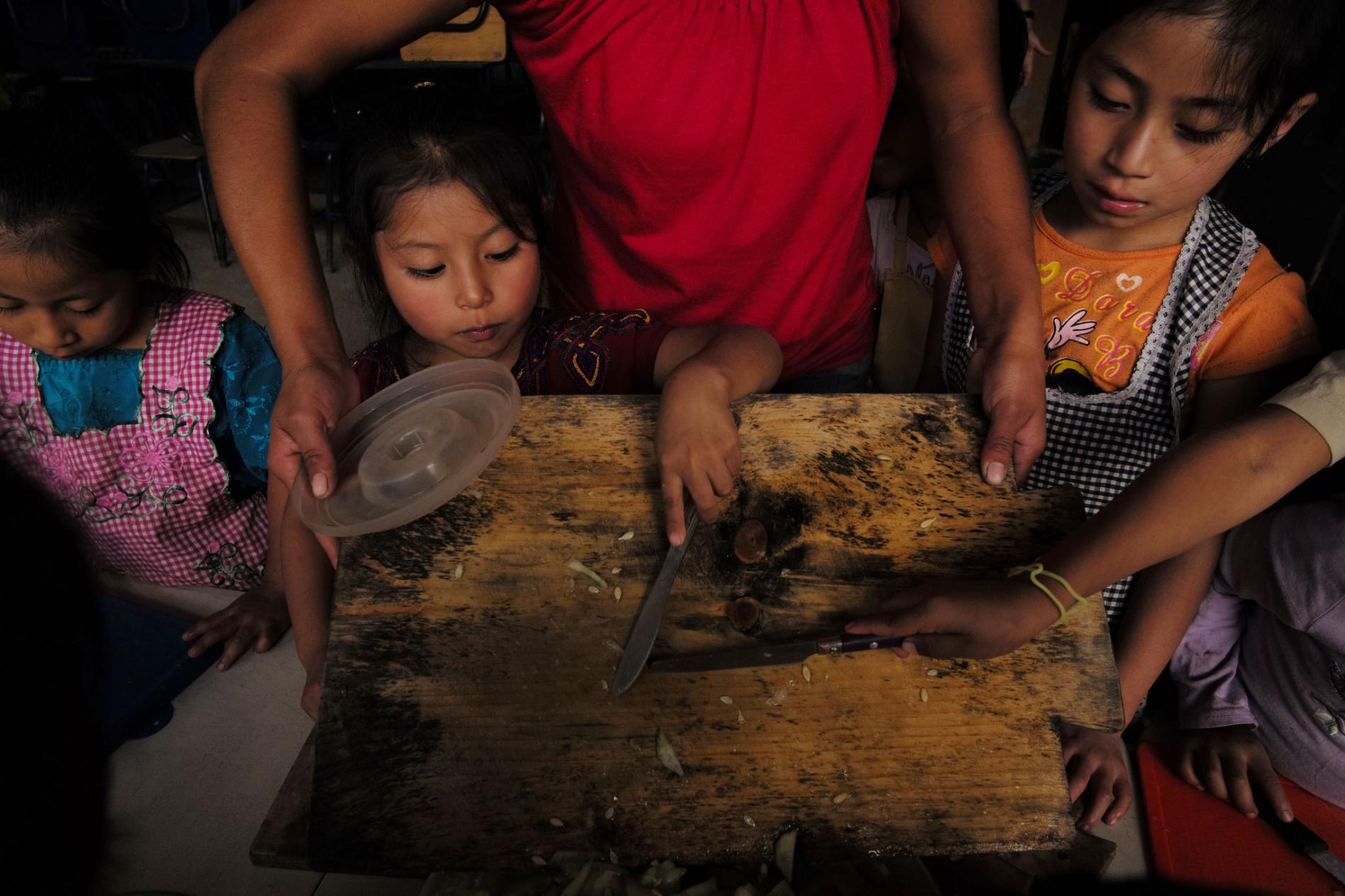
In the 1970s, a major earthquake in Guatemala brought international aid groups to the country, where they learned about the health and environmental costs of open cooking fires. Since then, a diffuse network of engineers and philanthropists has invented and distributed hundreds of different kinds of improved stoves throughout the developing world, ranging from tiny, gas-powered camping stoves to wood-fired ranges large enough to feed a dozen. Thanks to an initial investment by StoveTeam International, Guerra now owns a factory in central Guatemala—one of several similar operations in Mexico and Central America—that manufactures eight types of improved cookstoves, and he sells them to both aid groups and individuals throughout the country. His very first stove, which he built by hand almost a decade ago, is still in daily use nearby, in Rosa de Sapeta’s kitchen. De Sapeta says that her family used to avoid the smoke-filled kitchen, but now, she says, “I have company when I cook.”
New cookstoves aren’t always adopted so easily and enthusiastically, however. For a stove to be fully accepted by a household, both stove and fuel must be affordable, accessible, and easy to use—goals that aren’t easy to achieve simultaneously, as the Pérez family has found. And in places where the social status of women is still tightly tied to the quality of their cooking, woe to the stove whose output doesn’t measure up to local culinary standards. “When I started this work, I thought it was just a matter of choices and appliances,” says Radha Muthiah, the chief executive officer of the Global Alliance for Clean Cookstoves, which was founded in 2010 and is hosted by the United Nations Foundation, with support from public and private funds. “But as you get into it, you realize there are so many different considerations.” Muthiah and other stove experts emphasize that there is no single ideal stove or ideal fuel, as every household, every community, and every culture has different needs and priorities: a stove designed for rural Guatemala may well be completely impractical in Nairobi.
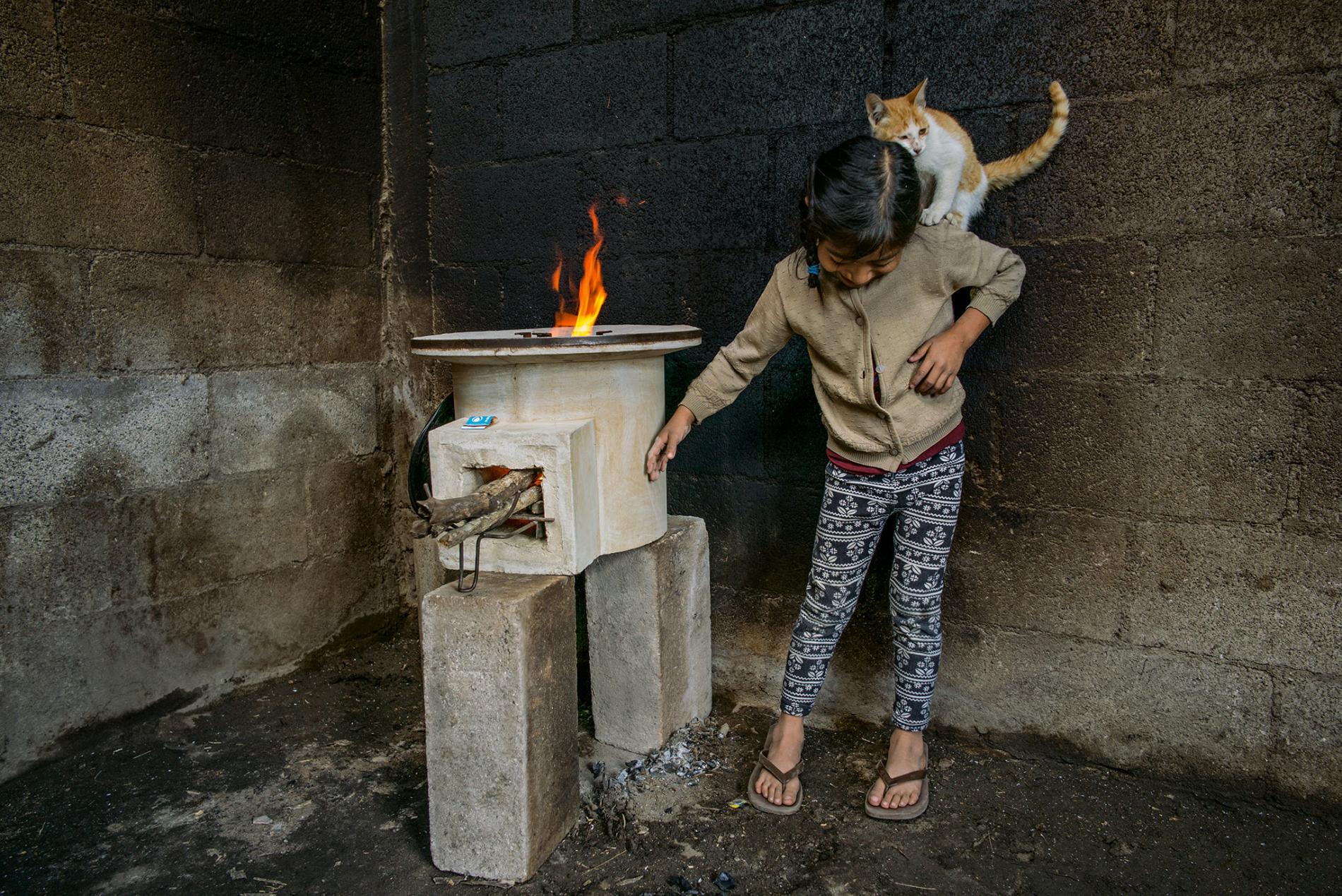
To make it possible for each family to choose its own ideal stove, the Alliance recently provided start-up funding to two retail stores in Guatemala. Called Estufas Mejoradas y Mas—“Better Stoves and More”—the stores are run by local women, and they stock gas and wood-burning stoves of all sizes. Prospective customers can try out the stoves before choosing one, making tortillas from dough supplied by the stores.
The long-term benefits of a cleaner-burning wood stove, even when fully accepted by a household, are uncertain. Stoves that burn cleanly and efficiently in the laboratory, under standardized conditions, may not sustain their performance over years of everyday use. Deep in the western highlands of Guatemala, where the Mayan language of Mam is spoken more frequently than Spanish, a series of long-running public-health studies has measured the effects of improved wood-burning cookstoves on childhood health. An international team of researchers led by Kirk Smith of the University of California, Berkeley, found that while the new stoves did improve household air quality and reduce the frequency of childhood illnesses such as pneumonia, the indoor air pollution was still far above guidelines set by the World Health Organization. The team, now led by Lisa Thompson of Emory University, recently studied if and how families can be encouraged to adopt three-burner gas stoves—which have a comparable carbon footprint and, of course, emit no smoke at all. Thompson and a network of collaborators are now expanding this research to India, Peru, and Rwanda, studying how gas-stove adoption—and associated improvements in household air quality—affects the health of mothers and children.

Expedita Ramírez Marroquin, a Mam-speaking midwife, and Micaela Ysidro Marroquin, a local health worker, have collaborated for many years with the research team, and they facilitated classes for the expectant mothers who participated in the gas-stove study. The participants learned how to light their stoves and check for gas leaks, and they role-played potential domestic challenges—such as convincing a dubious husband or other family member to help them pay for gas cylinder refills. Ramírez Marroquin observes that older generations are often dismissive of the new stoves and their promised benefits. “The parents and the in-laws will say, well, according to the researchers we should be dead already—but we’re not, so why bother?” she says. Young couples able to set up their own households, on the other hand, are often eager to save time and money and are quicker to change.
Given time, though, even in-laws can adopt new ways. In the western highlands where Ramírez Marroquin works, great-grandmother Eugenia Velásquez Orozco remembers when her household switched from an open fire to a chimney stove. She missed the direct heat on cold mountain mornings, but she got used to the change. Now her granddaughter-in-law, a new mother and a participant in the study, is learning to use a gas stove. “Give me another five years,” Orozco says with a grin, “and maybe I’ll get used to that, too.”

[This story was published in National Geographic on August 14, 2017. Reprinted with permission. Images and text courtesy of National Geographic Partners, LLC.]

Particulate matter has immense destructive potential, but floats through our air undetected.
The Yale Data-Driven Environmental Solutions group created this world map to illustrate just how severe—and close to home—the crisis is.


Chapter 5: Polish Gold, Coal’s Deadly Toll
Breathing clean air shouldn’t be so difficult. In 2015, when grantee Beth Gardiner began reporting on Poland’s deadly pollution issue, the city of Krakow was ranked by the European Union as having the third-dirtiest air on the continent. Scientists and activists alike attribute that ranking to what’s colloquially known as “Polish gold”—good ole’ coal.
Coal is familiar—most of us have touched it ourselves and seen the soot it leaves on our skin and clothing. The organic compound is at the center of the current political crevasse running the length of America, with communities built on the backs of generations of coal miners pitted against environmentalists seeking to cut coal completely from domestic energy production.
In Poland, coal fuels the production of nearly 90 percent of the country’s electricity. In this chapter, Beth Gardiner covers the struggle of some Poles to push for cleaner air as the world looks more critically at carbon-based fuels and their impact on our future. According to one study cited by Gardiner, air pollution from the country’s coal-fired power plants kills 5,300 people each year, adding $8.7 billion in healthcare costs.
Widespread use of at-home coal stoves is the other major contributor, pumping carcinogens and soot particles into the air and the lungs of Polish children, elders and adults. In 2013, Krakow’s regional legislature passed a ban on home burning of coal and wood, the first in Poland. After protracted court battles, it is now scheduled to take effect in 2019. But with coal still the backbone of Poland’s industrial infrastructure, more comprehensive steps to divest the country of coal are the only way to clean the slate.
A former Associated Press reporter, Gardiner now focuses on the environment—her work has appeared in The New York Times, The Guardian and The Wall Street Journal. Her book on air pollution—combining politics, science, and the voices of those affected and those fighting for change—will be published by the University of Chicago Press and Portobello Books.
-A.L.

‘The Air Is Stinking, It’s Dirty’
By Beth GardinerApril 2015
With a neatly trimmed moustache and white doctor’s coat, Dr Krzysztof Czarnobilski, head of internal medicine and elder care at Kraków’s MSWiA Hospital [Central Clinical Hospital of the Ministry of the Interior], speaks nervously, his English formal and stilted. His message, though, couldn’t be clearer. The filthy air in Poland’s most picturesque city is making his elderly patients sick, shortening their lives and increasing their isolation. The pollution, he says, worsens cognitive and emotional problems such as dementia and depression and exacerbates breathing and circulatory disorders.
Czarnobilski’s hospital, which specializes in treating the elderly, is a yellow concrete building a short tram ride from Kraków’s medieval center; its blocky, institutional style a relic of Poland’s Communist past. On winter days, when clouds of black soot hang over the city and pollution readings are especially high, Czarnobilski says the “ambulances queue out here on this street.” Medics inside scramble to keep up with the rush of patients as double the usual number of pneumonia cases arrive, instances of heart attack and stroke jump, and those with breathing problems—such as chronic obstructive pulmonary disease and asthma—show up in crisis.
Like other medics around Kraków, on days like these Czarnobilski is in the uncomfortable position of advising patients to avoid exercise and stay indoors, a prescription that for the elderly is at best isolating, and at worst deadly. “The people are very sad on these days,” he says. “They are lonely in their flats, and this depression is very, very harmful for their health.”
Kraków, an elegant city dotted with the remnants of its history as Poland’s royal capital, suffers from the dirtiest air in a country plagued by severe pollution. Much of it is created by the widespread burning of cheap coal in old home stoves, producing smoke rife with carcinogens like dioxins and benzo[a]pyrene, as well as the small sooty particles that are strongly linked to heart, breathing and even cognitive ailments. The cars that clog Kraków’s roads and the coal-fired power plants nearby add to the problem.
“There is a day during autumn when you open the window and you know that it’s started,” says Michal Olszewski, a former environmental activist who is now Kraków bureau chief for the Gazeta Wyborcza newspaper. He is talking about residents’ burning of coal, wood, even of plastic bags and bottles for heat. For Olszewski’s children, aged nine, seven and three, “the same story begins: They start coughing, and they cough and cough until March or April.”
In the leafy neighborhood of Bronowice, where coal use is particularly high, Monika Bielak and Bogdan Achimescu hurry their boys past the playground after school, forgoing a stop in order to get them more quickly into the filtered air of the family’s home.

Achimescu once had a nosebleed that lasted for 20 hours. All through the winter heating season, he and his wife administer breathing medication through a nebulizer to both of their sons almost every night, with steroids added in when their coughing gets especially bad. Nine-year-old Julek isn’t growing fast enough, so he gets a daily injection of growth hormone too. Their father doesn’t know if that problem is pollution-related, but he does wonder. Even the recently deceased family dog suffered from a cough.
What happened when Achimescu saw a doctor about his nosebleed? “He laughed at me. He said ‘What are you expecting? You’re living in Kraków’. I had the same reaction from the pulmonologist.”
Bronowice’s pollution levels are among the city’s highest because of its many single-family homes whose residents are more likely to use coal than people living in flats, where gas or district heating networks are more often available. “During winter we are like prisoners really,” staying in all afternoon and evening, Bielak says. “The air is stinking, it’s horrible, it’s dirty.”
The couple have bought an electrocatalytic filter, a slim white device about two feet tall which sits next to the dining table and runs for months on end. Achimescu says it brings levels of the tiny, dangerous particles known as PM10 in the lounge, where Julek and Jasiek sleep, down to 50 micrograms per cubic meter—more than twice the World Health Organization’s recommended safe level.
Bielak shows a photo of heavy black smoke pouring from the chimney of the big, pale-pink house across the street. The couple reject the notion that it is only the poor who depend on dirty fuel. “There’s a gynecologist nearby, she has a big SUV and a big chimney that spits smoke,” Achimescu says. “There’s this whole idea that this is related to poverty. It’s a nice story and the politicians love it, but in fact it crumbles when you compare it to reality,” he says.
Levels of the small pollution particles that penetrate deep into a human body sometimes reach six times the safe levels in Kraków. Benzo[a]pyrene can hit eight times the recommended maximum, according to the activist group Kraków Smog Alarm, which likens each resident’s exposure to the toxin to what they would get from smoking 2,500 cigarettes a year.
But the city is trying to change that. Ranked by the European Union as having Europe’s third dirtiest air, topped only by Pernik and Plovdiv in Bulgaria, Kraków became the first in Poland to approve a ban on the use of solid fuels such as coal and wood for home heating.
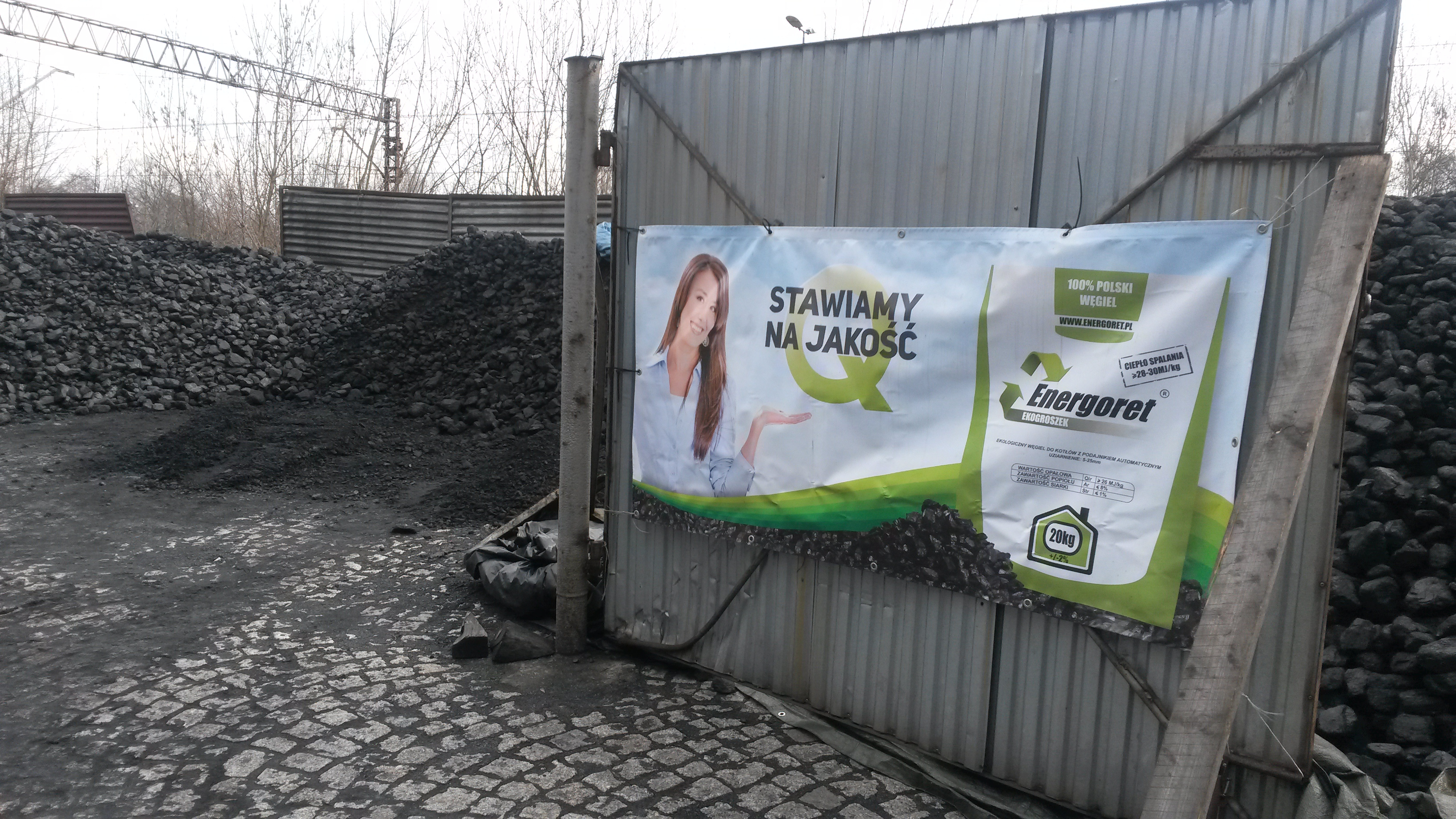
Scheduled to come into force in 2018, the new law was deemed invalid last year by a regional court—but it remains on the books until an appeal is decided. Meanwhile national politicians, with the backing of Poland’s right-leaning government, are seeking to circumvent the decision with a bill that would give regional authorities throughout the country the power to regulate coal, vehicles and other sources of pollution.
With €100m [$117m] from Brussels, Warsaw and the regional authority, Kraków officials are also pushing forward with financial incentives aimed at getting city residents to junk their old coal stoves in favor of gas, electricity or a hookup to Kraków’s district heating system, which pumps heat to users from large central boilers. The city is reimbursing eligible residents for the full cost of a new boiler, but the fraction covered will fall as the ban’s start date draws closer.
Even opponents of the ban don’t deny Kraków has a serious problem. But they blame transport and industry for the pollution, and they say prohibiting home coal use will hit the poorest. Filling his old Mercedes hatchback with sacks of the stuff on the edge of Kraków, Zbigniew Jędrygas says that when his shed is stocked with a ton of coal: “I am secure and I can sleep well.”
With an estimated 30,000 coal boilers scattered around Kraków, change won’t be easy, or cheap. The fuel some call “Polish gold” is embedded in the country’s culture and history, providing nearly 90 percent of its electricity and giving Poles a feeling of freedom from their feared neighbor Vladimir Putin and his gas pipelines. And for users, at least, it is a lot less expensive than the alternatives.
At Grzegorz Rumin’s coal lot, beside a railway track on the southern edge of Kraków, deep black coal sits in big, open piles and the air is heavy with dust. Every 10 minutes or so, a customer pulls in, and Rumin or one of his workers uses a truck-mounted scoop to dump coal into an open trailer, or shovels it into sacks to be hauled home in a car boot. Rumin, a slim man in work boots and a frayed, blue hoodie, says sales are down since he entered the business in 1998, when schools, other big institutions, and many more homes used coal for heat.
Back then, he says, the lot sometimes sold 100 tons a day. Now “the best day is 20, 20-something” tons, but even that is unusual. Indeed, only about 7 percent of Kraków’s households currently use coal, according to the Kraków Institute for Sustainable Energy. The number has fallen over the years and is, as a proportion, much lower than elsewhere in Poland. But Kraków’s population density and its location in a valley mean its air, officially at least, is the country’s worst. Many suspect pollution is even higher in small towns that lack sophisticated monitoring equipment.

Rumin alternates between fury and exasperation when the subject of the ban comes up. His business will close if the law stands. Local officials, he thinks, have misdiagnosed the problem and have their priorities upside-down. “Look at Paris, for example,” he says. “What do they use for heating? Do they also use coal? I think not, but they also have smog. It’s not about coal.”
Rumin says he has customers whose homes lack running water or sewerage pipes. Meanwhile, Kraków’s officials “are saying they will provide people with gas heating systems. How can they do it if there are some families that do not even have such basic things?”
In a sunny office near Kraków’s central square, Anna Dworakowska and a handful of her colleagues provided the push that allies and adversaries agree prompted lawmakers to approve Kraków’s groundbreaking ban. Dworakowska’s group, Kraków Smog Alarm, gathered 17,500 signatures in 2013 and placed billboards and posters around the city with slogans such as: “I already have asthma, I don’t need cancer.”
Hundreds of people participated in demonstrations, some pushing empty buggies to represent the children forced to stay indoors because of dirty air. “There were placards reading ‘Sophie: She doesn’t go out, she hasn’t been in fresh air for two months now,’” Dworakowska recalls.
Their cause has now become mainstream; even Poland’s pro-coal government is targeting home use—perhaps because it is easier than confronting big power companies about the emissions from their coal-fired plants.
Before the campaign, Dworakowska says, the “media would write maybe three articles about air pollution at the beginning of the heating season, the first smoke episode, and then they would quit. Because how many times can you write about the same thing? But we’ve had more than 1,000 media articles now, it’s the main topic, everybody speaks about it. I think that’s something we’ve definitely changed.”
For Dr. Czarnobilski at the MSWiA Hospital, the change can’t come fast enough. As workers renovating the emergency room downstairs from his office hammer and shout, he sits thoughtfully behind his dark, polished wooden desk. His patients, he says, often respond angrily when he urges them to stay indoors.
“Their depression begins to get deeper and deeper. If an old patient stays at home and doesn’t move,” he says, before trailing off, “What else? Stay in bed, and finally die.”
[This story originally appeared in Guardian Cities on April 13, 2015, and is reprinted with permission: https://www.theguardian.com/cities/2015/apr/13/air-dirty-fight-pollution-krakow-poland-ban-wood-coal]

How Warsaw’s District Heating System Keeps the Capital Cleaner Than Krakow
By Beth GardinerApril 2015
A strange twist of circumstance and history has left gray, bustling Warsaw with far cleaner air than elegant Kraków—and created a potentially sizeable sustainability-plus in a nation more accustomed to being cast as the environmental laggard of Europe.
After the terrible, almost complete destruction of the Polish capital during World War II, its Communist rulers’ fondness for large, centrally planned infrastructure projects led to the construction of an enormous network of heating pipes as Warsaw was rebuilt.
That system, the largest of its kind in Europe, has spared the capital’s 1.6 million population from the pollution that plagues Kraków, where thick black soot wafts from the chimneys of residents who burn coal at home.
Through frigid winters in Warsaw, the pipes bring warmth to parliament, the presidential palace and huge blocks of flats, some of them tall and concrete in the old, Communist style, others lower and more modern. Such systems, known as district heating, are popular with environmentalists because they can be much more efficient than thousands of individual home boilers. In the Polish cities where they exist, district heating networks have the added plus of providing an affordable alternative to the widespread practice of burning coal in low-tech, often filterless home stoves.
Progressive Denmark has built an extensive district heating system, and Britain, too, is trying to link homes to small local networks.
“This is one of the few good inheritances from the Communists,” said Maciej Bukowski, president of the Warsaw Institute for Economic Studies. “When you compare Warsaw to Kraków, it’s quite clean. It’s no different from London or Berlin.”
In coal-dependent Poland, any claim of sustainability comes with big caveats. The environmental upside of district heating depends on what kind of fuel it uses, and the answer is often coal, meaning trouble for both health and the environment. That impact is eased when the heat is captured as waste at plants generating electricity, rather than created for its own sake. Even with that efficiency boost, called combined heat and power (CHP), “it’s simply not a magic solution, a silver bullet,” said Meri Pukarinen, head of the climate and energy unit at Greenpeace Poland. “If you want to power your CHP with fossil fuels, then you run into the same problems” caused by any fossil fuel use.
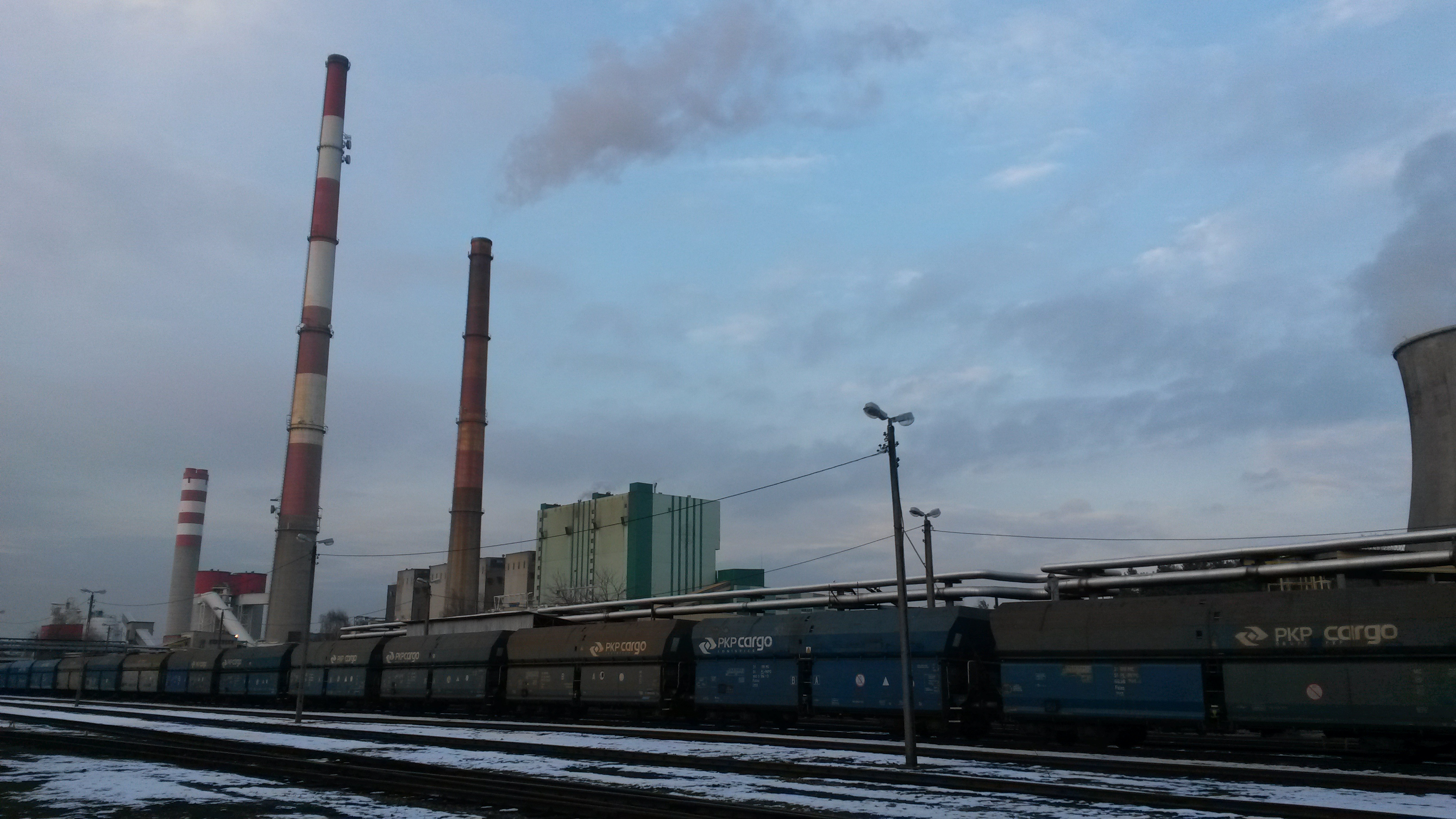
Many of the pipes are old and leaky, wasting large amounts of heat. The system is far better than decades ago, though, when all flat-dwellers could do to control the temperature in the depth of winter was open windows when they got too hot.
Krzysztof Bolesta, an adviser to environment minister Maciej Grabowski, said that was what people did years ago in his first Warsaw home. Now, his sister lives in the same building, but it has been refurbished, and individual controls installed.
“Everyone has a meter on the radiator, so if you open the window and you don’t close the radiator, you have to pay, and people know that, so it helps,“ Bolesta said.
Kacper Białkowski, assistant project manager in an arts theater, lives in a modern stone apartment building a few minutes walk from Plac Zbawiciela, where a large rainbow arch of fake flowers sits at the center of a bustling roundabout, a splash of color amid the gray of Warsaw’s winter.
As a teenager, it was Białkowski’s job to haul a load of coal to his family’s home every day from an outbuilding on their property. “Imagine doing that in the evening, winter, with -25 degrees Celsius outside,” he says. On top of its other drawbacks, he said, coal was slow to warm the home, so his family would fire up their stove as soon as they returned from work and school, and then wait for the chill to ease.
Now though, Białkowski says he is like many other Warsaw residents, taking for granted the ease with which he can turn on the heat and warm up. And doing so doesn’t taint the air his neighbors breathe. Not by Polish standards, anyway.
[This story originally appeared in Guardian Cities on April 13, 2015, and is reprinted with permission: https://www.theguardian.com/cities/2015/apr/13/warsaw-district-heating-system-poland-capital-cleaner-krakow]

Coal in Poland Lowers Life Spans
By Beth GardinerJune 2015
MYSLOWICE, Poland—The children Karolina Zolna knows huff and puff after a few minutes of exercise. Two years ago, her infant daughter spent four months in the hospital with pneumonia. The doctors did not identify a cause, but to Ms. Zolna, the reason for the baby’s illness was obvious.
She blames the pollution that hangs heavy in the air of her gray hometown in Poland’s coal heartland, Silesia. In the still-chilly early days of spring, thick smoke wafted from most of the chimneys in Myslowice, wreathing the town in a haze that is a constant reminder of residents’ reliance on coal for heat.
A few kilometers away, visible from the town’s main street, stands the tall red and white smokestack of Elektrownia Jaworzno III, a coal-fired power plant. Clouds of white steam billow from its concrete cooling towers.
“It’s definitely too close to people’s houses,” Ms. Zolna, 30, a school secretary, said of the plant. “If you read about this, you know that pollution is not good for health. And if you have children, you know that it affects your children. And there are more and more kids” with breathing troubles, she said. “Both my children have had problems with their lungs.”
Poland has the highest levels in Europe of the tiny pollution particles that are strongly linked to serious health problems like heart attacks, strokes, cancer and even dementia, said Martin Adams, an air quality expert at the European Environment Agency. Poland is home to six of Europe’s 10 most polluted cities, the agency’s figures show.
That filthy air is largely a result of Poland’s heavy reliance on both hard coal and lignite, which is also known as brown coal.
With energy policy on the agenda as the Group of Seven leaders meet this week, clean power is still in its infancy in Poland, where a tangle of political and economic forces have kept coal secure in its place as the dominant fuel. About 85 percent of electricity and 43 percent of heat come from the fuel some call “Polish gold,” the government estimates.
The European Commission has opened infringement proceedings against Poland for violating particle pollution levels and is investigating reports that it has also exceeded limits on nitrogen oxides.
The health consequences are severe. In addition to its role as a major source of climate-warming carbon dioxide emissions, coal burning releases a bevy of dangerous pollutants, including, in the low-tech home heating systems that are common in Poland, toxins like benzo[a]pyrene.
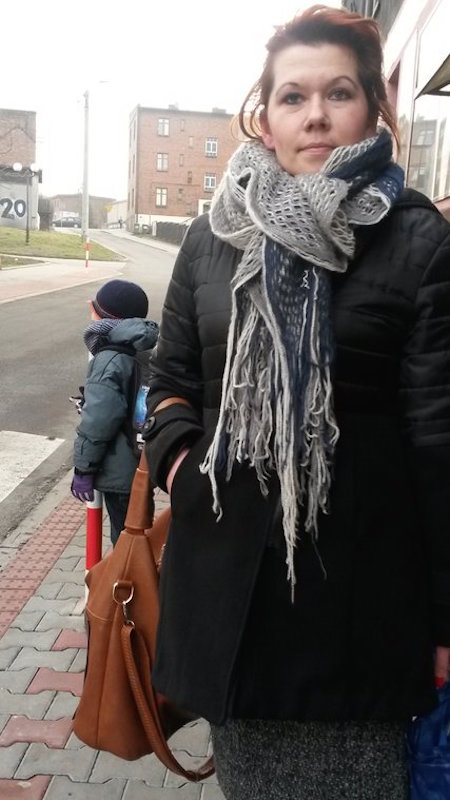
More than 43,000 Poles died prematurely because of air pollution in 2011, the most recent year for which figures are available, the European Environment Agency estimated.
“It’s a myth in Poland that coal is cheap, and energy from coal is cheap,” said Julia Michalak, an energy expert at demosEuropa, a Warsaw research group. “We pay for it a very high price.”
Poland’s government is among the European Union’s staunchest defenders of coal, leading opposition to measures that would restrict its use.
Despite troubles that have roiled the country’s mining sector in 2015, officials see coal as key to avoiding dependence on Russian natural gas. Coal’s backers also say it is an affordable option for a nation that cannot afford a quick transition to cleaner alternatives.
Awareness of the severity of the air problem has just begun to dawn. Prime Minister Ewa Kopacz’s government declared 2015 to be the Year of Improving Air Quality and is backing a proposal to empower regional authorities to clamp down on pollution from vehicles and from the burning of coal and wood in homes.
Officials are focused on the contributions of home heating, known as low-stack emissions, which are severe and very visible. Millions of Poles burn coal, often the cheapest, most polluting grades, in old furnaces with poor filters. Some add plastic or other garbage to the mix, making for an even more toxic brew. Thick black smoke billows out of chimneys for nearly half the year, stinging throats and eyes and shrouding whole neighborhoods.
Environmentalists say the government’s plans for addressing that pollution are feeble. Many also argue that any serious attempt to clean Poland’s air must also confront coal-fired electricity generation, an area officials do not see as a problem.
Pollution from coal-fired power plants in Poland causes about 5,300 deaths per year, Greenpeace said in a report commissioned from Stuttgart University. The sector creates health costs ranging from 3 billion euros to 8.2 billion euros, or $3.3 billion to $9 billion, each year, said the Brussels-based Health and Environment Alliance, or HEAL.
Krzysztof Bolesta, an adviser to Environment Minister Maciej Grabowski, said that the power sector, while not pollution-free, is not a significant contributor to Poland’s air quality problem. Emissions from coal-fired plants are covered by tough European regulations, he said. “You can’t really find a robust study on health issues attributed to just one particular source of combustion.” Coal-fired plants “will never be zero emission, of course,” he said. But “they meet the legislation, so it’s off the radar, because they are sufficiently tackled, if you will.”
Enrico Brivio, a spokesman for the European Commission, said the body did not have details on individual plants’ compliance with its rules, since enforcement is the responsibility of national governments. Polish power plants have been granted extensions for meeting European requirements, so their pollution caps are higher than those imposed elsewhere.
Monika Morawiecka, a member of the management board of the Polish Electricity Association, an industry body, said coal-fired plants had cut emissions drastically since 1989. The utility PGE, which generates about 40 percent of Polish power, has reduced particle pollution by 98 percent, sulfur dioxide by 89 percent and nitrogen oxides by 46 percent in that time, with further declines expected, she said.
“Compared to what it was 25 years ago under Communism, the improvement is tremendous,” said Maciej Bukowski, the president of the Warsaw Institute for Economic Studies. “We are living in a different world.”
But Meri Pukarinen, the head of the climate and energy unit at Greenpeace Poland, said the government focus on home heating and transportation was indicative of an approach that is “quite skewed, not appreciating the health impact of the high-stack and energy production industry at all.”
“It’s a first step to focus on low-stack emissions, because it’s the most evident for people and they can feel it, they can see the smoke coming out of the chimneys,” said Weronika Piestrzynska, a spokeswoman in HEAL’s Warsaw office. “It’s harder to confront” the power industry, she said.In Myslowice, as a pungent cloud of smoke drifts from the chimney of a nearby apartment building, it is clear to Ms. Zolna, the school secretary, that both sources contribute to the foul air choking the town. “It’s not only because we use coal stoves,” she said. “We do not use them year round. It has to be these power plants.”
Coal’s share of Poland’s power base is slowly declining and is expected to continue doing so, as tougher European Union rules kick in. But new plants and upgrades and expansions to existing ones are still going forward.
Shifting from a coal-based economy to one built on cleaner fuels will take vision, said Ms. Michalak, the demosEuropa expert.
“What we need here is not incremental change, what we need here is a big decision about where we will go and how we will get there, and this is something that Polish politicians don’t have an appetite for,” she said. The country’s leaders, shaped by its move from Communism to democracy, she said, “are not ready for another big transformation.”
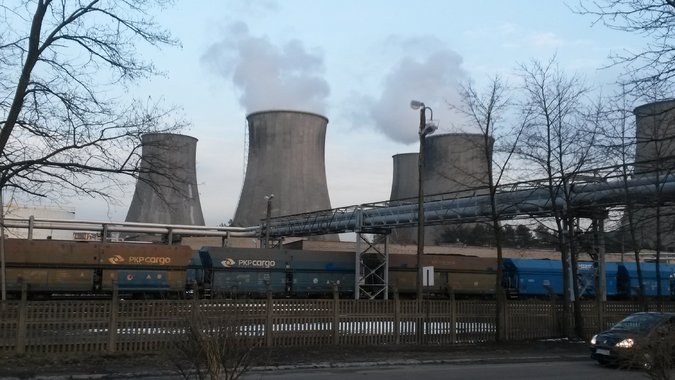
[This story originally appeared in The New York Times on June 7, 2015. Copyright © 2017 The New York Times Company: https://www.nytimes.com/2015/06/08/business/energy-environment/coal-in-poland-lowering-life-spans.html?_r=1]

Chapter 6: Legacy of Lead
“This is a story about a rural artisan community afflicted by tragedy and about children whose health and lives were unwittingly sacrificed through desperation and a poverty-driven and unfortunately toxic ingenuity,” Caitlin Cotter writes. She reported from La Victoria, Ecuador, where tile makers provide a sustainable income to support their families, but at a devastating price: the health of their children who are exposed to lead used in the beautiful ceramic glazes that adorn tiles all across the country.
In “The Rock Crushers of Kabwe,” Pulitzer Prize-winning photographer Larry C. Price travels to Zambia to document workers who mine rock used in building materials. They dig, break rock, and breathe dust—slowly poisoning themselves.
In “The Toxic Toll of Indonesia’s Battery Recyclers,” Larry C. Price and foreign correspondent Richard C. Paddock investigate another problem that affects soil, air, and water—illegal recycling facilities used to break down batteries.
The circumstances described here are mirrored throughout the world. For all of the research on its negative effects, lead remains an integral ingredient in much of modern technology. While lead is not as pressing a concern for consumers, those who handle lead on a daily basis and communities that bear the brunt of modern waste feel its devastating effects. “There are no safe exposure levels of lead,” Richard C. Paddock tells readers.
-C.C.

Ecuador: Lead’s Desperate Artisans
By Caitlin J. Cotter. Images by Yolanda Escobar.March 2017
The clattering bus from Pujilí to Latacunga stops at a corner decorated with towering statues of
colorful, rosy-cheeked potters working on their crafts. A sign reads: Bienvenidos a la Parroquia La Victoria, “Welcome to the Parish of La Victoria.” From this corner, I hop in the back of a pick-up truck with five or six locals. The floor of the bed is wooden, and the seats are boards with disintegrating cushions.
The truck stops at a central plaza with yellow tiles and pink concrete walls, flowering trees and a Catholic church. From here I walk about a mile—past rows of aloe vera, past children with kites, past houses and families I have come to know.
La Victoria, Ecuador, is nestled in the Andes, 125 kilometers south of Quito. During the 1990s, aspiring craftspeople came to La Victoria because the village had a profitable ceramic tile manufacturing industry. Artisans in La Victoria made roof tiles by the thousands, and they exported them across the country. They glazed the tiles for strength, impermeability, and aesthetics.
The main ingredient of the tile glaze was lead.
Lead has been used in ceramic glazes for thousands of years for its beautiful and strong finish—but more importantly—because it enables the glaze to melt at a lower temperature, facilitating the use of backyard, low-fire kilns. In La Victoria, to get the lead for these glazes, artisans turned to the lead plates from car batteries, manually removing them and melting them down in their kilns. This process aerosolized the lead, enabling it to be inhaled by people and distributed across the environment, widely contaminating soil, foods, objects and homes.
This is a story about a rural artisan community afflicted by tragedy, about children whose health and lives were unwittingly sacrificed through desperation and a poverty-driven and unfortunately toxic ingenuity. This is also a story about public health in a developing country, where good intentions, imperfect interventions, a lack of regulatory oversight, and a society submerged in hardship have come together to yield mixed results.
Past the aloe vera, scattered homes and children flying kites, around a barren bend and up a hill crowded with small houses lies a simple homestead with indoor and outdoor living spaces, white siding folding a bit with age, and myriad cushions, pails, clothing and other objects collected over time.
This is the home of Juan Molina.
Molina, 66, is a soft-spoken and thoughtful man who moved to the village of La Victoria in the early 1990s to start a business making ceramic roof tiles by hand. He wears a baseball cap over his round face and tired eyes. His brow is furrowed.
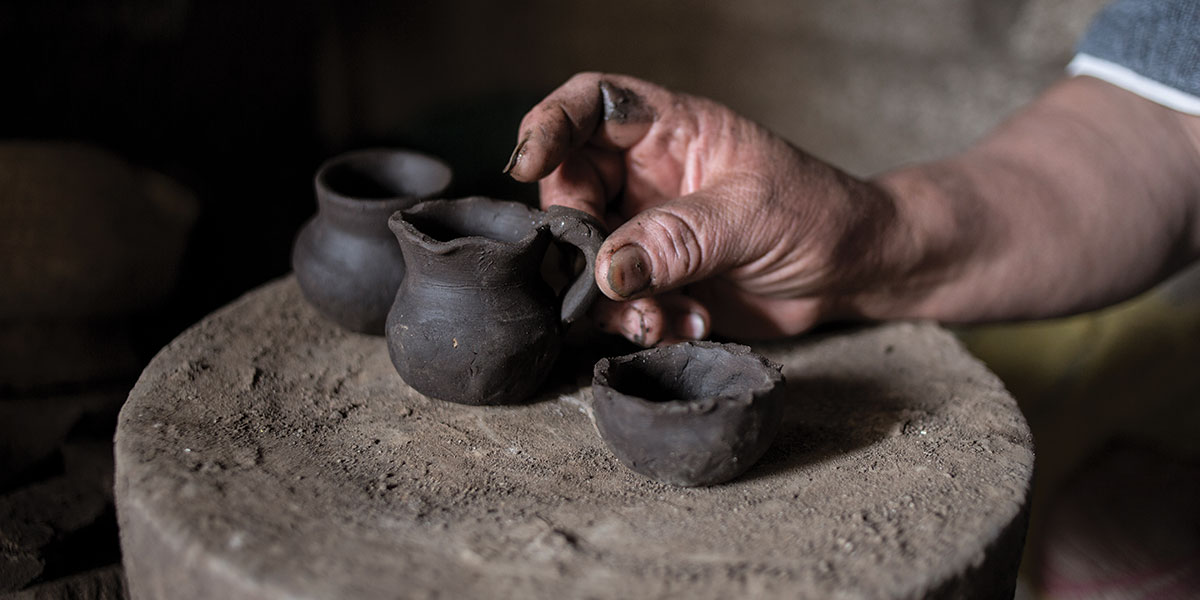
“I had eight children, but the first two of them died” in 1997 and 1998, Molina tells me. His first child was Wilmer, and his next was a girl named Magdalena. “Both of them died of convulsions,” he explains. “The authorities said it was from lead contamination. They wanted to do a scientific analysis, but they couldn’t because it was costly. They supposed it was lead toxicity, and that could be possible.”
The Molina’s next child, Margod, is now 33. She is small and frail, and she shies away from attention. Margod is mentally disabled. She can speak, but she was never able to learn or attend school. According to her father, Margod has begun helping with chores around the house, little by little, over the years, but she is hot-headed and can be aggressive to her family.
“We used to live right next to the oven, right next to the glazing process. But when the children were diagnosed with their problems, we took the oven further away from the house, and then we abandoned it,” Molina says.
Molina’s abandoned kiln now stands about 20 yards behind the house. The kiln, like most of those in the backyards of local artisans, is made of bricks and cemented with mud. The walls around it are formed from rows of roof tiles, held in place by mortar.
Tile-making used to be a good business in La Victoria. “We had resources and we had good money then, but regrettably, it didn’t serve for anything long-term,” Molina laments.

Molina stopped producing roof tiles when his family got sick. Instead, the family now decorates pre-made ceramic animals and vases with paints and metallic enamels. When I ask him what he thinks of the job, Molina tells me, “Enjoy the work or not enjoy the work—we have to do this because there is nothing else, of any form. We have to do this.”
No Safe Levels
Juan Molina’s concerns about lead exposure and its pernicious effects are more than justified. According to the WHO, lead is a cumulative poison, distributed to the brain, liver, kidneys and bones, where it can affect multiple body systems.
People can ingest lead that has contaminated the soil and dusted fruits and vegetables, children’s toys, and living spaces. Lead can be released into a mother’s blood stream, from her bones during pregnancy, and infants can be exposed to lead through contaminated breast milk.
In children, lead is often associated with neurodevelopmental disorders, motor or cognitive impairment, learning disabilities, behavioral problems, coma, convulsions, or death. In adults, chronic lead exposure can harm the neurological system, the kidneys, and the circulatory system. It also can cause high blood pressure.
Young children are particularly vulnerable, the WHO says, because they can absorb four to five times as much lead through respiratory and gastrointestinal routes as adults, and their innate hand-to-mouth behavior makes exposure more likely. Lead has a profound impact on the developing nervous system, so children exposed at an early age are more likely to develop impairments.
No safe blood level has been determined for children. Alan Counter, MD, of Harvard University, and Ferdinand Ortega, MD, of Universidad San Francisco de Quito, have studied lead exposures in La Victoria since 1997, and have observed cognitive impairment in children with blood lead levels as low as 10 micrograms per deciliter (µg/dL).
In 1998, around the time that Molina lost his first two children, Counter and Ortega reported an unusually high percentage of children in La Victoria with blood lead levels between 45–70 µg/dL. Some were even higher. The higher the blood lead level of the children they tested here, the lower the score for nonverbal intelligence they found. (The researchers declined to be interviewed for this article.)
Raul Harari, director of the IFA Corporation for Production, Labor, and Environmental Development in Quito, was part of another research team studying lead toxicity in La Victoria in the 1990s. “We found children not able to go to school, or remaining two to three years in the same grade level,” he says.
Soledad Suntasig, 40, has lived in La Victoria her whole life. She has seen the worst of the village’s lead toxicity, and she believes her own son Italo, 23, was affected. “Almost everyone was using lead. Just about 100 percent. Italo ate a piece of lead, just like it was bread or chocolate, when he was 9 or 10 months old,” Soledad remembers. “He looks healthy now, but I can say that something’s affected his nervous system. He understands everything, but to me, it’s apparent that he’s nervous and fearful. He is psychologically affected.”
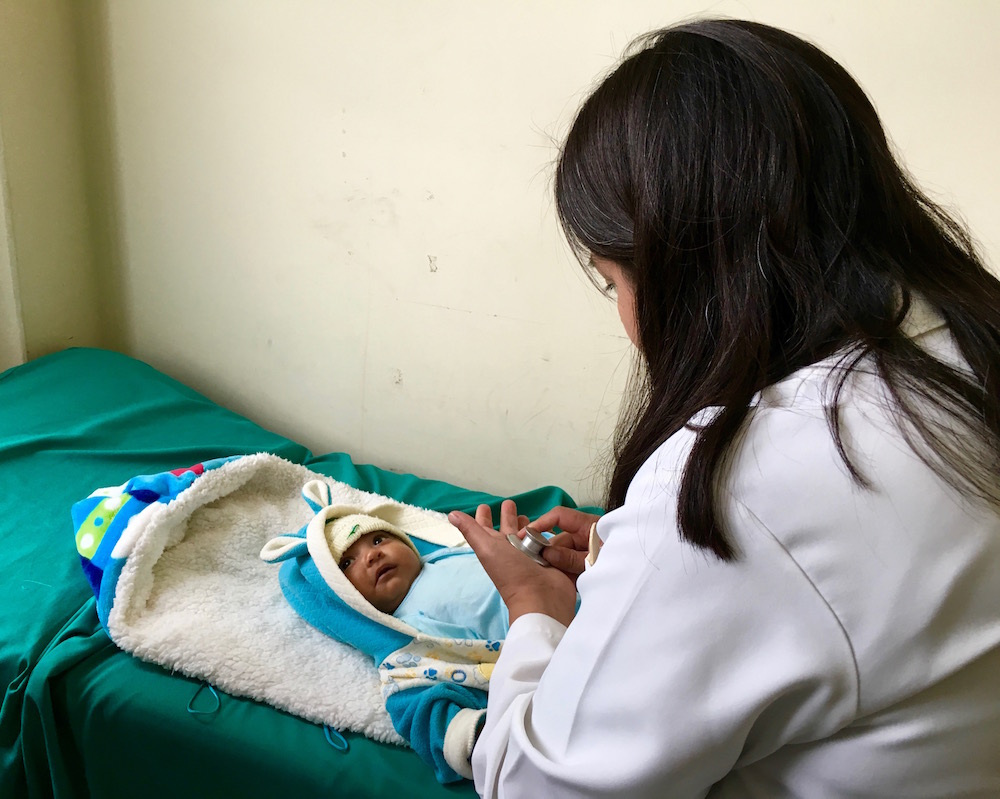
In the 1990s, most villagers in La Victoria were unaware of the health problems associated with lead exposure. In response to their early studies, Counter and Ortega set up a training and prevention program for the community in 1997. Mediation of the problem focused on hand-washing, food-washing, and wearing respiratory masks and gloves. Facemasks can still be seen hanging in most workshops. Gloves appear sporadically. Adults in the village believe these interventions have improved conditions. Phytoremediation, the use of plants to clean up contaminated soil and water, was recommended for La Victoria by Counter in 2000, but no reports of this cleanup effort have been made.
In 2003, the Ecuadorian government published a set of environmental requirements known as the Unified Text of the Second Legislation of the Ministry of the Environment (TULAS). The sixth TULAS volume contains the National List of Prohibited and Dangerous Chemical Products. It prohibits the use of lead in manufacturing, but enforcement has been weak.
Instead of applying strict legislative force, the municipal government of Pujilí, which oversees La Victoria, has been asking local political and artisan associations in La Victoria to regulate the community’s lead-using behaviors internally. “Enforcement of the rules is primarily social for us,” says Edgar Neto, director of Environmental Management in the Municipality of Pujilí, “but there can also be a $7,000 to $70,000 fine.”
Neto tells me that environmental health inspections should be done in La Victoria every three months, but there are no police to enforce the environmental laws. Although no one in La Victoria tells stories of fines levied for crimes against the environment, the social structure within the political and artisan associations here is strong, and much of the lead use among artisans has changed.
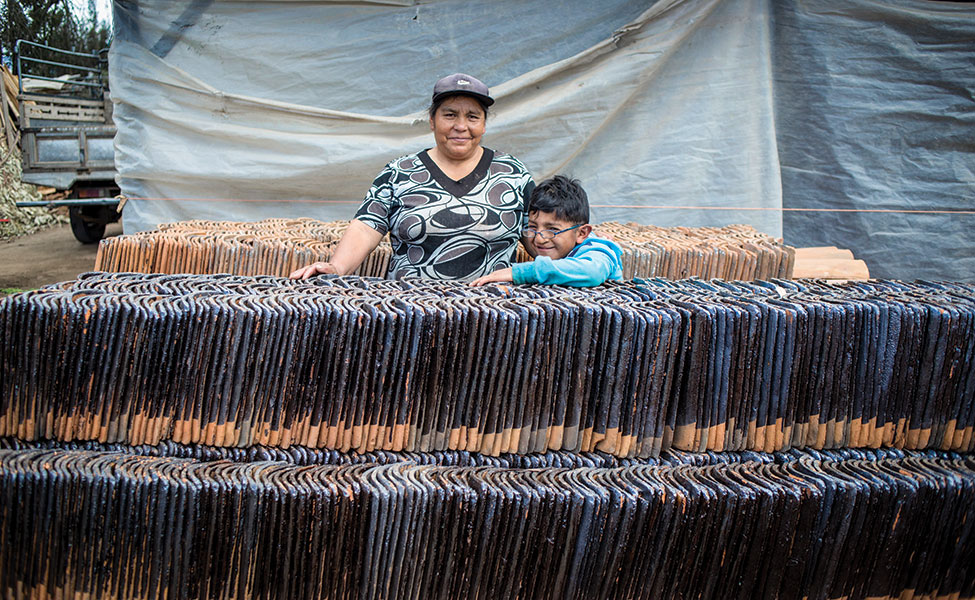
Two Views of La Victoria
“There are two ways to talk about La Victoria,” says Neto. “The ancestral, when life was totally concentrated in the elaboration of ceramics, which produced mental retardation and illnesses of other systems, and the new theme there: much recuperated.”
Indeed, the village may appear “recuperated” because the incidence of severe birth defects due to lead toxicity has markedly decreased, and today most patients with obvious disabilities are more than 20 years old.
Patricia Borga, MD, of the Subcentro de Salud (the local health clinic) in La Victoria, is among those who think that things have changed for the better. “Childhood lead toxicity is not the main problem we are seeing in our patients now,” she says, noting that the village currently has only one child with a clinically documented mental disability.
Although the current number of families using lead from car batteries is not officially documented, the Subcentro de Salud’s Angela Collaguaso, RN, says only about seven families are still openly using the lead from car batteries with their kilns. This represents about 10 percent of the families who were glazing with lead in the past.
“Obviously, there are still problems continuing,” Neto says. “It is very difficult because we have had this going on for so long. But the problem isn’t as profound as it used to be. The problem is very low in our children.”
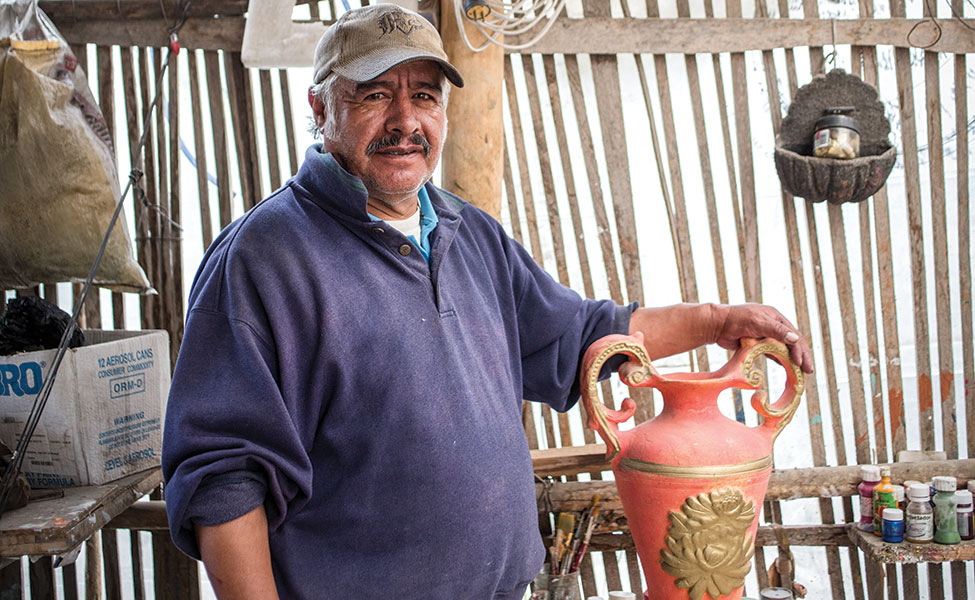
While excessive exposure and acute lead toxicity may have abated, lead’s potential for health problems continues—in the form of chronic exposure.
The U.S. CDC’s “upper reference interval value” for lead, indicating the 97.5th percentile for children, is 5 µg/dL. This means that only the most abnormal 2.5 percent of children’s blood lead values lie above 5 µg/dL. The most recent average blood lead level for infants and young children in La Victoria, measured by Counter and Ortega in 2015, was 29.4 µg/dL. Children with these blood lead levels are “likely to develop mild to severe neurodevelopmental disabilities,” according to Counter and Ortega.
Three years earlier, in 2012, Counter and Ortega reported that, “a majority of adults continued to show evidence of prolonged lead exposure, with adverse effects on the hematological system.”Chronic lead toxicity in adults can result in hypertension, chronic kidney disease and potentially subtle neurological signs such as dizziness, fatigue, lethargy, irritability, diminished cognitive performance or slowed reaction times.To date, no efforts have been made to test for signs of chronic lead toxicity in adults or children in La Victoria—despite the fact that the Subcentro de Salud sees hypertension commonly in its adult patients.
The Last Child
From his position as director of environmental management in Pujilí, Edgar Neto appears eager to further improve the conditions for artisans and their families in La Victoria.
He is excited to tell me that the Ministry of Pujilí has a plan for better ceramic ovens. “We are trying to help the artisans and also the environment. A Swiss company has proposed to build ovens here with better ventilation and complete combustion, which wouldn’t generate so much harmful smoke,” he says.
“The proposed project won’t fix it all, but it will hopefully minimize the environmental impacts,” says Neto. He adds, “The people need to get on board, too. This is a business proposal for the artisans, and if just one part of the process doesn’t work right, they won’t accept it.”
The new ovens would theoretically burn at a higher temperature, allowing artisans in La Victoria and other villages to use lead-free glazes. But Marco Rodrigo Mena, 44, a potter in El Tejar, says that one of these new ovens would cost over $25,000. Neto confirms that the new ovens are costly.
Such a price tag is way beyond what Hilda Maria Sontasig, 55, can afford. Sontasig has been producing lead-glazed roof tiles in La Victoria for 40 years. She is one of the artisans who continue to supplement frita (a factory-produced glaze, containing fused lead) with cheap lead from used automobile batteries.
“There is nothing else to use,” says Sontasig, a jovial woman, usually seen sporting an apron and a baseball cap. “I use the frita, plus something else to give color. Pilas [small appliance batteries] give black, copper wires from light fixtures make green, and lead from car batteries gives the shine. It’s not possible to make these colors with frita alone.”
“I only use old car batteries, of course. They’re very old, and they don’t serve for the cars anymore.”
Sontasig’s youngest daughter, Mayra, 29, has severe learning disabilities. “She knows how to write her name, but Mayra forgets everything,” Sontasig says.
Sontasig’s grandson, Éric Davíd Aguayo, moved in with Sontasig when he was 2. “Éric really likes playing around here and helping me with my work,” says Sontasig.
Éric was born with a cleft lip and suffers from hearing problems. “Éric is 7 years old, but he acts like 5. He started to be a bad student two years ago,” says his mother, Anita Romero. “He needs a lot of help with language, psychology, and occupational therapy.”
As of summer 2016, physician Patricia Borga only knows of one child in La Victoria who has a clinically documented mental disability.
That child is Éric Davíd Aguayo.
[“Lead’s Desperate Artisans” originally appeared in the Spring 2017 issue of Hopkins Bloomberg Public Health, the magazine of the Johns Hopkins Bloomberg School of Public Health: http://magazine.jhsph.edu/2017/spring/features/leads-desperate-artisans/]

The Rock Crushers of Kabwe
By Larry C. PriceJune 2017
KABWE, Zambia—The perimeter wall stretches from the main complex of the former Zambia Consolidated Copper Mines Ltd. east along a two-lane dirt road. The road has been here for as long as anyone can remember. It’s one artery that provided access to Kabwe’s sprawling mining complex that began operation here in 1904.
Kabwe sits squarely on one of the continent’s largest deposits of lead and copper. Without the mineral bounty that lies beneath the red earth, it’s doubtful Kabwe would even exist.
These days, Kabwe is a sprawling city of 220,000. It also has the distinction of being among the most polluted places on Earth. The mine was shuttered in 1994, but a hundred years of production has come at a terrible cost. Strewn across the land, millions of tonnes of red and black mining slag rise up from the surface, creating a toxic dune that continues to poison the residents of Kabwe. Blowing dust and seasonal rains disperse the mine waste, contaminating streets, yards, homes, and water supplies. Lead pollution is a constant menace for those in the neighborhoods closest to the mine. Many residents have higher than normal blood lead levels—and most at risk are the children.
As I walk along the road, I encounter dozens of people walking or biking along the shoulder. Every now and again, the words “DANGER” appear in large letters painted on the 7-foot cement-block wall that runs for more than a mile on the road’s north side.
Eventually the wall bends north to reveal a crude opening large enough for lorries to pass. The gateway looks makeshift, likely the result of an assault with sledgehammers.
Beyond the opening, a rocky landscape stretches far into the distance. Nearby, men and women walk beside a huge vehicle, struggling under the weight of tonnes of rock. The lorry barely clears the opening and rumbles past me.
This is where the rock crushers work. They are the scavengers who come to this place to work the toxic soil, filling woven plastic sacks with rocks and dirt, crushing large stones with tiny hammers. They labor in earth that measures up to 5.5 percent pure lead, breathing the dust, poisoning themselves.
I take the opportunity to make a few images, catching the attention of the men guarding the portal. I smile and nod their way. They wave back as I approach. Soon others, curious, form a small group around as I explain that I’m interested in their work. One man, speaking excellent English, isn’t enthusiastic about my presence and tells me not to take any more photographs. “No flashing,” he says firmly. Translated, this means, “No photos.”
I smile, keeping my camera at my side and start asking a few questions about the work here. Others chime in, explaining this is a restricted area. I ask about the work again, pointing to the hundreds of neatly arranged pyramids of small stones that line the paths behind the opening. A man tells me that the workers gather each day at 6 a.m., weather permitting, and dig rocks and soil using picks and shovels. Men use heavier tools and iron bars to pry at the chunks of earth. Women and children use hammers to break and stack the larger rocks. Others use shovels to fill bags with finer soil. I learn the area was once a grassy plateau. Now it’s a red wasteland of polluted soil, systematically dumped here over the years.
This area is highly contaminated with lead. Women, children, and men work here day in and day out, using their bare hands to make a living repackaging toxic waste. The rocks and soil are sold to middlemen as raw material to produce concrete and bricks for new homes and buildings.
I explain that I’m a journalist and am here to share their story. The man who decidedly was against me making photographs now seems to understand. “Tell the truth,” he says, as he turns to return to work. Others nod and shuffle away. I follow the ruts worn by the vehicles. As I begin photographing again, no one seems to pay attention.
After a few hundred yards, the road gives way to a network of rocky paths. I notice a group in the distance. As I approach, I see a family working together to dig and break rocks. Two women smile as I raise my camera. Without breaking their rhythm, they continue to smash at the melon-sized rocks.
Nearby, two children struggle to lift sacks of rocks they’ve been dispatched to gather. One pulls so hard, he loses his balance and almost falls over. The load is too heavy for the other boy so he drags the sack through the dirt. They’re unaware as I make several images, determined in their work. I think about this sad scene unfolding and deduce the rocks are likely half their weight. Finally, the boys drag the bags to the worksite where their mother, Debola Kunda, continues to hammer and add to the neatly stacked piles of stone. Debola laughs as the boys plop down next to her. I ask for names and Debola tells me Abraham is 6 and his younger brother Acili is 4.
I continue to walk and photograph. I come across more groups of workers frantically stabbing the ground with picks and shovels. Along a ridge of hard, red crush, Ackson Mwansa uses a spike to pry large rock from beneath several feet of lead slag. I photograph the process and then he pauses for a short rest.
Ackson reflects on the long trench that’s formed then looks me in the eyes. “We work hard to feed our families,” he says.
[This story was published by the Pulitzer Center on June 17, 2017.]

Legacy of Lead: The Children of Kabwe
If Kabwe is one of the most polluted towns on Earth, Chowa is certainly the most polluted neighborhood on the planet. Less than a kilometer from the center of Kabwe, Zambia’s second largest city, the neighborhood of modest homes sits on the edge of the Zambia Consolidated Copper Mine (ZCCM). As foreign companies extracted a fortune in lead, copper, and other ores from the mine over the last century, an estimated 6.5 million tonnes of lead-contaminated slag accumulated here, causing catastrophic health effects for those nearby.
Those most at risk are the children. In the center of Chowa, a football field attracts children flying kites and on weekends becomes the center of the area’s organized sports competitions.
[This slideshow was published by the Pulitzer Center on June 14, 2017.]

Subsistence Mining at Kabwe’s Black Mountain
More than 6 million metric tonnes of lead slag form Black Mountain, a 30-meter pile of toxic lead waste that still contains a sizable quantity of lead, copper, manganese and zinc. Due to a depressed economy and lack of employment among many of Kabwe’s residents, scavengers toil daily to mine some of the richer veins of lead slag for resale to reprocessing smelters in Zambia. The work is dangerous and sometimes deadly. Weak tunnels are dug to reach the brown layers of slag, which miners claim have a higher lead content.
[This slideshow was published by the Pulitzer Center on June 2, 2017.]
The Toxic Toll of Indonesia’s Battery Recyclers
By Richard C. Paddock. Images by Larry C. Price.May 2016
KEBASEN, Indonesia—Smoke billows from the chimney of the small battery smelter, carrying particles of lead, plastic, and sulfuric acid into the air. More dense smoke pours from the open furnace into the smelter’s main room, threatening to engulf two workers as they shovel the lead cells of car batteries into the glowing fire.
The gray cloud drifts over the countryside in Central Java, landing on rice fields and villages. Nearby residents complain that the haze burns their eyes, makes them dizzy, and gives them headaches.
“We are upset about the smoke,” says Samsuri, 40, who lives in the farming village of Tegalwangi, about half a mile from the recycling compound, run by Lut Putra Solder. “It makes it difficult to breathe and sometimes makes us sick.”
The Garuda Jaya plant in Kebasen is one of three battery smelters operating at the compound on the outskirts of the Central Java city of Tegal. None has scrubbers on the chimneys to trap the lead dust or other hazardous materials. Nor do they have permits to operate, authorities say.
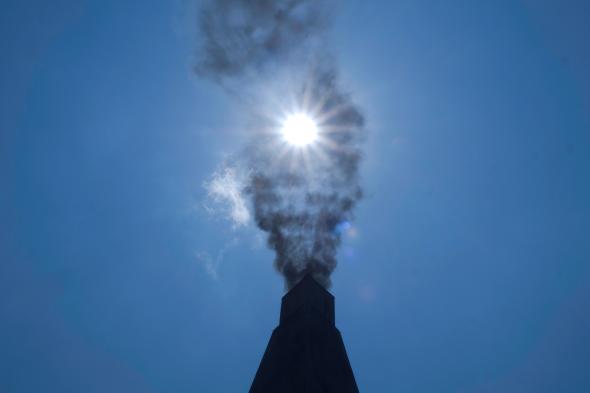
Smelters like this are notorious for emitting high concentrations of lead and other toxic substances into the air. Lead, a major component of vehicle batteries, has long been known to harm brains, with even low doses linked to learning and behavioral problems in children.
The unlicensed operations illustrate how difficult it is in Indonesia to clean up even well-known hazards. Local government officials relocated the lead recyclers here in 2011 to end an even more hazardous practice: backyard battery smelting in the nearby village of Pesarean. For 44 years, villagers there smelted lead acid batteries in their yards and homes, turning their historic metalworking village into a toxic waste site.
The contamination remains, surrounding an important historic site, the tomb of Amangkurat I—the ruthless sultan of Mataram who ruled the Islamic kingdom of Java for more than two decades in the mid-1600s.
During the sultan’s time, Pesarean was famous for the manufacture of Javanese daggers, known as kris.
Its long tradition of metalworking continues with dozens of household smelters that still operate in the village. Shops in the surrounding villages are filled with pots, knives, and other metal goods made in the historic village.

High Risk for Children
Recycling of lead acid batteries is one of the major toxic problems plaguing Indonesia, along with much of the developing world, says Richard Fuller, founder and president of Pure Earth (formerly Blacksmith Institute), a New York-based nonprofit that is helping to clean up the village. Tens of thousands of battery smelters are operating without environmental safeguards worldwide, he says.
The World Health Organization estimates that lead exposure contributes to 600,000 new cases a year of intellectual disabilities in children. Health experts say there is no safe exposure level for lead and that even relatively low levels can cause serious, sometimes irreversible, damage to developing brains.
In addition to learning problems and reduced IQs, children exposed to lead have a higher risk of attention deficit hyperactivity disorder and antisocial and criminal behavior, says Bruce Lanphear, a professor at Simon Fraser University in Canada and a leading expert on lead exposure.
Scores of illegal battery recycling facilities operate in Indonesia, including 34 in the greater Jakarta area alone, according to Pure Earth. All 10 of the country’s worst toxic sites are battery recyclers, the group says.
Tuti Hendrawati Mintarsih, director general of hazardous waste in Indonesia’s Ministry of Environment and Forestry, acknowledges the problem but says authorities can’t close illegal smelters because too many people would lose jobs and the operators would move to new, hidden locations.
This is a “social problem,” she says. “When we remind them not to operate the illegal smelter, we should help them find an alternative job.”
Toxic Village
Today in Pesarean, which is home to about a thousand people, gray soil is everywhere. The dusty footpaths where children run barefoot are dark gray. Fire pits where batteries were burned dot the village. Gray piles of ash and dirt sit where they were dumped years ago. The water in the small village creek runs gray, spilling its waste into a larger stream that flows into the rice fields.
There are about 200 houses in the village, many of them built on contaminated soil. Even now, residents are building new houses on top of the lead waste.
“It’s poisoning the soil, it’s poisoning the water, it’s poisoning the air,” says Pesarean village head Agus Sustono, 38, who pushed for an end to the battery smelting. “We can see it with the naked eye.”
Sustono warned residents not to drink the groundwater because of the high lead content. But children say no one has told them not to play in the dirt.
Lead exposure of this magnitude is a “huge and pervasive problem,” says Lanphear. “The gray dust undoubtedly contains high concentrations of lead that contaminate the foods people eat, [and] the air they breathe.”
Although battery smelting has been banned in Pesarean since 2011, lead levels in the soil remain high from the four decades of backyard smelting.
Pure Earth, which has helped clean up contaminated sites in Indonesia and other countries, recently tested 500 locations in the village and found that lead exceeded 100 parts per million in all of the sites. Soil near the village high school measured 5,000 parts per million. A former smelter site 50 yards from the school entrance measured 150,000 parts per million. By contrast, the U.S. Environmental Protection Agency’s standard is 400 parts per million for lead in outdoor play areas and 1,200 parts per million for non-play areas.
Blood tests of 46 villagers conducted by Pure Earth last year showed even higher lead levels than in 2011, when the smelting stopped. The average lead level in the blood of people in Pesarean last year was 39.3 micrograms per deciliter, far higher than the 5 micrograms per deciliter used by the U.S. Centers for Disease Control and Prevention as a guideline for action to protect children from neurological effects.
The aid group and the Environmental Agency of Tegal Regency are drafting a $2 million cleanup plan for Pesarean that would remove about 20,000 cubic meters of contaminated dirt and cover it with clean soil. Work is expected to start next year.
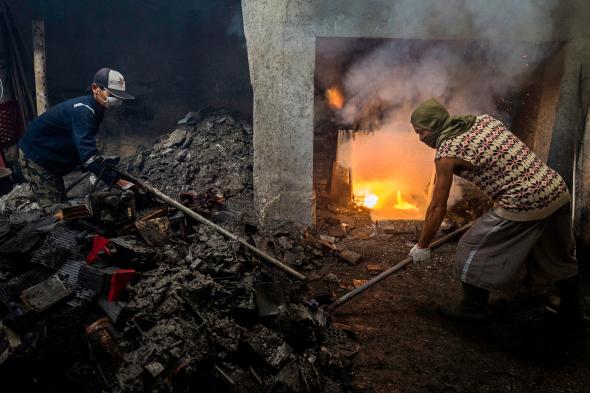
Though lead smelting has ended in Pesarean, other metalwork continues. Women sort through piles of junk to separate aluminum, iron, and other usable materials. Men melt the metal over open fires to make ingots, sending acrid smoke into the air. Craftsmen work over small metal forges in the back rooms of their houses, making tools, cookware, machine parts, and anything else that might sell.
Fathoni, 51, who like many Indonesians uses only one name, has lived in Pesarean for 30 years. A former metalworker, he’s now the village gravedigger and has a side job performing massages to relieve hernias. When the battery fires were blazing, he says, the air burned his lungs and made breathing difficult. He remains concerned about how the lead may affect his three grandchildren.
“I’m very worried,” he says. “I know the land is contaminated, and we can’t drink the groundwater. The government should do the cleanup immediately.”
But his neighbor, Sudiono, 75, a longtime smelter operator in Pesarean, says concern over lead is unwarranted. Villagers have been building homes on the gray soil for years, he says, and he doesn’t know anyone who has been harmed.
“I started this kind of business when I was 18 and nothing has happened to me,” he says. “People today are looking for problems.”
Three New Smelters
Down the road in Kebasen, the three new battery smelters can process thousands of batteries a day, from other parts of Indonesia. The Tegal environmental agency chose the 16-acre site to replace Pesarean’s home-based smelting, although two of the smelters were established unofficially.
All three operate within a compound run by Lut Putra Solder, or LPS, which also manages its own recycling ventures, often in primitive fashion. In one section, men wielding long sticks melt aluminum cans and bottle caps over open fires, the harsh smoke rising in clouds around them. In another, men make paving stones with slag from the lead smelters.
The largest of the battery smelters is run by a company that does not officially exist, at least on paper: It has no name or permit to operate. Nevertheless, Bukitun, the facility’s manager, welcomed unexpected visitors and was happy to explain his operation.
The smelter is a cavernous room with two furnaces and stacks of discarded battery casings. The workers each sit on a battery casing on the floor and swing small axes to split open the batteries and remove the lead cells. The acid is dumped beforehand into a cement pond outside, Bukitun says.
Other workers shovel the cells into the furnaces. After the lead melts, they pour it into trays to make ingots. The lead is bought by a company that makes fishing weights and air gun pellets.
He says his 10 workers earn the equivalent of $4 a day, more than most laborers make in the business.
Bukitun says that the smelter, which opened in early 2015, recovers about 50 percent of the batteries’ weight in lead and another 40 percent in slag. The rest of the material goes up in smoke, he says. The 90-foot-tall (27-meter-tall) chimney has no scrubber, but a nozzle mounted near the top squirts water on the smoke as it exits.
“It sprays the smoke so the lead dust falls down,” he says.Experts say such a system does little to capture lead particles. Bukitun says he’s open to suggestions on how to reduce the contamination. He wouldn’t mind financial assistance either.
“We need guidance if there is something better we can do,” he says.
Bukitun says the company operates under LPS’s permit. But Riyanto, the LPS operations manager, says that isn’t correct. His company’s permit doesn’t cover any of the battery smelters, he says, and each smelter must apply for its own. “If they were under the LPS permit,” he says, “they would need to add safeguards.”
Residents in nearby Tegalwangi began complaining to LPS about smoke from the facility’s operations before the battery smelters opened. Now they say the air quality is even worse with the three smelters.

“When I am in the field, the smoke is very thick,” says Suharti, 65, who grows rice near the recycling center. “It’s hard to breathe, and my eyes sting. It smells like plastic is burning.”
Riyanto says LPS periodically distributes milk and rice to the residents of nine nearby villages as compensation for the pollution.
Pure Earth says it is working with the government on a plan to consolidate the smelter operations at one facility and install a scrubber on the chimney.
Agus Subagyo, head of the Environmental Agency of Tegal, says he hasn’t moved to shut down the smelters for operating without permits because he doesn’t want to see a return to backyard battery smelting. The permit process is costly and time-consuming for the companies, he says, but he will push them to comply.
“In the old location, people were smelting batteries inside their houses, and it was very bad for their health,” he says. “Moving them to a special industrial zone is the best way to make it healthier and cleaner, although we still need some improvement.”
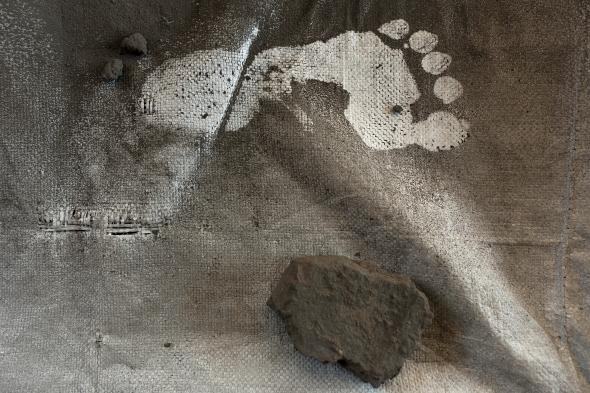
No Rules
On the northern edge of the LPS compound, the floor of the Garuda Jaya smelter is slippery with battery acid. The workers try to avoid the smoke as it surges into the room.
Daniel Rizal, 26, the manager, says his company came here in 2013 because it could operate without government interference. “In Tegal, there are no rules about smelting lead,” he says.
He says the lead hazard doesn’t trouble him. “I’m more worried the government might shut us down,” he says. “I have a family to feed.”
Outside, half-hidden in weeds, a sign erected by a local agency reads: “Warning…!!! Pollution and environmental contamination are damaging our future generations.”
Behind it, lead-laced smoke pours from the Garuda Jaya chimney.
[This story was published in National Geographic on May 31, 2016. Reprinted with permission. Copyright © 2016 National Geographic Partners, LLC.]

Philippines: At End of Crude Air Hose, Underwater Gold Miners Risk All
By Richard C. Paddock. Images by Larry C. Price.December 2013
SANTA MILAGROSA, Philippines—Brian Mullaton is 13 and makes his living by diving into deep, muddy holes.
He works on a floating wooden platform in shallow Mambulao Bay in one of the world’s most dangerous professions: compressor mining.
On a typical day, he earns the equivalent of $5.
“Sometimes I am scared to go down because of the possibility it will collapse,” said Brian, the fourth of nine children. “But I like the job because I get money. I give the money to my parents for food.”
Compressor mining originated in the mid-1990s in Camarines Norte, an impoverished coastal province about 200 miles southeast of Manila.
Divers dig down as far as 60 feet while breathing through a tube connected to a homemade compressor, typically fashioned from a San Miguel beer keg. They dig in rice paddies, rivers, and bays, and stay underground for hours at a time. Their job is to fill bucket after bucket with soil for a fellow miner to haul up to the surface. Some miners wear a diving mask; many just keep their eyes shut.
‘No choice’
The job is hazardous, the returns are paltry, and they say their work is illegal. But that doesn’t stop the miners—mostly adults and some children—from diving into the mud to find gold.
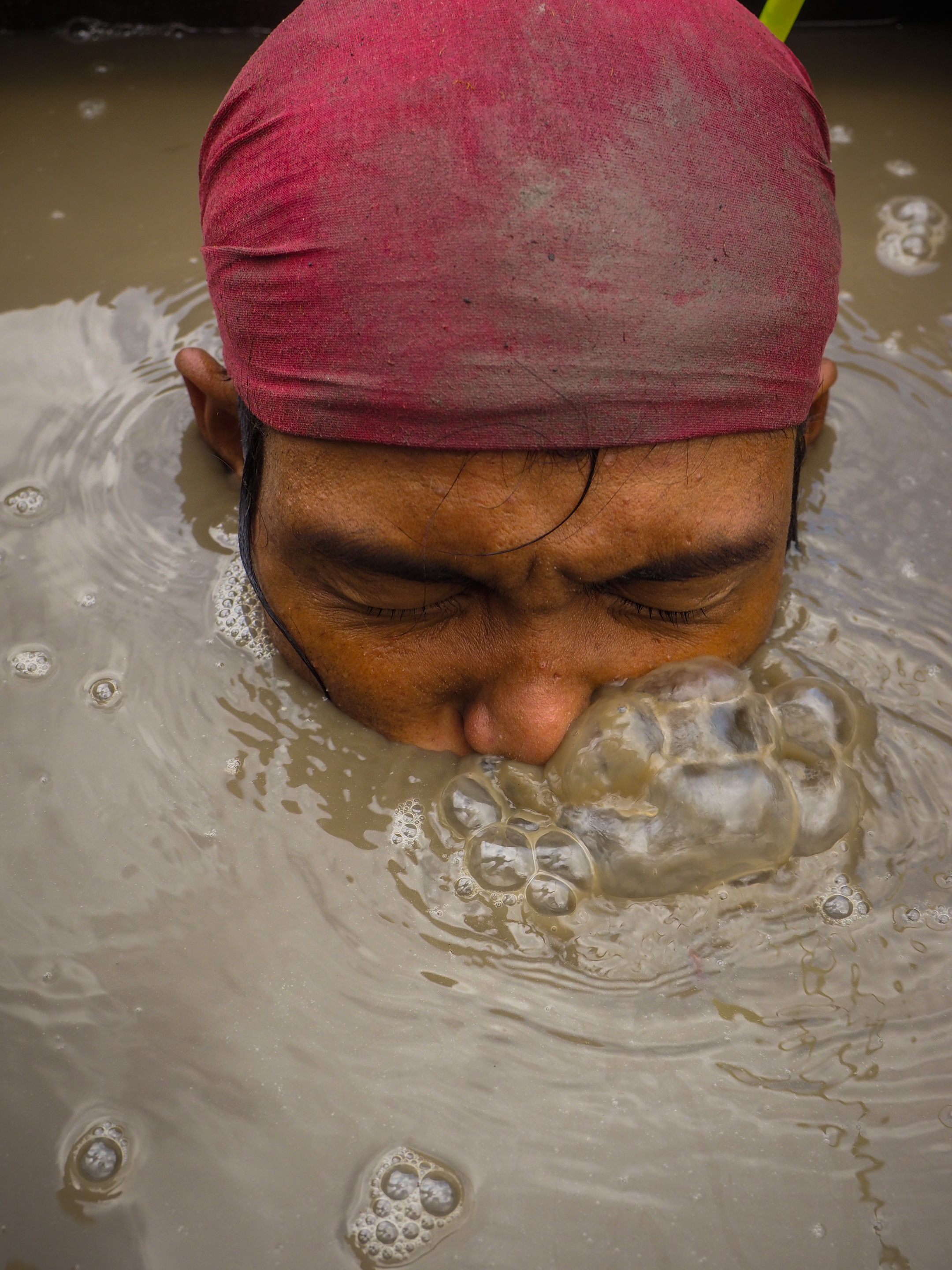
“We have no choice,” said Rafael Ramorez, 16, who dropped out of high school in his freshman year to work as a miner. “There is no other job.”
Rafael spoke as his cousin Jonathon Ramorez, 12, stood waist-deep in the murky bay with a wide wooden pan he uses to separate gold from sediment. In his teeth, he held a plastic bag containing a small lump of mercury and gold, the product of the crew’s work for the day.
Jonathon, Rafael, and Brian are among a million children worldwide who work in the hazardous occupation of mining, according to an estimate by the International Labor Organization, a United Nations agency.
The Philippines banned compressor mining in 2012. The crews operate outside the law by employing children and using highly toxic mercury. At Mambulao Bay, miners say they stay in business by paying police agencies the equivalent of $11 a month for each worker. Local officials say the miners are issued permits.
More than 400 miners work from 40 rafts of wood and bamboo anchored on the bay near the village of Santa Milagrosa. Typhoon Haiyan, which ripped across the Philippines in November and left thousands dead, had little effect on these miners. The center of the storm passed more than 260 miles south, halting the mining for only a day.
Most of the miners’ rafts have a blue plastic tarp stretched overhead to block the tropical sun, giving the place the look of a floating encampment. The workers get around in wooden canoes, which double as tubs for breaking up the sediment.
Inspired by fishermen
Boys and girls as young as 10 work alongside adults in crews of about a dozen. Children usually do the less strenuous jobs, such as panning for gold while standing for hours in the filthy water.
The $5 the miners make in a typical day is more than they could earn at other unskilled jobs in the impoverished region—if they could find jobs.
Compressor mining was inspired by Filipino fishermen who use compressors to breathe underwater while catching reef fish. The beer-keg compressor is connected to a small motor designed for pumping well water. Miners loop the air hose around their shoulders and hold the end in their teeth.
At the surface, the tunnel opening is small—barely three feet square. After the divers descend into the hole, it is impossible for them to see. Operating by feel, they shovel dirt into a rice bag.
Once they reach a layer of dirt where there might be gold, they dig sideways, heightening the danger of a collapse.
Compressor mining poses a range of health risks, especially to children who dive.

When a diver is underwater, nitrogen bubbles can form in the bloodstream and travel to the brain and lungs, causing many small patches of damage. The problem is worsened if the compressor motor unexpectedly stops and the diver rushes to the surface for air.
Diesel fumes, carbon monoxide, and other pollutants can enter the hose and foul the air the divers breathe, sometimes with deadly effect. Miners on Mambulao Bay say the man who thought up compressor mining died from inhaling oil through his hose.
Divers can suffer skin infections or maladies such as leptospirosis from immersion in the dirty water, which often is tainted with animal waste and teeming with bacteria, said Julie Hall, World Health Organization representative to the Philippines.
“For somebody to be spending a lot of time breathing poor-quality air, under pressure, under the water, and exposed to all of these bacteria and other bugs in that dirty water, this clearly poses a significant health risk,” Hall said during an interview at her Manila office. “And particularly for young people, if they are doing this repeatedly, it is likely to affect their development.”
Compounding the risk to miners, the mercury they use to extract gold from the sediment is highly toxic and is known to cause tremors, memory loss, and brain damage, among other symptoms.
“You can’t reverse mercury poisoning,” said Richard Gutierrez, executive director of Ban Toxics, an environmental group seeking to end mercury use in the Philippines. “Brain cells are destroyed and can’t be replaced.”
Divers say their greatest fear is a tunnel cave-in. They tell of two men who were crushed that way.
The biggest disaster was in November 2012 in Paracale, a coastal town east of Mambulao Bay where miners had dug about 100 shafts on the beach and offshore. Some tunnels collapsed, and seawater rushed in. Three bodies were recovered, but some accounts suggest the toll was higher.
Government investigators concluded a miner working illegally had used explosives and caused the collapse. The deaths drew national attention, and authorities banned all mining at Paracale. But compressor mining continues elsewhere.
About five miles inland from central Paracale, in the farming village of Tawig, an extended family of 16 miners has set up operations in the waterlogged soil between a rice paddy and the Bacung River. The crew includes cousins Edlyn Ortiz, 12, and Elias Delima, 15.
The group has been mining for several days in a grove of nipa, a small, sturdy palm common to riverbanks. The ground is pockmarked with holes brimming with brown water. They look like puddles but are as deep as 40 feet.
Two divers send up buckets of dirt. Family members shovel the dirt into a tub, break it up with their feet, run it through a sluice box, and pan the sediment for gold dust.
A family business
Five-year-old Ernie Delima plays in the mud and helps by hauling water and moving dirt.
Older brother Elias, who left school in fourth grade to work in the family business, said he occasionally takes the hose in his teeth and dives. “I just want to go in and help,” he said.
Still, he said, the muddy tunnel is unnerving.
“I feel scared,” he said. “I am afraid because maybe the tunnel will collapse. It is very hard to breathe.”
The diver gets a double share of the earnings, and Elias said he once earned the equivalent of about $23 in a day. But, he concedes, “I’d like to find another job.”
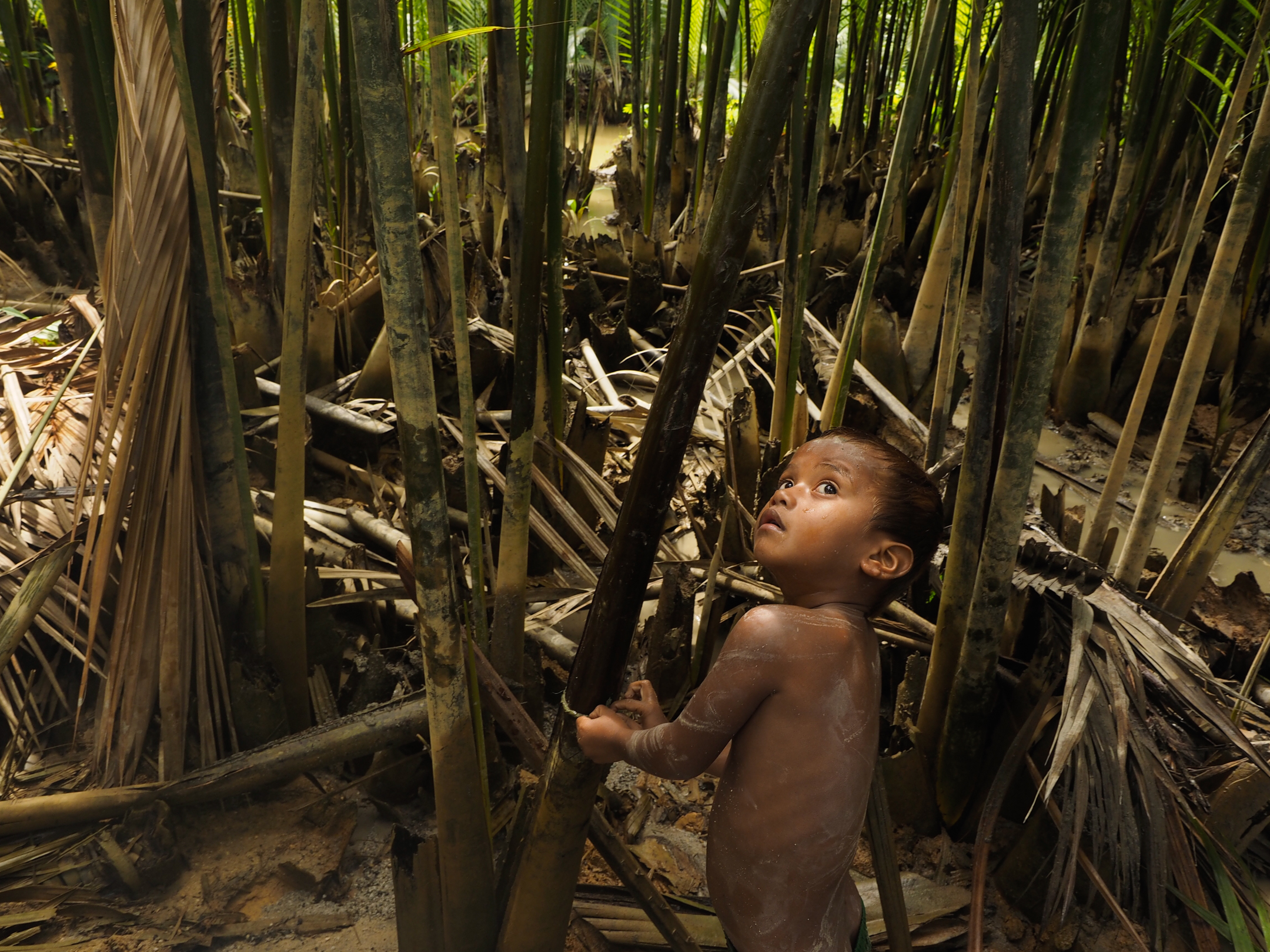
Dindo Leche, 20, married into the family of miners. He said he began diving at 14. “I had no choice,” he said. “We needed to support the family.”
He said he was afraid at first. His longest stay underground was six hours.
“I don’t feel anything inside the hole, just cold,” he said, adding: “I feel a little afraid that it will collapse. A lot of the time, the soil collapses.”
At day’s end, Leche takes the gold-laden sediment they have all collected, mixes it with mercury, and swirls it in a wooden pan. Squeezing out the excess mercury through a piece of nylon, he ends up with a lump of metal smaller than a wad of chewed gum. Later, he will burn it with a blowtorch to vaporize the mercury.
It is one last hazard the family faces in a long day of mining.
[Journalists Larry C. Price and Sol Vanzi, in Manila, contributed to this article. This story was produced in collaboration with the Center for Investigative Reporting (https://www.revealnews.org/). It appears on the Pulitzer Center site: https://pulitzercenter.org/reporting/philippines-end-crude-air-hose-underwater-gold-miners-risk-all]

Chapter 7: Pollution in the U.S.
Debbie M. Price and Larry C. Price take us to Gloversville, New York, and Catawba County, North Carolina, to report on both the decline and resurgence of the local economies in areas once plagued by industrial pollution. In the late 20th century, upstate New York experienced the collapse of the leather industry; at the same time North Carolinians suffered from a loss of jobs in the textile industry.
Yet both areas are now rebuilding their economies after the decline of manufacturing and the rise of environmental regulations. By embracing customization, specialty production, and automation, tanners and leather producers in Gloversville and textile manufacturers in Catawba County have survived and modernized.
As Debbie and Larry Price report, companies and investors are pledging to create cleaner supply chains—making these communities more appealing and more sustainable. Waste treatment programs and technology solutions result in less pollution and fewer health risks to workers. The number of jobs, some of them high-paying, is increasing, and worker productivity is up. Companies are capitalizing on the popularity of “Made-in-America” while avoiding tariffs and the rising cost of wages in developing nations.
What they have found is “a renaissance fueled by innovation.”
-R.K.

In Upstate New York, Leather’s Long Shadow
By Debbie M. Price. Images by Larry C. Price.February 2017
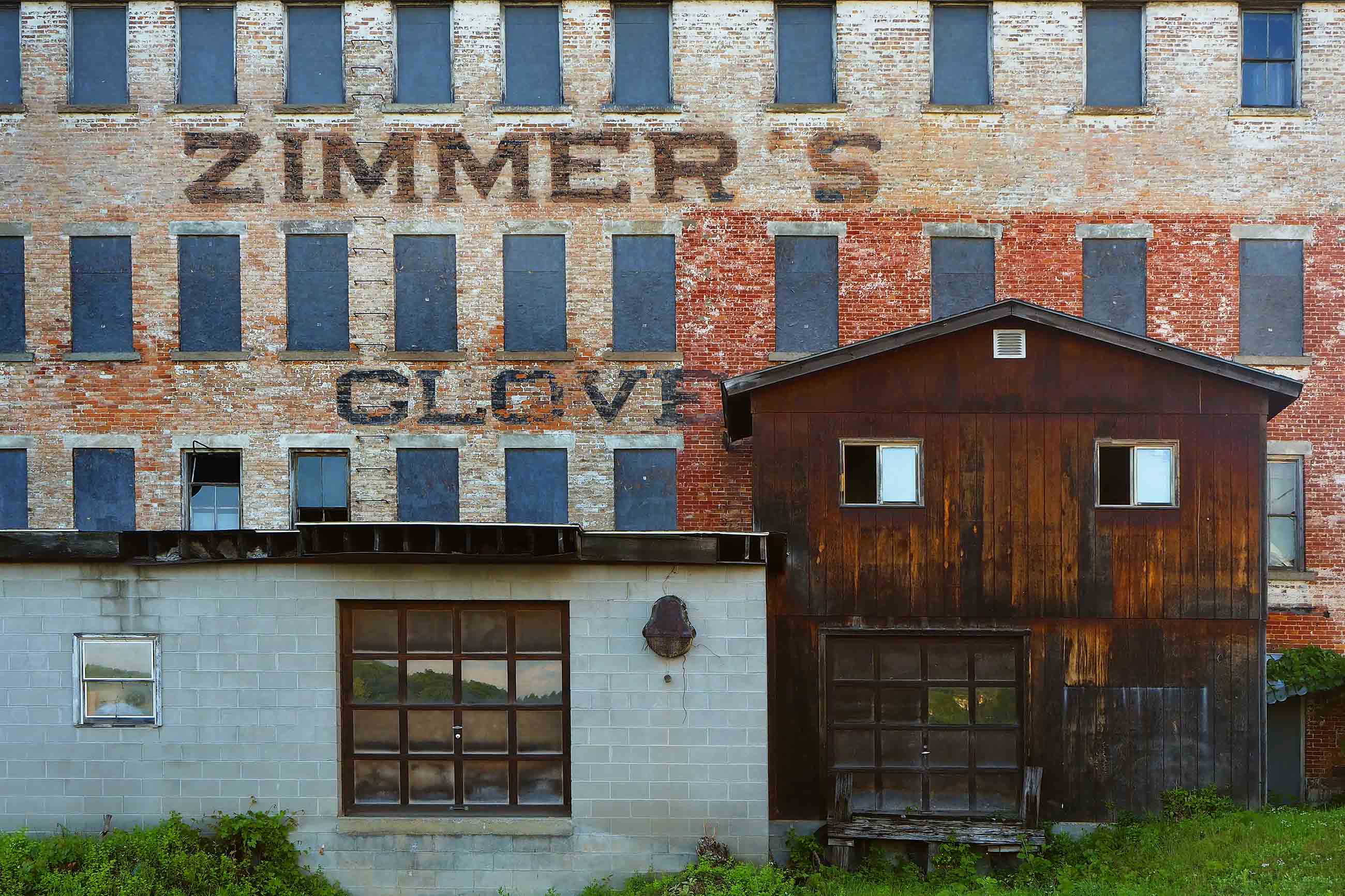
It was as if a meteor had struck the tanning industry. For more than a century, leather production had been the great engine that powered the regional economy of upstate New York. And then, almost overnight, it seemed, the tanneries were gone, as one shop after another fell in the 1980s to global competition and strict new environmental regulations. Gloversville—once the glove-making capital of the world—sank into a deep depression, perilously close to extinction itself.
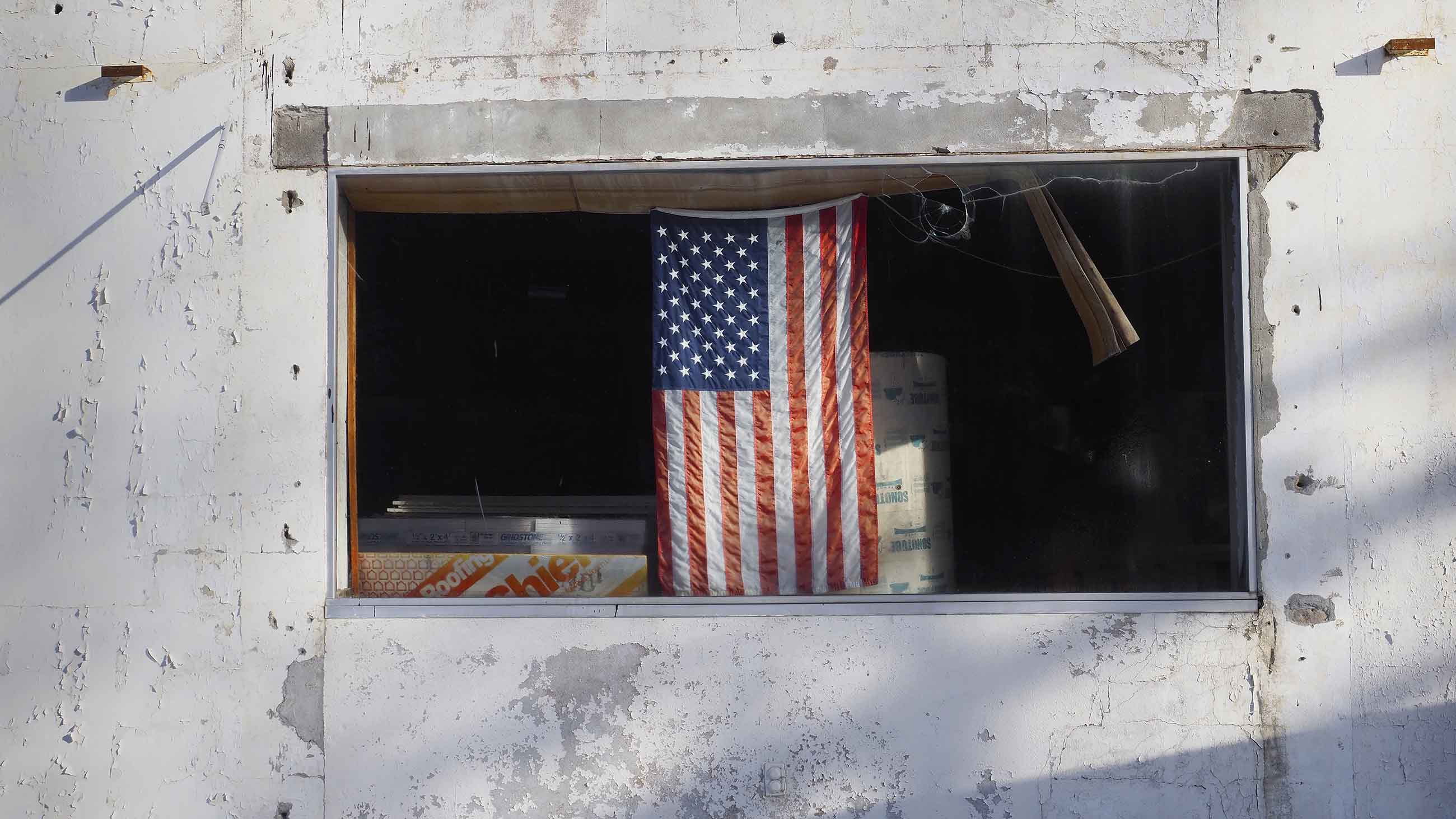

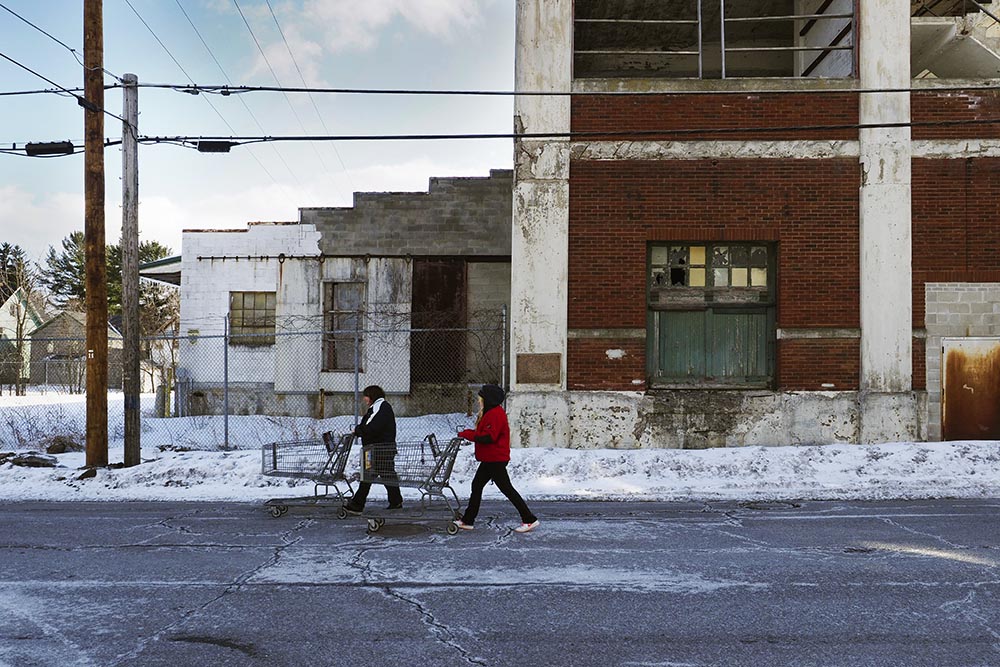
In the decades since, the survivors of the cataclysm have struggled to clean up and rebuild. True to form, in commerce as in nature, small mammals emerged on a landscape devoid of dinosaurs, and today, at least a few of them are thriving.
“I don’t think anyone is looking to bring back the tanning industry,” says Gloversville Mayor Dayton King. “But Gloversville and Fulton County are definitely coming back.”
The story of Gloversville is the story of small manufacturing communities across America, dealt near-fatal blows by the offshoring of jobs to markets in developing nations with cheap labor and lax environmental controls. Ironically, just as some American manufacturing regions are staging modest comebacks, those early offshore markets are facing their own Gloversville moments, squeezed by competition from other countries and growing environmental regulation at home.
The Hazaribagh district of Dhaka, where about 90 percent of Bangladesh’s leather is produced, is a prime example. Like their Gloversville counterparts decades ago, Hazaribagh tanners face growing competition and government orders to stop polluting local waterways or cease operations entirely. How long that transition might take is an open question, but once the tanneries are gone from Hazaribagh, the Bangladeshi government will have a monumental cleanup—far worse, to be sure, but not so different from what federal and state authorities found in New York. The parallels between Gloversville then and Hazaribagh now are more than ironic or coincidental; they are instructive.
“Growing up in a leather town was exciting. We were the leather capital of the world,” says Mark Kilmer, president and CEO of the Fulton Montgomery County Regional Chamber of Commerce. “The survivors of the business have had to think out of the box and reinvent themselves and become more specialized.”
At the dawn of the 20th century, Gloversville—named for its glove-making industry—was said to have more millionaires per capita than any other city in America. Whether that is truth or legend, one thing is certain: Tanning and glove making made many families very wealthy and employed the vast majority of the town’s work force. About 90 percent of the gloves sold in America between 1880 and 1950 were made in Gloversville, which by some estimates had more than 100 leather and glove companies at its peak.
The tanneries turned out supple leather for glove makers, and back in the day before the Environmental Protection Agency, they pumped their wastes, chemicals, and filthy water straight into Cayadutta Creek at the rate of 2 million gallons a day. Stories abound of the river changing color with the dyes and foaming up into sudsy crests 10 feet high.
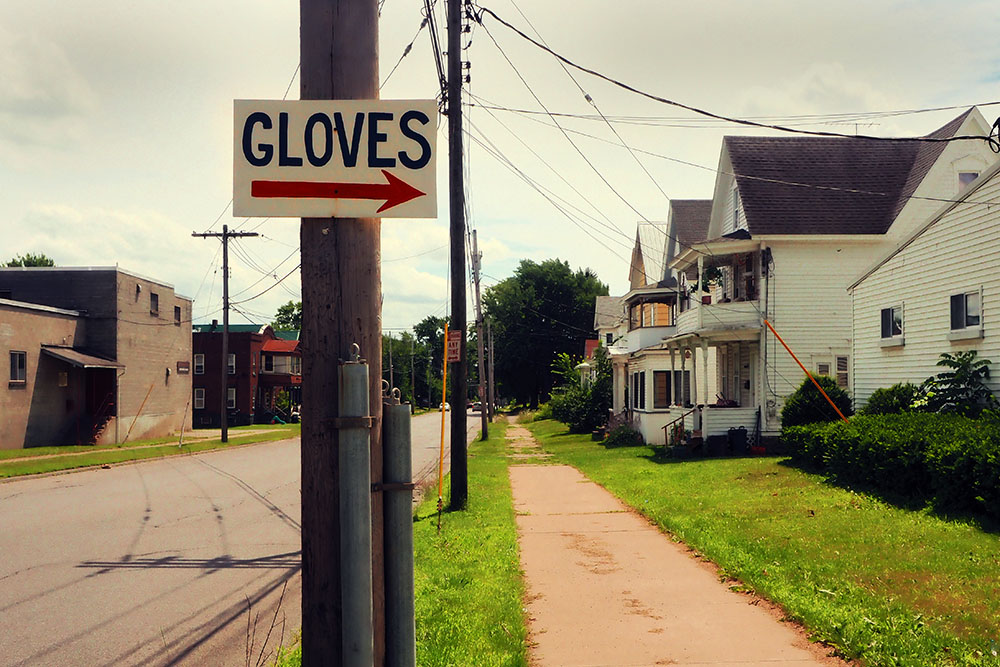
A young Neil Sheehan described the Cayadutta in a 1964 New York Times article as “thoroughly poisoned with sewage and household detergents and with animal grease, flesh, hair, dyes, and chemicals from its tanneries.” Sheehan’s reportage, seen through the lens of history, is eerily prescient. He tagged Gloversville as “an example of the man-made water pollution” that the state’s $1.7 billion Pure Water Program was designed to combat, and lamented that but for the contamination, a drought-stricken upstate New York would have plenty of water to drink.
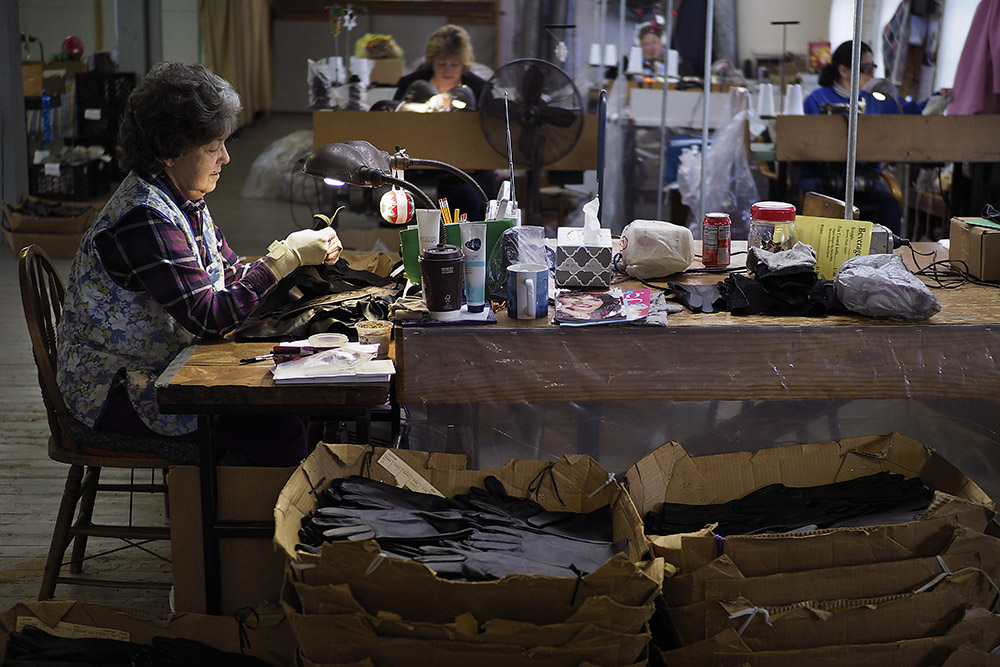

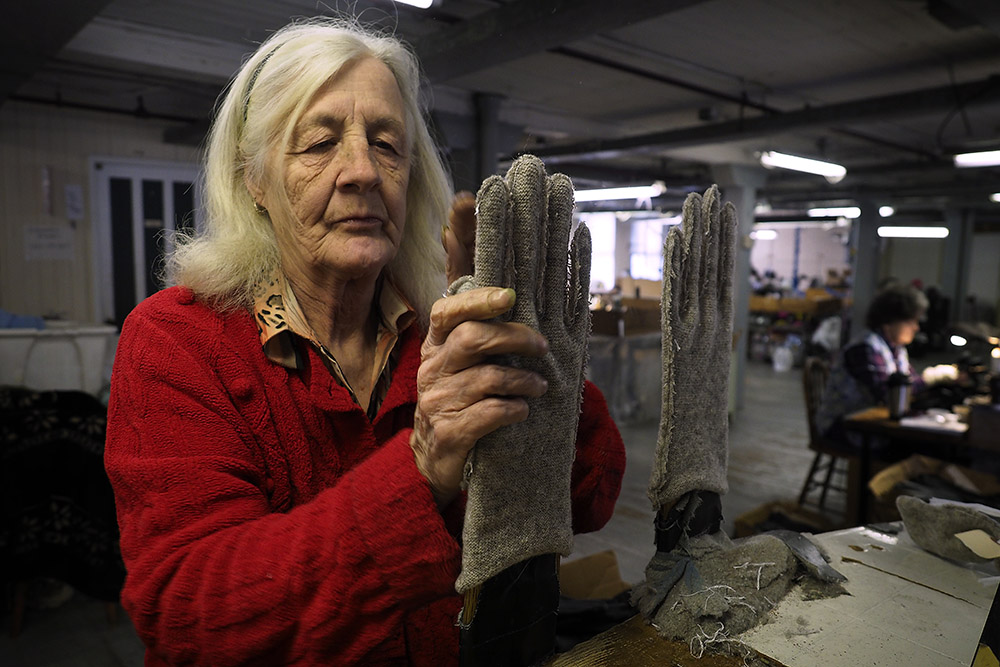
The final blow for Gloversville’s tanneries came with the federal Clean Water Act of 1972 and subsequent state and local laws that ultimately required industries to have their own effluent treatment systems. Most tanners, already losing business to cheaper suppliers overseas, saw no reason to spend a million dollars or more for a wastewater treatment system. Others borrowed heavily to finance the equipment, only to bleed out slowly.
“That was pretty much the definitive line in the history of tanning in the county,” says Matthew Smrtic, owner of both Sunderland Leathers, a leather buyer, and the Colonial Tanning Corporation, one of the county’s few remaining tanneries.
Gloversville lost more than a third of its residents, shrinking from a peak population of 23,634 at the 1950 Census to just 15,665 people in 2010. The glove-making industry was the first to go, its business siphoned off by factories in Asia. The tanneries followed, and by the 1990s unemployment was as high as 13.5 percent. The official unemployment rate has come down to an average of 5.7 percent in 2016. But locals say the rate doesn’t tell the whole story; many people have aged out of the workforce or stopped looking for jobs. About 24 percent of the town’s families were living in poverty in 2010, according to New York state demographic data.
Smrtic’s father-in-law, a longtime Gloversville tanner, was one of the survivors. He installed treatment systems, scaled back during the hard times that followed, and kept operating the tannery, which Smrtic and his wife now own. Smrtic weathered choppy economies in the 1990s and early 2000s by identifying and successfully exploiting a niche market for high-quality American deer and bison skins. Sunderland Leather buys raw deer and bison hides, sends the skins to Colonial for tanning and coloring, and then sorts the tanned leather for sale to luxury goods manufacturers, mostly in Italy and China.
“You have to have a specialty,” Smrtic says. “The commodity stuff comes out of China or Vietnam or wherever the next low-wage, low-regulation place is.”
The common denominator for Gloversville’s remaining tanners, leather finishers, and glove makers is quality custom work. Townsend Leather in nearby Johnstown produces performance aircraft upholstery leather. Daniel Hannis, president of Adjon Inc., handles sheep and goat skins, sending the raw hides to Colonial for tanning and selling the finished leather for high-end fashion and military gloves. Brent Heroth, who opened Brooklynn Custom Leather Works about a year ago, paints and stamps patterns into leather for furniture makers and interior designers.
“I was a little kid when the industry was strong, and I’ve seen it take a dive,” Heroth says. “I keep doing the small things that the bigger places don’t want to be bothered with. People are looking for custom and quality, and I can give them that.”
Samco, one of Gloversville’s last remaining glove companies, makes leather dress gloves for the U.S. military, turning out more than 100,000 pairs a year, by hand, on traditional sewing machines. The company’s co-owner, Richard Warner, went to work in the glove business straight out of high school in 1979. He was hired as superintendent at Samco in 1996 when its owners, Salvatore and Ila Greco, decided to expand. At its peak, Samco employed 75 people but now is down to 35, largely because sewing machine operators are hard to find, Warner says.
“The only thing that has saved us is that clothing for the military has to be made in the USA,” Warner said. “Otherwise, we wouldn’t be here.”

Glove making was always considered the upper-crust industry in town. Men wore white shirts and ties to work in the glove factories, in sharp contrast to the tanners who returned home at night reeking of animal hides and chemicals. The money was better too, allowing many families to send their children to college. City Councilman Vincent DeSantis grew up in a family of glove makers and came home from college each summer to work in a tannery, his father’s way of encouraging him to finish his degree.
“The tanners worked very hard physically in very rough conditions,” DeSantis says. “Sometimes when you’d walk past a tannery or in the neighborhood of a tannery, you could smell that smell of unfinished leather and the smell of tanning.” The dirty tanning of old killed the fish in Cayadutta Creek and left Fulton County with more than two dozen abandoned and contaminated industrial locations designated for cleanup as federal Superfund or brownfield sites. Several still await remediation.
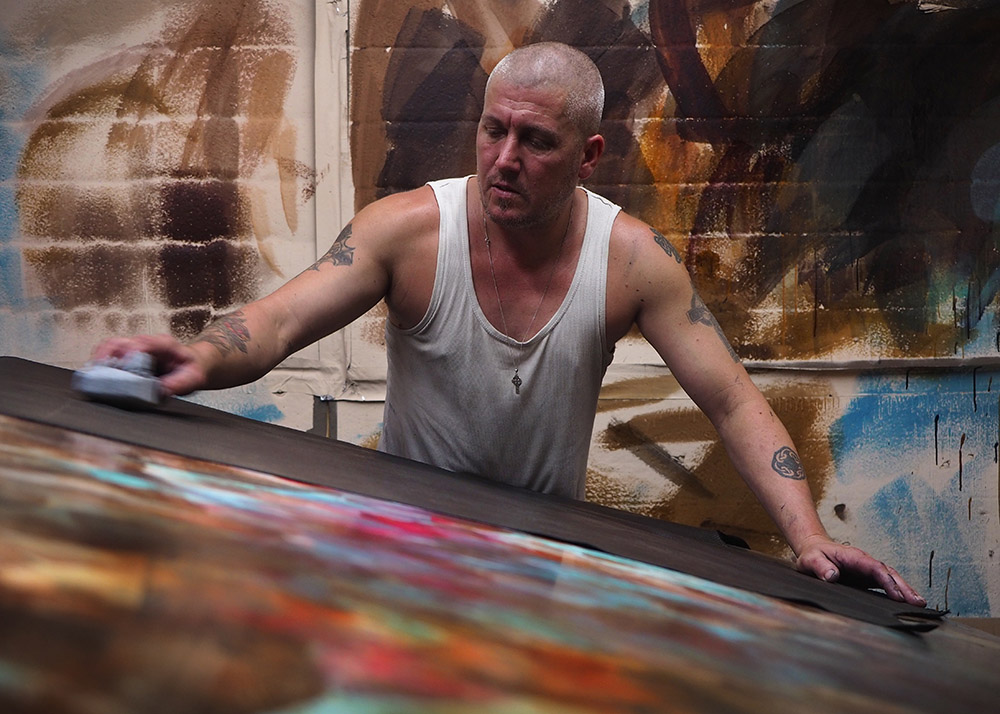


“They said our city smelled so bad because of all the chemicals, but nobody complained because everybody had money,” says Mayor King.
Then, in 1989, as tanneries continued to shutter, a report by the Centers for Disease Control and Prevention sent ripples of fear through the community. The CDC reported that tanners on the finishing line who used the solvent dimethlyformamide (DMF) could be at increased risk of testicular cancer. The CDC based its findings, in part, on three cases of testicular cancer diagnosed in workers at a Gloversville tannery. Fulton County medical records added another seven cases to the total. Half of the cancer patients had worked in tanneries. The New York Times reported at the time that the tannery in question had stopped using DMF dyes, as had other nearby facilities, but that did little to assuage anxiety.
Fulton County Sheriff Richard Giardino, who grew up in Gloversville, said he had friends with testicular cancer who had worked in the tanneries or leather shops. “It was definitely a concern,” he said. “Everybody thought that was where it came from.”
Today, leather processing in the United States is highly regulated. Smrtic’s Colonial tannery workers wear protective equipment, masks, and gloves and, most of all, manage the chromium solution carefully to ensure that the chemicals are fully absorbed by the leather and not wasted in the bath. The tannery uses a multistage process to treat its effluent, separating solids, removing sulfides in a contact tank, adjusting the pH balance, filtering and clarifying (twice), and testing the water before discharging it into the closely monitored municipal wastewater system. Even Heroth’s small shop has to have a monitored wastewater permit.
The Cayadutta Creek now is a sparkling trout stream and with the Mohawk River (also much improved) provides abundant water for Fulton County’s growing dairy-products and food industry. Fage USA, a maker of Greek yogurt, and Euphrates, a feta cheese company, opened plants, attracted in part by the extensive water and sewer infrastructure built originally for the tannery industry. Pata Negra, a Spanish cured meat company, is making chorizo in Gloversville.
A Walmart distribution center in Johnstown and a Target distribution center in neighboring Montgomery County have brought jobs to the area. The county is also wooing Internet businesses and light industry, touting affordable housing, beautiful scenery in the foothills of the Adirondacks, proximity to New York City and shovel-ready sites.
Gloversville has an ambitious downtown redevelopment plan that calls for renovating the city’s grand old buildings and revitalizing nearby homes to create a vibrant community where residents can walk to shops and restaurants. The Mohawk Harvest Cooperative Market has opened in Memorial Hall, an opera house built in 1881, and DeSantis expects more businesses to follow.
“I saw Gloversville when it was really booming and everybody was working,” says DeSantis. “Then I went away to school and to the Army and came back to practice law in 1978. And Gloversville was declining and really kind of bottoming out in the 90s. It’s been in a funk. And now, to see Gloversville bootstrapping itself up in the 21st century, well, that’s an exciting thing.”

[This story first appeared in Undark on February 22, 2017: https://undark.org/article/leathers-long-shadow-gloversville-new-york/]

In Appalachia’s Foothills, a Leaner Textile Industry Rises
By Debbie M. Price. Images by Larry C. Price.February 2017
The cavernous manufacturing room at InnovaKnits, a contract producer of knitwear in Conover, North Carolina, is empty save for four large flat-bed knitting machines, four linking machines, and four women. German-made Stoll machines knit like lightning, turning out bodices and sleeves for women’s sweaters. The workers deftly hook loops of yarn one by one over tiny pins on the linking machines, which seamlessly connect the sleeves to the bodices. It’s a tedious task and one of the last remaining jobs done by hand here.
“We might be able to take something off the machine so that it requires only one step of labor instead of 10 steps of labor,” says Jason Wilkins, co-founder and managing partner of the company. “Everyone knows the future is to do as much on the machine as possible,” he added.
Catawba County, North Carolina—a former textile production powerhouse decimated by offshoring—is enjoying a renaissance fueled by innovation, high-tech materials, automation, and custom work. Textiles are coming back here, but not the old jobs. “The state-of-the art plant in 1990 had line shafts with a leather belt running the knitting machines. Now we have robots closing the toes and that eliminates half the plant,” says Dan St. Louis, executive director of the nonprofit Manufacturing Solutions Center, a division of the Catawba Valley Community College.
The Manufacturing Solutions Center was established 27 years ago to transition hosiery workers from mechanical to electronic machines. In the textile mills, St. Louis recalls, well-paid employees known as “doffers” still raced around the spinning room replacing bobbins, a physically demanding job that could take 20 minutes per machine. Automation cut the chore down to two minutes and eliminated the doffer, just one of the many textile jobs that have disappeared from the scene.



Today, mills are hiring computer designers, software engineers, and people trained to program and operate the increasingly complex knitting machines—an in-demand job that can command a salary upwards of $80,000. The Manufacturing Solutions Center specializes in applied research and development, prototyping, testing, domestic sourcing, and of course, training for 21st-century textile jobs. “Our whole purpose and mission is to help create jobs here in the U.S.—bottom line,” says St. Louis.
In many ways, this is the story of manufacturing across the South, where automation is giving American companies, large and small, the edge needed to compete with cheap labor overseas. Made-in-America sentiment, along with rising wages in China, shipping charges, and tariffs are added incentives to do business at home for some large companies.
These include Walmart, which announced plans in 2013 to source an additional $50 billion worth of American-made goods over the next 10 years. Foreign investors from China, India, Canada, and Germany, among other countries, have opened or announced plans for factories in the South, attracted in large part by quality production, more manageable supply chains, and cleaner, less polluting technology. American mills, likewise, are selling their threads and textiles to factories in China and Southeast Asia.
Here in Catawba County, in the foothills of North Carolina’s Appalachians, inventors in the Manufacturing Solution Center’s business incubator are developing top-secret, futuristic fibers. And old-line knitting companies are solidifying their hold on niche markets with rapid delivery and custom production made possible by automation.
“They’ll say that we’re doing three times as much volume with one-third of the people,” says Nathan Huret, director of existing industry services for the Catawba County Economic Development Corporation. He adds that some of the mills are running 24/7, and “are more efficient, producing more and making better margins on some of their products.”
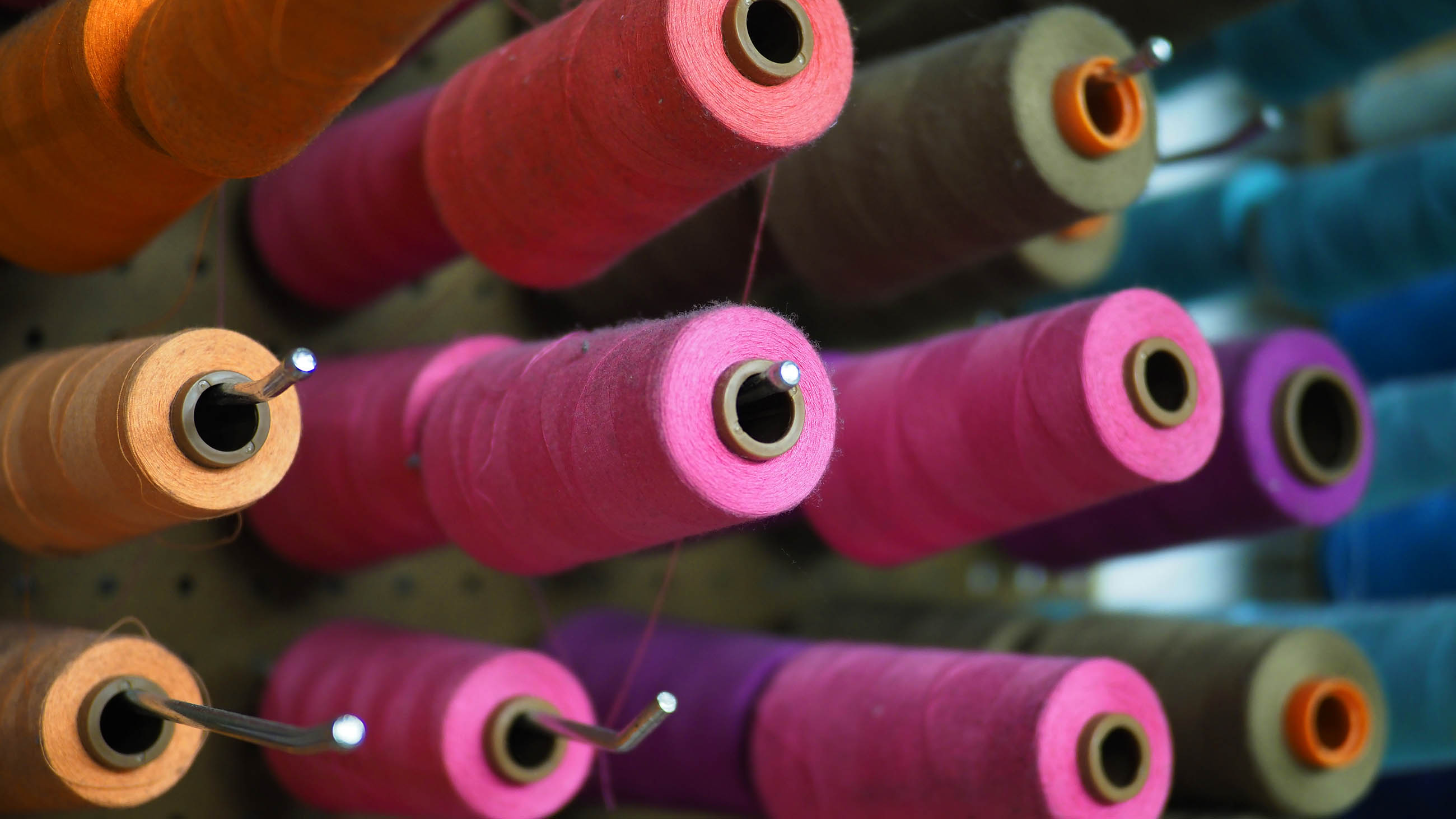
For all of this, the American textiles industry is still a shadow of its former self. In 1973, 2.4 million people worked in the textiles and apparel industry, according to Bureau of Labor Statistics. By 1996, that number was down to 1.5 million and dropping—fast. Between 1990 and 2016, the two industries combined lost almost 80 percent of their jobs, with 385,000 remaining today.
North Carolina, the nation’s leading textile producer, mirrored the national decline, losing 85 percent of textile jobs, from 284,000 in 1992 to just over 42,000 today, according to Bureau of Labor statistics. Catawba County, a textile center in a textile state, suffered a similar fate, going from 12,000 textile-related jobs in 1992 to just under 1,500 today, according to the Catawba County Economic Development Corporation. There were 156 textile-related companies then; now there are 48. With its furniture and fiber optic cable industries also taking a hit, the county’s unemployment rate skyrocketed from just over 2 percent in the early 1990s to 15 percent during the worst years before recovering to a current rate of 4.8 percent.
The state’s textile revenue, not surprisingly, fell to less than $3 billion in 2014 compared with an inflation-adjusted $7.5 billion in 2000, according to the U.S. Bureau of Economic Analysis.
At the same time, worker productivity in North Carolina has increased dramatically, up 61 percent from an inflation-adjusted $43,731 per worker in 2000 to $70,709 per worker in 2014, according to calculations derived from Bureau of Labor Statistics data. “It isn’t that we have to produce 10 times as much as we used to make. It’s that each thing we produce has to be worth 10 times more,” says Brad Seese, product development and brand manager at Fiber & Yarn Products in Hickory.
The mid-sized yarn company, which was established in 1980, reinvented itself to capitalize on the growing demand for technical fibers. Among its proprietary products are moisture-wicking yarn, a fiber that reduces friction, and a sewing thread innovation to reduce or remove torque to enable seaming machines to run faster. A single case of the company’s high-performance yarn sells today for as much as an eight-case pallet of ordinary yarn brought in 2000, Seese said.
“We keep looking for new ways to advance what the consumer is asking for,” says Seese.

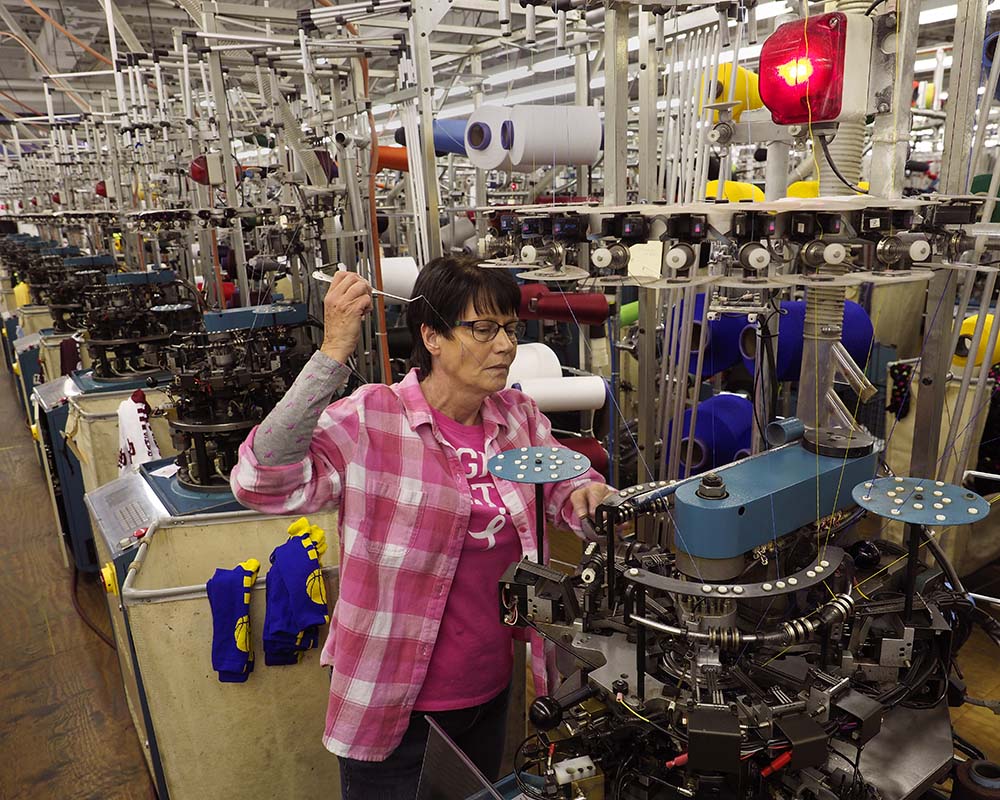
Textile-Based Delivery Inc., one of the startups in the Manufacturing Solutions Center business incubator, is developing fabrics designed to deliver controlled doses of medicine and other active ingredients. Jordan Schindler, the company’s 25-year-old founder and CEO, conceived the idea of infusing a pillow case with acne medicine while he was in college. Today, he’s talking about T-shirts that treat shingles and socks that control athlete’s foot. “Smart fabric,” says Schindler, “is where the industry’s going.”
Twin City Knitting in Conover, meanwhile, has been making socks for almost 56 years and still makes the same athletic tube sock it made in 1977. What’s different are the Italian-made knitting machines and computer software programs that enable the company to design and weave custom logos into socks for sports teams from Little League to collegiate sports. They can run a batch with as few as a dozen pairs, delivery by game day guaranteed.
“Do we compete with Nike, Under Armour, Adidas? Sure,” says company president Francis Davis. “But we’re the other guy because we can do small runs. We’re local and we have a strong customer base. We’re in your high school and my high school and the university.”
Of course, no one expects labor-intensive, large-scale garment manufacturing to return to the United States any time soon, but small cut-and-sew operations like Opportunity Threads in nearby Valdese are springing up to meet a growing demand for custom and small-batch production. The worker-owned company makes memory-quilts from old rock concert and logo T-shirts, turning out 600 to 700 units a week.
“I had just watched growing up in this community where one plant would shut down on a Friday … and on Monday, there were 500 people out of work,” says company co-founder Molly Hemstreet. “I said we need to do something different. We need to not rely on people from the outside to always find our solutions.”
Hemstreet sees a sustainable future for companies like hers that focus on a triple bottom line—environmental, social, and financial—to build equity at home. Catawba County’s Economic Development Corporation’s Huret concurs. “I am very bullish on textiles’ future,” he says, “especially here in this community.”
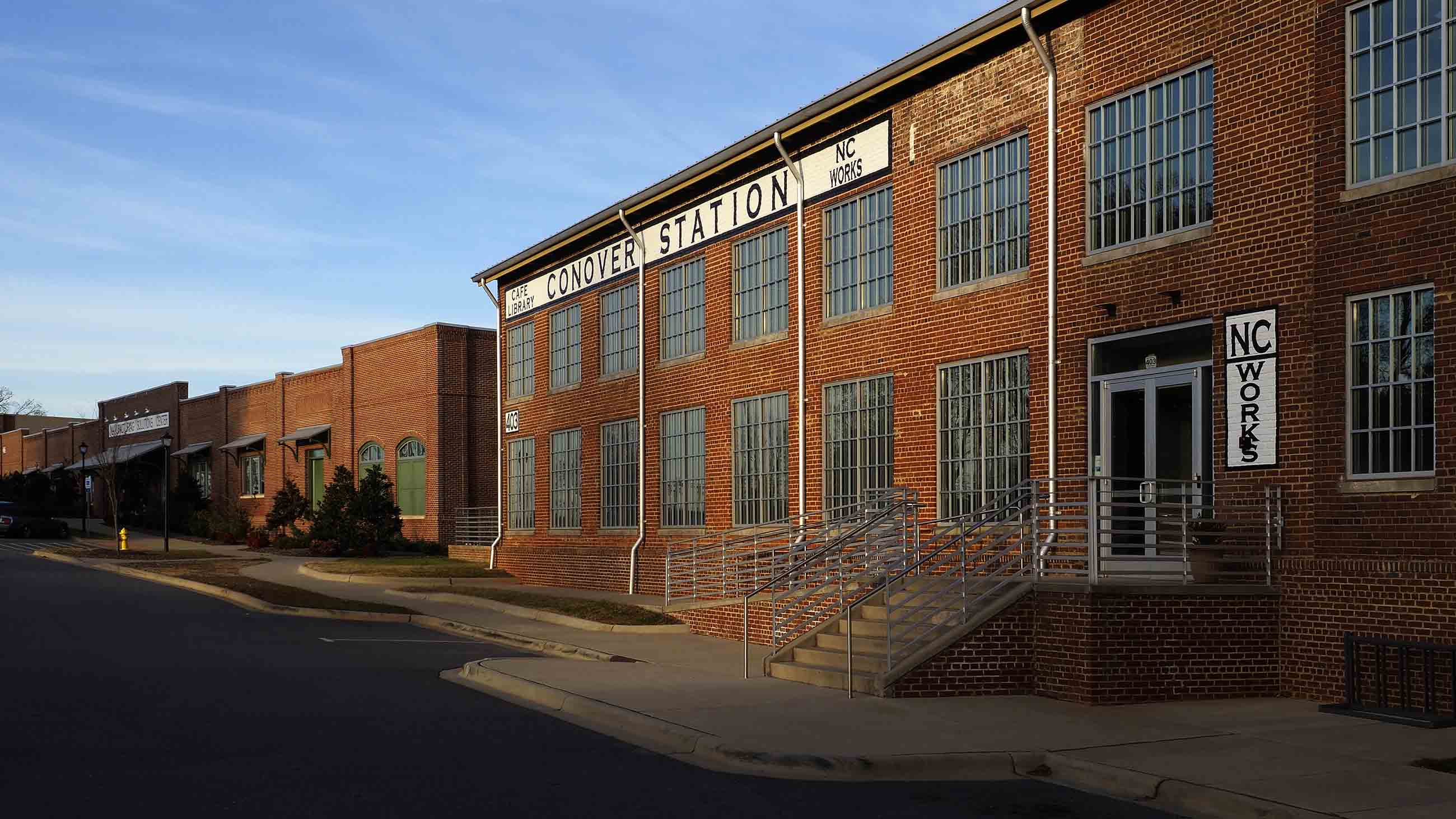
[This story first appeared in Undark on February 24, 2017: https://undark.org/article/catawba-county-fabric-textile-industry/]

Resources
Recommended Resources
Blum, Elizabeth D. Love Canal Revisited: Race, Class, and Gender in Environmental Activism. Lawrence, KS: Univ. Press of Kansas, 2008.Blum goes beyond the headlines to explore the diversity of Love Canal activists and how race, class, and gender impacted their experiences.
Carson, Rachel Louise. Silent Spring. Greenwich, CT: Fawcett, 1962.Originally published as a series of essays in The New Yorker, the release of this book is often considered the start of the modern American environmental movement.
Erin Brockovich. Directed by Steven Soderbergh. Universal City, CA: Universal Pictures, 2000.Julie Roberts won an Academy Award for her portrayal of the title character in this legal drama inspired by a real lawsuit.
Fagin, Dan. Toms River: A Story of Science and Salvation. Washington: Island Press, 2013.Based on years of investigative reporting, Fagin’s book on industry, cancer, water rights, public health, and politics won the 2014 Pulitzer Prize for General Nonfiction.
Global Alliance For Clean Cookstoves. http://cleancookstoves.org/.The public-private partnership hosted by the UN Foundation aims to save lives and protect the environment through its 100 by ‘20 campaign that calls for 100 million households to adopt clean and efficient cookstoves and fuels by 2020.
Hippocrates. On Airs, Waters, and Places. Translated by Francis Adams. London: Wyman & Sons, 1881. http://classics.mit.edu/Hippocrates/airwatpl.html.This treatise on health, disease, and the environment is part of the Hippocratic corpus that serves as the foundational texts for Western medicine.
Markowitz, Gerald E., and David Rosner. 2013. Deceit and Denial: The Deadly Politics of Industrial Pollution. Berkeley, CA: University of California Press, 2013.In this exposé, Markowitz and Rosner reveal how American chemical and lead producers deceived the public about the safety of their products.
Men and Dust, Directed by Sheldon Dick. Garrison Film Distributors, Inc., New York, 1940. http://www.historicjoplin.org/?p=689.Originally created for the 1940 Tri-State Silicosis Conference in Joplin, Missouri, this short film illuminates the safety and health issues that miners in the area faced using sound and visual montages.
Nixon, Rob. Slow Violence and the Environmentalism of the Poor. Cambridge, MA: Harvard Univ. Press, 2013.Nixon analyzes activists’ viewpoints on environmental justice and the impact of climate change, deforestation, and environmental disasters on disempowered populations.
Sharan, Awadhendra. In the City, Out of Place: Nuisance, Pollution, and Dwelling in Delhi, c. 1850-2000. Delhi: Oxford University Press, 2014.This study of social, biophysical, and health-related spaces in contemporary Delhi traces the impact of colonial and postcolonial policies, geography, and cultural practices on environmental issues in the city.
Silicosis: A World History. Edited by Paul-André Rosental. Baltimore: Johns Hopkins University Press, 2017.Eleven experts explore the growing epidemic of silicosis across the globe by tracing the disease’s history and different strategies used to prevent and treat it.
Thorsheim, Peter. Inventing Pollution: Coal, Smoke, and Culture in Britain since 1800. Athens, OH: Ohio University Press, 2006.An examination of how the modern concept of pollution developed and how the public’s perception of coal smoke changed during the 19th century.
The TOXMAP and TOXAPPInteractive maps visually explore data from the U.S. Environmental Protection Agency Toxics Release Inventory and Superfund Program along with non-EPA data sets on this website or app created by the U.S. National Library of Medicine.
Compiled by R.K.

Unsafe Drinking Water
Using Yale Data-Driven Environmental Solutions group data, Arthur Jones compiled this chart of unsafe water in countries featured throughout the e-book.

Pulitzer Center Related Projects
Chapter 1: Flowing Toxins in Southeast Asia Deadly Pollution: The World’s Most Toxic Places
Chapter 2: China’s Dirty Pollution Secret Soil Pollution in ChinaLifting the Veil on Polluters in China
Chapter 3: India’s Contaminated Water and Poisoned LandscapeToxic Development: The Cost of Pollution in India
Chapter 4: Fire and SmokeSolar Oven Use in the Dominican RepublicSmoke and MirrorsThe Cookstove Conundrum
Chapter 5: Polish Gold: Coal’s Deadly TollPoland: Coal’s Deadly Toll
Chapter 6: Legacy of LeadEcuador: Health Consequences of Ceramic Glazing The Black Death of KabweDeadly Pollution: The World’s Most Toxic PlacesPhilippines and Indonesia: The Cost of Gold
Chapter 7: Pollution in the U.S.Deadly Pollution: The World’s Most Toxic Places
Pulitzer Center Related Lesson Plans
Cooking Up Pollution: The Health Crisis of Open Fires and Leaky Stoves
By Pulitzer Center EducationMiddle School, High SchoolStudents learn about health problems associated with solid fuel cooking, alternative cooking methods that would reduce the incidence of these problems, and the difficulties of implementing changes.
Evaluating the Impacts of Leather Tanneries in Bangladesh
By Pulitzer Center EducationMiddle School, High SchoolThis lesson for English, science, history, and journalism teachers asks students to assess how journalists integrate diverse media to analyze the impacts of leather production in Bangladesh.
Soil Pollution in China
By Galeet CohenAll GradesStudents will answer the following questions: What is the cost of industrialization and who pays it? How do we determine whether food is safe? How do you balance food security (production) and food safety?
The Impact of ‘Polish Gold’
By Fareed MostoufiAll GradesStudents will learn about the effects of burning coal in Poland and apply their analyses of the articles to create a presentation that they feel will best support advocacy for coal regulation.
The World’s Most Toxic Town
By Anne-Michele BoyleAll GradesStudents will use reporting on Zambia’s lead mines by Damian Carrington and Larry C. Price to explore the causes, effects and responses to toxic lead poisoning.
Toxic Business: Pollution, Industry, and Health in India
By Pulitzer Center EducationHigh School, CollegeStudents will learn about tannery and e-waste pollution in India and the connection with American consumer goods. They will design a presentation based on what they learn.
What Happens to Communities When Industries Leave?
By Pulitzer Center EducationMiddle School, High SchoolIn this lesson, students create a timeline using multimedia reporting on the leather and textile industries in the U.S.. Students then design their own narrative timelines to explain a current event.

Credits
DESIGN AND PHOTO EDITING Jordan Roth
EDITORIAL TEAMLibby Allen, Eslah Attar, Cece Charendoff, Sydney Combs, Jin Ding, Katherine Doyle, Arthur Jones, Akela Lacy, Kamran Rahman, Ifath Sayed, Lauren Shepherd, Evey Wilson
EDITORIAL CONSULTANTSRebecca Kaplan Kem Knapp Sawyer
CONTRIBUTORS Nathalie Bertrams Caitlin Cotter Fred de Sam LazaroYolanda Escobar Sean Gallagher Beth Gardiner Ingrid Gercama He GuangweiMakenzie Huber Lynn Johnson Michelle Nijhuis Richard C. Paddock Debbie M. Price Larry C. Price
Photographs and text © named journalists, 2017. All rights reserved. No part of this book may be reproduced in any form whatsoever without written permission from the publishers.
The Pulitzer Center is a non-profit organization that funds independent reporting with the intent of raising the standard of media coverage and engaging the broadest possible public in global affairs. The Center partners with major newspapers, magazines and broadcast outlets as well as universities and high schools.
Jon Sawyer, Executive DirectorNathalie Applewhite, Managing DirectorJeff Barrus, Communications Director Jeff Bartholet, Senior EditorTom Hundley, Senior Editor
Cover photo byLarry C. Price
